CipherLab 9700 Mobile Computer User Manual 9700 Mobile Computer CE
CipherLab Co., Ltd. Mobile Computer 9700 Mobile Computer CE
User Manual
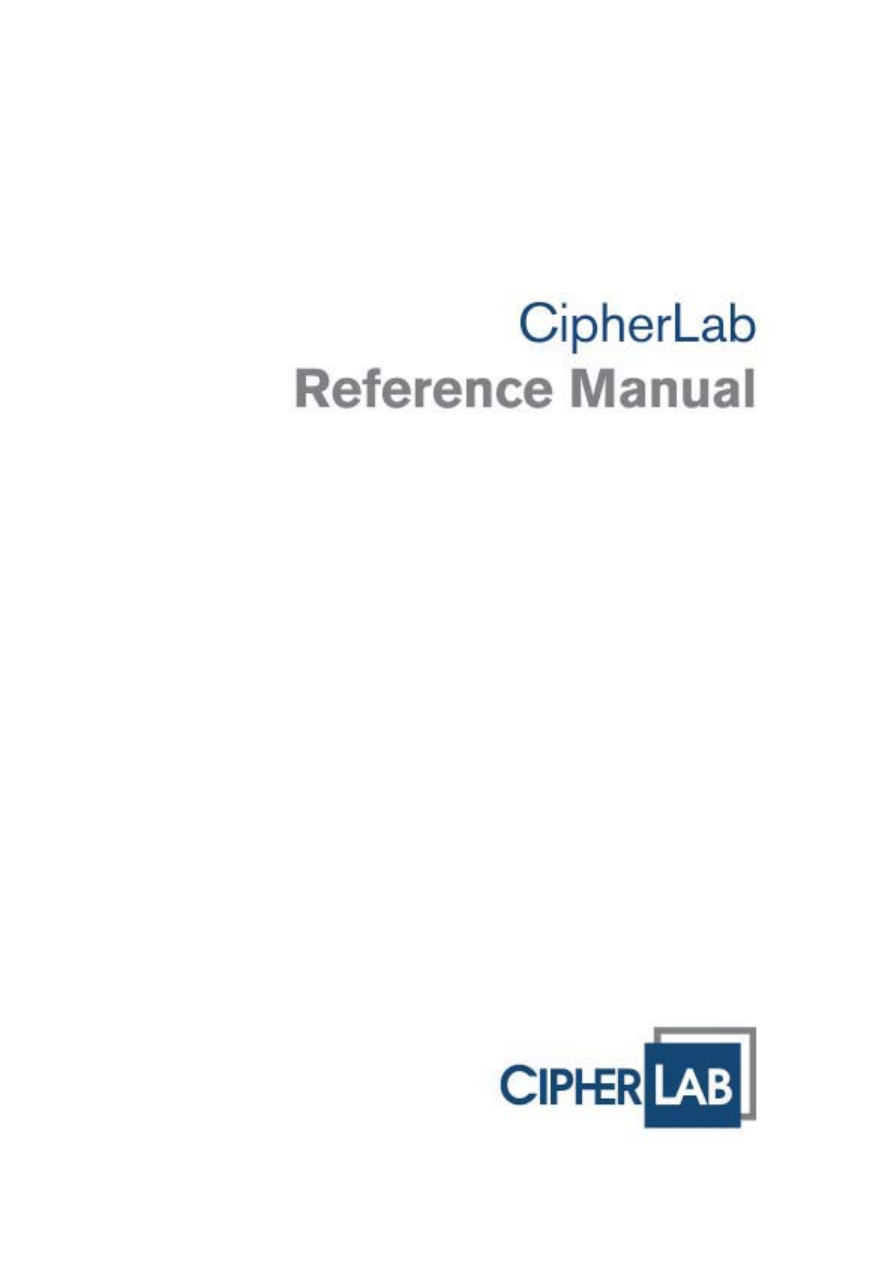
Windows Embedded Compact 7.0
9700
Version 0.65
Mobile Compute
r

COPYRIGHT
Copyright © 2014 CIPHERLAB CO., LTD.
All rights reserved
The information contained in this document, including all pictures, illustrations and software,
is the proprietary information of CIPHERLAB CO., LTD. and its respective legal owners; it is
protected by copyright laws and international copyright treaties, as well as other intellectual
property laws and treaties, with all rights reserved.
In no event and by no part shall this document be reproduced, stored in a retrieval system,
or transmitted in any form or by any means including but not limited to electronic,
mechanical, photocopying, and recording without the prior written consent of CIPHERLAB
CO., LTD. Any reverse engineering of software is also prohibited.
DISCLAIMER
The information herein is subject to change without notice. The information and the
intellectual property herein are confidential between you and CIPHERLAB CO., LTD. and
remain the exclusive property of CIPHERLAB CO., LTD. and its respective legal owners.
Should you find any problems in this document, please report them to CIPHERLAB in writing.
CIPHERLAB does not warrant this document is error-free.
TRADEMARK RECOGNITION
CipherLab logo is a registered trademark of CIPHERLAB CO., LTD. Windows Embedded
Compact (Windows CE) is a registered trademark or trademark of Microsoft Corporation in
the United States and/or other countries. All other brands, products and services, and
trademark names are the property of their registered owners. The editorial use of these
names is for identification as well as to the benefit of the owners, with no intention of
infringement.
CONTACT
For product consultancy and technical support, please contact CIPHERLAB’s sales
representative in your local area. You may also visit CIPHERLAB web site for more
information.
CIPHERLAB CO., LTD.
Website: http://www.CipherLab.com
PREFACE

FOR USA
This equipment has been tested and found to comply with the limits for a Class B digital
device, pursuant to Part 15 of the FCC Rules. These limits are designed to provide
reasonable protection against harmful interference in a residential installation. This
equipment generates, uses and can radiate radio frequency energy and, if not installed
and used in accordance with the instructions, may cause harmful interference to radio
communications. However, there is no guarantee that interference will not occur in a
particular installation. If this equipment does cause harmful interference to radio or
television reception, which can be determined by turning the equipment off and on, the
user is encouraged to try to correct the interference by one or more of the following
measures:
Reorient or relocate the receiving antenna.
Increase the separation between the equipment and receiver.
Connect the equipment into an outlet on a circuit different from that to which the
receiver is connected.
Consult the dealer or an experienced radio/TV technician for help.
This device complies with Part 15 of the FCC Rules. Operation is subject to the following
two conditions: (1) This device may not cause harmful interference, and (2) this device
must accept any interference received, including interference that may cause undesired
operation.
Operations in 5150-5250 MHz band is for indoor use only.
FOR CANADA
This digital apparatus does not exceed the Class B limits for radio noise emissions from
digital apparatus as set out in the interference-causing equipment standard entitled
"Digital Apparatus," ICES-003 of Industry Canada.
This device complies with Part 15 of the FCC Rules. Operation is subject to the following
two conditions: (1) This device may not cause harmful interference, and (2) this device
must accept any interference received, including interference that may cause undesired
operation.
Cet appareil numerique respecte les limites de bruits radioelectriques applicables aux
appareils numeriques de Classe B prescrites dans la norme sur le material brouilleur:
"Appareils Numeriques," NMB-003 edictee par l'Industrie.
FOR HAND-HELD PRODUCT WITH RF FUNCTIONS
This equipment complies with FCC radiation exposure limits set forth for an uncontrolled
environment. This equipment should be installed and operated with minimum distance 20
cm between the radiator & your body.
Caution!
Any changes or modifications not expressly approved by the party responsible for
compliance could void the user's authority to operate the equipment.
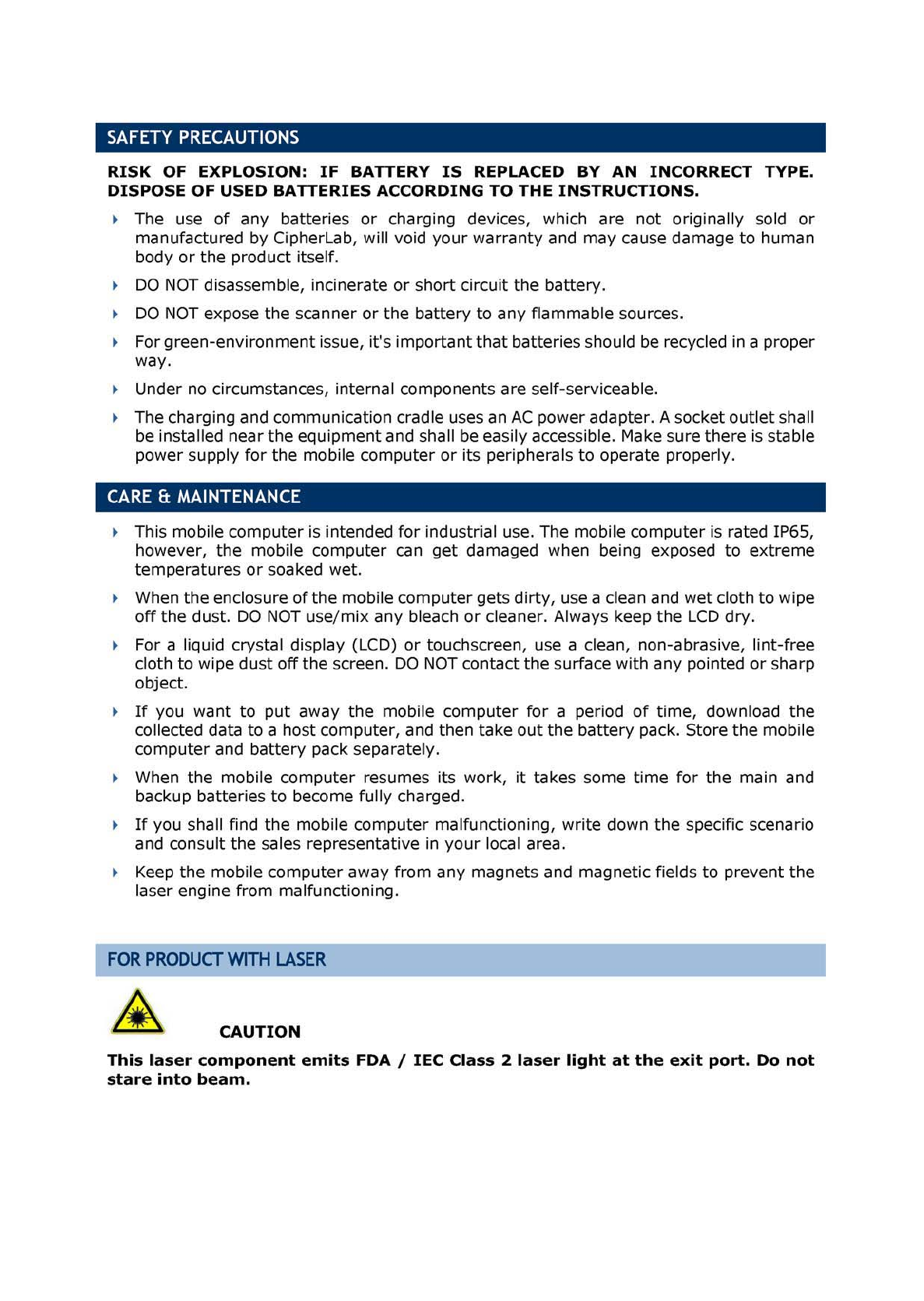

Version Date Notes
0.5 Apr 8, 2014 Draft release
RELEASE NOTES
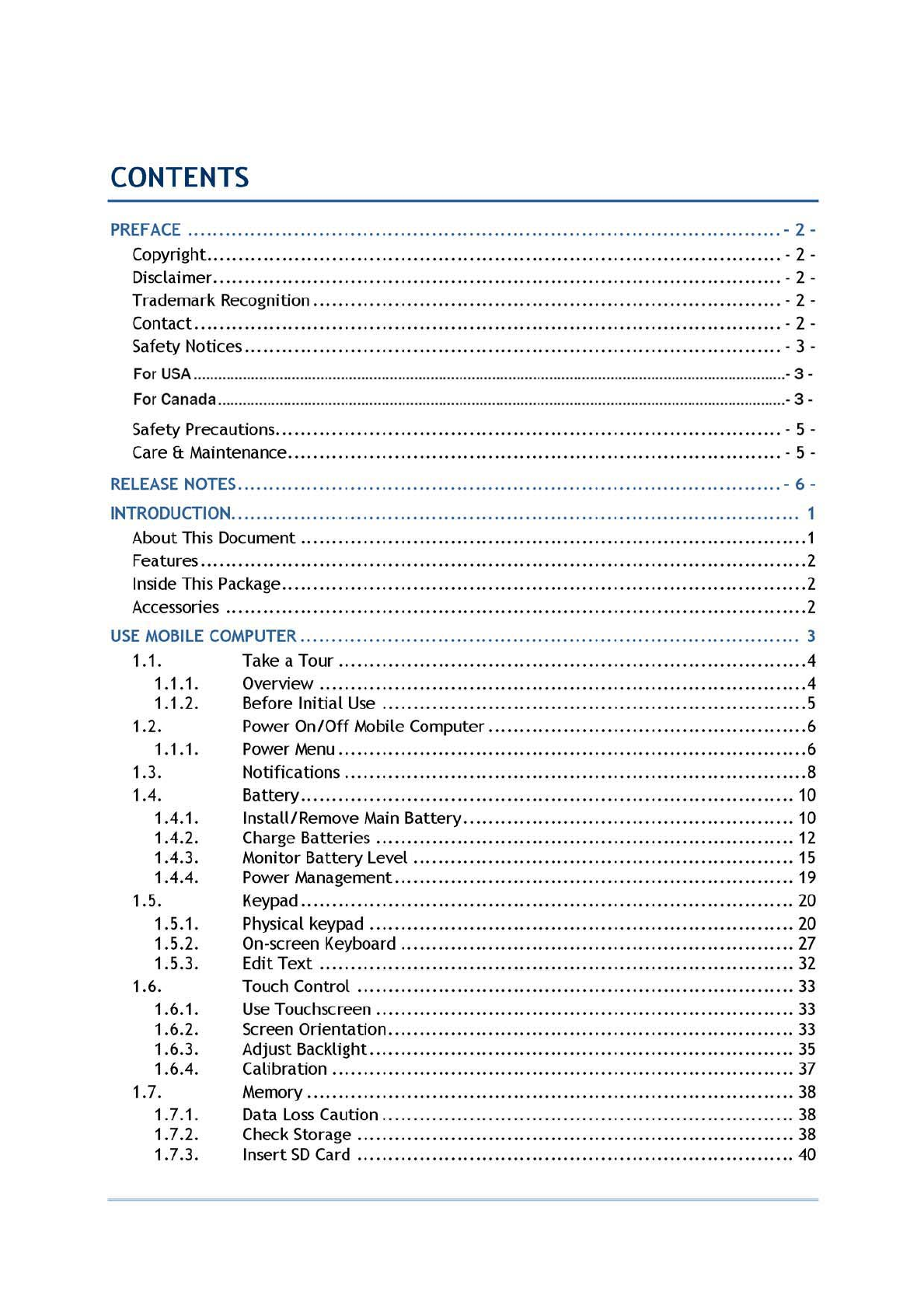

1.8. Direct Data Communication...................................................... 41
1.8.1. Use Snap-on Cable................................................................. 41
1.8.2. Use Cradle........................................................................... 42
1.8.3. Syncing Tools ....................................................................... 43
1.8.4. Sync Partnership ................................................................... 43
1.8.5. 1st USB Sync......................................................................... 44
1.8.6. Disconnect USB ActiveSync....................................................... 45
1.8.7. ActiveSync Actions to Take....................................................... 46
1.9. Volume and Audio.................................................................. 51
1.9.1. Audio Playback ..................................................................... 51
1.9.2. Volume Control..................................................................... 51
OPERATING SYSTEM....................................................................................53
2.1. Desktop.............................................................................. 54
2.1.1. Taskbar .............................................................................. 55
2.1.2. Start Menu .......................................................................... 56
2.1.3. Customize Desktop and Start Menu ............................................. 57
2.2. Managing Programs ................................................................ 61
2.2.1. Launch Program.................................................................... 61
2.2.2. Switch between Active Tasks .................................................... 62
2.2.3. Exit a Program...................................................................... 62
2.2.4. Install Applications ................................................................ 63
2.3. Suspend & Reset Mobile Computer.............................................. 66
2.3.1. Suspend Mobile Computer ........................................................ 66
2.3.2. Wake Up Mobile Computer ....................................................... 67
2.3.3. Restart Mobile Comptuer ......................................................... 68
RADIOS....................................................................................................69
3.1. Use Wi-Fi ............................................................................ 70
3.1.1. Power On/Off Wi-Fi ............................................................... 70
3.1.2. Launch SCU ......................................................................... 72
3.1.3. Status Tabbed Page................................................................ 73
3.1.4. Configuration Tabbed Page....................................................... 74
3.1.5. Diagnostics Tabbed Page ......................................................... 89
3.2. Use Bluetooth....................................................................... 96
3.2.1. Bluetooth Profiles Supported .................................................... 96
3.2.2. Change Blutooth Name............................................................ 96
3.2.3. Turn On/Off Bluetooth............................................................ 98
3.2.4. Set Bluetooth Visibility............................................................ 99
3.2.5. Launch BT Connect ...............................................................100
3.2.6. Search for Bluetooth Devices ...................................................101
3.2.7. Pair Bluetooth Devices...........................................................102
3.2.8. Bluetooth Data Transfer .........................................................106
3.2.9. Re-Connection.....................................................................116
3.2.10. Preferred Services ................................................................117
3.2.11. Manage Local Services ...........................................................118
3.2.12. BT Manager ........................................................................120
MANAGE MOBILE COMPUTER ....................................................................... 127
4.1. Control Panel ......................................................................128
4.2. Connection Settings ..............................................................135

4.3. Taskbar and Start Menu Settings ...............................................137
SPECIFICATIONS....................................................................................... 139
Platform, Processor & Memory...................................................................139
Communications & Data Capture ................................................................139
Electrical Characteristics..........................................................................140
Physical Characteristics ...........................................................................141
Environmental Characteristics....................................................................142
Programming Support..............................................................................142
Accessories ..........................................................................................143


1
Thank you for choosing CipherLab products. CipherLab welcomes another Windows
Embedded by introducing 9700 Series Mobile Computer. Powered by Windows Embedded
Compact 7.0, the mobile computer delivers better user experience and advances enterprise
mobile computing.
The mobile computer has transflective LCD to hold up the readability in a wide range of light
conditions, courtesy of the supplementary backlight enabled by a built-in ambient light
sensor. Also on board is a G-sensor to save power according to the mobile computer’s
motion and posture. G-sensor also enables screen orientation when the device is posed
sideways or upright. Furthermore, the mobile computer has integrated a built-in e-compass
and gyroscope, both of which provide useful functions in navigation.
The series sports satisfactory data connections by integrating a communication port for
direct data exchange. For wireless data connections it hosts each Bluetooth and 802.11b/g
module while a HSPA+ (3.8G) module is provided on option.
Dedicated to data capture, the mobile computer has essential 1D (laser) reader or 2D
imager. A high-spec 5 mega-pixel camera also comes inside to take pictures and shoot
videos to deliver better documentation for users.
Rated with IP65, the rugged 9700 is light-weighted and easy to cradle in your hand, and will
be your good help on field works.
ABOUT THIS DOCUMENT
This guide distills the information about 9700 Series Mobile Computer. Subjects discussed
include the mobile computer’s physical features, platform basics, software and applications,
and part of the accessories to boost the mobile computer’s performance.
We recommend that you keep one copy of this manual at hand for the quick reference for
necessary maintenance.
INTRODUCTION

2
9700 Mobile Computer (CE) Reference Manual
FEATURES
Rugged yet smoothened outlined, with hand strap for secure hold
IP65-rated tough form to survive drop, shock, heat, cold, and impervious to
moisture/dust
Windows CE 6.0 OS, TI OMAP3730 1GHz CPU
512MB SDRAM to run application programs
4GB NAND flash to store OS, applications, settings and so on
Storage expansion: Up to 32GB MicroSDHC
Sunlight-readable screen to enhance the viewability of outdoor use
Ambient light sensor to enable supplementary backlight for LCD and keypad
G-sensor for power management and screen orientation
2 symmetric side-triggers for ambidextrous scanning
Total data solution — supporting Bluetooth, 802.11a/b/g/n
C++ and .Net programming support
INSIDE THIS PACKAGE
The mobile computer ships with the following items. Save the box and packaging material
in case of future need to store or deliver the mobile computer.
Mobile Computer
Rechargeable Li-ion battery pack (standard/high capacity)
Stylus
Screen protector
Hand strap
Product CD
Quick Start Guide
ACCESSORIES
Optional accessories to enhance the mobile computer’s performance are:
Snap-on Charging and Communication Cable (USB or RS-232)
Charging & Communication Cradle
Pistol Grip
Snap-On Car Charger

3
Before the mobile computer takes part in your work, get to know it first. This chapter
includes the basic features of the mobile computer including the power supply, memory,
and the units that bridge users with the mobile computer. This chapter helps you set the
mobile computer to work at the earliest.
1. IN THIS CHAPTER
1.1 Take a Tour ................................................................ 4
1.2 Power On.................................................................... 6
1.3 Notifications................................................................ 8
1.4 Battery....................................................................... 8
1.5 Keypad..................................................................... 20
1.6 Touch Control............................................................ 33
1.7 Memory.................................................................... 38
1.8 Direct Data Communication......................................... 41
1.9 Volume and Audio...................................................... 51
Chapter 1
USE MOBILE COMPUTER
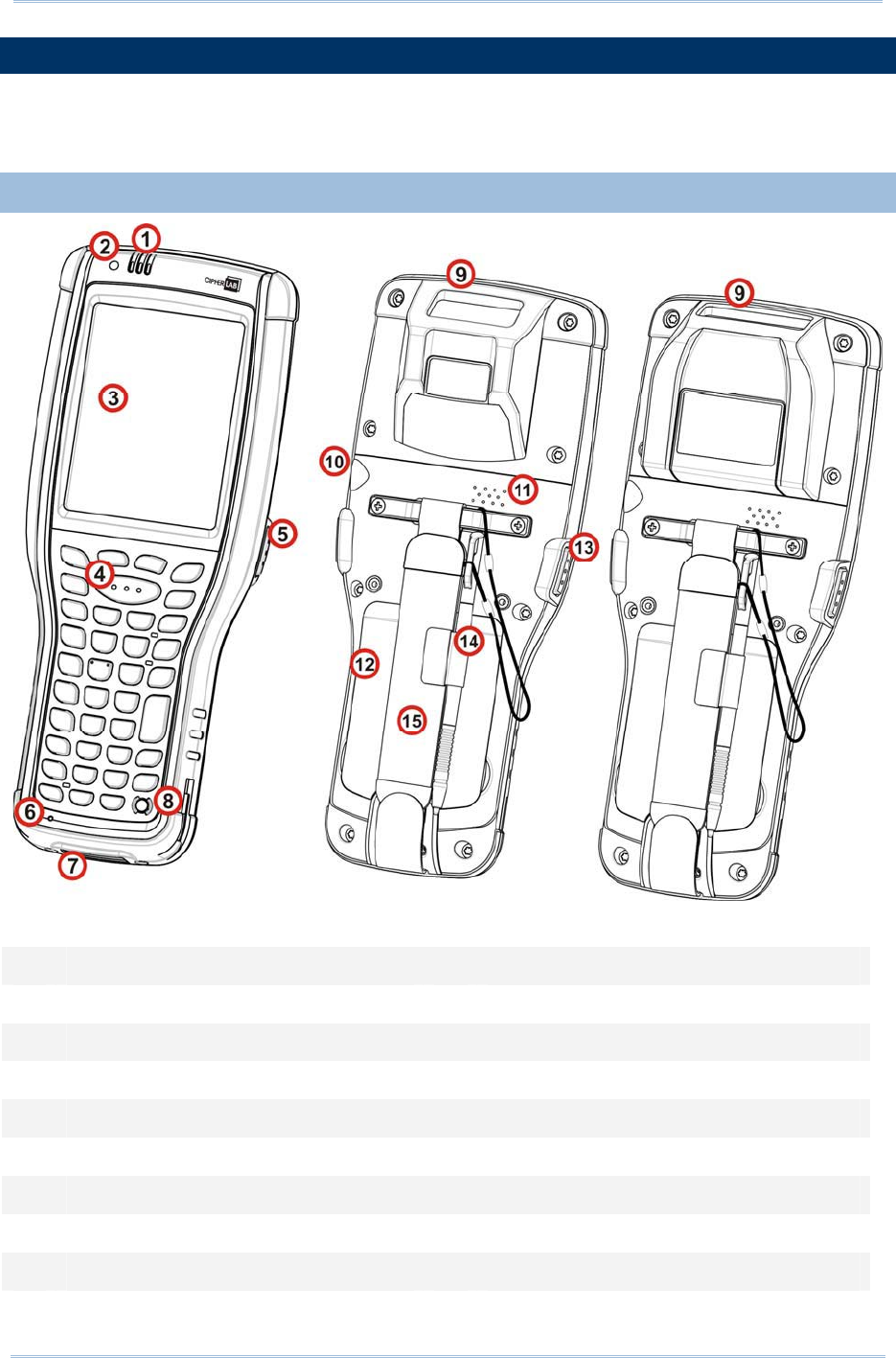
4
9700 Mobile Computer (CE) Reference Manual
1.1. TAKE A TOUR
This section shows the major components on the mobile computer and inside battery
chamber. You will also learn how to power on/off the mobile computer and how the mobile
computer gives information about its status.
1.1.1. OVERVIEW
Figure 1: Overview
No. Description No. Description
1 Status LED (refer to ) 2 Light sensor
3Touchscreen 4Scan key
5 Side-trigger (user definable) 6 Microphone
7Direct charging & communication port 8Power key
9 Scan window 10 Headset jack
11 Speaker 12 Battery
13 Side-trigger (user definable) 14 Stylus (with attaching cord)
15 Handstrap

5
Chapte
r
1 Use Mobile Compute
r
1.1.2. BEFORE INITIAL USE
Prior to using the mobile computer for the first time, we recommend applying the protective
film over the LCD. This will prevent scratching the touchscreen during daily usage, and also
help enhance the durability of the touchscreen.
To apply the LCD protective film:
1) Upon delivery, the touchscreen of the mobile computer is covered with a thin
transparent film. Peel off and discard this film.
2) Wipe the touchscreen with a clean, non-abrasive, lint-free cloth.
3) Carefully apply the LCD protective film to the touchscreen by aligning its edges with the
edges of the touchscreen. Make sure the film adheres tightly to the surface.
The mobile computer is then ready for usage.
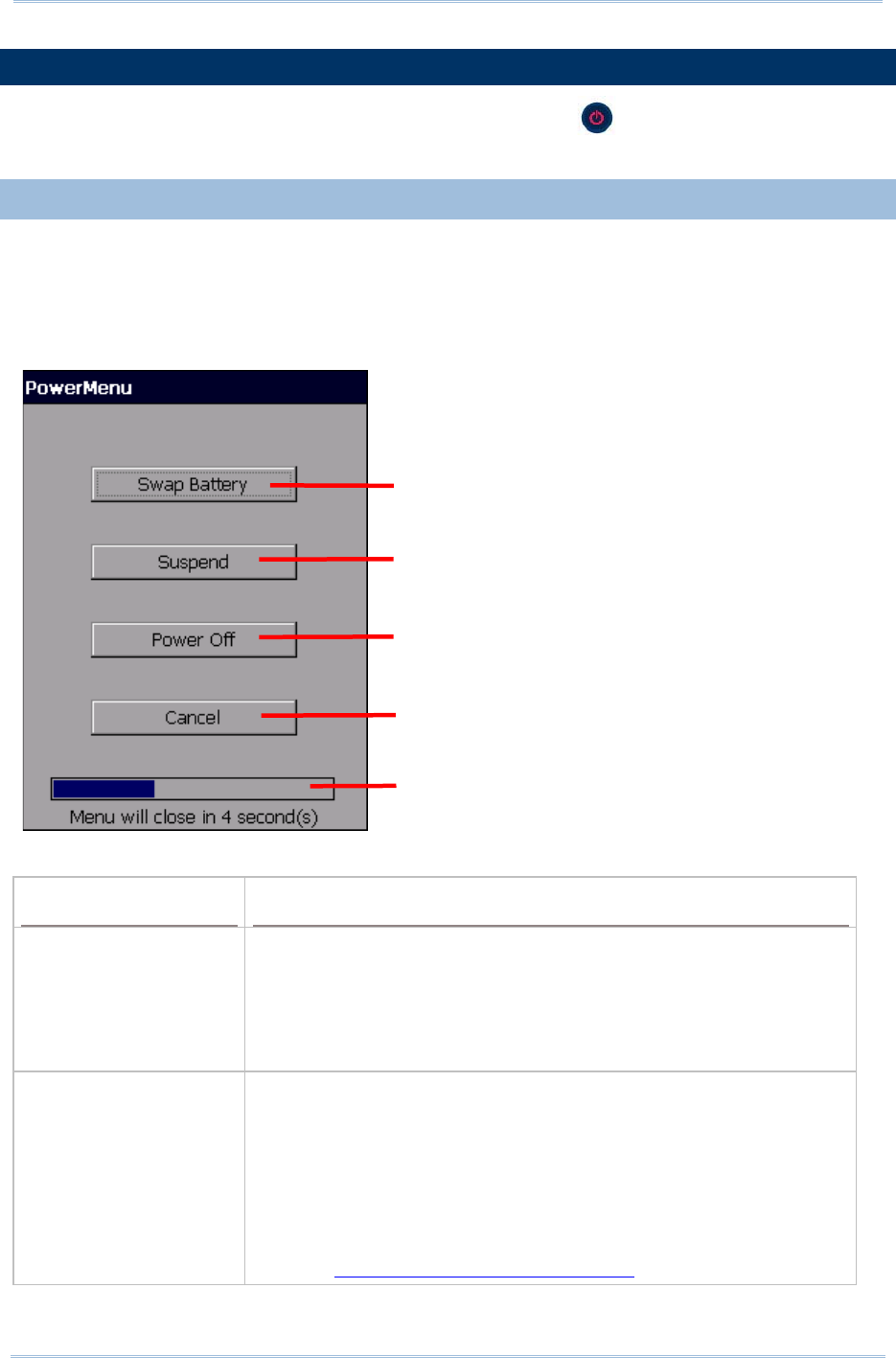
6
9700 Mobile Computer (CE) Reference Manual
1.2. POWER ON/OFF MOBILE COMPUTER
To power on the mobile computer, press the Power button sitting at the upper right of
the keypad. The mobile computer powers on.
1.1.1. POWER MENU
The 9700 mobile computer features a power menu. This menu allows you to select whether
you would like to power off the mobile computer, enter suspension, or enter sleeping mode
for main battery replacement.
To enter this power menu, press the power button for more than three seconds. A menu will
open on-screen with a countdown bar at the bottom.
Menu options are as follows:
Action to take Description
Swap Battery
If you would like to replace the main battery pack on the mobile
computer, select this option to let the mobile computer enter
sleeping mode.
After the main battery has been replaced, wake up the mobile
computer by pressing the power button. All applications and tasks
will remain active.
Suspend (default)
When the mobile computer is not under frequent use, select this
option to let the mobile computer enter suspension and save power.
This is the default function, and when no option is selected in the
power menu, the mobile computer will automatically enter
suspension after 5 seconds.
When you need to use the mobile computer once more, resume it by
pressing the power button or central scan key. All applications and
tasks will remain active.
See also Suspend & Reset Mobile Computer.
Ta
p
to return to
p
revious screen
Tap to enter sleeping mode for main
battery pack replacement
Ta
p
to sus
p
end mobile com
p
uter
Ta
p
to
p
ower off mobile com
p
uter
Time remaining before mobile
computer enters suspension

7
Chapte
r
1 Use Mobile Compute
r
Power Off
Select this option if you would like to power off the mobile computer.
This will close all applications and tasks currently running. All
unsaved data will be lost.
To power on the mobile computer, press the power button.
Cancel Selecting this option will close the menu and return to the previously
active screen. All applications and tasks will remain active.
Note: If you wish to replace the main battery pack on the mobile computer, aside from
taking the steps above, please also make sure the following requirements are met.
Otherwise, the mobile computer might function abnormally, and will require system
restart.
(1) Make sure the backup battery on the mobile computer is not drained out. Check Backup
Battery Level before taking any actions.
(2) After selecting Swap Battery in the power menu, proceed to replacing the battery as
soon as possible.
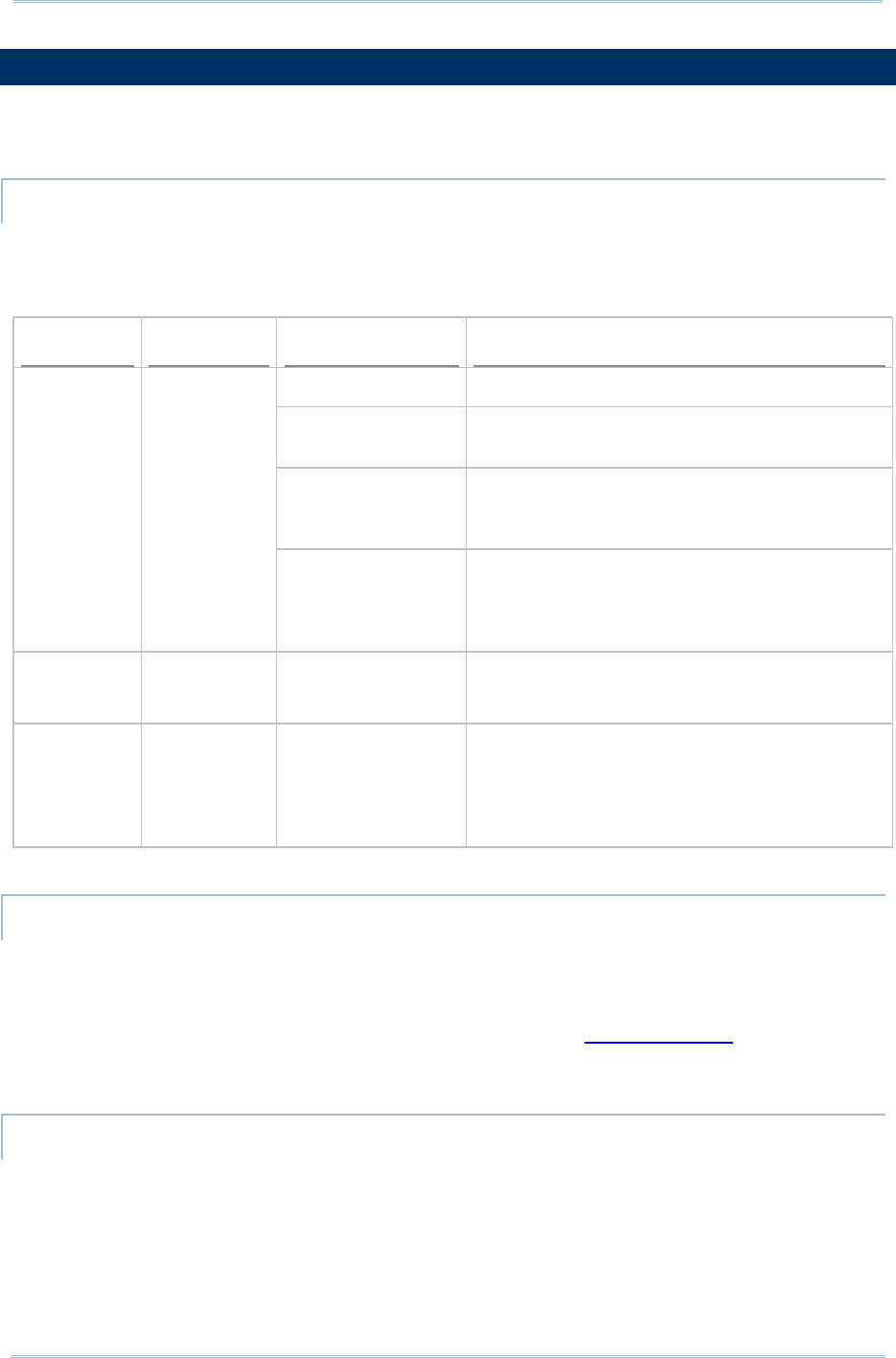
8
9700 Mobile Computer (CE) Reference Manual
1.3. NOTIFICATIONS
The mobile computer features visible, audible, and tactile feedback to draw users’ prompt
awareness of the mobile computer’s contiguous events such as barcode reading,
wireless/mobile data connections, and battery charging.
STATUS LED
Three LED lights are located on the upper-right corner of the mobile computer. Their
functions are:
Matter LED Color Action Description
Green, solid Battery is fully charged.
Orange, solid Battery is being charged, and the battery level
is sufficient to power on the mobile computer.
Red, solid Battery is being charged, however the battery
level is insufficient to power on the mobile
computer.
Battery
Charging
(Left) Green, Red
Red, blinking fast
Battery charging error has occurred, for
instance, charging temperature is below 0°C or
above 35°C, or adapter is plugged in but no
battery is present.
Radios
(Middle) Blue Blue, blinking Wi-Fi or Bluetooth in use.
Scanning
Good Read
(Right)
Green Green, flashes once
Indicates good reading of the scanned barcode.
Enable/Disable this LED light on the Reader
Config Notification Settings page. To set the
good read LED via API deployment, see the
9700 Programming Guide for details.
SPEAKER
The mobile computer has a speaker on the back for audio signaling and playback.
The speaker sounds for system events, application warnings, on-screen item selection and
physical keypad stroke. In noisy environments, the speaker remains efficacious with the
help of a Bluetooth headset. To control sound volume, see Volume Control.
The speaker also sounds for successful barcode reading, which can be controlled on the
Reader Config Notification Settings page.
VIBRATOR
The mobile computer owes its tactile feedback to the vibrator built inside. Vibration
delivered to the mobile computer alerts users of its currents status.
Working based on user’s sense, the vibrator is particularly helpful when the mobile
computer is serving in a noisy environment.

9
Chapte
r
1 Use Mobile Compute
r
Same as the speaker and LED light, the vibrator also works for good barcode reading.
Enable/disable vibration and set its duration on the Reader Config Notification Settings
page. Alternatively, program the vibrator through API deployment to have it vibrate when
a successful reading occurs. See the 9700 Programming Guide for details.
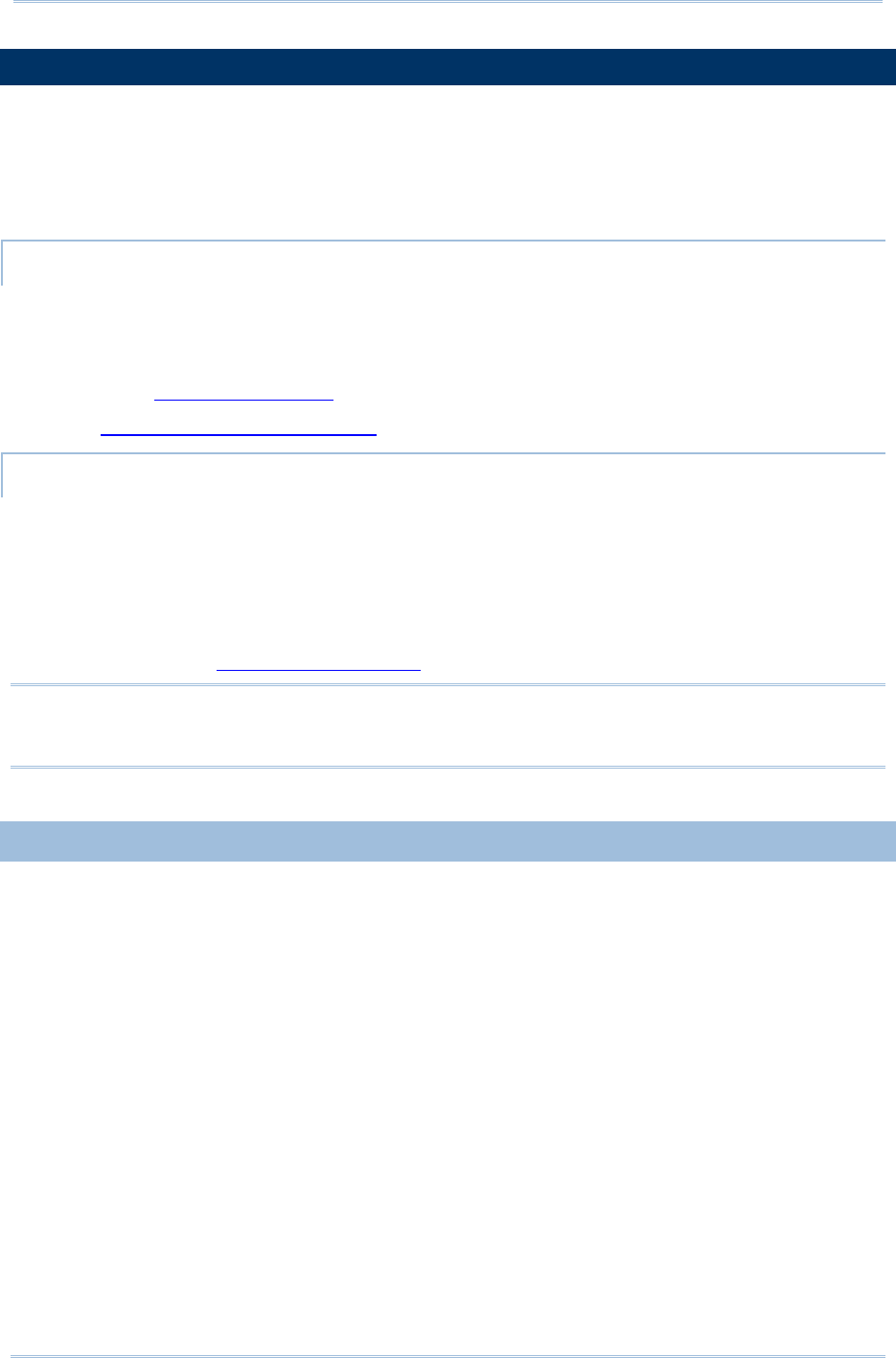
10
9700 Mobile Computer (CE) Reference Manual
1.4. BATTERY
The 9700 mobile computer is fed by two batteries, main battery pack and backup battery.
The main battery is removable and replaceable from the battery chamber while the backup
battery is mounted on the main board inside the mobile computer.
When the mobile computer is shipped, the main battery is stored in a package separated
from the mobile computer, which keeps it in good condition for future use.
MAIN BATTERY
The main battery is a Li-ion battery pack which comes in two different capacities, a 3.7V,
3300mAh battery which takes approximately 4 hours to charge to full, and a 3.7V,
5400mAh battery which takes around 6 hours to charge to full. The working time of the
mobile computer varies by its working states. A battery icon seated on the taskbar will show
the remaining Main Battery Level.
See also Install/Remove Main Battery for installing the main battery.
BACKUP BATTERY
The backup battery is settled on the main board inside the mobile computer. It is a 3.6V,
15mAh rechargeable Ni-MH battery. When the main battery is absent or depleted, the
backup battery takes over to feed the mobile computer. Without the main battery, a fully
charged backup battery retains the data in the DRAM and holds the system in suspension
for 30 minutes (as long as the wireless modules are inactive).
The backup battery is rechargeable by the main battery pack. It takes about 4 hours to
charge it to full. See Backup Battery Level.
Note: When removing the main battery pack, actual data retention time will depend on the
backup battery level. Check backup battery level before replacing the main battery
to ensure your data is retained.
1.4.1. INSTALL/REMOVE MAIN BATTERY
Follow the steps below to install the main battery:
1) The handstrap is installed over the battery chamber. You do not need to remove the
handstrap to install the battery; simply lift up the handstrap to allow enough space to
insert the battery.
2) Place the main battery pack into the battery chamber with the contact pins facing down.
Fix the upper end first, and press the lower end down until the battery “clicks” into place.
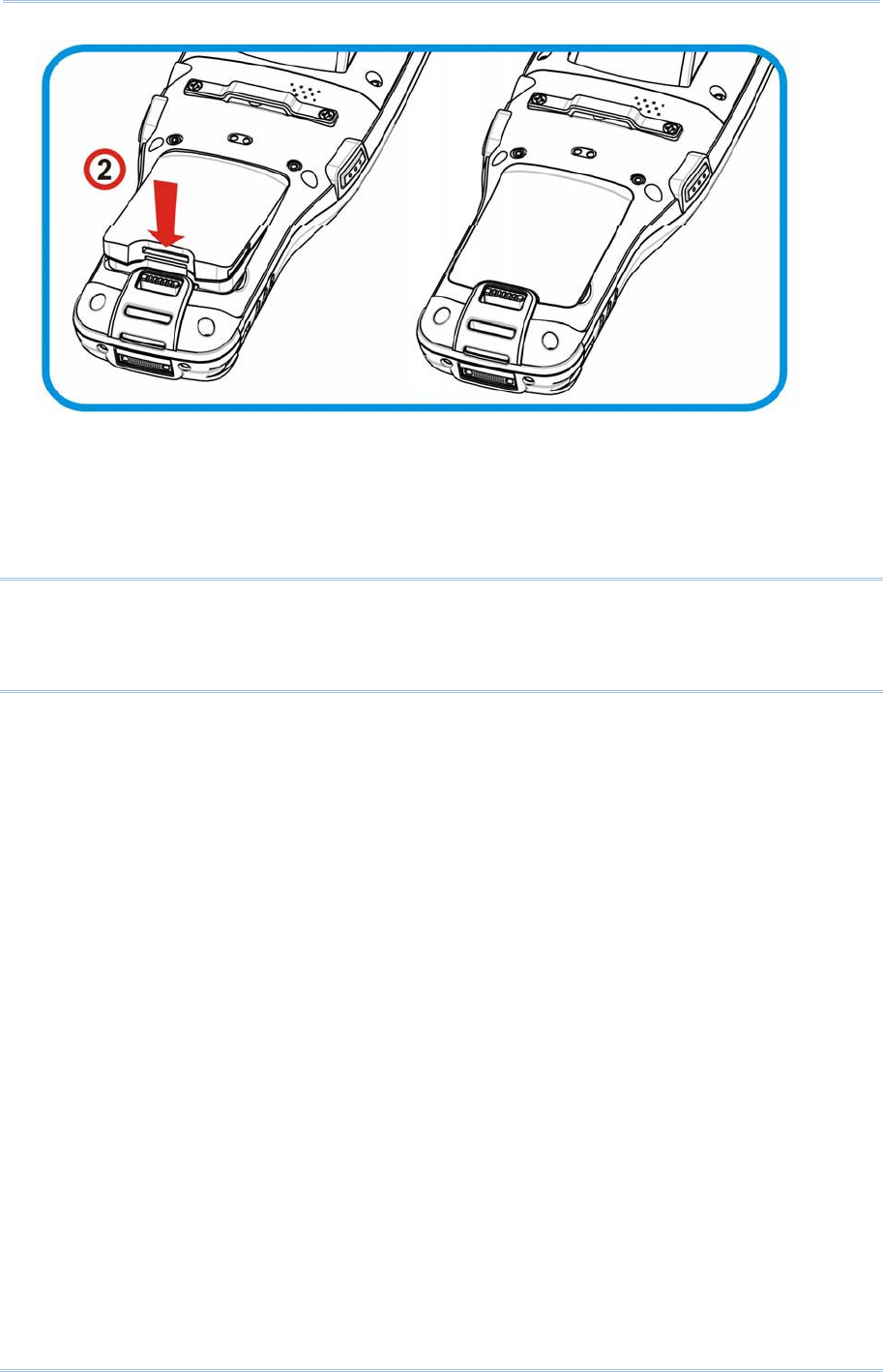
11
Chapte
r
1 Use Mobile Compute
r
Figure 2: Install main battery
Follow the steps below to remove the main battery:
1) A battery located at the lower end of the main battery. Push the latch down and the
battery will be released.
Note:
(1) When main battery level drops to low level, charge it ASAP or replace it with a
charged battery.
(2) Always turn off the mobile computer to replace the main battery pack.
(3) Any improper handling may reduce battery life.
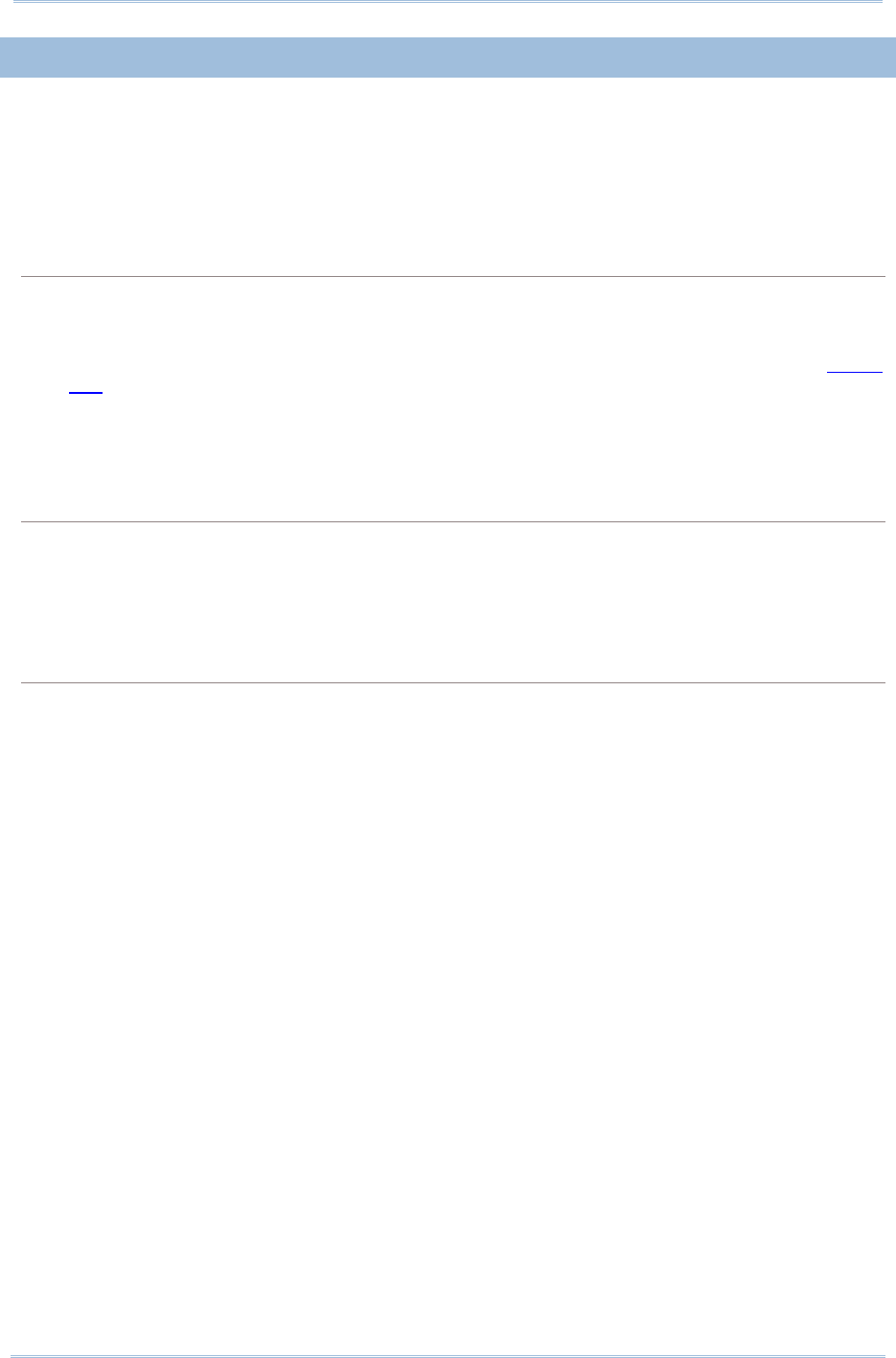
12
9700 Mobile Computer (CE) Reference Manual
1.4.2. CHARGE BATTERIES
Due to shipment, it is likely that the main battery and backup battery won’t be fully charged
when you receive the package. Before setting the mobile computer to work, charge the
main battery to full by direct charging via a power adapter (with the help of a Snap-on
Charging & Communication Cable or Charging & Communication Cradle).
Some key facts about charging batteries:
Charging Time
Main battery: It takes approximately 4 hours to charge the 3.3V, 3600mAh main battery, and
approximately 6 hours to charge the 3.3V, 5400mAh main battery. The battery charging LED
above the touchscreen lights red or orange during charging (depending on the battery level at
the moment), and lights green when the mobile computer is completely charged. See Status
LED for details about the LED indicator.
Backup battery: The backup battery is rechargeable by both the main battery and power
adapter. It takes about 5 hours to charge it to full, however it does not need to be fully charged
for the mobile computer to work.
Charging Temperature
It is recommended that batteries be charged at room temperature (18°C~25°C) for optimal
performance.
Charging stops when temperature drops below 0°C or exceeds 35°C. In this case the battery
charging LED will be continuously blinking in red.
Power Consumption
When all radios (802.11 a/b/g/n, Bluetooth) are active on battery power, main battery level will
drop substantially.
In order to prevent the system from shutting down due to depletion of the main battery, we
suggest that you keep a fully charged battery for replacement or have the mobile computer
access the radios on external power.
The following guides how to charge batteries.
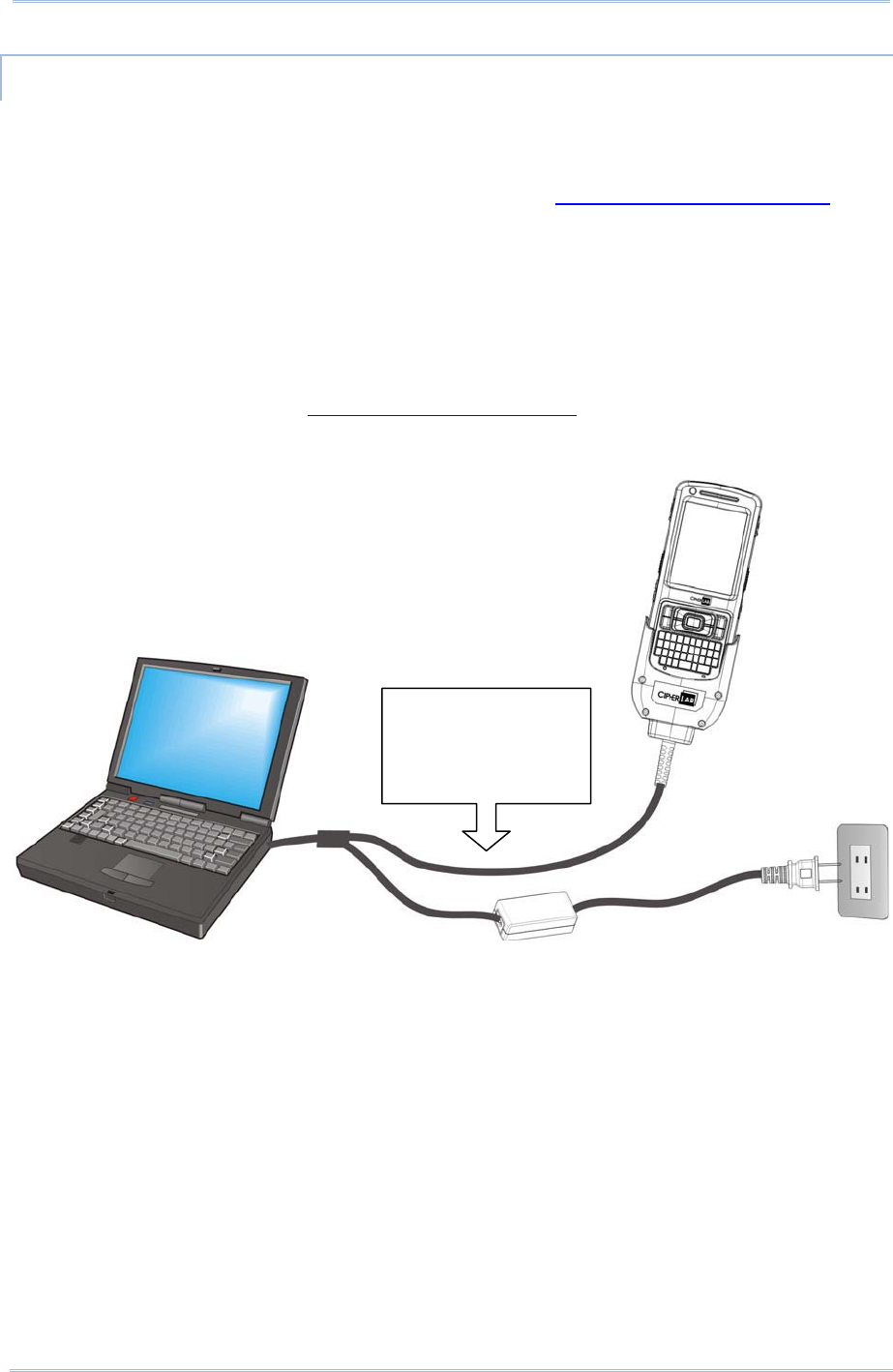
13
Chapte
r
1 Use Mobile Compute
r
DIRECT CHARGING USING SNAP-ON CABLE
Direct charging of the mobile computer relies on the Snap-on Charging & Communication
Cable (hereinafter “snap-on cable”). There is a power jack on the connector of this cable to
connect external power.
Prior to charging, install the main battery as described inʳInstall/Remove Main Battery. Then
follow the steps below:
1) Attach the snap-on cable to the mobile computer.
2) Plug the head of the power adapter cord into the power jack located on the snap-on
cable’s connector.
3) Connect the power adapter to a power outlet.
To output data to your PC or laptop, connect the snap-on cable (either through USB or
RS-232 connection) to it. See Direct Data Communication for follow-ups.
Figure 3: Direct Charging Using Snap-on Cable
To transmit data,
connect the other end
of the Snap-on Cable
to your PC
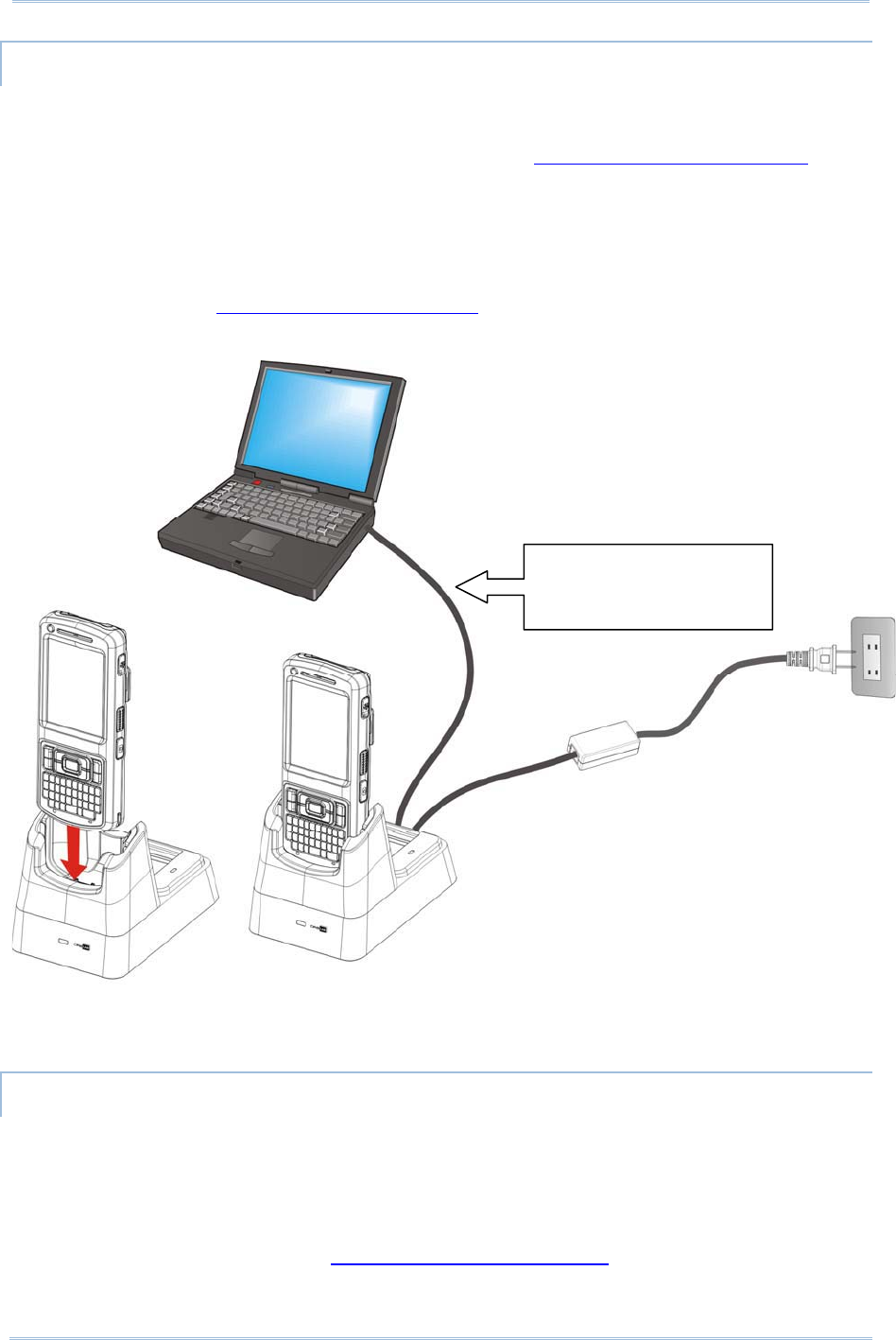
14
9700 Mobile Computer (CE) Reference Manual
DIRECT CHARGING USING CRADLE
Direct cradle charging makes use of a Charging & Communication Cradle (hereinafter
“cradle”). The cradle is one of the accessories you can opt for.
Prior to charging, install main battery as described in Install/Remove Main Battery. Then
follow the steps below:
1) Seat the mobile computer onto the cradle.
2) Connect the cradle to an external power source using the power adapter.
To output data to your PC or laptop, connect the mobile computer and your PC with a
microUSB cable. See Direct Data Communication for follow-ups.
Figure 4: Direct Charging Using Cradle
REPLACE MAIN BATTERY PACK
The Charging and Communication Cradle holds a separate charging compartment for the
main battery pack. This allows the mobile computer and a separate main battery pack to be
charged either individually or simultaneously. We advise you to keep a fully charged battery
at hand at all times.
Before replacing the main battery pack, turn off the mobile computer. Insert a charged
main battery pack as shown in Install/Remove Main Battery and power on the mobile
computer.
To transmit data, use the
microUSB cable to connect
the Cradle to your PC
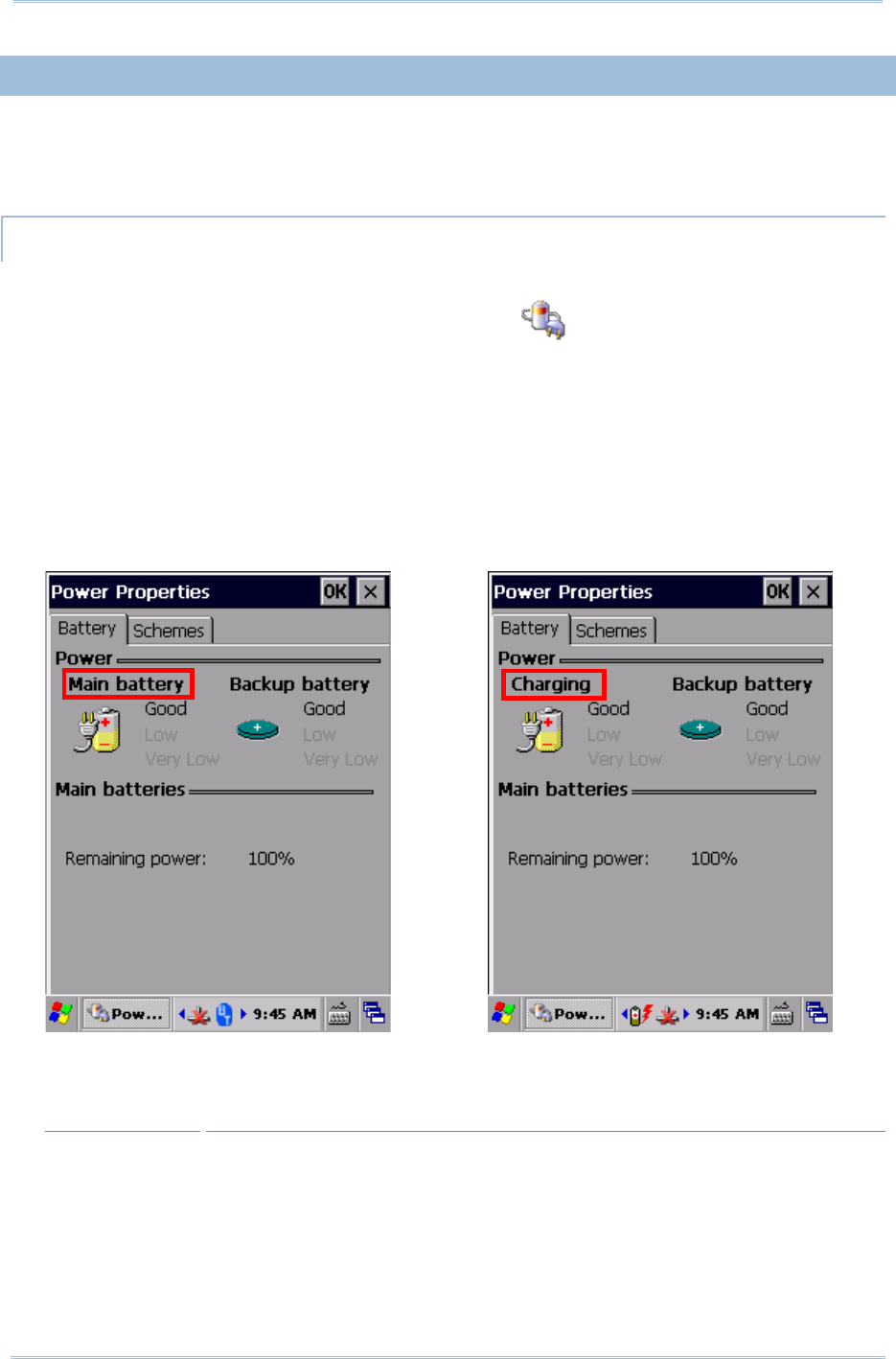
15
Chapte
r
1 Use Mobile Compute
r
1.4.3. MONITOR BATTERY LEVEL
The main battery is the only source that feeds the mobile computer to work. It also supplies
the backup battery on main board to retain the data stored in DRAM. Hence when main
battery level gets low, recharge it or change it as soon as possible. Most critically, back up
the important data from time to time to protect your work.
MAIN BATTERY LEVEL
To check the main battery level:
1) Tap Start |Settings | Control Panel |Power .
Power Properties window opens showing Battery tabbed page. Main battery level is
summarized under Power label as “Good”, “Low” or “Very Low”. Precise battery level is
also shown in percentage under the Main batteries label.
Depending on whether the main battery is being charged, charging status will show
“Main battery”, meaning the mobile computer is on battery power, or “Charging”,
meaning that external power is connected.
Main battery isn’t being charged. Main battery is being charged.
Main battery level is summarized into three levels:
Description Battery Status
Good Main battery level is good (40~100%).
Low Main battery level is low (20~39%). Charging is recommended.
Very Low Main battery level is very low (<19%) and needs to be charged immediately.
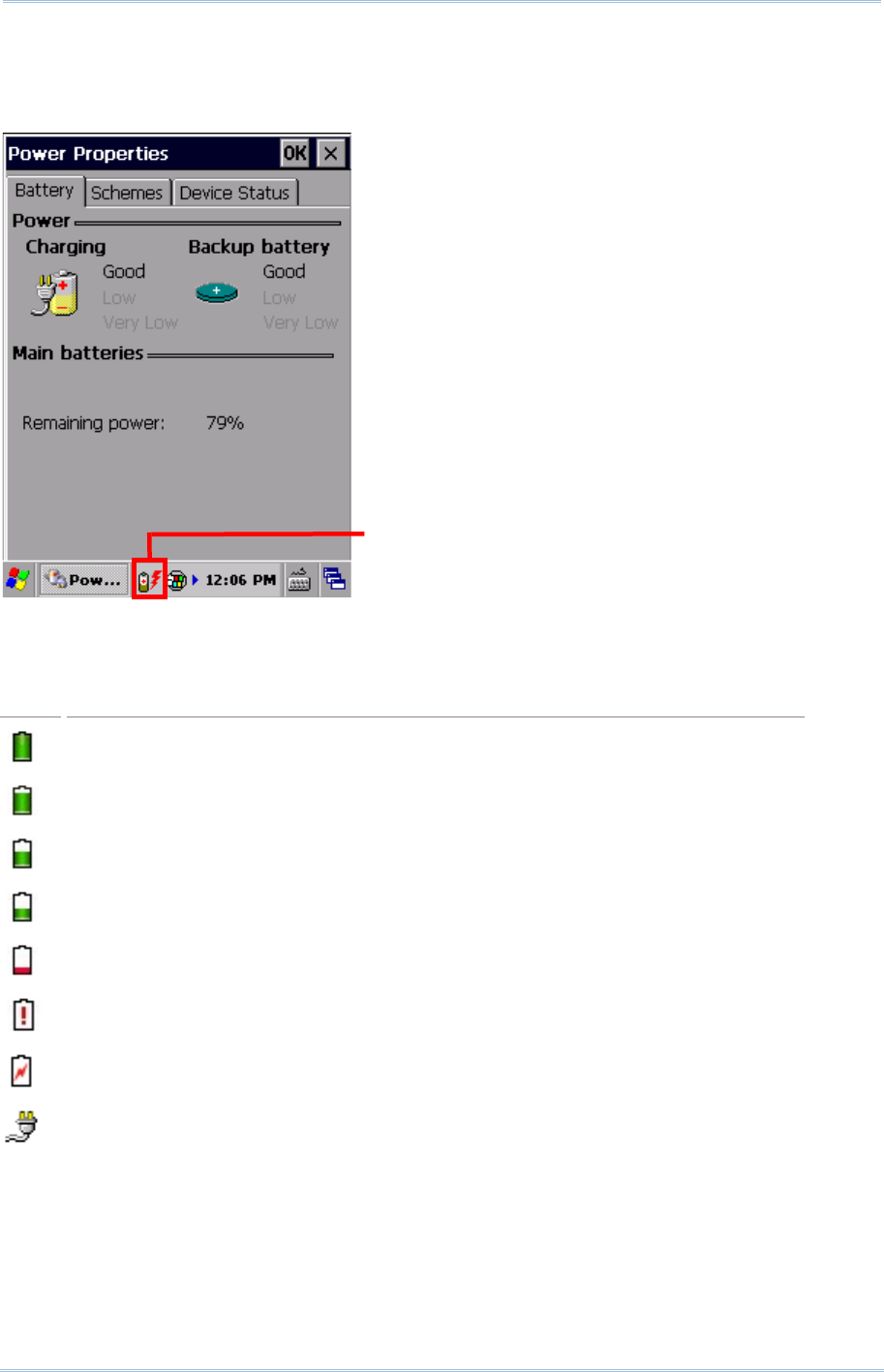
16
9700 Mobile Computer (CE) Reference Manual
BATTERY STATUS ICONS
The OS features a couple of icons that deliver main battery status. These icons can be found
on the taskbar, which is settled at the bottom of every screen.
Battery level is illustrated by the following icons :
Icon Battery Status
Main battery level is 91%~100%.
Main battery level is 71%~90%.
Main battery level is 51%~70%.
Main battery level is 21%~50%.
Main battery level is 11%~20%.
Main battery level is 1%~10%. Charge or replace main battery immediately!
Main battery isʳbeing charged from external power.
Mobile computer is connected to external power, but main battery level is
full and does not need charging.
Batter
y
char
g
in
g
icon
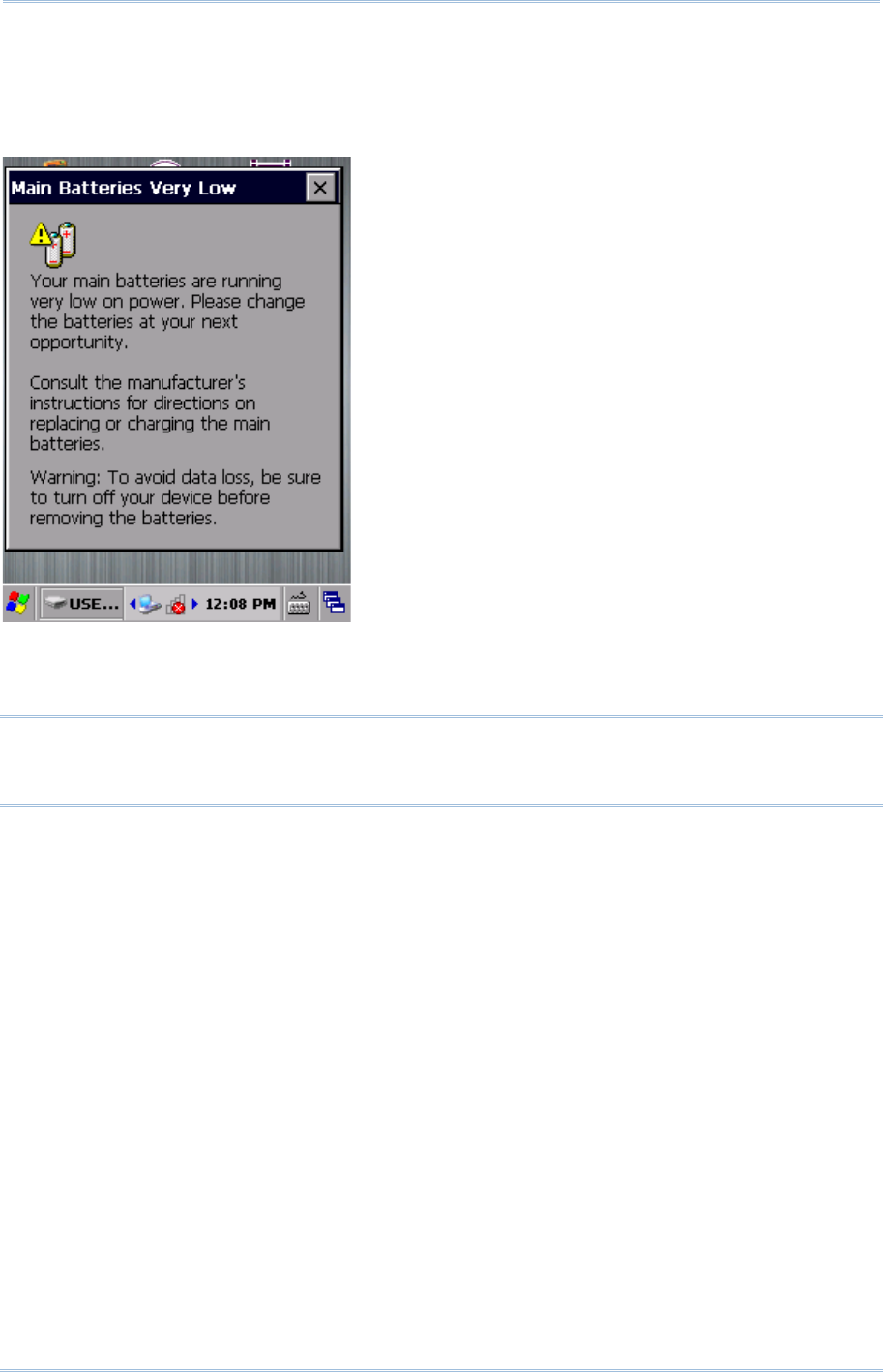
17
Chapte
r
1 Use Mobile Compute
r
LOW BATTERY ALERT
When main battery level drops below 40%, the mobile computer prompts “Main Battery
Low” for a recharge. When further reduced to under 20%, the mobile computer prompts
“Main Battery Very low” to solicit your immediate action.
Low battery may incur shutdown to the mobile computer and cause DRAM data damage.
Always save data before running short of power or keep a fully charged battery at hand for
replacement.
Note: Constant usage of the mobile computer at low battery level can affect battery life. For
maximum performance, recharge the battery periodically to avoid battery drain out
and maintain good battery health.
When main battery drains out, the mobile computer shuts down automatically. Backup
battery takes over to hold DRAM data for 30 minutes if it is fully charged. When this occurs,
replace main battery pack immediately to avoid data loss.
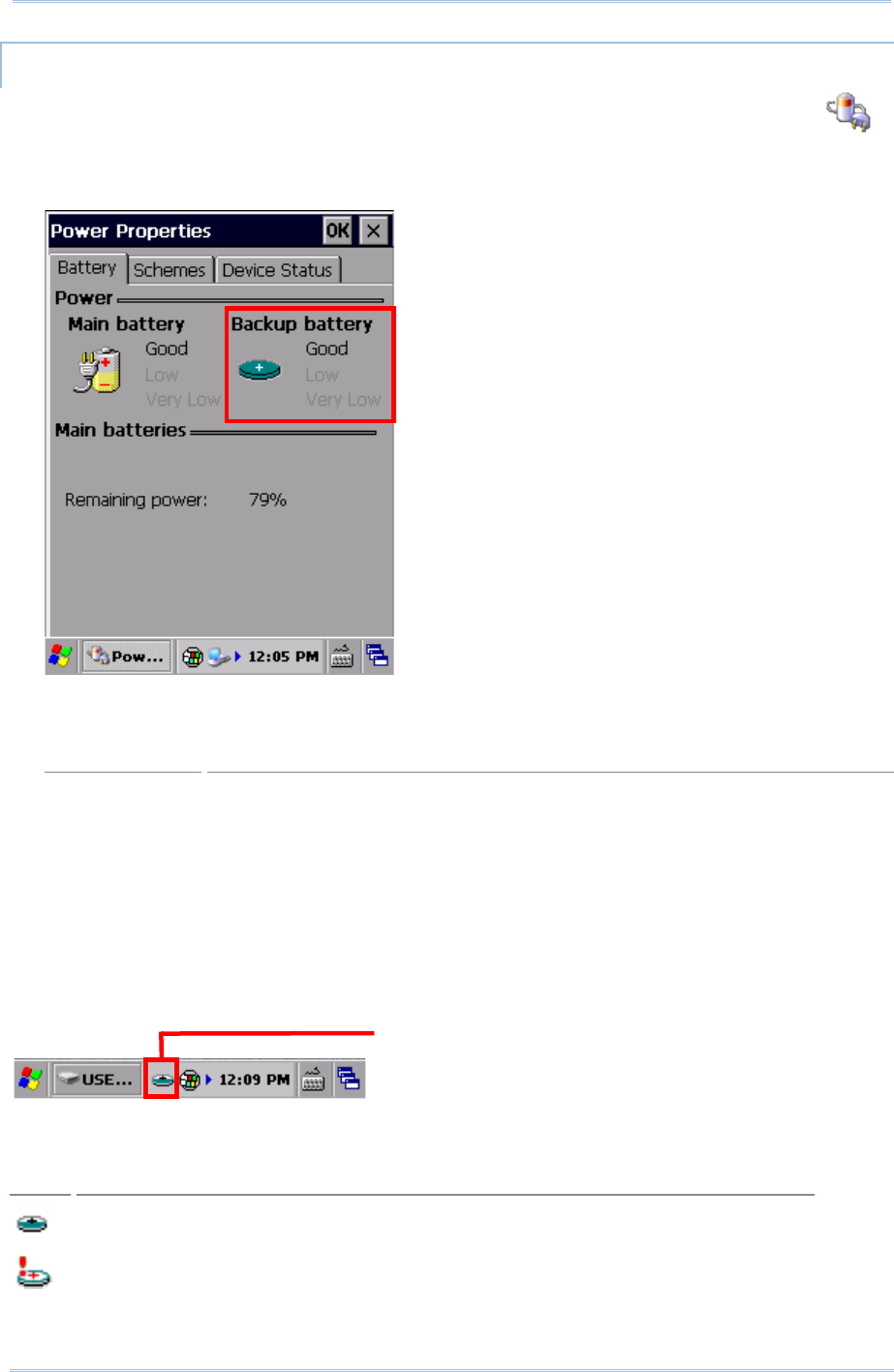
18
9700 Mobile Computer (CE) Reference Manual
BACKUP BATTERY LEVEL
1) To check backup battery level, tap Start |Settings | Control Panel |Power .
On Battery tabbed page of Power Properties window, backup battery level is
summarized as “Good”, “Low” or “Very Low” under the Power label.
Backup battery level descriptions are as follows:
Description Battery Status
Good Backup battery level is good.
Low Backup battery level is low. Charging is recommended.
Very Low Backup battery level is very low and needs to be charged immediately.
BATTERY STATUS ICONS
When backup battery level is low, an icon pops-up on the taskbar as a sign of notification.
Battery level is summarized into three levels:
Icon Battery Status
Backup battery level is low.
Backup battery level is extremely low and requires charging immediately.
Backu
p
batter
y
low icon
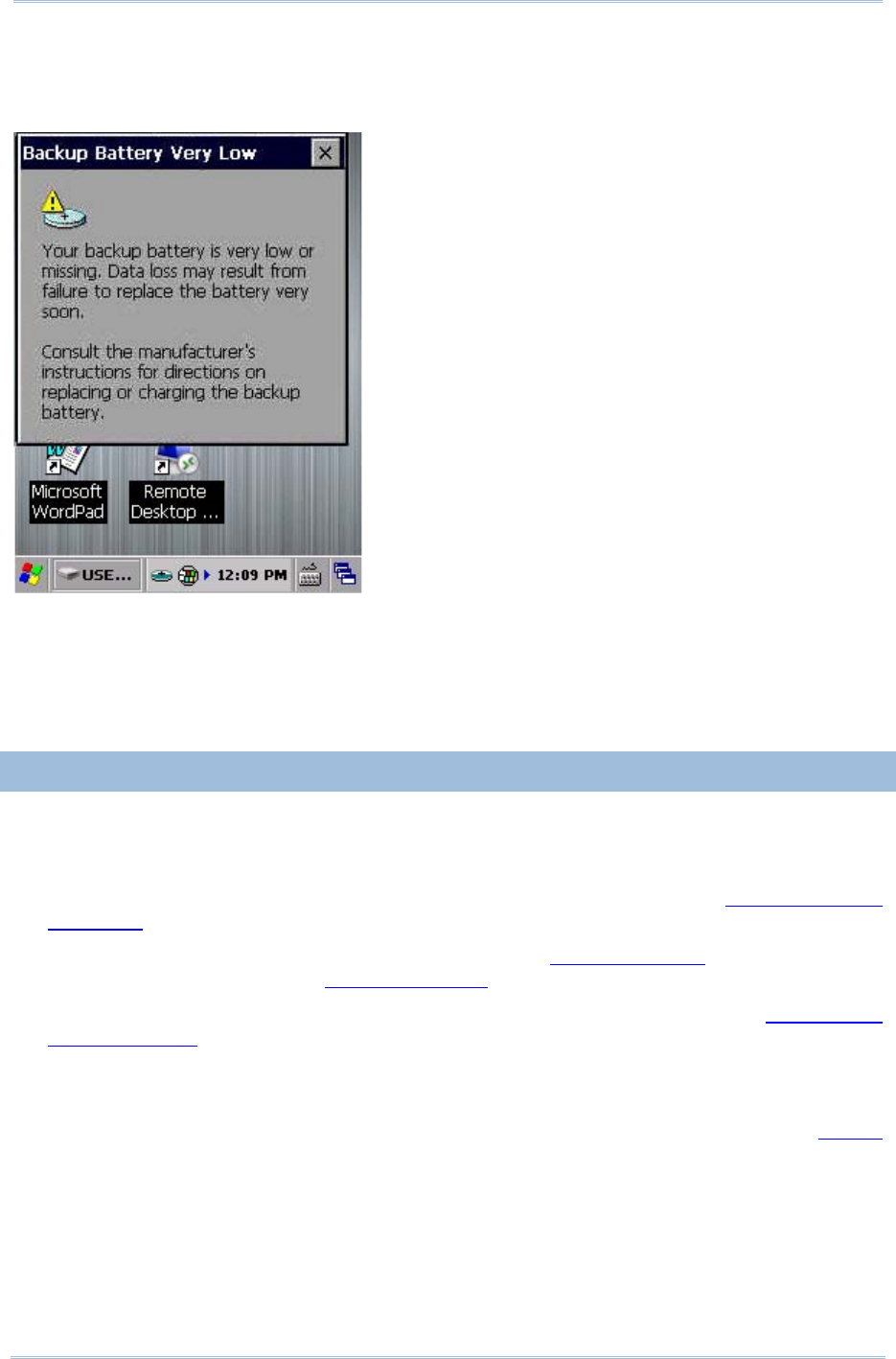
19
Chapte
r
1 Use Mobile Compute
r
LOW BATTERY ALERT
When backup battery level drops to “Very Low”, the mobile computer prompts a “Backup
Battery Very Low” warning to alert users that backup battery level is almost drained out.
Backup battery is rechargeable by the main battery pack or the power adapter. Low backup
battery puts DRAM data in great danger. Remember to save data from time to time or keep
a fully charged battery at hand for replacement.
Once backup battery drains out completely, the data in DRAM is gone. Any data that has not
been saved will be lost!
1.4.4. POWER MANAGEMENT
Power issues are critical for portable devices. Always turn off the features you don’t need on
the mobile computer in order to save power. To extend battery life as long as possible,
always take the following actions:
Suspend the mobile computer when it isn’t actively in use. See Suspend Mobile
Computer
Turn down LCD backlight brightness as described in Adjust Backlight, and set a shorter
LCD timeout as described in Auto-Suspension
Auto Sync the mobile computer with your PC less frequently. See Direct Data
Communication
If you are using any “push e-mail” or any automatic syncing service on the mobile
computer, change the syncing schedule to manually check updates
When Wi-Fi, Bluetooth, mobile data (HSPA+), or GPS isn’t in use, turn it off. See Radios
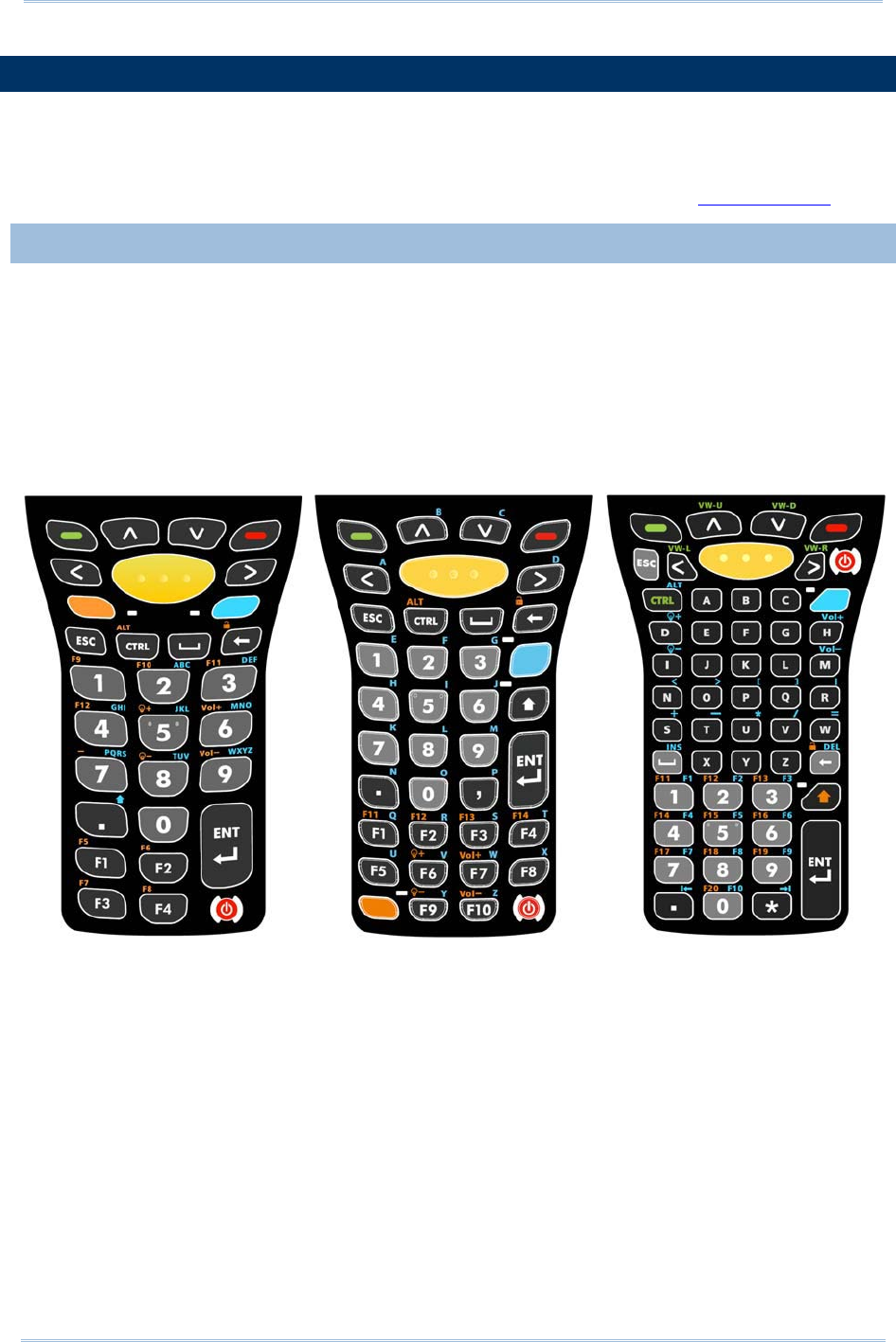
20
9700 Mobile Computer (CE) Reference Manual
1.5. KEYPAD
The mobile computer has a physical keypad and a touchscreen to receive user’s input.
Among the two, the touchscreen provides more intuitiveness in interacting with the device.
This section shows how to input text using physical keypad and on-screen keyboard. To
know how to operate the mobile computer using the touchscreen, see Touch Control.
1.5.1. PHYSICAL KEYPAD
The physical keypad on the front of the mobile computer bears much resemblance to laptop
or PC keyboards. It is either a numeric type or a QWERTY one, each wedging a set of
“enhanced keys” along the top and a set of character keys at the lower half. Both keypads
support multi-key operation, which normally requires two keys hit simultaneously, one of
which is a modifier key.
As for entering text, the numeric and QWERTY keypad are equally capable of entering
numbers, letters, symbols and punctuationʳmarks. Both also receive supplementary
backlight along with the screen.
Figure 5: 30-key numeric
keypad Figure 6: 38-key numeric &
alpha keypad Figure 7: 53-key alphanumeric
keypad
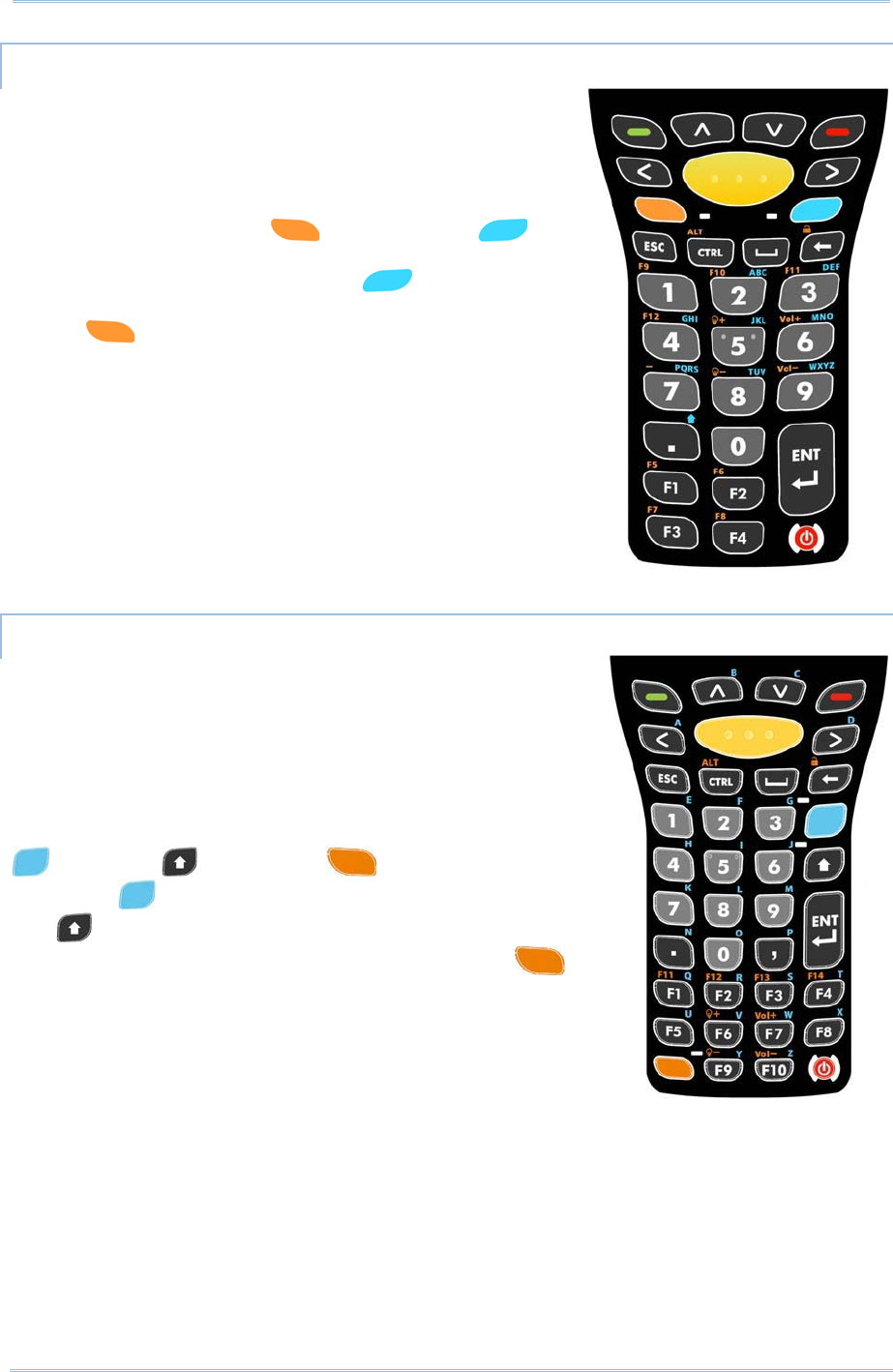
21
Chapte
r
1 Use Mobile Compute
r
NUMERIC KEYPAD (30-KEY)
The numeric keypad possesses 30 keys, including the
number keys 0-9, and Esc, Ctrl, Space, Backspace, Enter
and period key (.). Also featured are function keys F1 to
F4. The power key is seated at the lower right corner of
the keypad.
The modifier keys Fn key and Alpha key are
located under the Basic keys, and can be used to change
the keypad input mode. Alpha key can be used to
enter numbers 2-9 or letters A-Z, or trigger Shift key, and
Fn key , with accompanied use of other keys, can be
used to increase the number of function keys (F5 to F12),
adjust volume and touchscreen backlight, or lock the
keypad.
NUMERIC & FUNCTION KEYPAD (38-KEY)
The numeric and function keypad possesses function keys
(F1 to F10) which can assist usage in special applications.
The keypad provides number keys 0-9, as well as Esc, Ctrl,
Space, Backspace, Enter key, period key (.) and comma key
(,).The power key is also seated at the lower right corner of
the keypad.
The numeric and function keypad also features an Alpha key
, Shift key and Fn key . When triggered, the
Alpha key can be used to enter letters A-Z . The Shift
key is located right below the Alpha key, and is used to
change alphabetic input to uppercase. The Fn key is
seated on the lower end of the keypad, and extends the
number of Fn keys to F14. It can also be used with other
keys to increase the number of function keys (F5 to F12),
adjust volume and touchscreen backlight, or lock the
keypad.
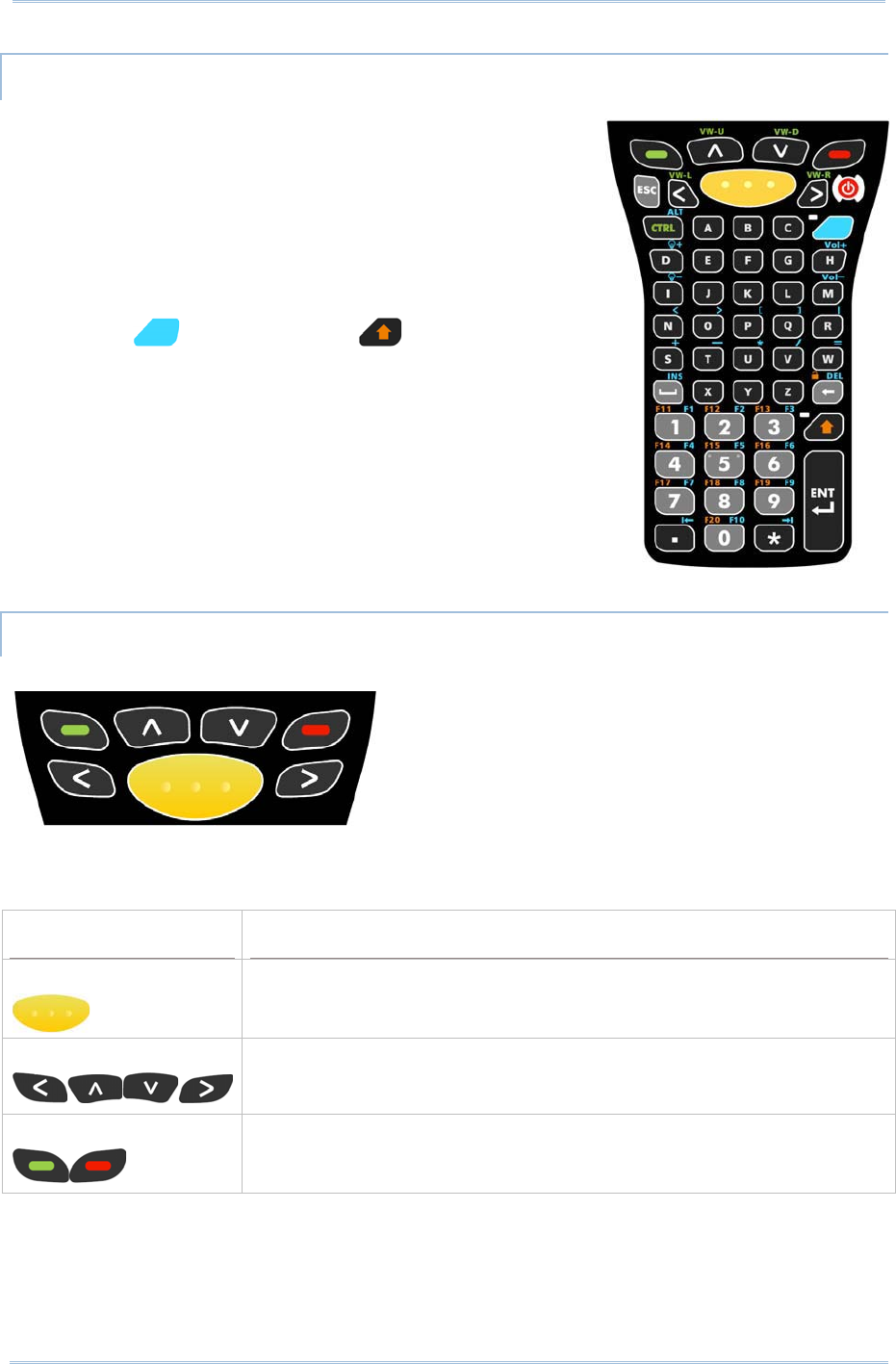
22
9700 Mobile Computer (CE) Reference Manual
ALPHANUMERIC KEYPAD (53-KEY)
The 53-key alphanumeric keypad features not only letter
keys A-Z and number keys 0-9, but also many other keys for
extensive application when connected to a terminal. Also
included are an Esc key, Ctrl key, Backspace key, Shift key,
Enter key, period key (.) and comma key (,). Unlike the
other two keypads, the power key is located near the upper
right corner of the keypad.
As for modifier keys, the alphanumeric keypad features an
Alpha key and Shift key . The alpha key
combined with other keys on the keypad can enter a variety
of symbols, or adjust volume and touchscreen backlight. It
can also be used to trigger the Alt key, function keys F1-F10,
and enter other text editing keys (tab leftward and
rightward). As for the Shift key, it allows entering of Shift+1,
2, 3….10. In addition, it locks the keypad when used with
the Backspace key. The alphanumeric keypad is the most
comprehensive in text input, and is perfect for working with
terminal emulation applications.
BASIC KEYS
These are a set of keys kept at the top of the keypad throughout all three keypad types.
Figure 8: Basic keys
Basic keys deliver the following functions:
Key Description
SCAN KEY Press the scan key to read a barcode in place.
ARROW KEYS The arrow keys are circled around the center scan key. These can be used
to move the cursor up, down, left or right during text input, or move
between items in certain applications.
SEND/END KEY By default, these two keys input the functions F14 and F15. You may also
define their new key functions using CipherLab’s Button Assignment.
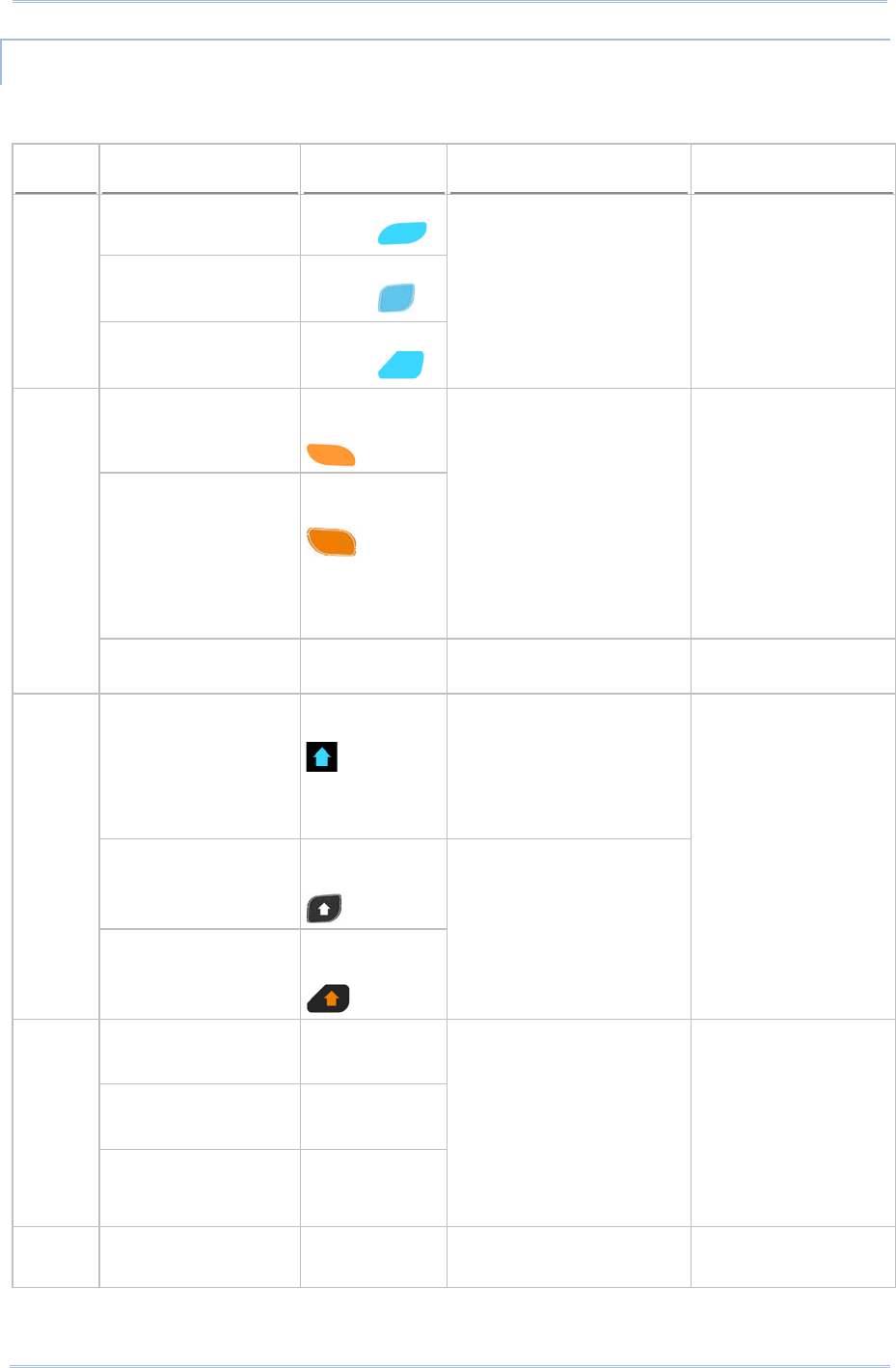
23
Chapte
r
1 Use Mobile Compute
r
MODIFIER KEYS
The keypads have five different modifier keys integrated on it. The key trigger and recovery
methods differ slightly according to keypad type.
Key Keypad Key Location How to enter How to resume
Numeric keypad
(30-key) Available on
keypad
Numeric and function
keypad (38-key) Available on
keypad
Alpha
Alphanumeric keypad
(53-key) Available on
keypad
Press Alpha key once to
enter Alpha Lock mode
Press Alpha key once
more to return to
normal input mode
Numeric keypad
(30-key) Available on
keypad
Numeric and function
keypad (38-key) Available on
keypad Press Fn key once to enter
Fn mode
Keypad returns to
normal input mode
upon pressing any
button
If Alpha key is
pressed, Alpha
mode is
triggered until
Alpha key is
pressed once
more
Fn
Alphanumeric keypad
(53-key) Not available -- --
Numeric keypad
(30-key) Available under
Alpha mode Under Alpha mode, press
the period key (.) once to
enter Shift mode
Under Alpha mode, press
the period key (.) twice to
enter Shift Lock mode
Numeric and function
keypad (38-key) Available on
keypad
Shift
Alphanumeric keypad
(53-key) Available on
keypad
Press Shift key once to
enter Shift mode
Press Shift key twice to
enter Shift Lock mode
Under Shift mode,
keypad returns to
normal input mode
upon pressing any
button
Under Shift Lock
mode, keypad returns
to normal input mode
upon pressing Shift
key once more, or
upon pressing Ctrl or
Alt key
Numeric keypad
(30-key) Available on
keypad
Numeric and function
keypad (38-key) Available on
keypad
Ctrl
Alphanumeric keypad
(53-key) Available on
keypad
Press Ctrl key once to
enter Ctrl mode
Press Ctrl key first,
and then press the
key to deliver the Ctrl
function to. For
instance, press Ctrl
and then A to deliver
Ctrl+A
Keypad returns to
normal input mode
upon pressing any
button
Alt Numeric keypad
(30-key) Available under
Alpha mode Press Alt key once to enter
Alt mode Keypad returns to
normal input mode

24
9700 Mobile Computer (CE) Reference Manual
Numeric and function
keypad (38-key) Available under
Fn mode
Alphanumeric keypad
(53-key) Available under
Alpha mode
Press Alt key first, and
then press the key to
deliver the Alt function
to. For instance, press
Alt and then Enter to
deliver Alt+Enter
upon pressing any
button
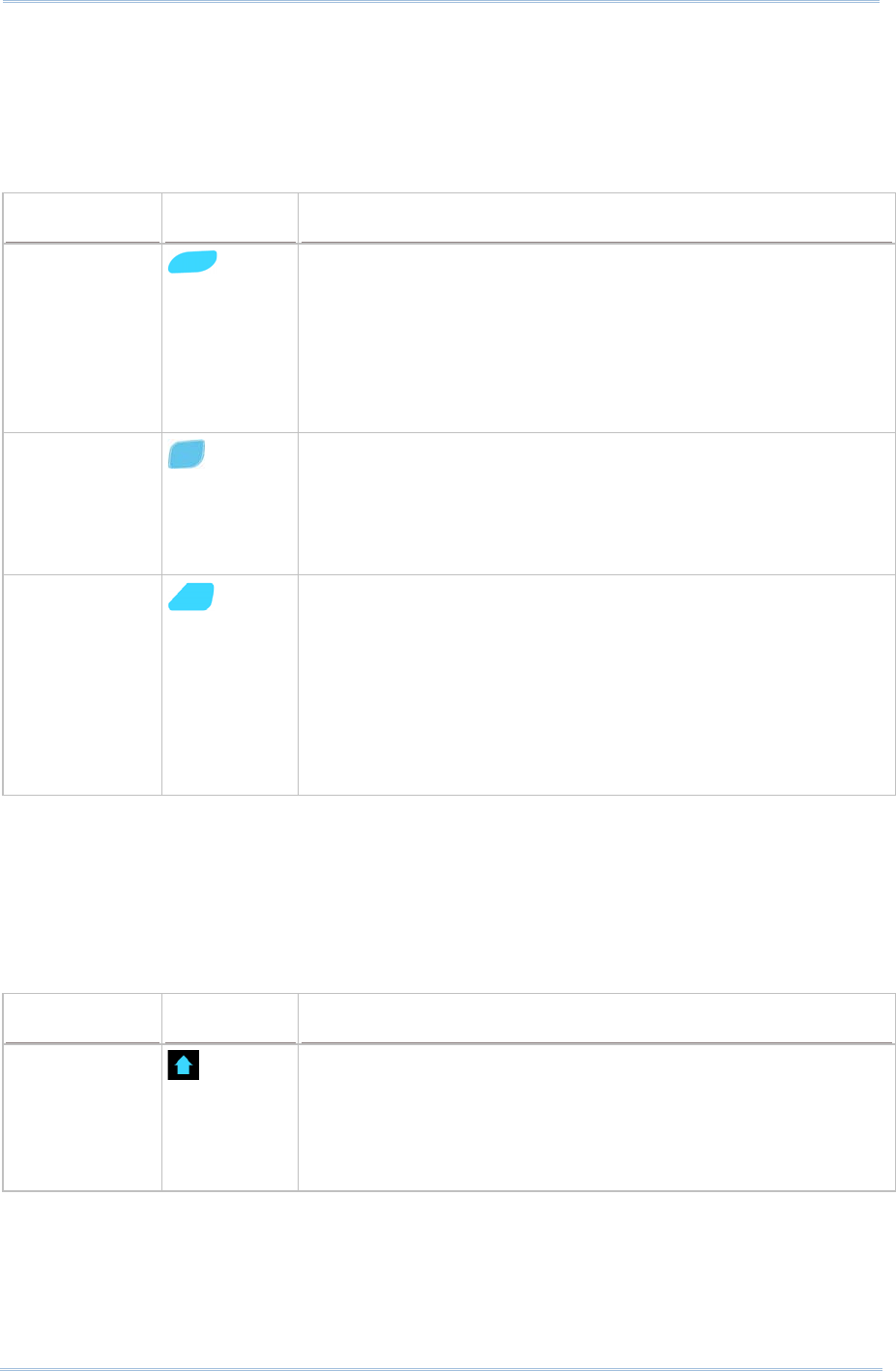
25
Chapte
r
1 Use Mobile Compute
r
ALPHA KEY
The Alpha key is equipped with an LED indicator. When the Alpha key is pressed, the LED
will light up in blue to indicate that Alpha key is activated. When Alpha key is pressed once
more, the LED will go off and the keypad will return to normal input mode.
The Alpha key delivers the following functions on each of the keypads:
Keypad Alpha key Key Function
Numeric keypad
(30-key)
Under Alpha mode, press number keys 2-9 to enter lowercase
letters a-z
Under Alpha mode, press number keys 0 and 1 to enter
punctuation marks
Under Alpha mode, press period key to enter Shift mode, in
which pressing number keys 2-9 enters uppercase letters A-Z,
and pressing arrow keys moves the cursor up, down, left and
right
Numeric &
Function keypad
(38-key)
Under Alpha mode, press arrow keys, number keys 0-9,
Function keys F1-F10 and punctuation keys to enter lowercase
letters a-z
Under Alpha mode, press Shift key to enter Shift mode, in
which pressing arrow keys, number keys 0-9, Function keys
F1-F10 and punctuation keys enters uppercase letters A-Z
Alphanumeric
keypad
(53-key)
Under Alpha mode, press letter keys A-Z to enter symbols,
adjust volume or touchscreen backlight
Under Alpha mode, press Ctrl key to trigger Alt mode
Under Alpha mode, press Space/Backspace key to enter
Insert/Delete
Under Alpha mode, press number keys 0-9 to trigger function
keys F1-F10
Under Alpha mode, press period key (.) or asterisk key (*) to
move to the previous or next tab spot
SHIFT KEY
The Shift key is equipped with an LED indicator. When the Shift key is pressed once, the LED
will light up in green to indicate that Shift key is activated. The LED goes off after another
key is pressed and the keypad returns to normal input mode. When the Shift key is pressed
twice, the LED will stay lit until Shift key is pressed once more.
The Shift key delivers the following functions on each of the keypads:
Keypad Shift key Key Function
Numeric keypad
(30-key) (Alpha mode)
Under Alpha mode, press Shift key to enter Shift mode, and
press number keys 2-9 to enter uppercase letters A-Z
Under Alpha mode, press Shift key to enter Shift mode, and
press arrow keys to move the cursor up, down, right or left
Under Alpha mode, press Shift key to enter Shift mode, and
press F1 to F4 to enter Shift+F1 to F4
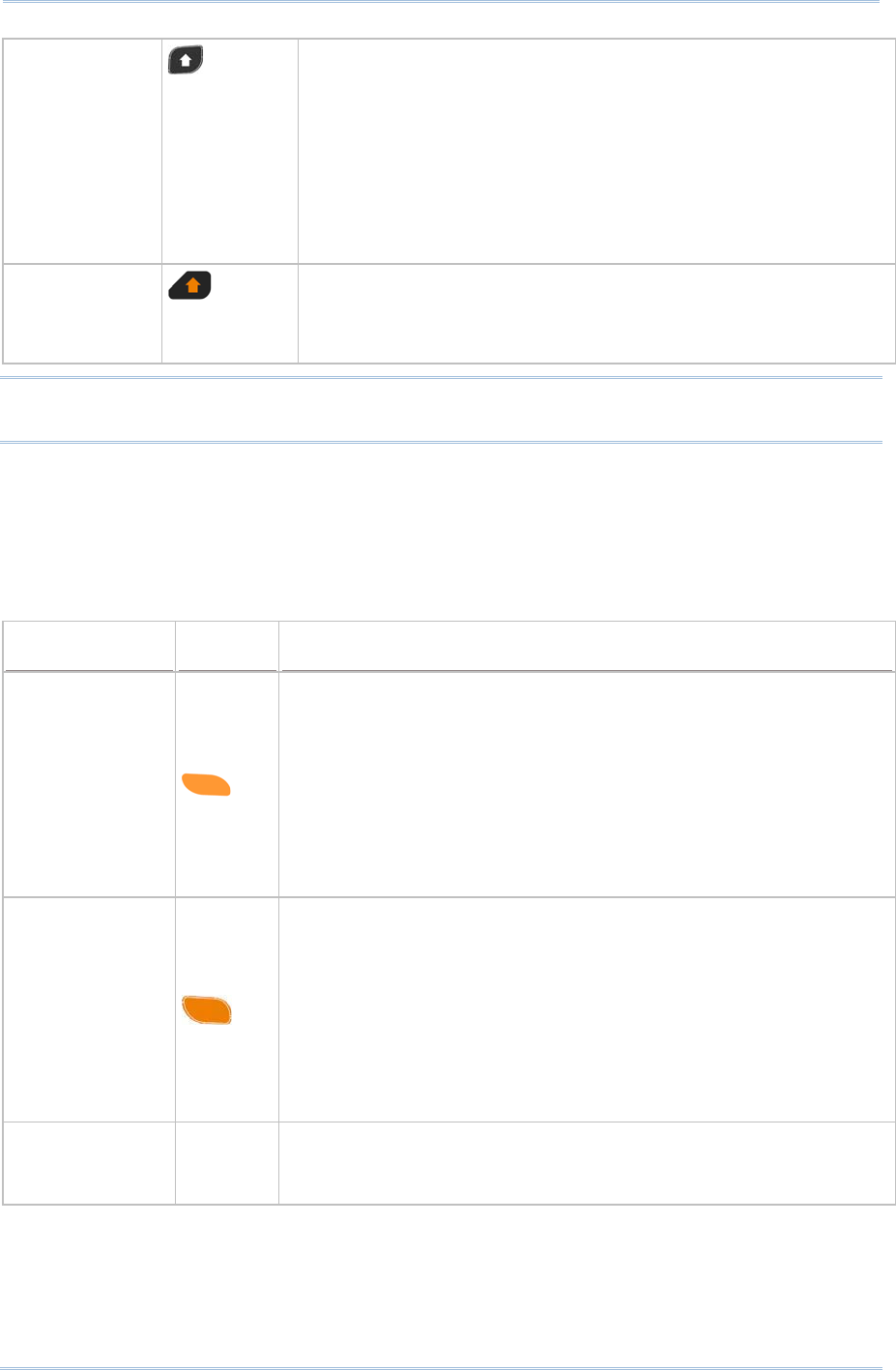
26
9700 Mobile Computer (CE) Reference Manual
Numeric &
Function keypad
(38-key)
Under Shift mode, press number keys 0-9 to enter Shift+0-9
Under Shift mode, press arrow keys to move the cursor up,
down, right or left
Under Shift mode, press Backspace key to lock the keypad
Under Shift mode, press End/Send key to enter Shift+F14/F15
Under Shift mode, press F1 to F10 to enter Shift+F1 to F10
Under Shift mode, press arrow keys, number keys 0-9,
function keys F1 to F10, period key and comma key to enter
uppercase letters A-Z
Alphanumeric
keypad
(53-key)
Under Shift mode, press letter keys a-z to enter uppercase
keys A-Z
Under Shift mode, press 0-9 to trigger function keys F11 to
F20
Note: If you are using the on-screen keyboard, tap CAP (Caps Lock) to switch between
uppercase and lowercase alphabetic modes.
FUNCTION KEY
The Function key is equipped with an LED indicator. When the Function key is pressed, the
LED will light up in orange to indicate that Function key is activated. When Function key is
pressed once more, the LED will go off and the keypad will return to normal input mode.
The Function key delivers the following functions on each of the keypads:
Keypad Fn key Key Function
Numeric keypad
(30-key)
Under Function mode, press number keys 1-4 and function keys
F1-F4 to enter function keys F5-F12
Under Function mode, press other number keys to adjust
volume, touchscreen backlight or enter a hyphen (-)
Under Function mode, press arrow keys to deliver Home, End,
Page Up, Page Down
Under Function mode, press Ctrl key to activate Alt key
Under Function mode, press Backspace to lock the touchscreen
Under Function mode, press space key to open the Start menu
Numeric &
Function keypad
(38-key)
Under Function mode, press number keys 1-4 and function keys
F1-F4 to enter function keys F11-F14
Under Function mode, press other Fn keys to adjust volume,
touchscreen backlight
Under Function mode, press arrow keys to deliver Home, End,
Page Up, Page Down
Under Function mode, press Ctrl key to activate Alt key
Under Function mode, press Backspace to lock the touchscreen
Under Function mode, press space key to open the Start menu
Alphanumeric
keypad
(53-key)
Not
available None
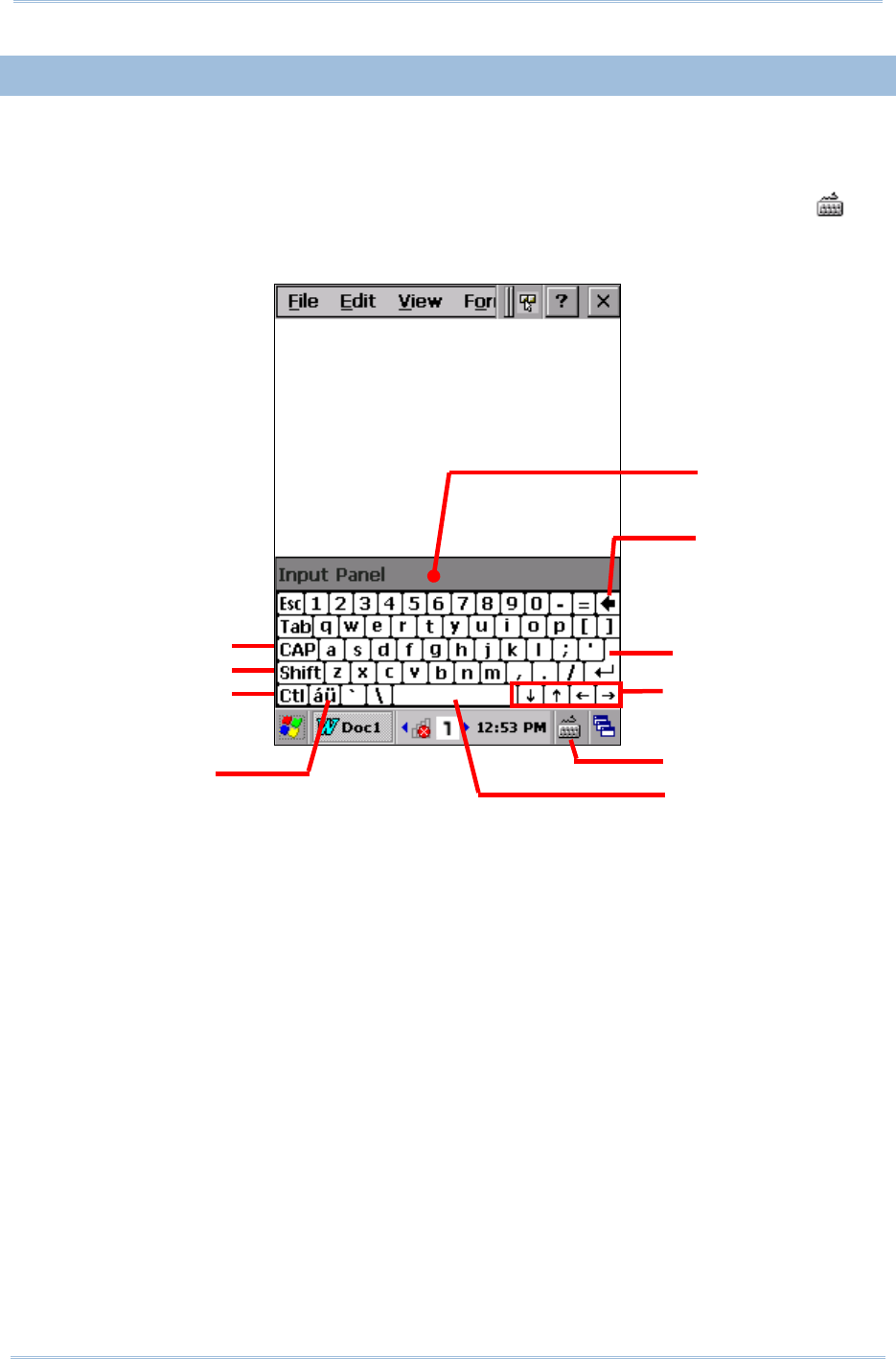
27
Chapte
r
1 Use Mobile Compute
r
1.5.2. ON-SCREEN KEYBOARD
The OS provides users with an on-screen keyboard. The on-screen keyboard supports
entering a series of diacritics for European languages by tapping a modifier key.
The on-screen keyboard auto-opens in some applications when a text input field is selected.
In case the on-screen keyboard doesn’t open automatically, tap the keyboard icon on
the taskbar and select Keyboard to open it. When opened, the on-screen keypad is ready
to enter lowercase letters, numbers, and a few frequently used symbols.
Shift key
Ctrl key
Caps Lock
Input modifier
Backspace
Enter ke
y
Space bar
Navigation keys
Opens menu to hide
on-screen keyboard
On-screen
keyboard opens.
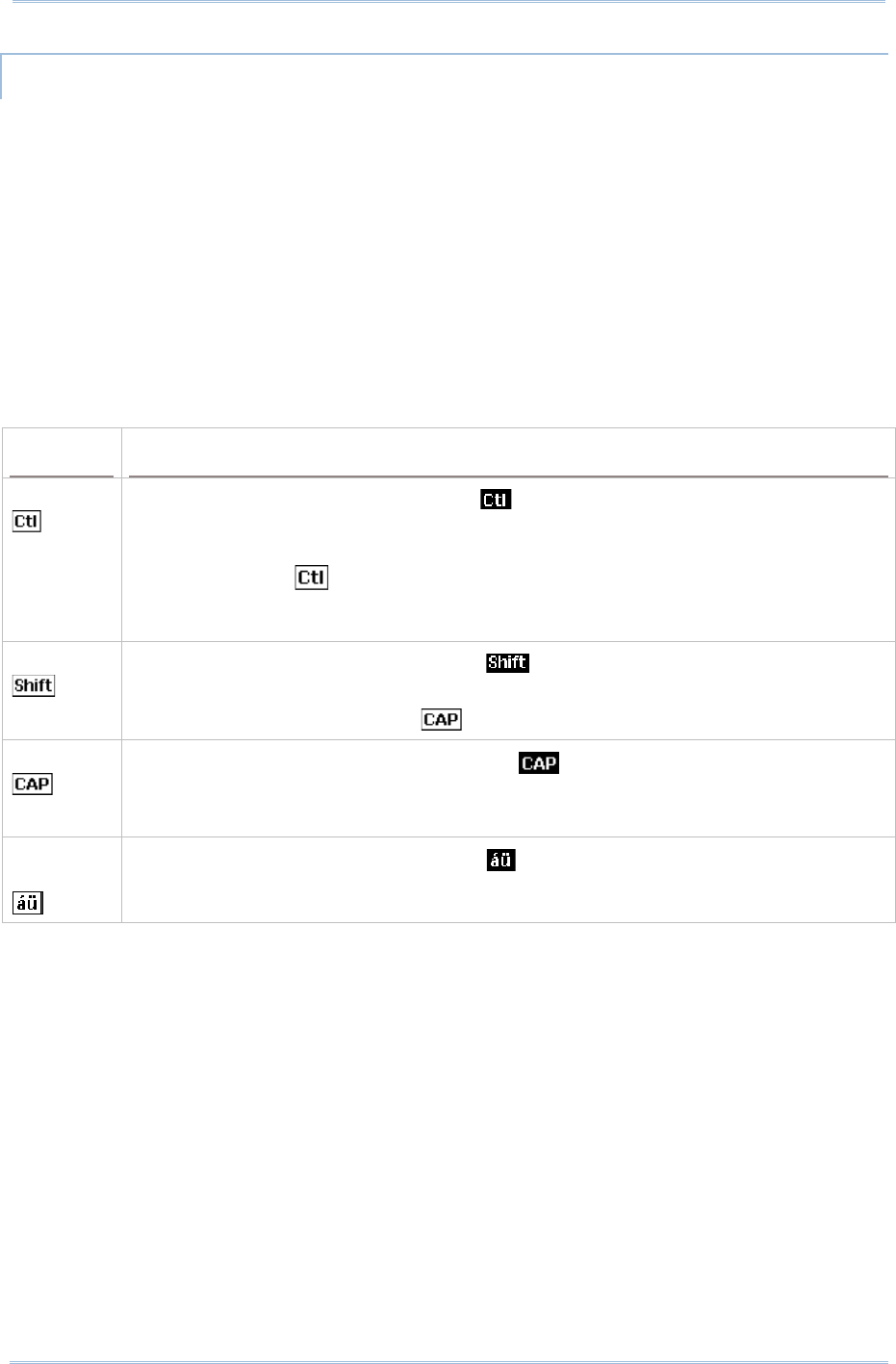
28
9700 Mobile Computer (CE) Reference Manual
MODIFIER KEYS
Although the touchscreen is a resistive single-touch type, use of modifier keys, which
normally involves hitting two keys, are still available on the on-screen keyboard.
On the on-screen keyboard there are four modifier keys, which are seated at the left edge.
These keys work as follows:
1) Press a modifier key on on-screen keyboard.
The on-screen keyboard enters modifier state.
2) Press the second key.
The desired performance will be produced in the active application or on the screen open
at the moment.
Modifier keys are explicated as following
Key Description
Ctrl key Once tapped, it becomes color-inverted and causes a special action from OS or the
active application when a character key is tapped. It quits once the said action is
triggered or when it is tapped again.
For example: Tap key and then tap key “A” to produce Ctrl+A function, which in
Windows environment usually selects all content on the active screen. Once “A” is
tapped, the on-screen keyboard quits Ctrl state.
Shift key Once tapped, it becomes color-inverted and capitalizes the letter typed. It quits
once a character key is tapped or it is tapped again.
To enter all caps, use Caps Lock .
Caps Lock Once tapped, it becomes color-inverted and capitalizes all the alphabetic
characters typed. It doesn’t quit until it is tapped again.
This key does not affect numbers, punctuation marks, or symbols.
Input
modifier Once tapped, it becomes color-inverted and presents a series of accented vowels
such as ä, æ, ë, ï, ö, ú or letter variants such as ß and ç which are needed for European
languages. It quits once a character key is tapped.
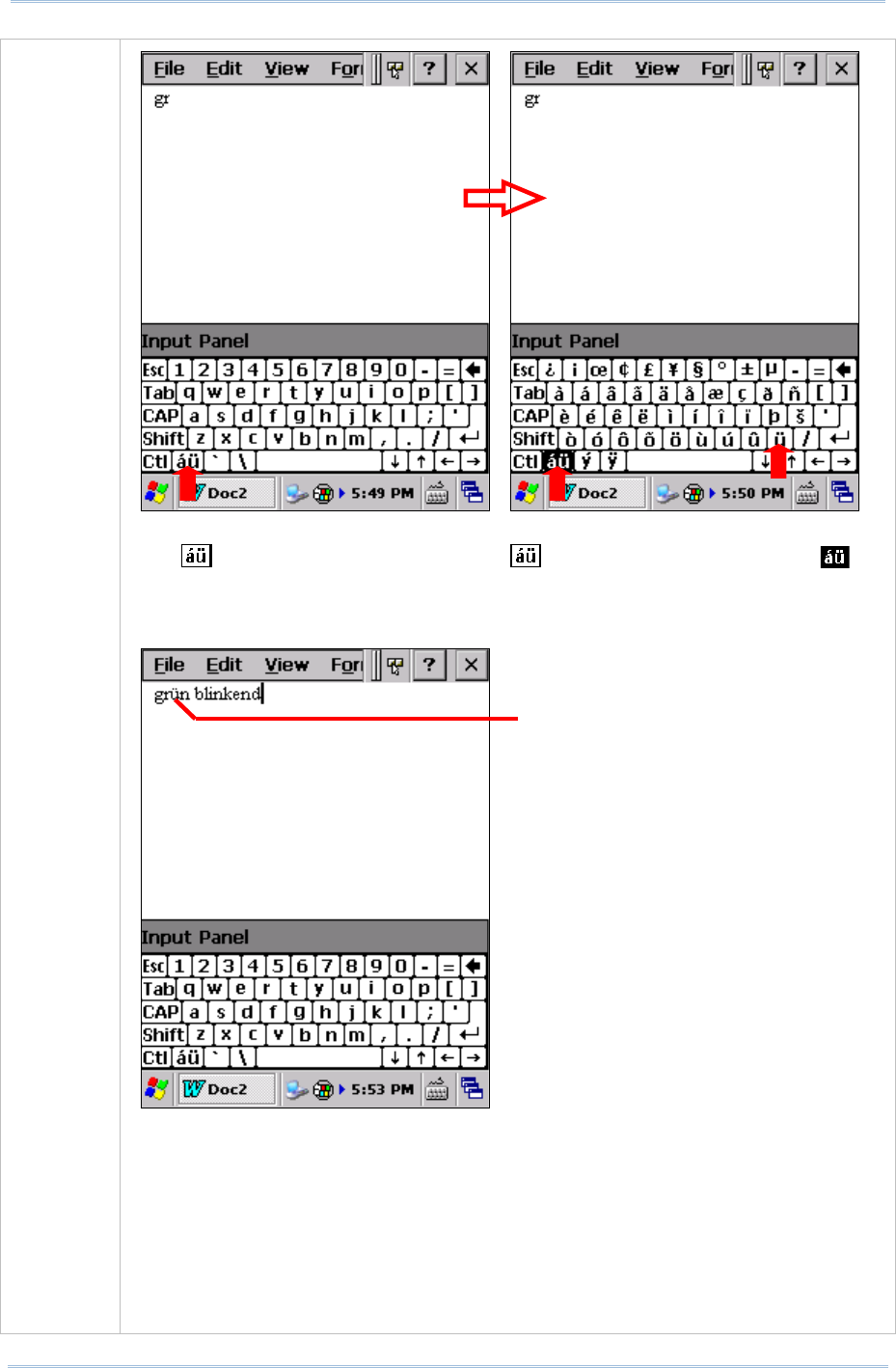
29
Chapte
r
1 Use Mobile Compute
r
Tap key on on-screen keyboard. key becomes color-inverted .
Then tap a character key.
After the letter variant “ü” is entered,
the on-screen keyboard restores to
normal English alphanumeric layout.
Diacritical letters and letter variants are presented both in lowercase and
uppercase.
M
N
Letter variant “ü” is entered
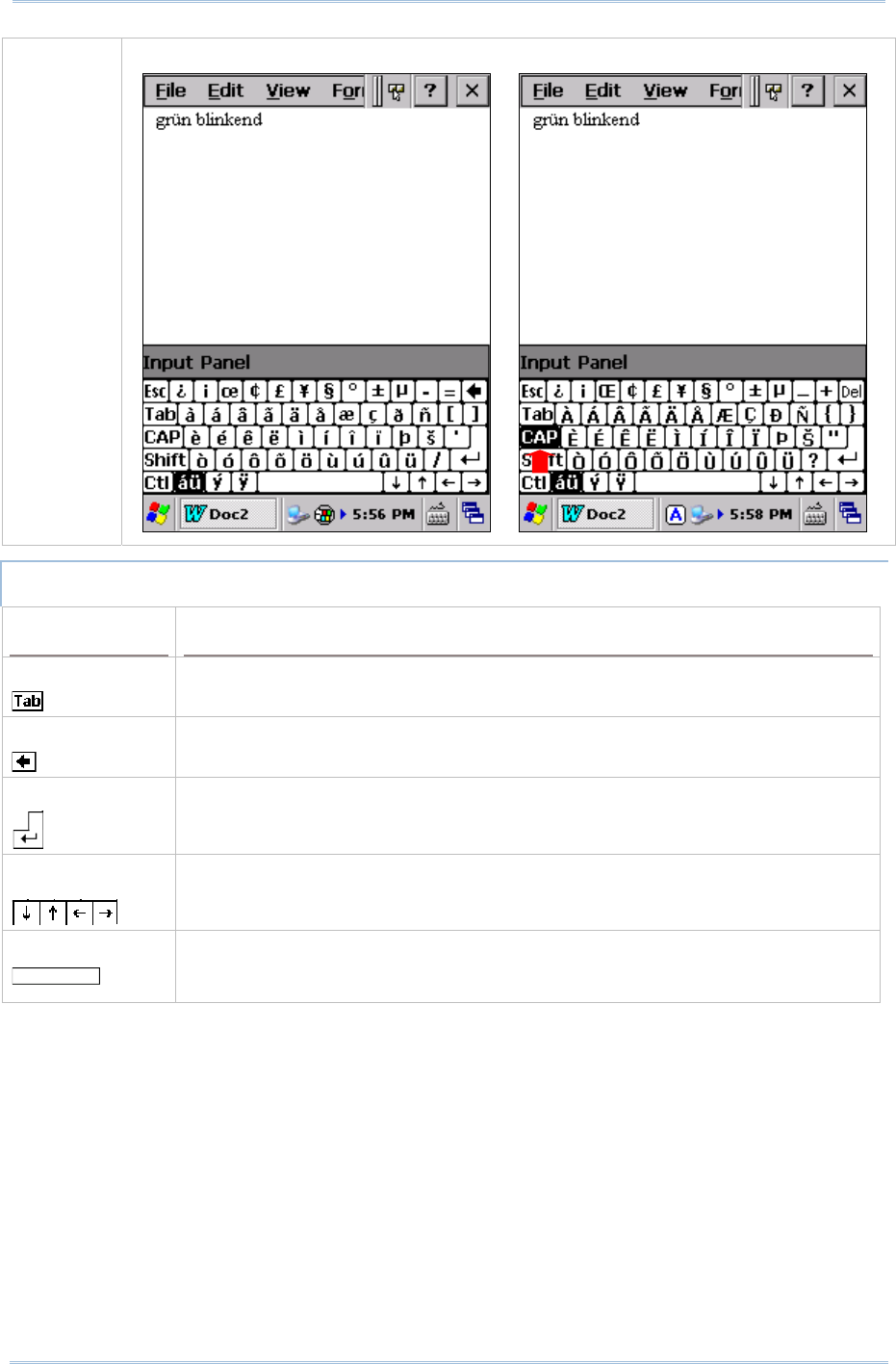
30
9700 Mobile Computer (CE) Reference Manual
Lowercase Uppercase
OTHER KEYS
Key Description
Tab key Navigates among the highlight items in some applications. For text input, it
inserts Tab character, which means it moves caret to the next tab stop.
Backspace Erases the characters to the left of caret.
Enter key Executes a command or confirms input. When text input, it inserts a break
between paragraphs.
Navigation keys Move caret in an input field. In certain applications, they navigate vertically or
horizontally among highlight items.
Spacebar Inserts a blank space where caret is.
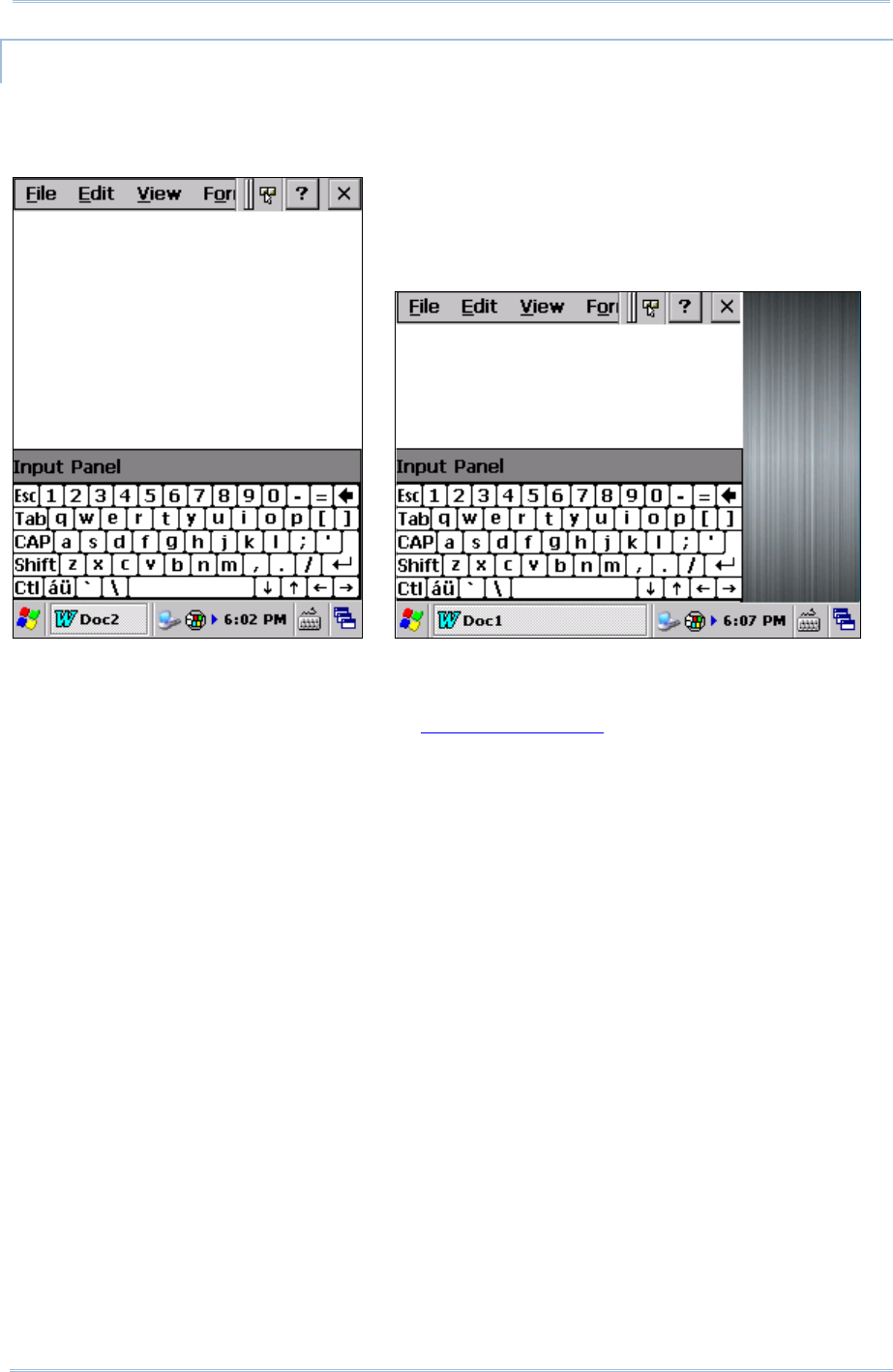
31
Chapte
r
1 Use Mobile Compute
r
CHANGE KEYBOARD ORIENTATION
The mobile computer is built-in with a G-sensor and supports screen orientation, which is
enabled by default. So when the mobile computer turns sideways or upright, the screen
changes its orientation, and on-screen keyboard also readjusts itself to the new orientation.
Upright (Portrait Mode) Sideways (Landscape Mode)
To disable automatic screen rotation, see Screen Orientation.
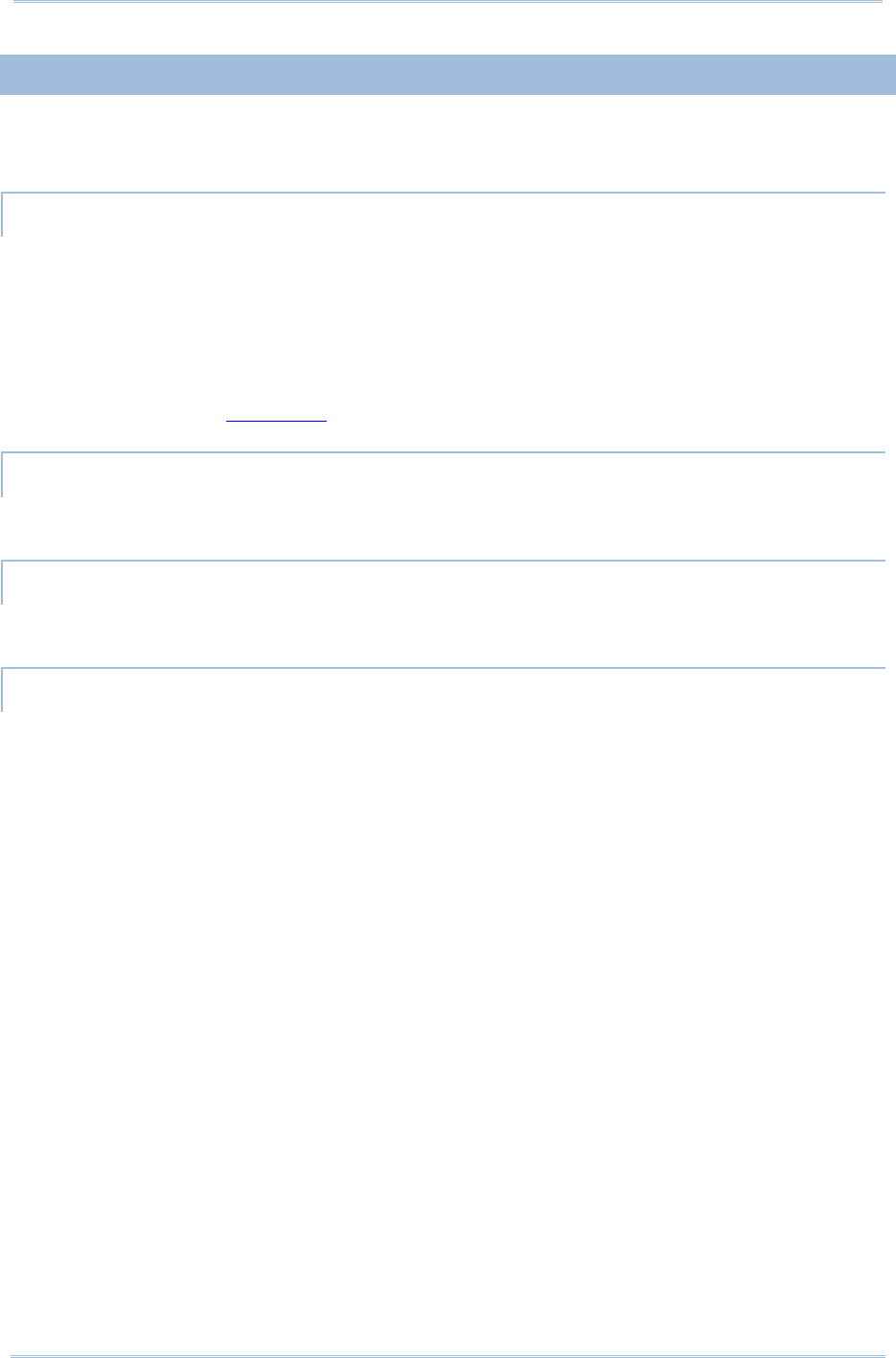
32
9700 Mobile Computer (CE) Reference Manual
1.5.3. EDIT TEXT
On the mobile computer, cut, copy, and paste text within an application or across
applications by the menu commands. Some applications don’t support editing some or all of
the text they display while others may offer their own way to edit text.
EDIT TEXT IN INPUT FIELDS
To edit text in a text input field:
1) Tap where you want to edit text.
Caret moves to the desired place and manifests itself as a vertical bar that blinks to
indicate where the typed or pasted text will be inserted.
2) Type, paste or delete text.
To paste text, see Paste Text.
SELECT TEXT
When you see some text on a page you want to copy, select it first by tapping and dragging
the caret so the desired text is highlighted.
CUT OR COPY TEXT
After a text is selected, tap the Edit menu on the title bar of the active window to open an
option menu that includes Copy/Cut commands. Tap them to copy/cut the selected text.
PASTE TEXT
Within the OS, texts can be copied to and from certain applications.
To paste text:
1) Tap the text field where you want to paste the text.
2) Tap the Edit menu on the title bar of the active window and select the Paste command.
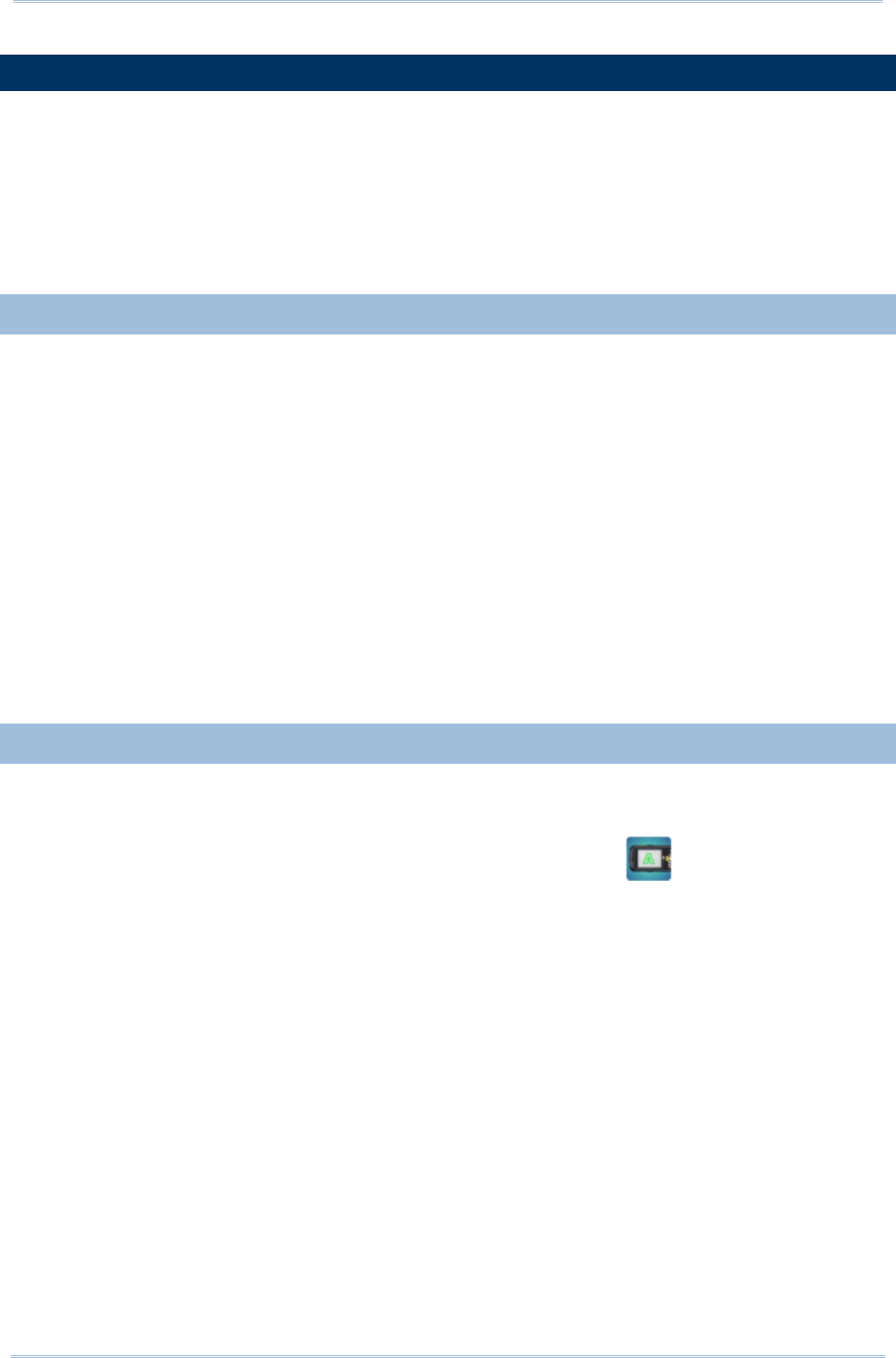
33
Chapte
r
1 Use Mobile Compute
r
1.6. TOUCH CONTROL
The mobile computer’s LCD is overlaid by a resistive touch panel and thus forms a resistive
touchscreen. Since a resistive touchscreen locates the user’s touch by the force applied on
it, by operating with the stylus one can apply minimum force to trigger actions from the
touchscreen.
Touch control is one of the main ways to interact with the mobile computer. It provides the
ability to manipulate icons, buttons, menu commands, the on-screen keyboard, or any
on-screen items.
1.6.1. USE TOUCHSCREEN
The mobile computer comes with a stylus. Use it to touch-operate the mobile computer.
Apply the gestures below to work on the touchscreen:
Tap – Touch any item on the screen such as an application icon or a setting icon to work
on it, or touch any key on the on-screen keyboard to type it.
Tap and hold – Touch an item on the screen and do not release until an action occurs.
Drag – Touch and hold an item for a moment and then, without release, move the item
on-screen until you reach the target.
Double-tap – Touch quickly twice on certain screens to zoom. For example, double-tap
a section of a webpage in a web browser to zoom that section so it fits the width of the
screen. Some applications such as map-info applications support picture zooming with
double-tap.
Rotate screen – On most screens, the screen rotates as the mobile computer changes
its orientations between upright and sideways.
1.6.2. SCREEN ORIENTATION
The mobile computer has a built-in G-sensor for screen orientation. In order to enable
automatic screen orientation:
1) Tap Start |Settings | Control Panel | Screen Rotation .
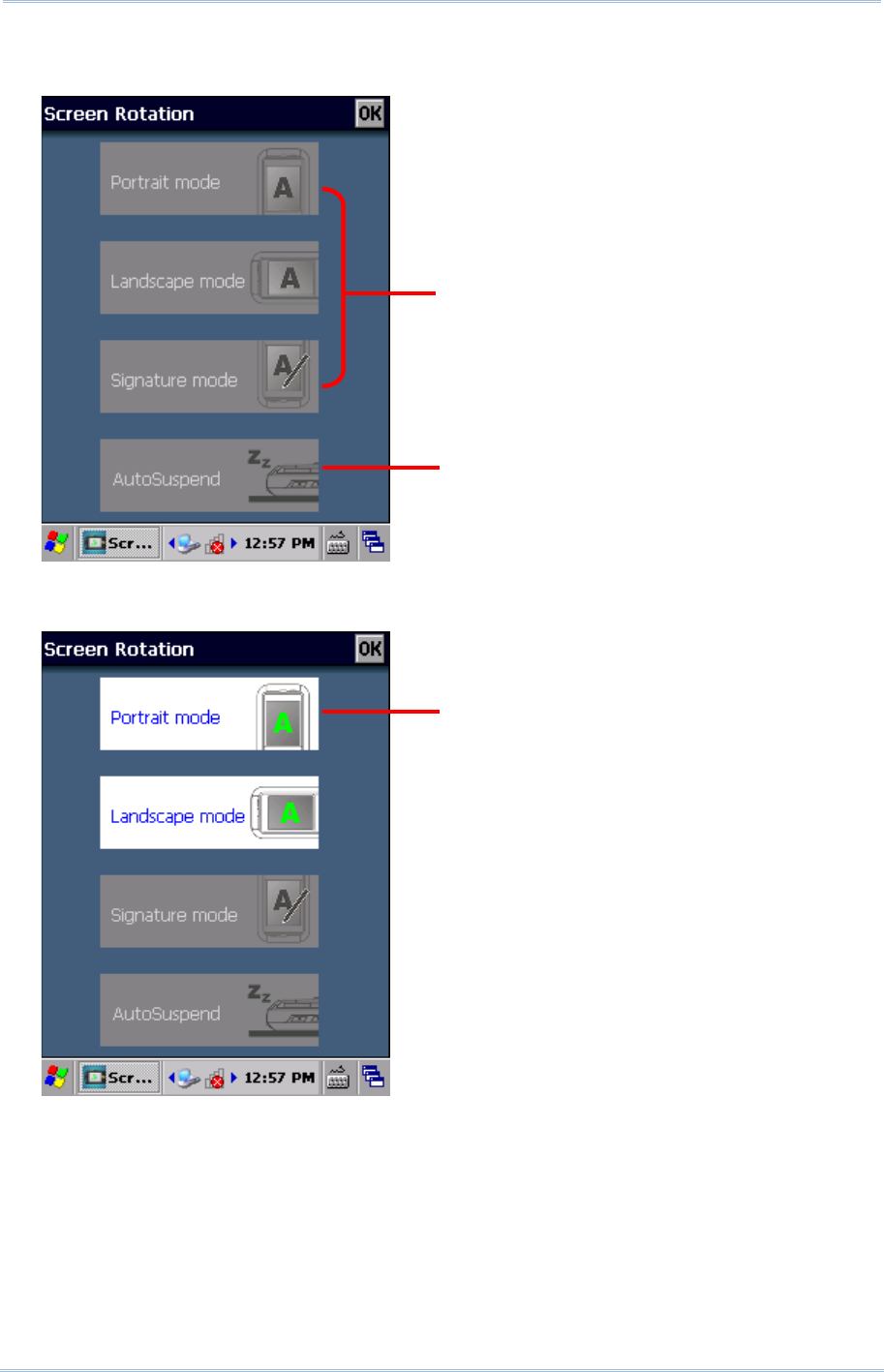
34
9700 Mobile Computer (CE) Reference Manual
Screen Rotation window opens with three orientation modes to select from and an
option to suspend the mobile computer when the screen is facing down.
2) Tap the modes that you wish to enable. The tapped item will light up to indicate it is
currently enabled.
3) Tap OK on the title bar to apply the changes.
The mobile computer will then automatically switch between the enabled modes
according to its physical orientation. For instance, if Portrait and Landscape modes
are enabled, the touchscreen will switch between upright and sideways view according
to the user’s holding position. However, if only Portrait (upright) mode is enabled, the
touchscreen will stay in upright mode regardless of the mobile computer’s orientation.
Three screen orientation
modes
Allows mobile computer to
enter suspension when
facing down
Tapped items will light up
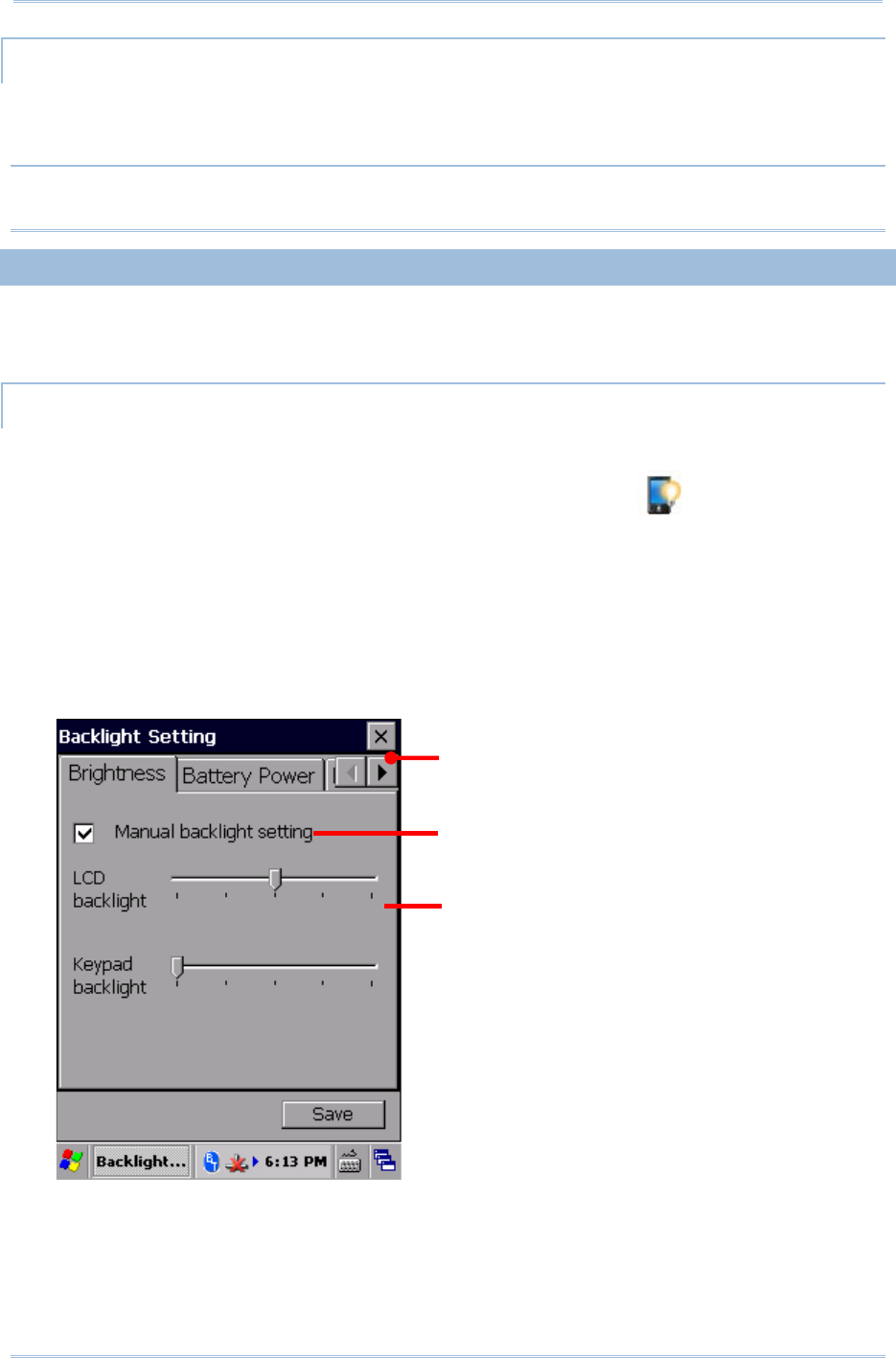
35
Chapte
r
1 Use Mobile Compute
r
SIGNATURE MODE
The signature mode is for combined usage with the CipherLab application Signature. With
this mode enabled, the screen will immediately rotate 180°when the front of the mobile
computer is tilted outwards, which is convenient for signing by a second party.
Note: If no modes are selected in Screen Rotation, the mobile computer’s touchscreen
will be fixed in portrait mode.
1.6.3. ADJUST BACKLIGHT
Screen backlight can be adjusted manually or automatically. Upon shipping, the mobile
computer is set to automatic adjustment, which helps saves power. Alternatively you can
set the backlight manually according to your preferences.
MANUAL BACKLIGHT ADJUSTMENT
To adjust screen backlight:
1) Tap Start | Settings | Control Panel | Backlight Setting .
Brightness tabbed page opens with a checkbox to enable manual backlight setting, and
a slider bar for setting screen backlight level.
By default, Manual backlight setting is checked, and screen and keypad backlights
will stay at the set level and will not adjust automatically. When Manual backlight
setting is unchecked, the light sensor embedded on the front of the mobile computer
will detect current lighting environments, and screen and keypad backlights will adjust
automatically according to the backlight profiles set under the Profile tabbed page.
2) Tap Save in the lower right corner to apply the settings.
Brightness tabbed page
Select whether to enable manual
backlight setting
Slide to set backlight level as desired
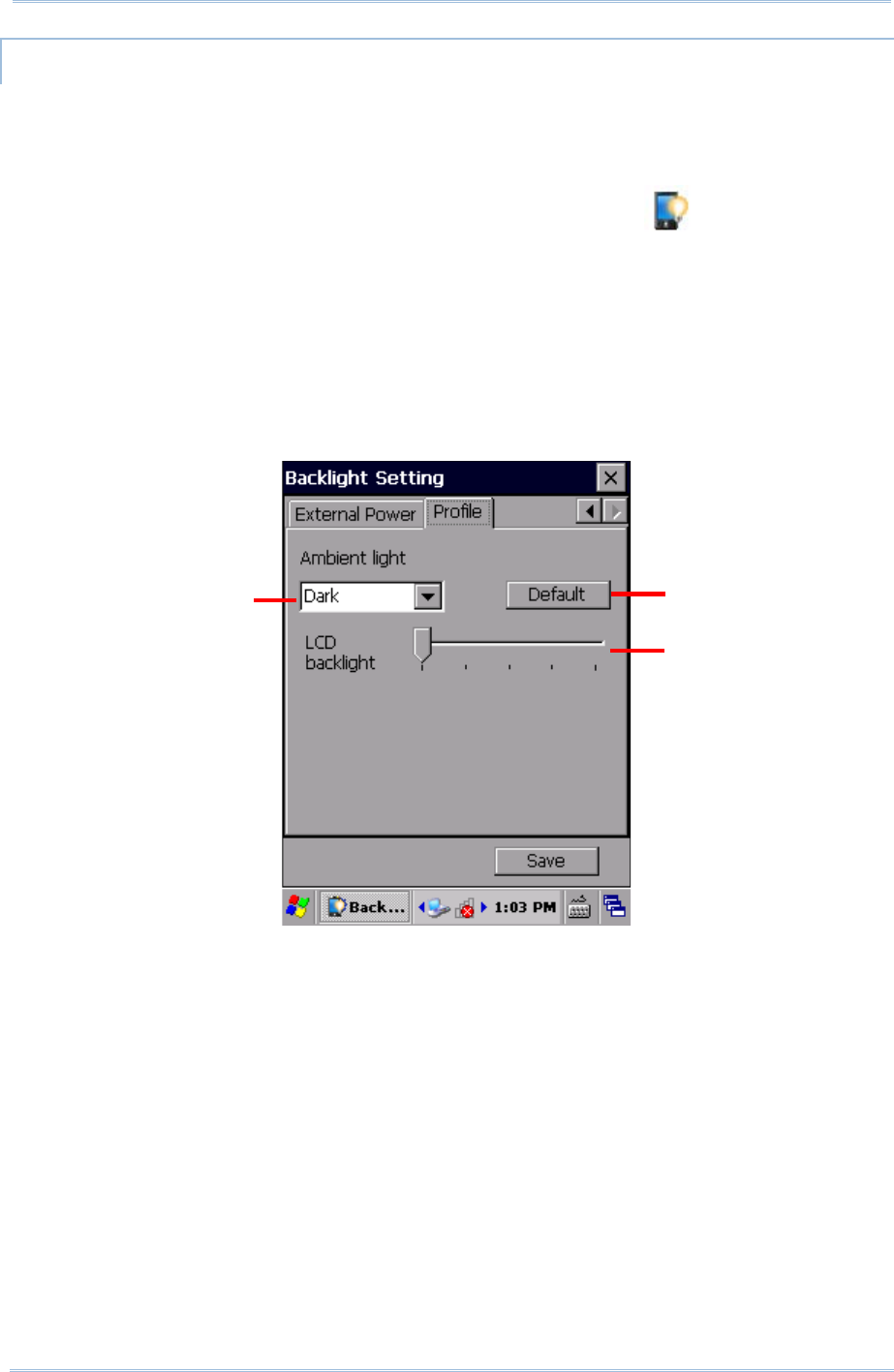
36
9700 Mobile Computer (CE) Reference Manual
AUTOMATIC BACKLIGHT PROFILES
The mobile computer stores three backlight profiles to represent backlight level under
different environments. These can be configured according to user’s likings.
To set backlight profiles:
1) Tap Start | Settings |Control Panel |Backlight Setting .
2) Uncheck Manual backlight setting to enable profile function.
3) Switch to the Profile tabbed page.
Three profiles, Dark,Bright, and Brightest are available in the drop-down box. Select
the profile you would like to modify and use the slider bar below to set the backlight
levels to your preferences. The screen backlight will change temporarily to show the
effect.
To restore profile settings to default, tap the Default button at the top right corner.
4) Tap Save in the lower right corner to apply the settings.
Tap the drop-down box
to select between
different profiles
Tap to restore the backlight
profile settings to default
Slide to set backlight
level as desired
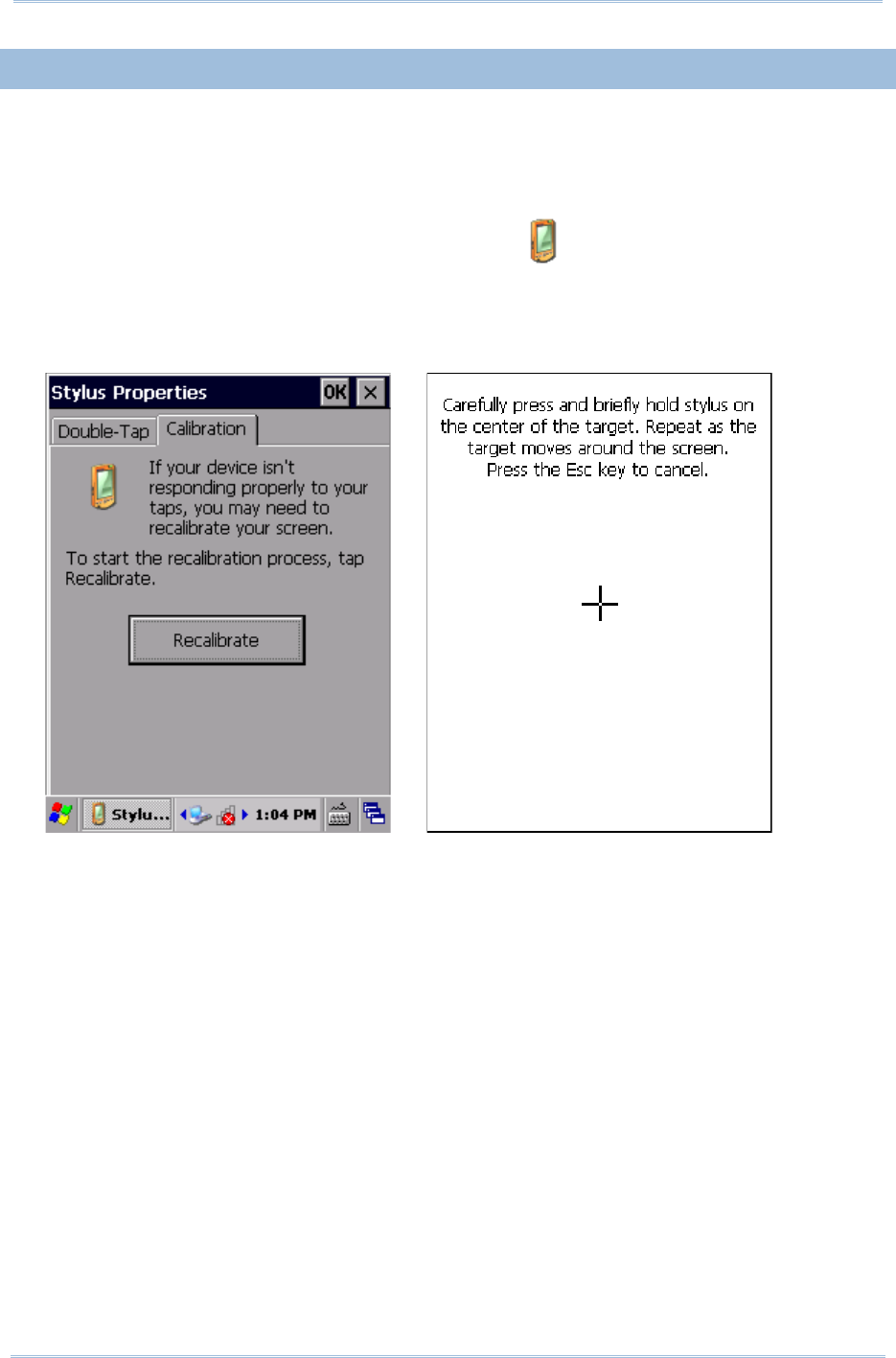
37
Chapte
r
1 Use Mobile Compute
r
1.6.4. CALIBRATION
A resistive touchscreen needs calibration to work accurately after serving for a period of
time. Calibration aligns the coordinates of the touch panel and the LCD underneath to
improve touch accuracy.
To calibrate the touchscreen:
1) Tap Start | Settings |Control Panel | Stylus .
2) Tap Calilbration tabbed page.
Calibration tabbed page opens. Tap Recalibrate button to open the calibration
screen.
3) Using the stylus, tap firmly at the center of the cross that appears on-screen. Five
crosses will appear in sequence.
Follow the on-screen instructions to save the new calibration settings or restore the old
settings. Once completed, the screen returns to Calibration tabbed page.
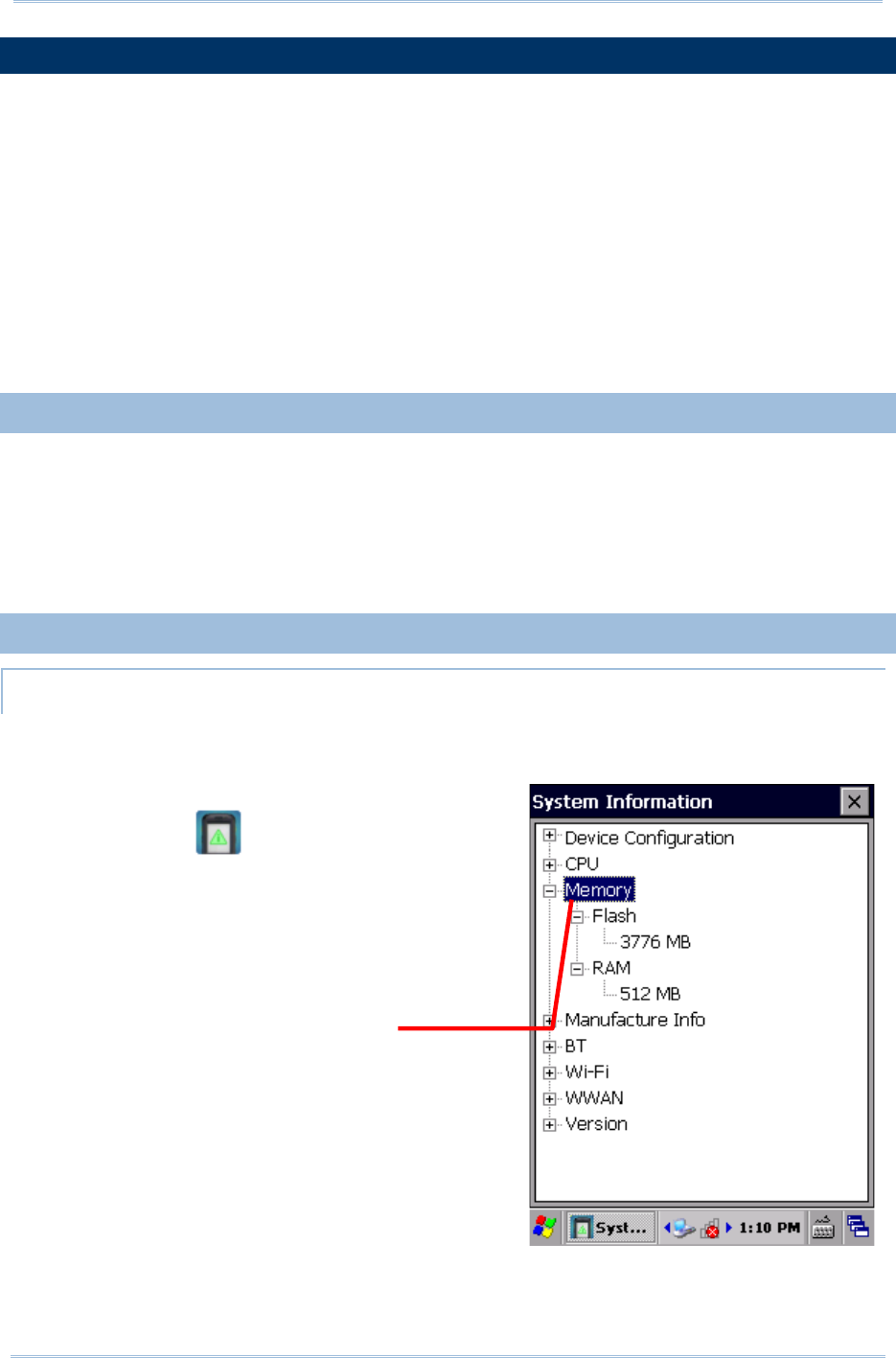
38
9700 Mobile Computer (CE) Reference Manual
1.7. MEMORY
The mobile computer packs the following memory units to retain data and instructions from
users:
Internal Storage: Random-access Memory (RAM) and Flash memory
512 MB SDRAM for temporary storage and fast access of active applications. When the
main battery pack is absent, SDRAM is fed by backup battery to retain data.
4GB flash memory to store OS (Windows Embedded Compact 7.0), application files,
settings, and other data used by applications.
External Storage
Insert a storage card to increase the mobile computer’s storage capacity. Supported are
MicroSDHC cards up to 32GB.
1.7.1. DATA LOSS CAUTION
When main battery is absent or used up, backup battery on the main board takes over to
supply power to the mobile computer. A fully charged backup battery retains SDRAM data
and suspends the mobile computer for 30 minutes.
Note if you are leaving the mobile computer to sit for a couple of days, data loss will occur
when both main and backup batteries drain out. Consider backing up data before putting
away the mobile computer.
1.7.2. CHECK STORAGE
INTERNAL STORAGE
To check internal storage size:
1) Tap Start | Settings | Control Panel |System
Information . The application opens
revealing information about the mobile
computer’s assemblage and hardware/firmware
components, including device manufacturer,
device ID, memory size, and firmware/software
version. RAM and Flash size are also listed
among this info.
Expand to view information
on memory size
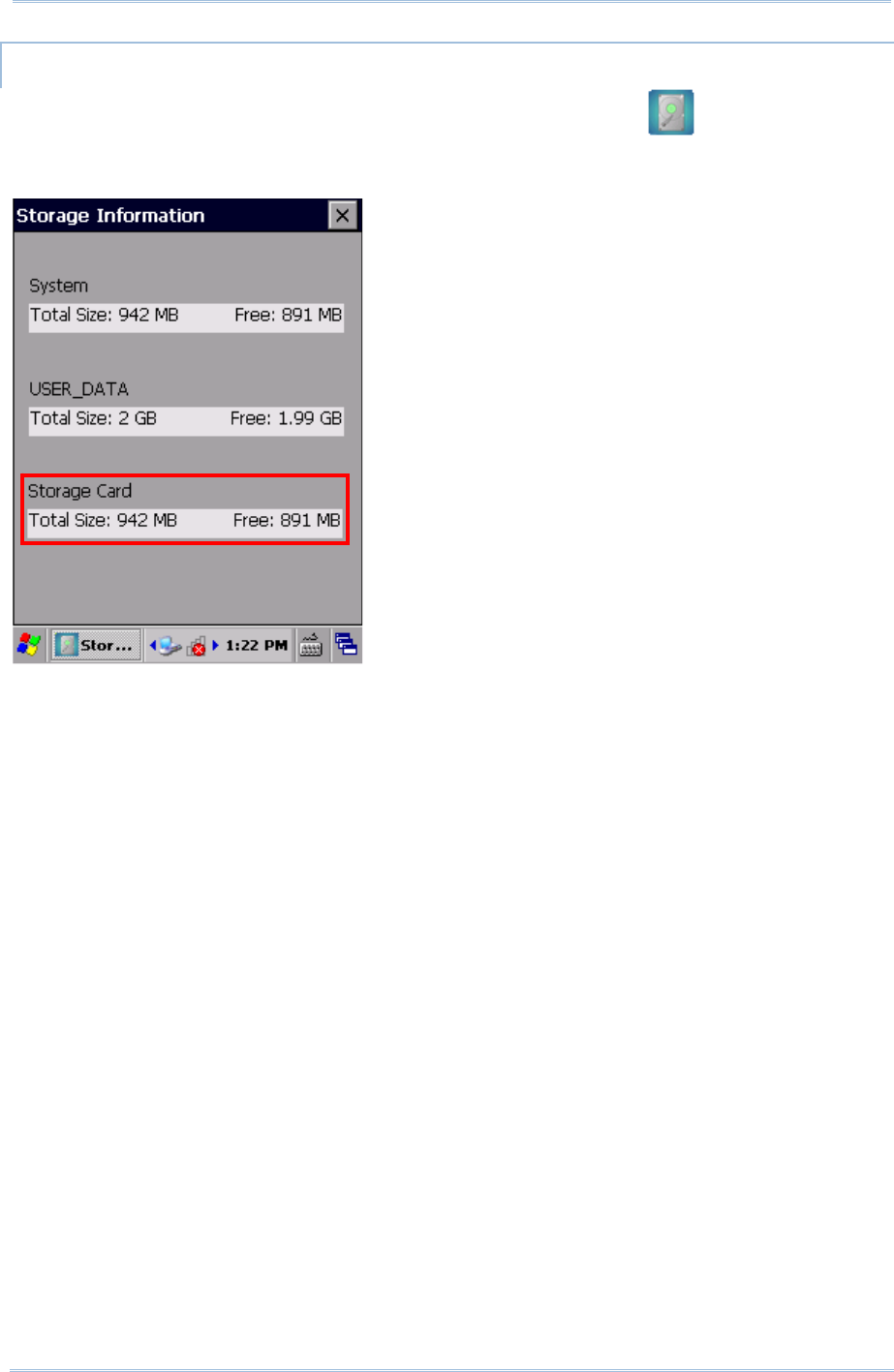
39
Chapte
r
1 Use Mobile Compute
r
EXTERNAL STORAGE
Tap Start | Settings | Control Panel | Storage Information . The Storage Card
label shows the available space on the storage card (if no storage card is installed on the
mobile computer, the available size will be displayed as 0).
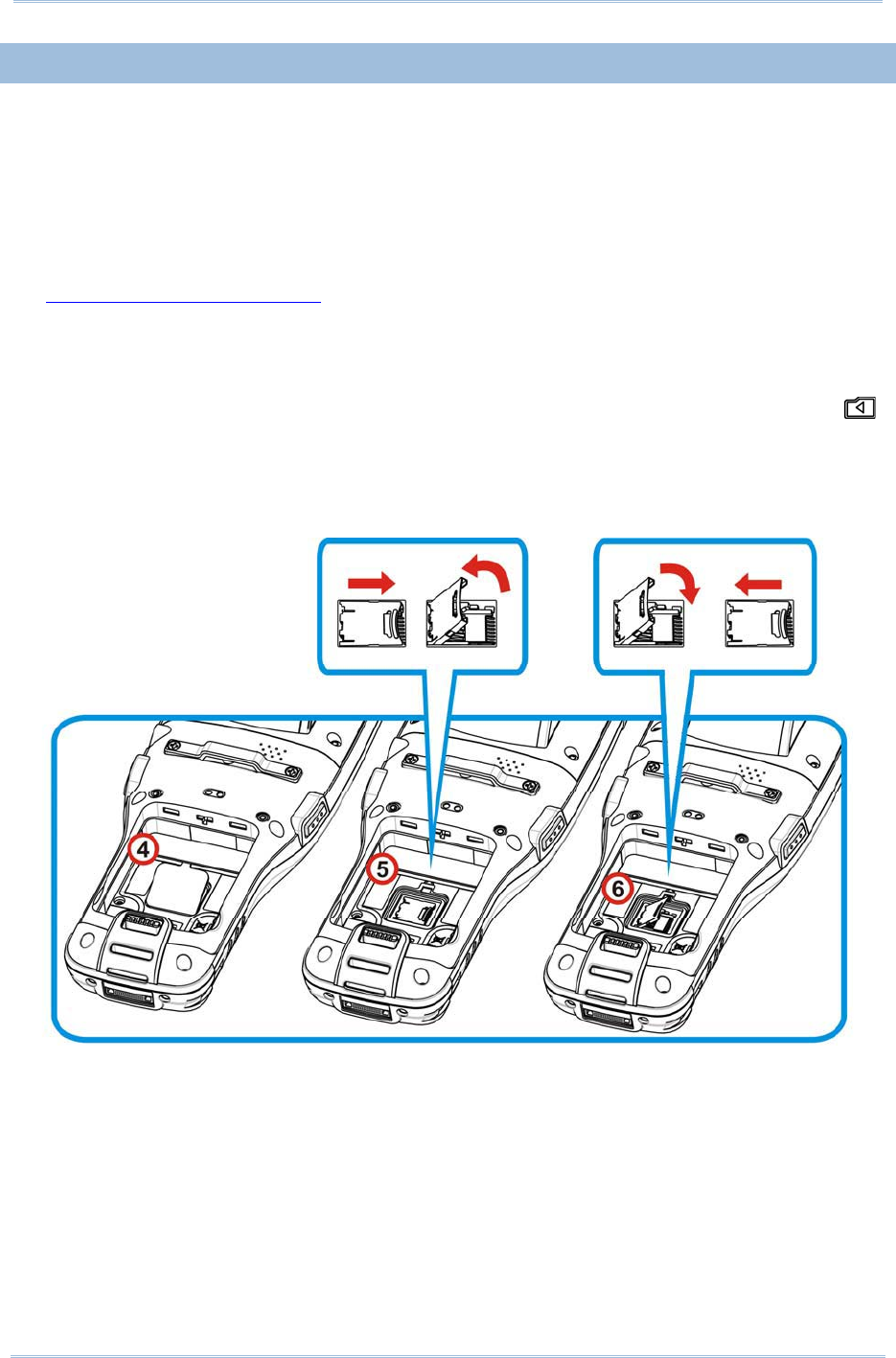
40
9700 Mobile Computer (CE) Reference Manual
1.7.3. INSERT SD CARD
Day-to-day use of the mobile computer might cause the available internal storage to run
short. Equip the mobile computer with an external memory unit to expand storage capacity.
Follow the steps below to install a SD card:
1) Power off the mobile computer.
2) Place the mobile computer face-down on a flat and soft surface.
3) Lift up the handstrap slightly to remove the main battery pack as described in
Install/Remove Main Battery.
4) The SD card socket located inside the battery chamber is concealed with a rubber cover.
Lift the rubber cover to reveal the card socket.
5) The SD card socket is equipped with a hinged cover. Push the hinged cover right and lift
the cover up to open the card socket. Insert your SD card in the indicated direction .
6) Close the hinged cover and push the cover left to have it locked.
7) Replace the main battery pack.
Figure 9: Inserting SD Card
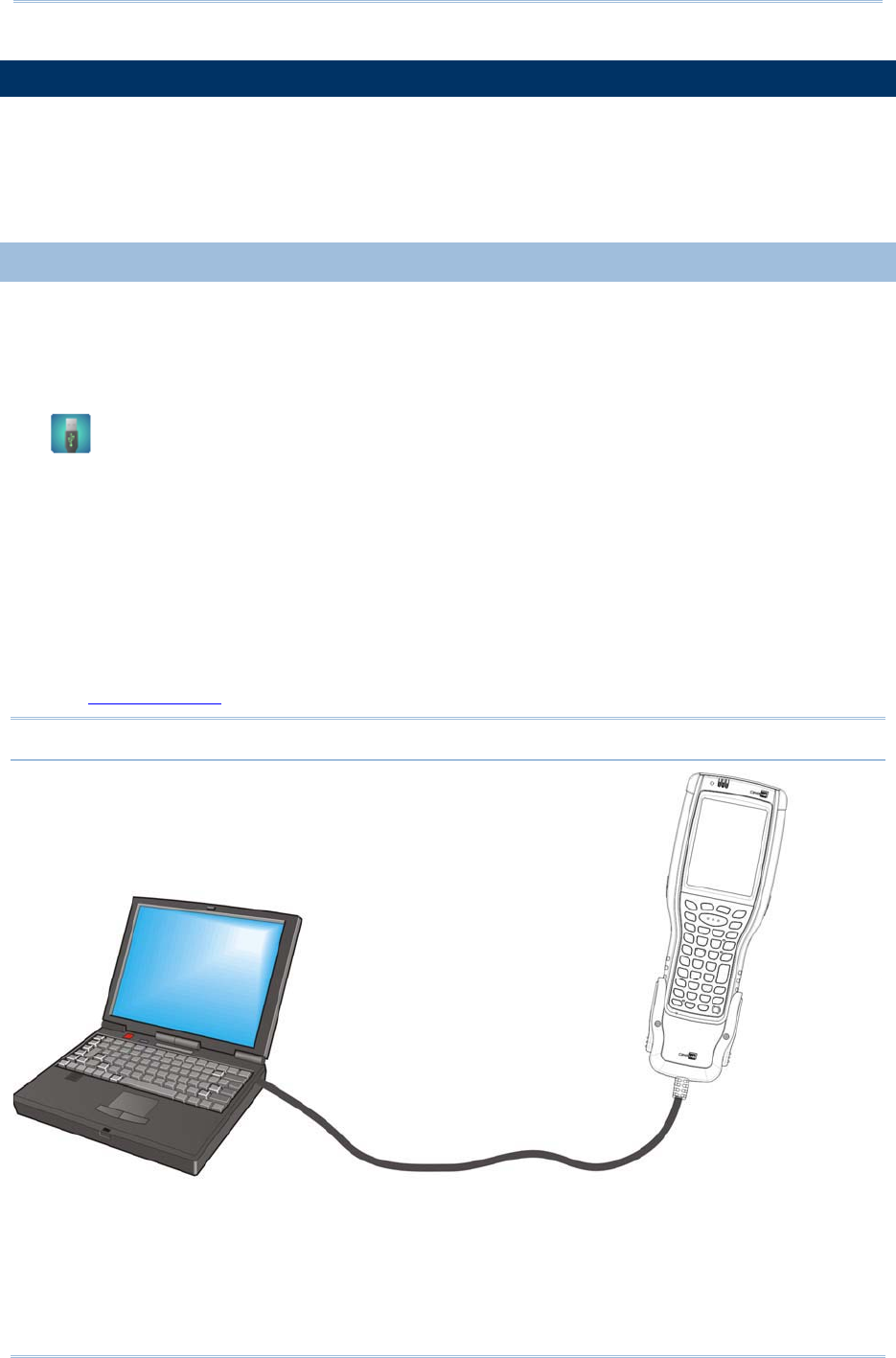
41
Chapte
r
1 Use Mobile Compute
r
1.8. DIRECT DATA COMMUNICATION
“Direct” data connection means “hardwired” data connection between the mobile computer
and a Windows-based PC as opposed to wireless connection. Direct data connection relies
on a RS-232 cable or a USB cable (sometimes plus an auxiliary cradle) between the two
mentioned devices. Once the mobile computer and PC are “directly” connected with each
other by a RS-232 or USB-cable, they can sync data with each other.
1.8.1. USE SNAP-ON CABLE
Direct data communication using a cable:
1) Connect the mobile computer to your PC with a Snap-on Charging and Communication
Cable (either USB or RS-232 type)ʳ.
2) On the mobile computer, tap Start | Settings | Control Panel | USB Connection
ʳ
.
3) To connect the mobile computer and PC via ActiveSync, select ActiveSync Serial
Mode.
To treat the mobile computer as an external storage device, select Mass Storage – SD
Card.
4) Tap OK on the title bar to apply the settings.
If one of the first two options are selected, ActiveSync will automatically detect
connection between the two and prompt for data synchronization.
See Syncing Tools and subsequent sections to know how to use ActiveSync.
Note: The 9700 mobile computer uses COM9 for serial transmission via RS-232.
Figure 10: Direct Data Communication Using Snap-on Cable
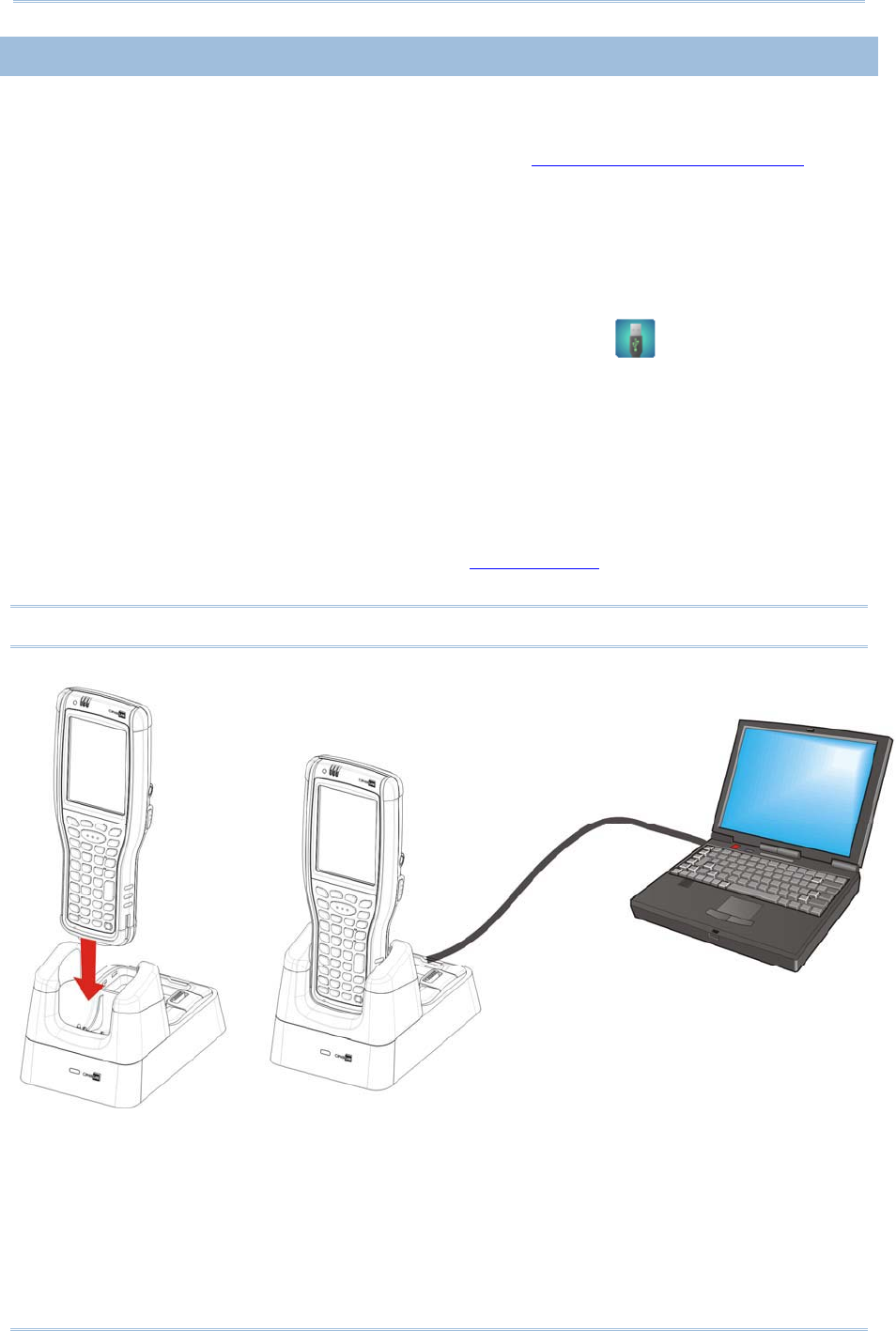
42
9700 Mobile Computer (CE) Reference Manual
1.8.2. USE CRADLE
Direct cradle charging makes use of a Charging & Communication Cradle (hereinafter
“cradle”). The cradle is one of the accessories you can opt for.
Prior to charging, install main battery as described in Install/Remove Main Battery. Then
follow the steps below:
1) Seat the mobile computer into the cradle. Connect one end of the USB cable to the
Cradle and the other end to the PC.
2) To charge the mobile computer, connect the cradle to an external power source using
the power adapter.
3) Tap Start |Settings |Control Panel |USB Connection .
4) To connect to the PC via ActiveSync, chose ActiveSync Serial Mode or ActiveSync
Serial Mode.
To treat the mobile computer as an external storage device, chose Mass Storage – SD
Card. Note that Mass Storage is only supported when as SD card is installed on the
mobile computer.
5) Tap OK on the title bar to apply the settings.
If ActiveSync Serial Mode is selected, see Syncing Tools and subsequent sections to
know how to use ActiveSync.
Note: The cradle supports USB Host Mode via a USB OTG cable.
Figure 11: Direct Data Communication Using Cradle
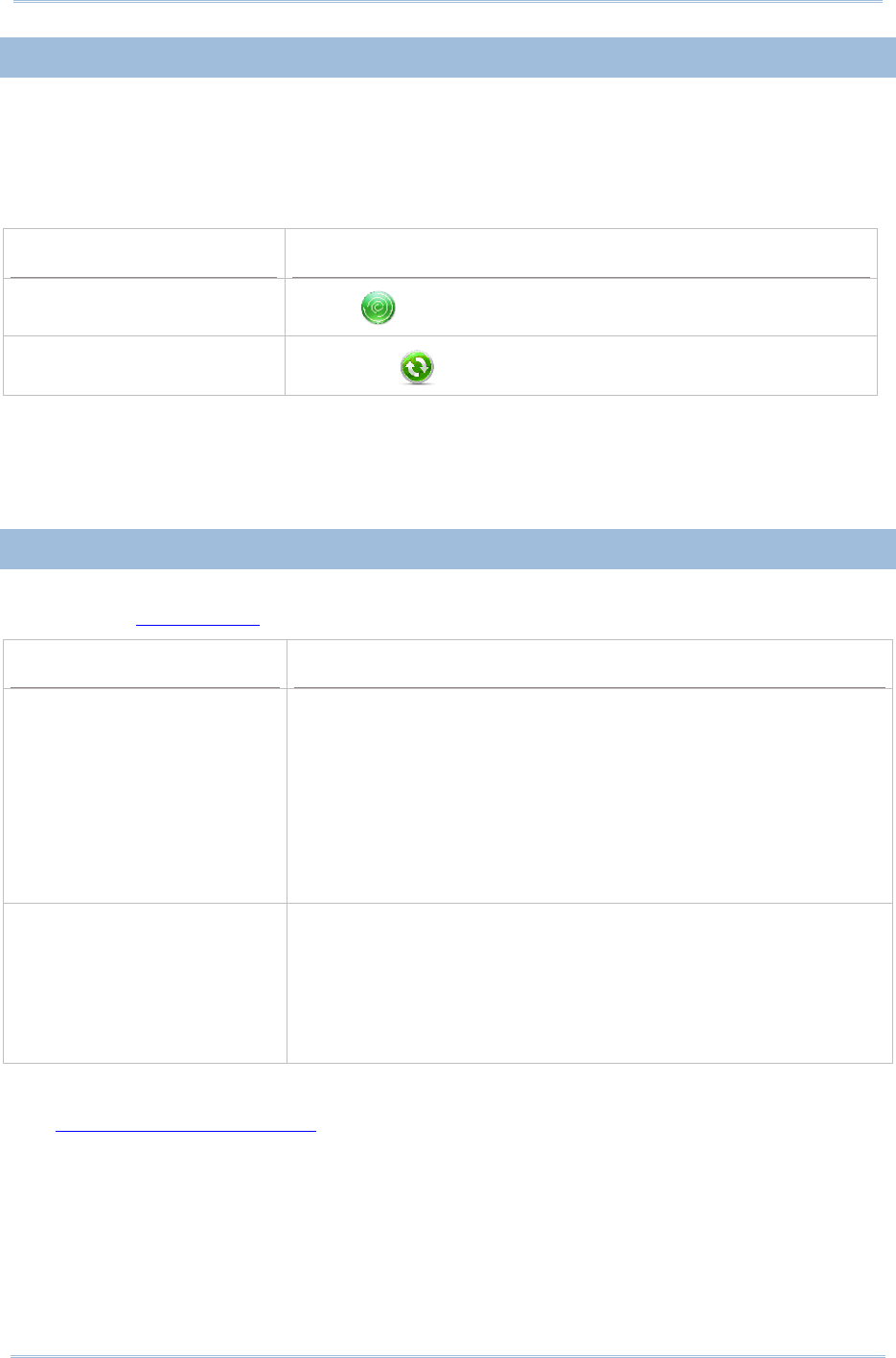
43
Chapte
r
1 Use Mobile Compute
r
1.8.3. SYNCING TOOLS
Microsoft’s syncing tools enables users to update or back up the data on their mobile
computers to desktop computers.
Two syncing tools are featured by Microsoft - ActiveSync and Windows Mobile Device Center
(“WMDC”). Which tool to use depends on which OS is running on your PC. See the rule
below:
OS Syncing Program
Windows Vista or Windows 7 WMDC
Windows XP SP3 and earlier ActiveSync
ActiveSync and WMDC can be downloaded from Microsoft’s website. Download and install
the right one on your PC.
Hereafter in this manual, we will focus on ActiveSync only. For WMDC usage, see its
documentation or help file.
1.8.4. SYNC PARTNERSHIP
Once a direct connection is established between the mobile computer and your PC as
described in Use Snap-on Cable, they are able to form the following ties:
Sync Partnership Services
Synchronization Relationship Allows the mobile computer and PC to sync data with each
other.
Allows PC to add and remove programs to/from the mobile
computer.
Allows PC to browse files on the mobile computer.
Allows PC to copy files to/from the mobile computer.
Allows PC to back up the files on the mobile computer.
Temporary Relationship
(Mobile computer works as a
“guest” to PC)
Allows PC to add and remove programs to/from the mobile
computer.
Allows PC to browse files on the mobile computer.
Allows PC to copy files to/from the mobile computer.
Allows PC to back up the files on the mobile computer.
Note that data stored on external storage (the SD card) cannot be synchronized.
See ActiveSync Actions to Take for details about the mentioned services.
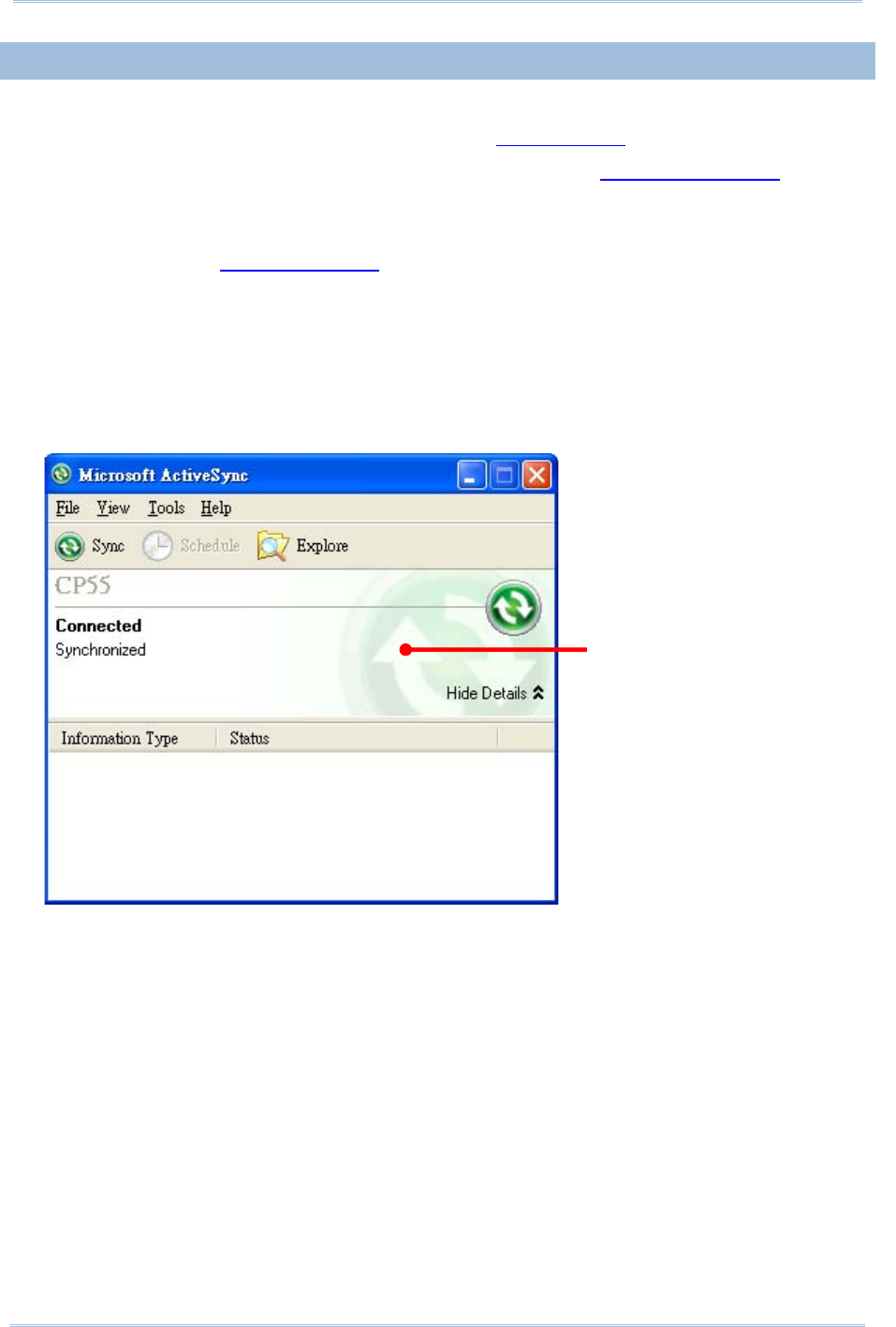
44
9700 Mobile Computer (CE) Reference Manual
1.8.5. 1ST USB SYNC
This section will guide you through USB syncing. To connect ActiveSync using USB:
1) Download the right syncing tool as described in Syncing Tools and install it on your PC.
2) Connect the mobile computer and your PC as described in Use Snap-on Cable.
3) On your PC, run the syncing program.
ActiveSync should detect the mobile computer. Sync Setup Wizard launches and
prompts to set up Sync Partnership between two computers.
4) Press Next for “Synchronization Relationship”, or press Cancel for “Temporary
Relationship” if you don't plan to connect to the PC on a regular basis.
If you have pressed Next, follow the on-screen instructions and select the data
categories you would like to synchronize. Once confirmed, synchronization will begin
shortly, and when the process is finished, ActiveSync window will show “Synchronized”
to indicate that the data on the mobile computer and PC are identical.
OR
If you have pressed Cancel, Microsoft ActiveSync opens showing “Guest” and
“Connected”. The mobile computer and the PC are connected but the data is not
synchronized.
A “Synchronization Relationship”
is established between the mobile
computer and the PC
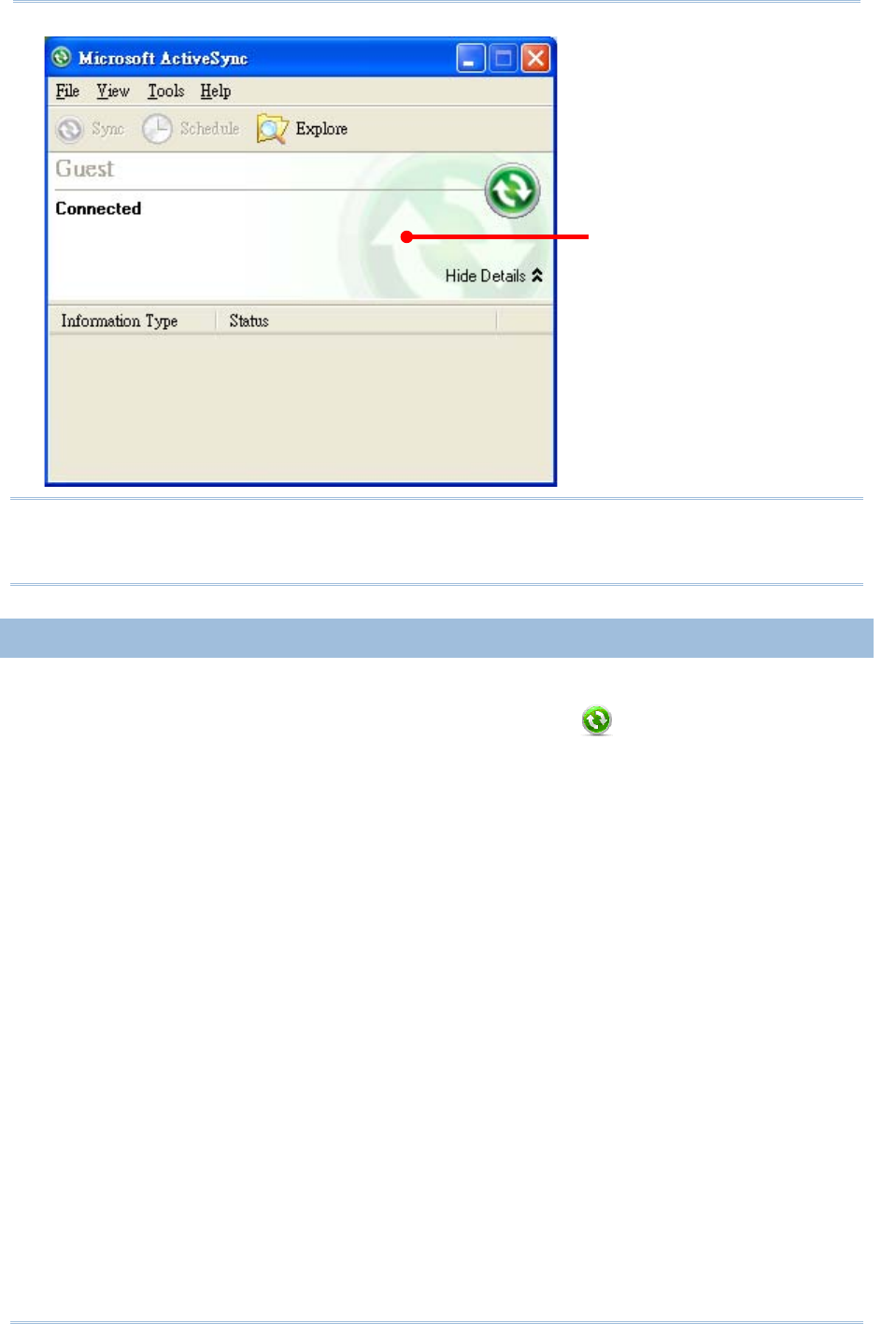
45
Chapte
r
1 Use Mobile Compute
r
Note: If you encounter trouble during USB ActiveSync connection, tap Start |Settings |
Control Panel |USB Connection and make sure “ActiveSync Serial Mode” is
selected.
1.8.6. DISCONNECT USB ACTIVESYNC
To disconnect USB ActiveSync:
1) On your PC, open ActiveSync by double-clicking its icon in the notification area.
ActiveSync opens.
2) From the menu bar, click File | Connection Settings.
[Connection Settings] window opens.
3) Deselect Allow USB connections.
4) Press the OK button to apply the change and quit setting.
This way when you plug your mobile computer the next time, ActiveSync won’t attempt
to connect to it.
A “Temporary Relationship” is
established between the mobile
computer and the PC
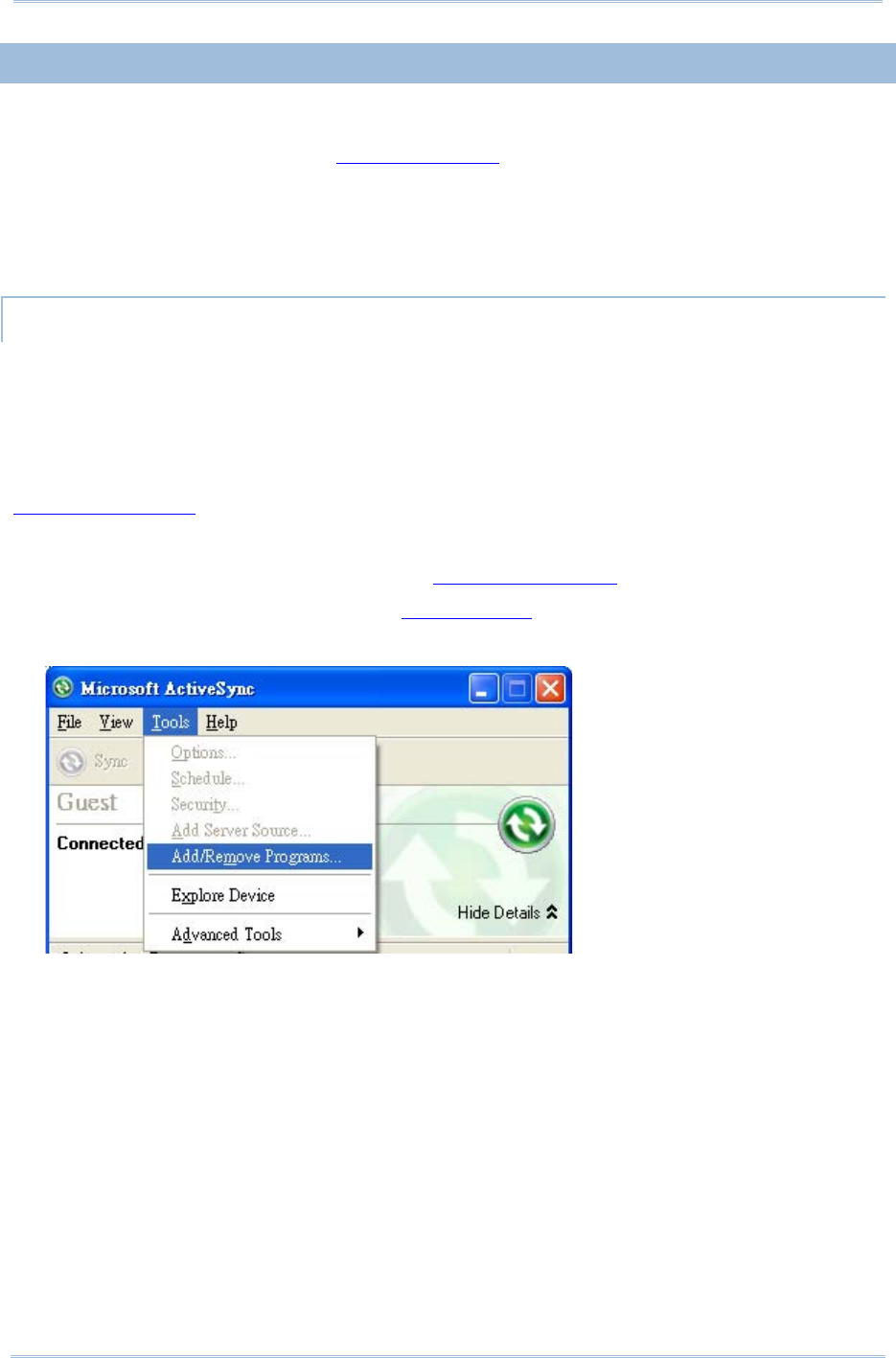
46
9700 Mobile Computer (CE) Reference Manual
1.8.7. ACTIVESYNC ACTIONS TO TAKE
Once “Synchronization Relationship” or “Temporary Relationship” is established between
two computers, a variety of actions can be taken to enhance resource sharing between
them as previously mentioned in Sync Partnership.
In summary, “Synchronization Relationship” outshines “Temporary Relationship” by being
capable of syncing Microsoft Office Outlook data. However “Temporary Relationship”
provides satisfactory file sharing if you don’t want to synchronize information.
See the following to know what actions to take with ActiveSync:
ADD/REMOVE PROGRAMS
Note basically the applications to be installed to the mobile computer need to be installed on
your PC first. So download the application programs to your PC first and install them on your
PC so they can be installed onto the mobile computer later.
Many application programs are installed in different ways. Read their installation guides or
documentation to know how they are installed. If you are installing an application that
cannot be installed on your PC first, try to install it right from the mobile computer. See
Install Applications for more details.
To install an application on the mobile computer:
1) Connect two computers as described in Use Snap-on Cable.
2) Sync two computers as described in 1st USB Sync.
3) On the PC, from the menu bar of ActiveSync, select Tools | Add/Remove Programs.
ActiveSync starts to search for the application programs installed on your PC and opens
its [Add/Remove Programs] dialog which lists those found. Each entry comes with a
check box on the left. An unchecked box means the program is yet to install to the
mobile computer while a checked one means an installed program.
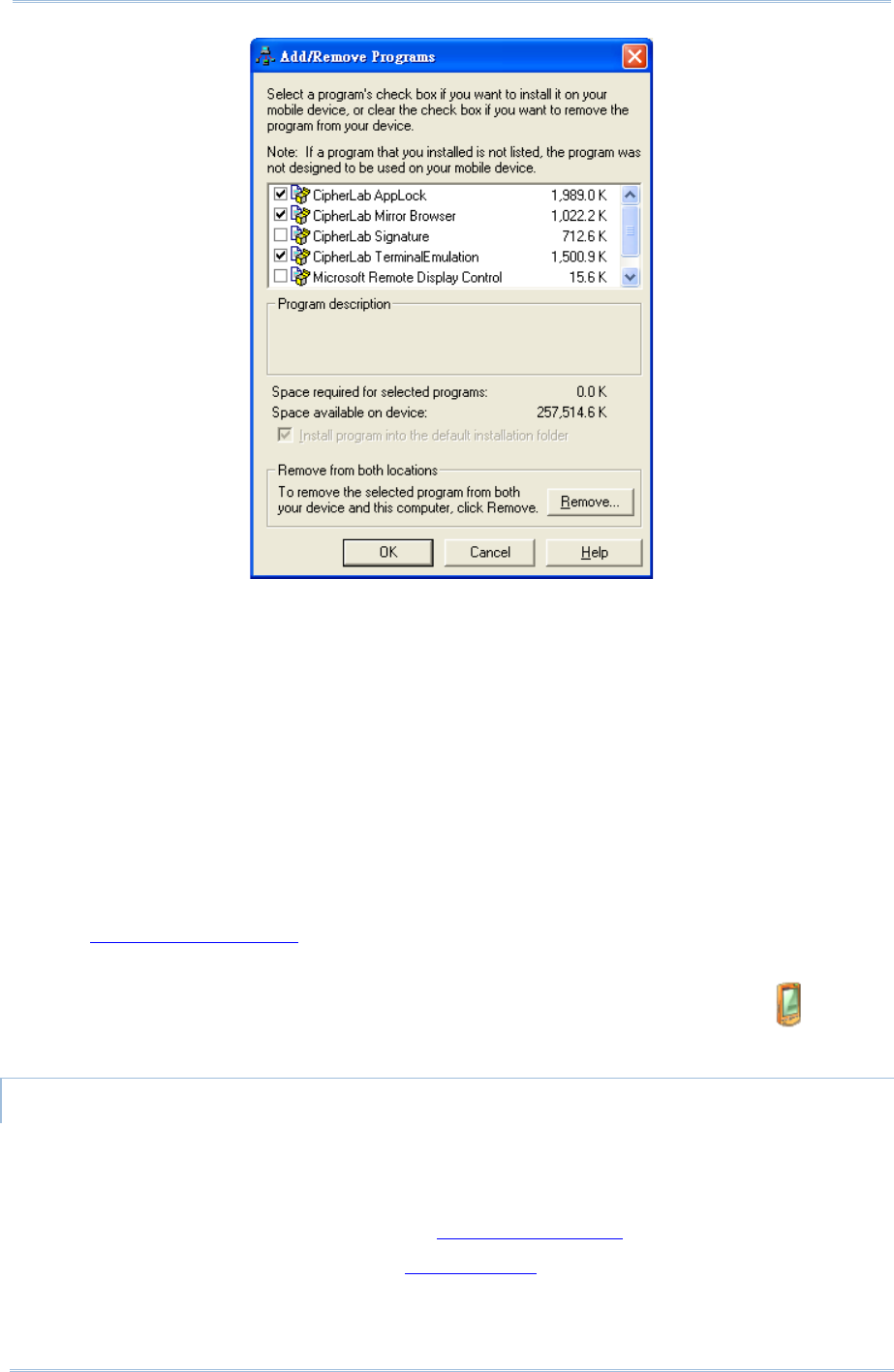
47
Chapte
r
1 Use Mobile Compute
r
4) Select the application program(s) to install to the mobile computer, and deselect the
application program(s) to uninstall from the mobile computer.
5) Press the OK button.
ActiveSync proceeds to install programs and/or remove programs to/from the mobile
computer.
6) Follow the on-screen instructions on both your PC and the mobile computer to proceed.
Noteworthy facts:
Normally the application program(s) downloaded from external resources are installed
to the mobile computer’s directory at My Device\Program Files. However sometimes
there are exceptions and the actual situation depends on the application.
You can also uninstall applications directly on the mobile computer rather than on the PC.
See Uninstall Applications for more details.
If you would like to uninstall a program that isn’t listed in the [Add/Remove Programs]
dialog, browse to it on the mobile computer by tapping My Device on the
desktop. Tap and hold it, and select Delete from the context menu that pops up.
ADD APPLICATION SHORTCUTS TO START MENU
ActiveSync features “Explore” to add an application shortcut to Start menu where it is easier
to launch the application.
To add an application shortcut to Start menu:
1) Connect two computers as described in Use Snap-on Cable.
2) Sync two computers as described in 1st USB Sync.
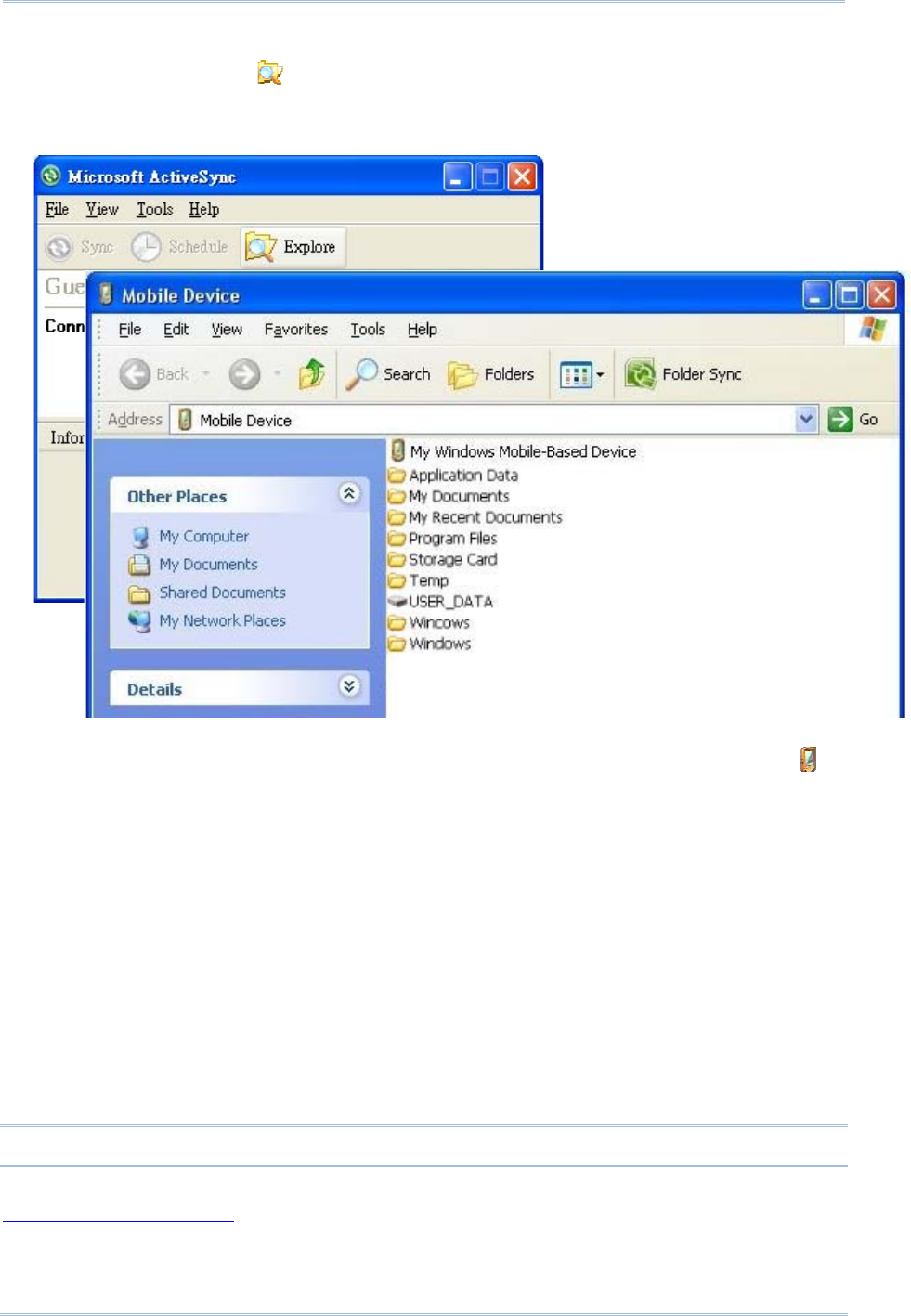
48
9700 Mobile Computer (CE) Reference Manual
3) On the PC, from ActiveSync’s menu bar, select Tools | Explore Device, or from its
toolbar, press Explore button.
The mobile computer’s internal storage root directory “Mobile Device” opens
presenting a few folders (and files).
4) Add File Shortcuts to Desktop Double-click My Windows Mobile-Based Device .
5) Double-click Program Files.
Program Files folder opens. This is where the downloaded applications are normally
installed on the mobile computer’s local storage.
In the folder, each sub-folder stores an application.
6) Open the folder of the application to create shortcut for.
7) Find the executable file of that application. Right-click on it and select Copy from the
context menu that comes up.
8) Browse to My Device\Windows\Programs.
9) Right-click any vacant spot in the folder and select Paste shortcut from the context
menu that comes up.
A shortcut to the application is added to the mobile computer’s Start menu.
Note: You can also copy & paste by the sequence Create Shortcut -> Cut -> Paste.
You can also add an application shortcut to Start menu directly on the mobile computer. See
Add Items to Start Menu for more details.
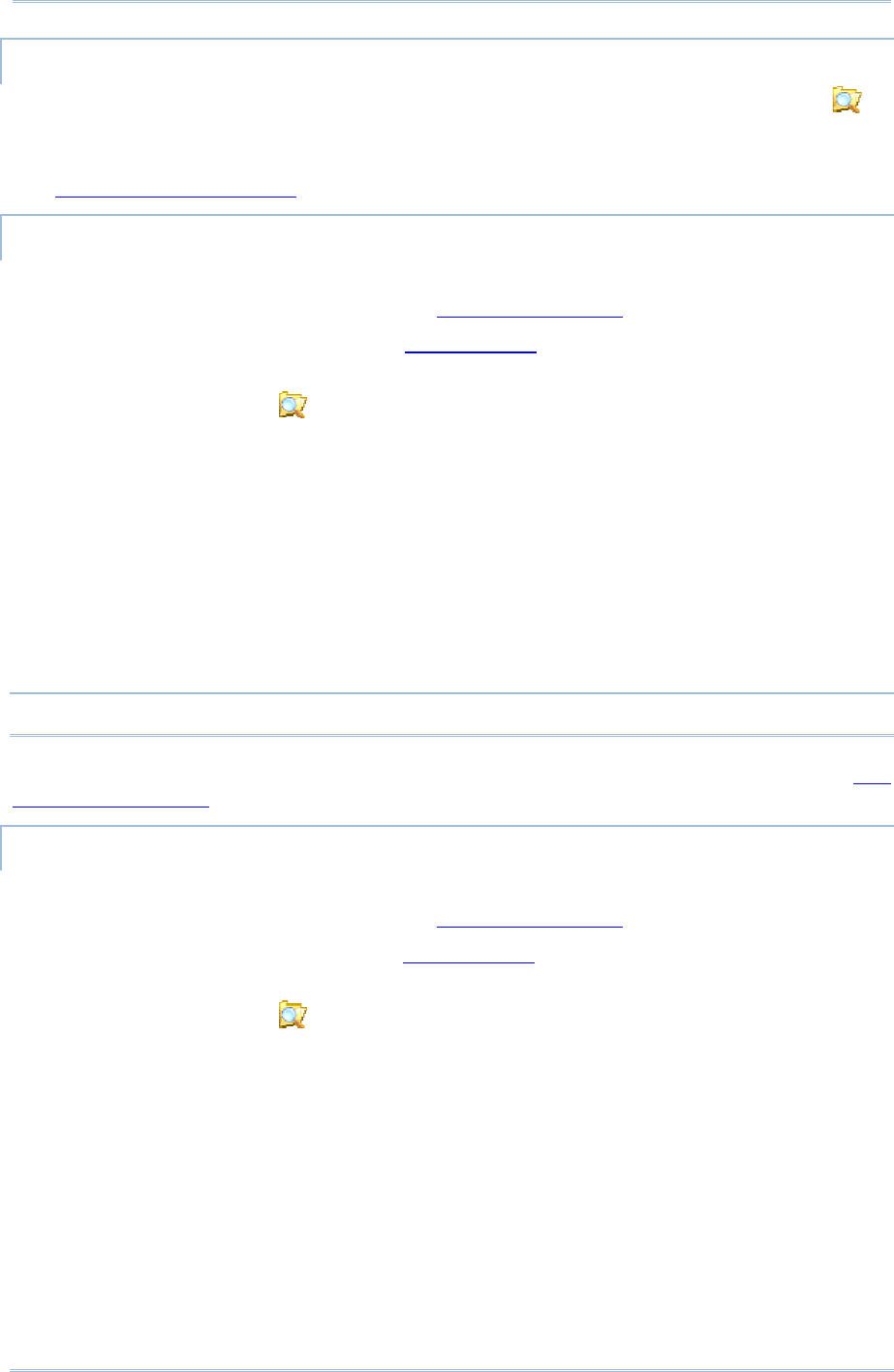
49
Chapte
r
1 Use Mobile Compute
r
REMOVE ITEMS FROM START MENU
To remove an added shortcut from Start menu, simply use ActiveSync’s Explore to
delete the shortcut from My Device\Windows\Programs folder.
You can also remove an added shortcut from Start menu directly on the mobile computer.
See Add Items to Start Menu for more details.
ADD ITEM SHORTCUTS TO DESKTOP
To add a shortcut of an application or file to the mobile computer’s desktop:
1) Connect two computers as described in Use Snap-on Cable.
2) Sync two computers as described in 1st USB Sync
3) On the PC, from ActiveSync menu bar, select Tools | Explore Pocket PC, or from its
toolbar, press Explore button.
The mobile computer’s internal storage root directory “My Device” opens presenting a
few folders.
4) Browse to the file to create shortcut for.
5) Right-click on the file and select Copy from the context menu that comes up.
6) Browse to My Device\Windows\Desktop.
7) Right-click any vacant spot in the folder and select Paste shortcut from the pop-up
menu that comes up.
A shortcut to the file is added to the mobile computer’s desktop.
Note: You can also copy & paste by the sequence Create Shortcut -> Cut -> Paste.
You can also add a file shortcut to the desktop directly on the mobile computer. See Add
Items to Start Menu or more details.
CREATE NEW FOLDERS
To create a new folder on the mobile computer:
1) Connect two computers as described in Use Snap-on Cable.
2) Sync two computers as described inʳ1st USB Sync.
On the PC, from ActiveSync menu bar, select Tools | Explore Pocket PC, or from its
toolbar, press Explore button.
The mobile computer’s internal storage root directory “My Device” opens presenting a
few folders (and some files).
3) Browse where you want to create a folder.
4) Right-click any vacant spot there.
Context menu opens
5) Select New Folder.
A new folder is created.
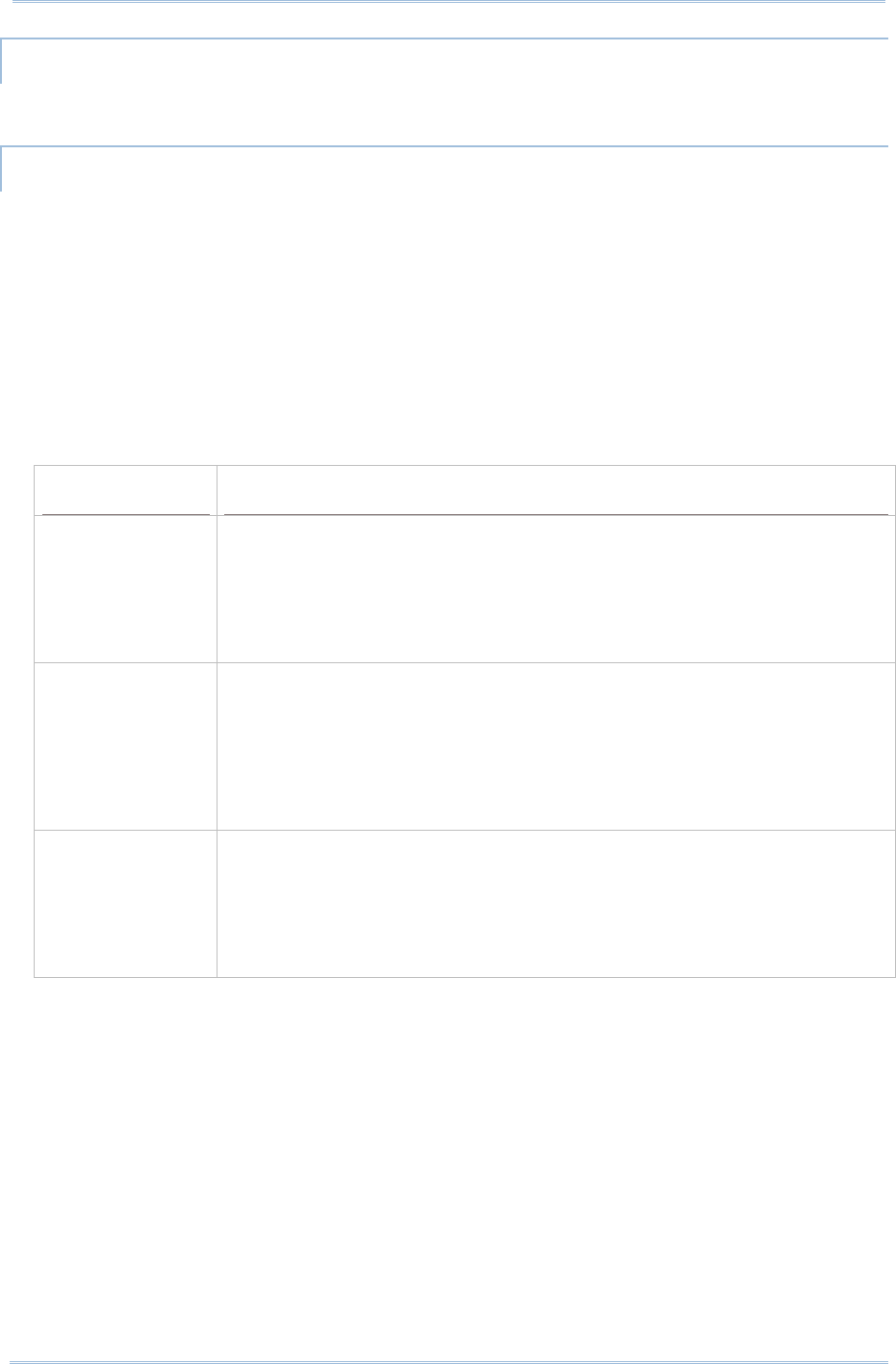
50
9700 Mobile Computer (CE) Reference Manual
BACKUP DATA
To best protect your work, back up the data on your mobile computer regularly. You may
choose to manually back up using ActiveSync to copy & paste the files to your PC.
USB PASS-THROUGH NETWORKING
ActiveSync supports “Pass-Through Networking” whereby the mobile computer networks
using your PC’s data connection.
For security, disable network bridging on the PC, especially the bridging to a Remote NDIS
adapter. For more information on network bridging, see Windows Help on the PC.
After sync partnership is set up between the mobile computer and your PC:
1) On your PC, from the menu bar of ActiveSync, select File | Connection Settings.
[Connection Settings] window opens.
2) For This computer is connected to, select a network which your PC should connect to
when passing through ActiveSync. Options are:
Option Description
Automatic Auto-detects proxy
This option detects if a proxy should be used when passing connections
through the PC. If yes, configure the proxy on the mobile computer.
This option best suits connecting to a PC (laptop) that may be used at
home (with no proxy), as well as to a corporate network (with proxy).
Work Network Always uses proxy
This option assumes a proxy should be used when passing connections
through the PC, and uses whatever proxy is already configured on the
mobile computer.
This option best suits connecting to a PC that is always on corporate
network.
The Internet Never uses proxy
This option assumes no proxy is necessary when passing connections
through the PC.
This option best suits connecting to a PC connected directly to the
Internet through ISP (at home)
3) Select Open ActiveSync when my device connects.
4) Press OK button to apply the change and quit settings.
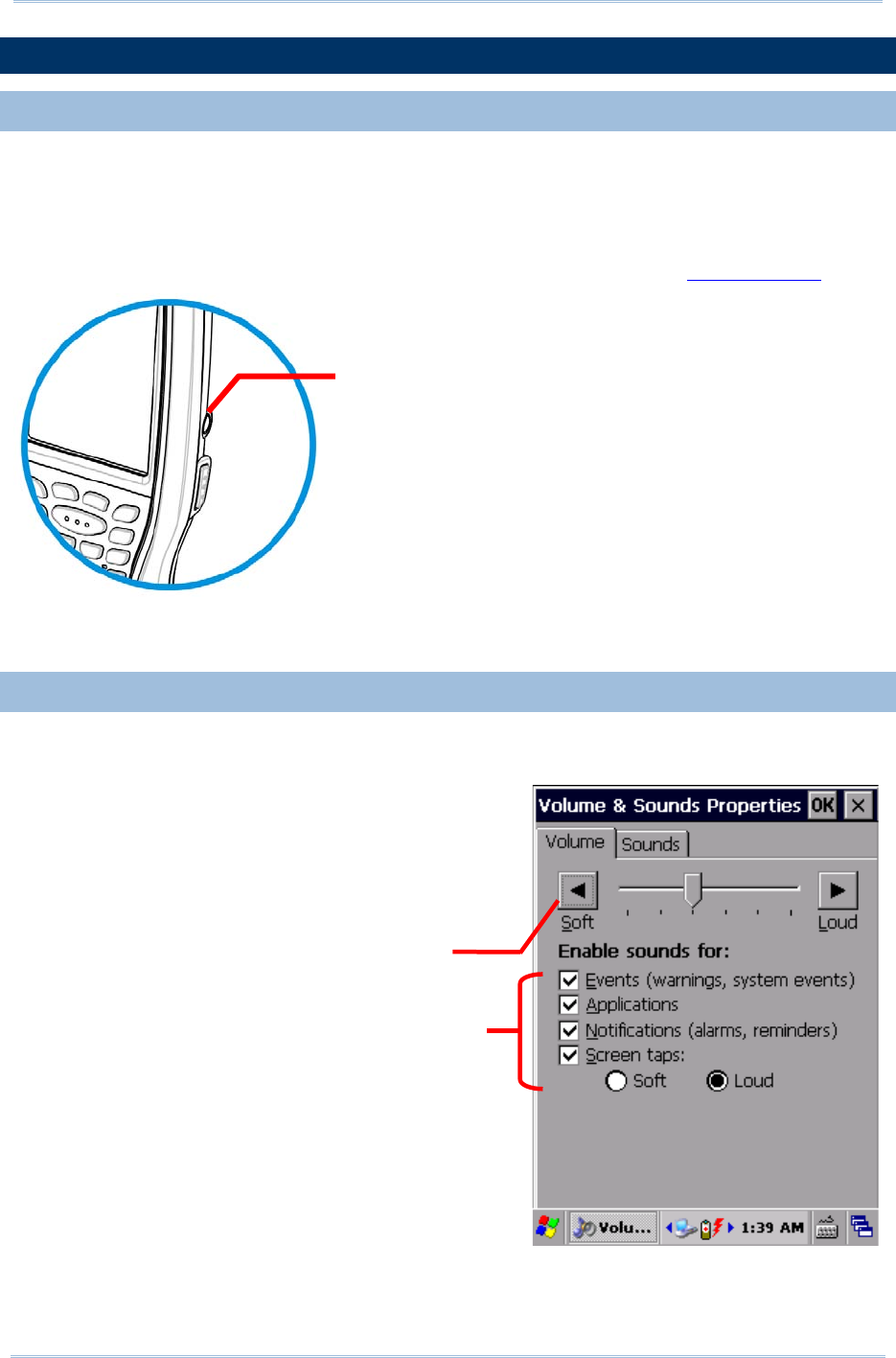
51
Chapte
r
1 Use Mobile Compute
r
1.9. VOLUME AND AUDIO
1.9.1. AUDIO PLAYBACK
Use a headset for audio playback and hands-free telephone communication.
The headset jack (3.5 mm DIA) is built up on one side of the mobile computer and sealed
with a hinged rubber. Open the rubber to reveal the headset jack. Plug the connector of
your headset to the jack.
Bluetooth headsets are also supported to deliver better mobility. See Use Bluetooth.
Figure 12:Audio Playback
1.9.2. VOLUME CONTROL
The mobile computer features an on-screen volume gauge to control the system volume,
including event sounds, notifications and media playback.
1) Tap Start | Settings | Control Panel | Volume
& Sounds.
Volume & Sounds Properties window opens
showing a slider to adjust system volume and a
few checkboxes to select the occasions to play
system sounds for.
2) Adjust the settings to meet your needs.
When finished, tap OK on the title bar to apply
the settings.
Slider bar and buttons to
adjust system volume
Checkboxes to select when
to play system sounds
Headset jack

52
9700 Mobile Computer (CE) Reference Manual

53
The mobile computer is powered by Windows Embedded Compact 7.0, a member of
Windows Embedded family. Windows Embedded Compact 7.0 bears much similarity to
desktop OS, and users rely only on a few basic gestures such as tap, double-tap and drag
to navigate within the OSˁʳ
ʳ
ʳ
ʳ
ʳ
Chapter 2
OPERATING SYSTEM
2. IN THIS CHAPTER
2.1 Desktop ................................................................... 54
2.2 Managing Programs ................................................... 61
2.3 Suspend & Reset Mobile Computer............................... 66
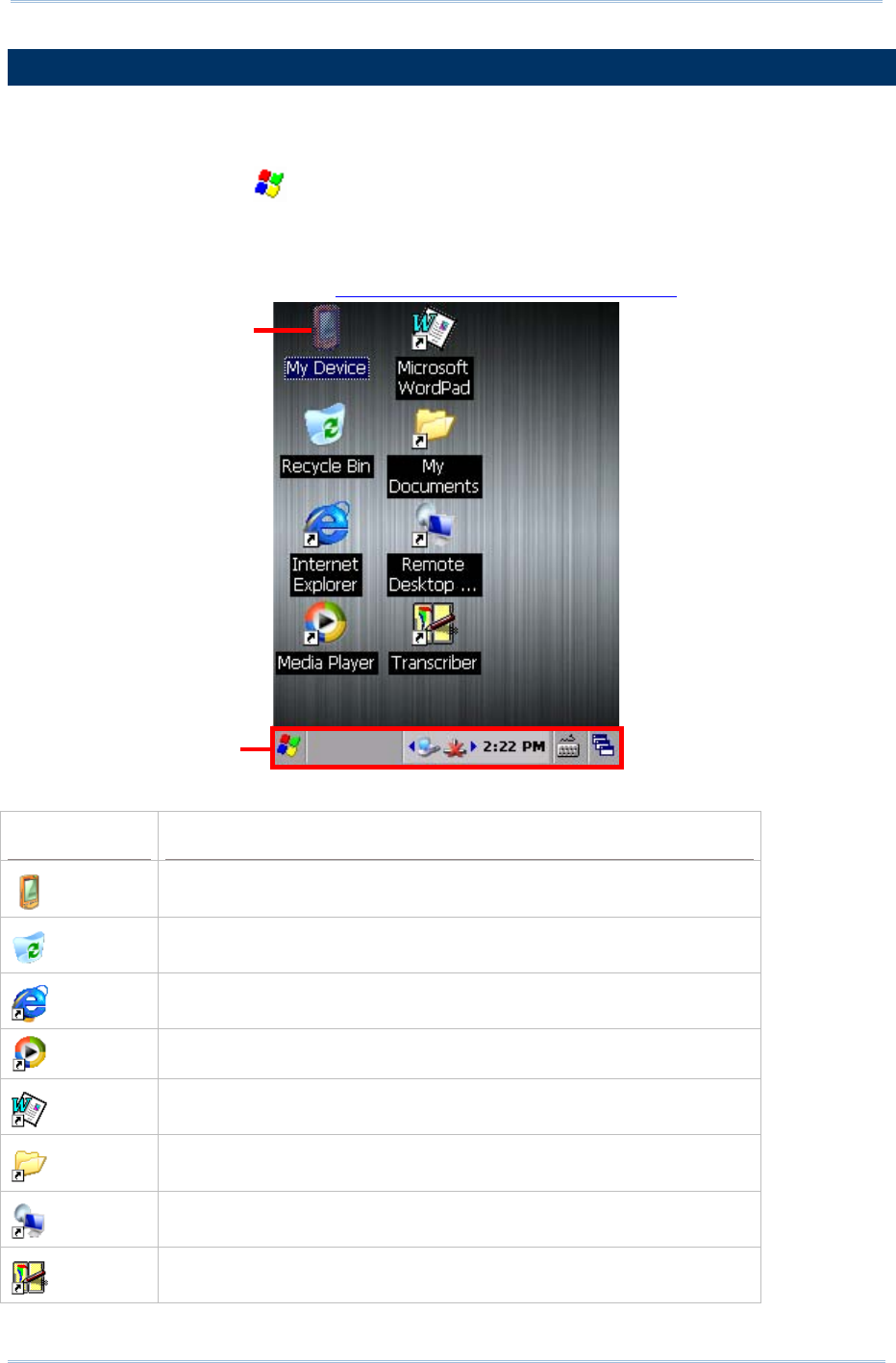
54
Chapte
r
2 Operating System
2.1. DESKTOP
Desktop is where all features on the mobile computer are accessed from.
Basic operations on the desktop:
Tap the Start button to open the Start menu.
Double-tap an application icon on the desktop to open it.
Tap a blank spot on the desktop to open an option menu for customizing the wallpaper
and the items to display. See Customize Desktop and Start Menu for more details.
Items on the desktop include:
Icon Description
File explorer for the mobile computer’s internal storage.
Recycle bin.
Shortcut for Internet Explorer.
Shortcut for Windows Media Player.
Shortcut for Microsoft WordPad.
Shortcut which opens \My Device\My Documents directory.
Shortcut for Remote Desktop Connection.
Shortcut which enables Transcriber as the active input mode.
Taskbar
Application icon
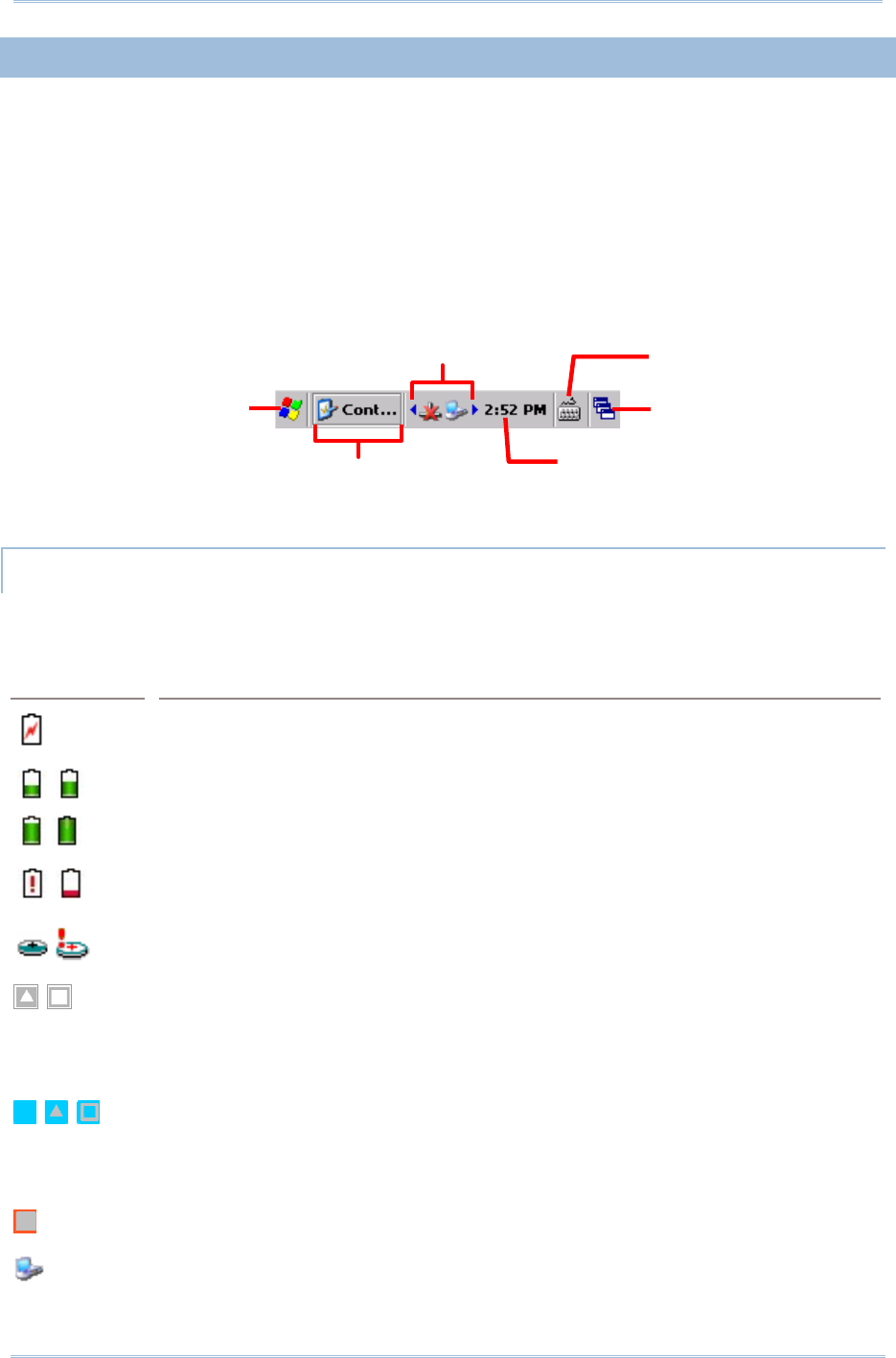
55
Chapte
r
2 Operating System
2.1.1. TASKBAR
At the bottom of the screen is the taskbar, which is divided into the following sections:
Start button: opens Start menu
Task button section that shows a button of the current application open on-screen
Notification area which displays icons for connection status of the mobile computer, as
well as system time
A keyboard icon for switching input mode
A task icon to switch between active applications or re-open the desktop
STATUS ICONS
The OS presents the following icons for users. Note there may be application-specific icons
not included here.
Options Description
External power source connected and charging.
Battery icons indicate the amount of power remaining in the main battery. The
higher the green level, the more power in the main battery.
When the battery icon changes to red, main battery level is low and needs charging
immediately.
Backup battery level is low; check if main battery level is full, or connect the mobile
computer to external power to avoid battery depletion and data loss.
ʳShift mode: 30-key/38-key keypad enters numbers and symbols, and 53-key
keypad enters uppercase letters and symbols.
Enters numbers and symbols.
Press Alpha key to convert to alphabetic input.
Alpha mode: 30-key/38-key keypad enters numbers and symbols, and 53-key
keypad enters uppercase letters and symbols.
Press Shift key to switch between uppercase and lowercase letters.
Press Alpha key to convert to numeric/symbolic input.
Keypad Function mode is on.
PC connection icon that appears when ActiveSync connection is established.
Switches input mode
Opens Start
menu Switches task
Displays icons for
connection status
Shows system time
Task button
section
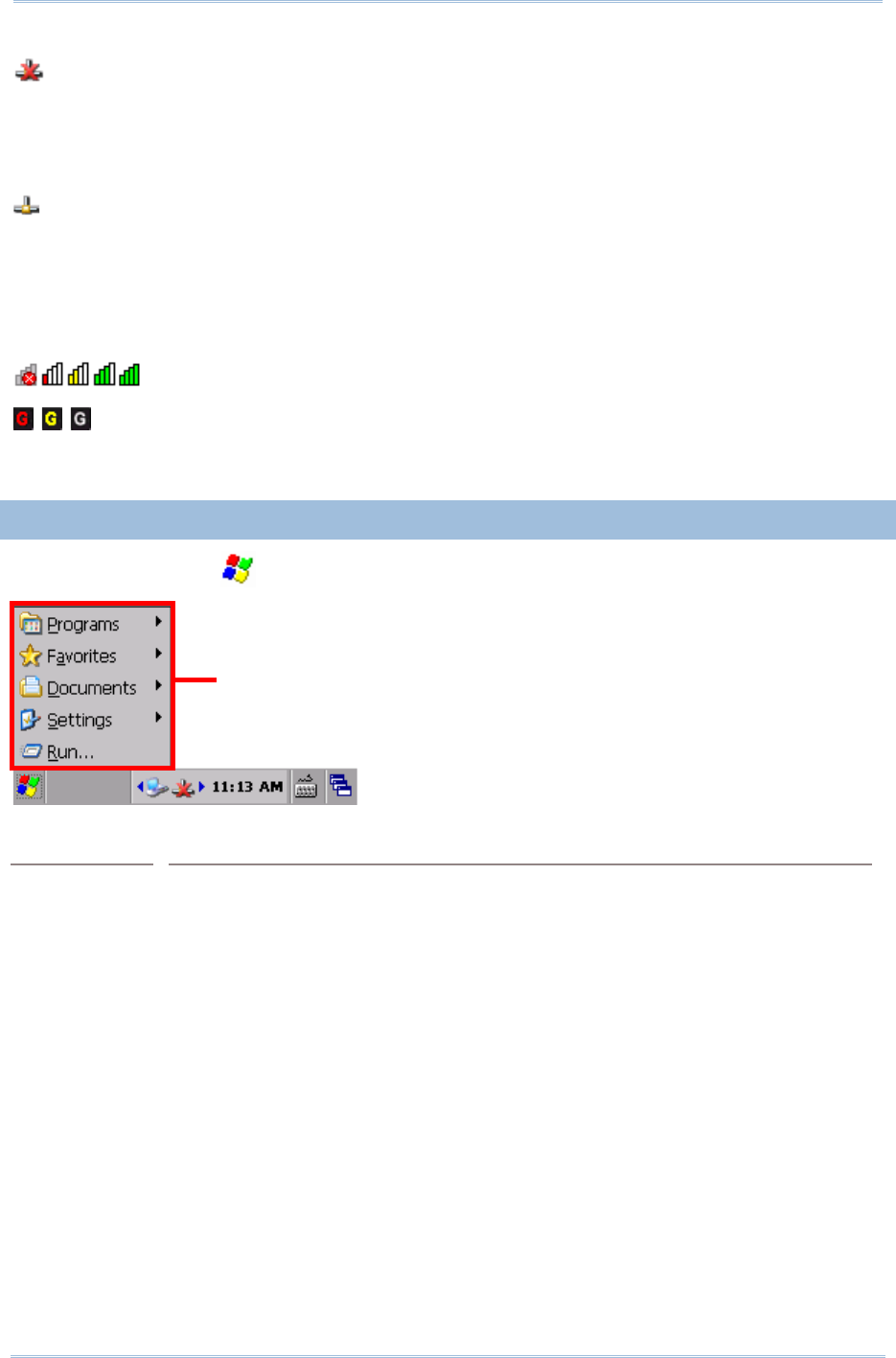
56
9700 Mobile Computer (CE) Reference Manual
A specific wireless connection is terminated or has failed. Double-tap the icon to
open a window to check IP information. Included connections are:
Bluetooth PAN
802.11a/b/g/n
WWAN
A specific wireless connection has been established successfully.
Double-tap the icon to open a dialog to check IP information. Included connections
are:
Bluetooth PAN
802.11a/b/g/n
WWAN connection
Indicates the Wi-Fi module is enabled. The more the green bars, the stronger the
signal.
Indicates cellular data connection status. Red means no connection is established,
yellow means the mobile computer is connecting to the WWAN network, and white
means a connection is successfully established.
2.1.2. START MENU
Tap the Start button on the taskbar to open the Start Menu.
Options Description
Programs Accesses programs stored in the directory My Device\Windows\Programs.
Favorites Accesses favorite links to webpages that are stored under the directory
My Device\Windows\Favorites.
Documents Accesses recently opened documents stored under the directory
My Device\Windows\Recent.
Settings Provides access to the following:
Control Panel
Network and Dial-up Connections
Taskbar and Start Menu
Run Opens a program, folder or document as specified.
Start menu
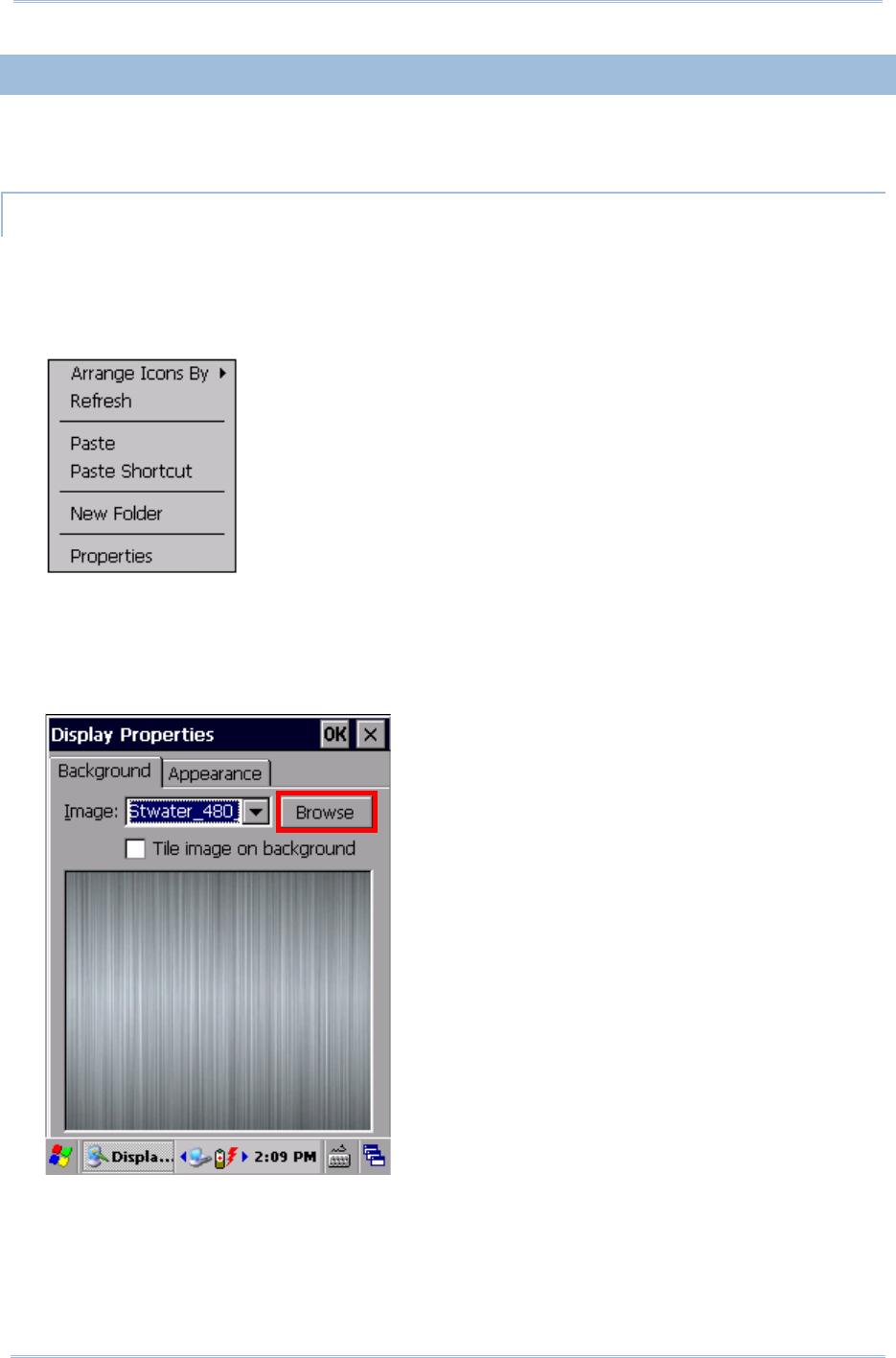
57
Chapte
r
2 Operating System
2.1.3. CUSTOMIZE DESKTOP AND START MENU
Customize the desktop by changing the background, application shortcuts, and so on.
Rearrange the application shortcuts to make the applications that you use most often easy
to access.
CHANGE BACKGROUND
You may change the background of the desktop to a picture of your own choice.
1) Tap and hold any blank space on the desktop.
A pop-up menu shows with actions to take to the desktop.
2) Tap Properties in the pop-up menu.
Display Properties window opens showing two tabbed pages for changing desktop
background and OS appearance.
3) Tap Browse button on the Background tabbed page.
4) In the Browse window that pops up, select the image file you would like to apply as the
desktop background.
Supported file formats are .bmp, .gif and .jpg files.
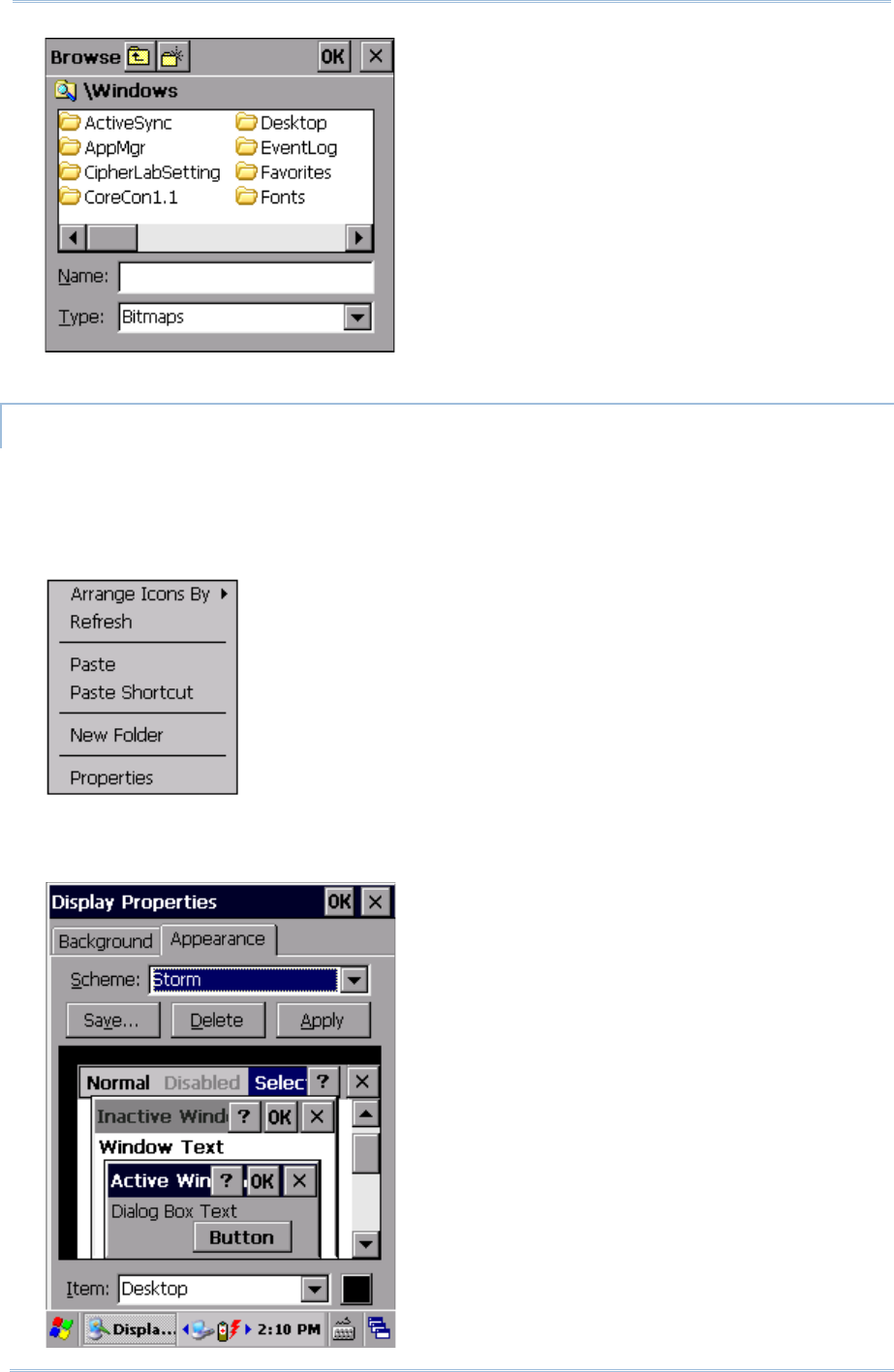
58
9700 Mobile Computer (CE) Reference Manual
The selected file will appear on the desktop as the background image.
CHANGE APPEARANCE
You may change the overall scheme, color of title bars, dialog boxes, menu text, selected
items and so on to suit your preferences.
1) Tap and hold any blank space on the desktop.
A pop-up menu shows with actions to take to the desktop.
2) Tap Properties in the pop-up menu.
3) Tap Appearance tab to open a page for changing the scheme style and item color.

59
Chapte
r
2 Operating System
ADD ITEMS TO DESKTOP
ADD APPLICATION SHORTCUTS
1) On the mobile computer, tap My Device on the desktop.
2) Browse to the executable file of the program you would like to create a shortcut for.
3) Tap and hold the file. A pop-up menu will show on the screen.
4) Tap Copy in the pop-up menu.
Browse to My Device\Windows\Desktop.
5) Tap and hold any blank space on the screen and select Paste shortcut from the pop-up
menu that comes up.
A shortcut to the program is added to the mobile computer’s desktop.
ADD BOOKMARKED WEBPAGE SHORTCUTS
1) On the mobile computer, tap My Device on the desktop.
2) Browse to My Device\Windows\Favorites.
3) Tap and hold the bookmark to create a shortcut for. A pop-up menu will show on the
screen.
4) Tap Copy in the pop-up menu.
5) Browse to My Device\Windows\Desktop.
6) Tap and hold any blank space on the screen and select Paste shortcut from the pop-up
menu that comes up.
A shortcut to the bookmarked webpage is added to the mobile computer’s desktop.
ADD FILE SHORTCUTS
1) On the mobile computer, tap My Device on the desktop.
2) Browse to the file to create a shortcut for.
3) Tap and hold the file. A pop-up menu will show on the screen.
4) Tap Copy in the pop-up menu.
5) Browse to My Device\Windows\Desktop.
6) Tap and hold any blank space on the screen and select Paste shortcut from the pop-up
menu that comes up.
A shortcut to the bookmarked webpage is added to the mobile computer’s desktop.
ADD ITEMS TO START MENU
ADD APPLICATION SHORTCUTS
7) On the mobile computer, tap My Device on the desktop.
8) Browse to the executable file of the program you would like to create a shortcut for.
9) Tap and hold the file. A pop-up menu will show on the screen.
10)Tap Copy in the pop-up menu.
11)Browse to My Device\Windows\Programs.
12)Tap and hold any blank space on the screen and select Paste shortcut from the pop-up
menu that comes up.

60
9700 Mobile Computer (CE) Reference Manual
A shortcut to the program is added to the Start Menu.
REMOVE ITEMS FROM START MENU
13)On the mobile computer, tap My Device on the desktop.
14)Browse to My Device\Windows\Programs.
Programs folder opens. All applications available in the Start menu can be found here.
15)Tap and hold the application to remove. A pop-up menu shows on the screen.
16)Tap Delete.
The application is removed from Start Menu.
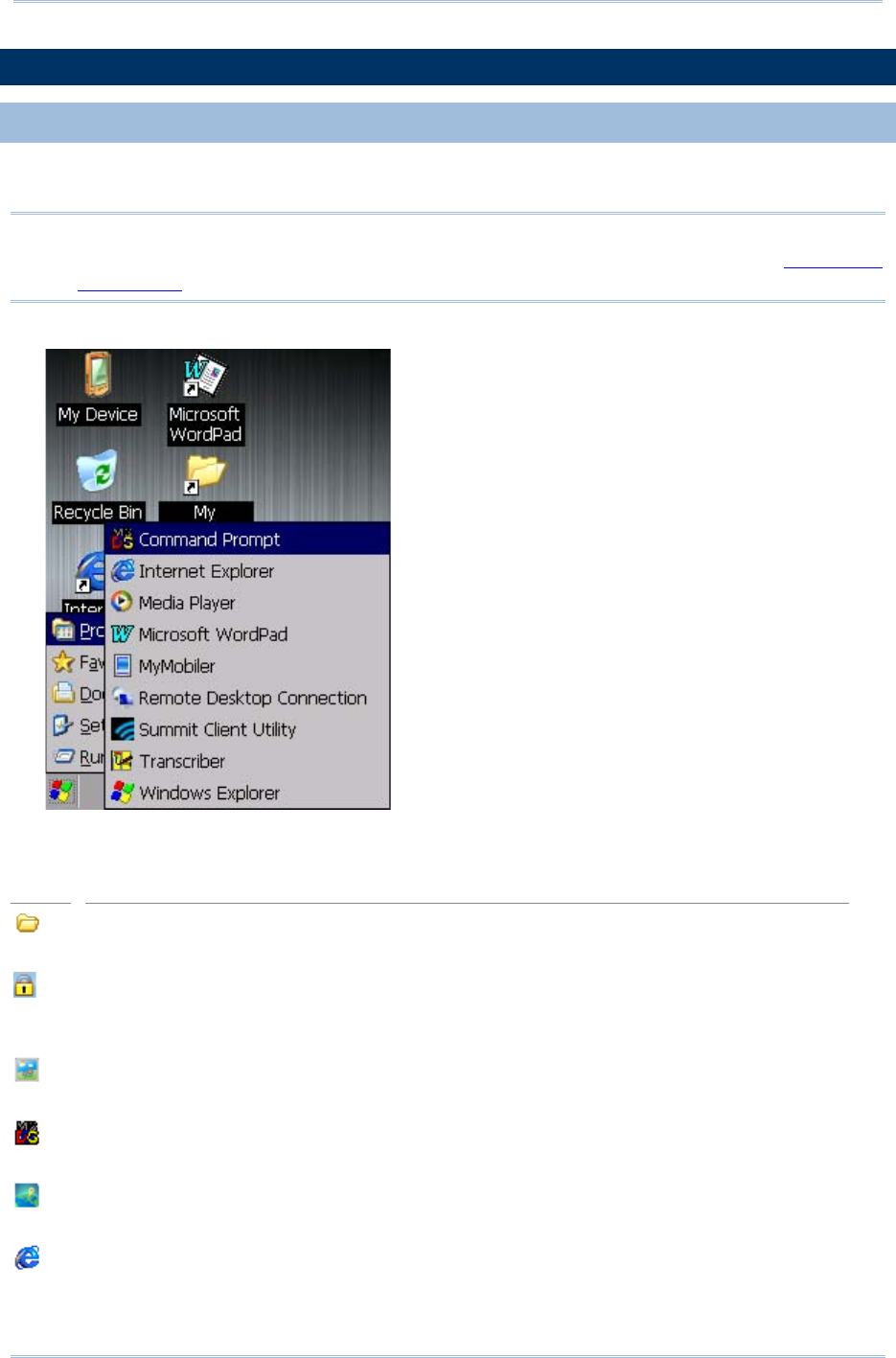
61
Chapte
r
2 Operating System
2.2. MANAGING PROGRAMS
2.2.1. LAUNCH PROGRAM
1) Tap Start |Programs to display a menu listing all the programs installed on the mobile
computer.
Note: Use this menu to launch any programs newly installed on the mobile computer.
Alternatively, you may add a shortcut of the program on the desktop. See Add Items
to Desktop.
2) Tap the desired program to launch it on-screen.
The programs pre-installed on the mobile computer include:
Icon Description
CIPHERLAB UTILITIES
(Reserved folder.)
APPLOCK
AppLock limits access to programs and settings on the mobile computer through an
authorization mechanism. See the AppLock User Guide for details.
CAMERA CAPTURE
Camera application which also serves as an image viewer.
COMMAND PROMPT
Command line interpreter program which can be used to execute commands.
GPS VIEWER
Program for viewing GPS positioning results and streamed GPS data.
INTERNET EXPLORER
Browser for the world wide web.
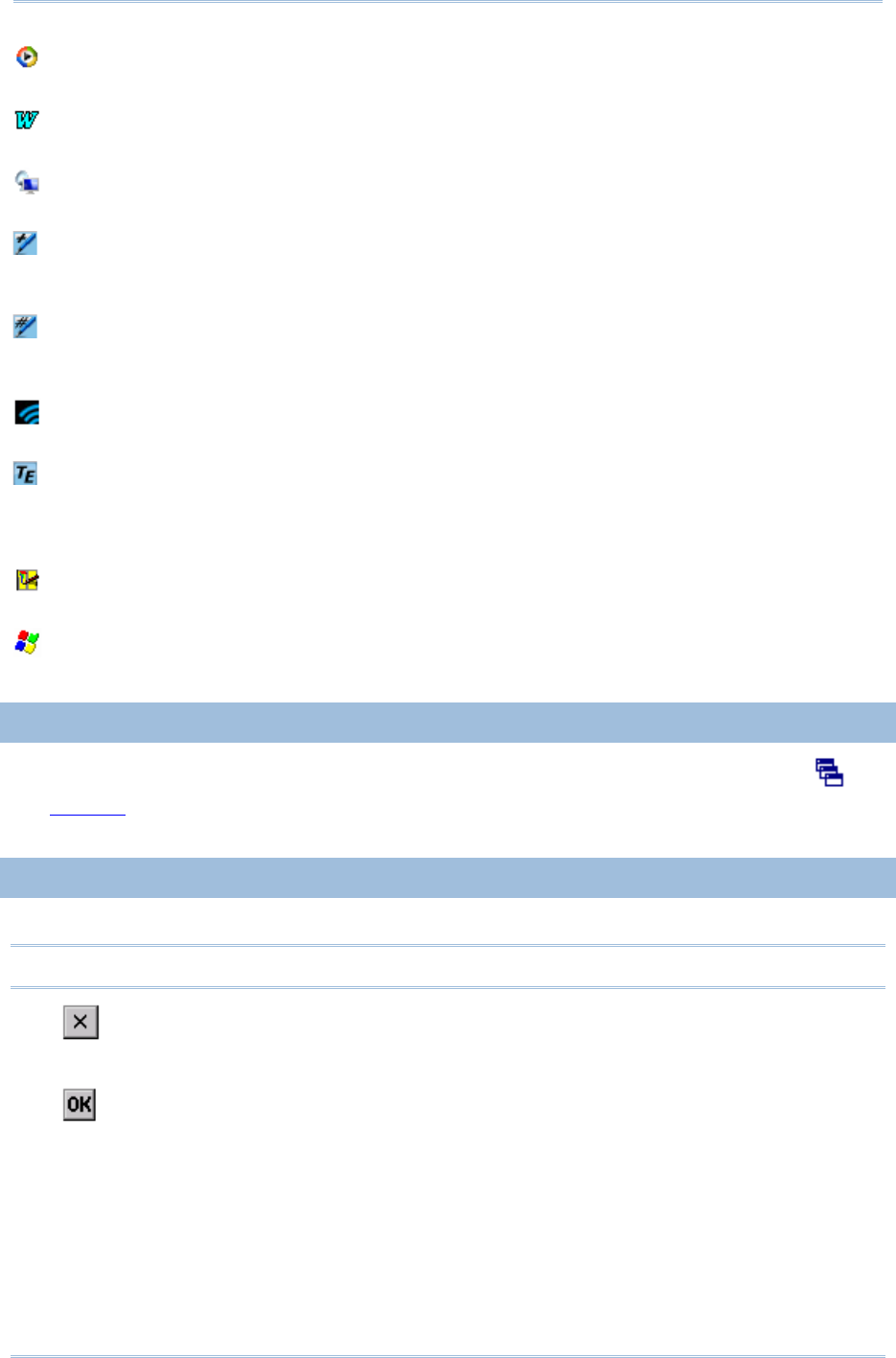
62
9700 Mobile Computer (CE) Reference Manual
MEDIA PLAYER
Audio/video file player.
MICROSOFT WORDPAD
Wordpad for entering text.
REMOTE DESKTOP CONNECTION
Program for connection to a remote computer.
SIGNATURE
Signature application which is available for C++ programming via API deployment. See
the CP60 C++ Programming Guide for details.
SIGNATUREDOTNET
Signature application which is available for .NET programming via API deployment. See
the CP60 .NET Programming Guide for details.
SUMMIT CLIENT UTILITY
Utility which controls Wi-Fi connection, adjusts settings and performs diagnostic tests.
TERMINAL EMULATION
Terminal emulation application allows the mobile computer to act as a telnet client and
connect to a host computer to use the applications running on it. See the Terminal
Emulation User Guide for details.
TRANSCRIBER
Application for handwriting recognition.
WINDOWS EXPLORER
Browser for the mobile computer’s internal storage.
2.2.2. SWITCH BETWEEN ACTIVE TASKS
To switch between the active tasks currently running on the mobile computer, tap on
the Taskbar. In the pop-up menu that shows up, tap the program or task button to open, or
tap Desktop to minimize the active window and display the desktop.
2.2.3. EXIT A PROGRAM
To ensure efficient use of the memory, you should exit a program when it is no longer in use
Note: Always remember to save the data or settings before you exit a program.
Tap to close an active window, dialog box, or running program. You may alternatively
press ESC on the physical keypad to close a dialog box or running program.
Tap to save the current settings and close a dialog, program, or minimize the window
for certain programs. You may alternatively press Enter on the physical keypad to save
settings and close a dialog or program.
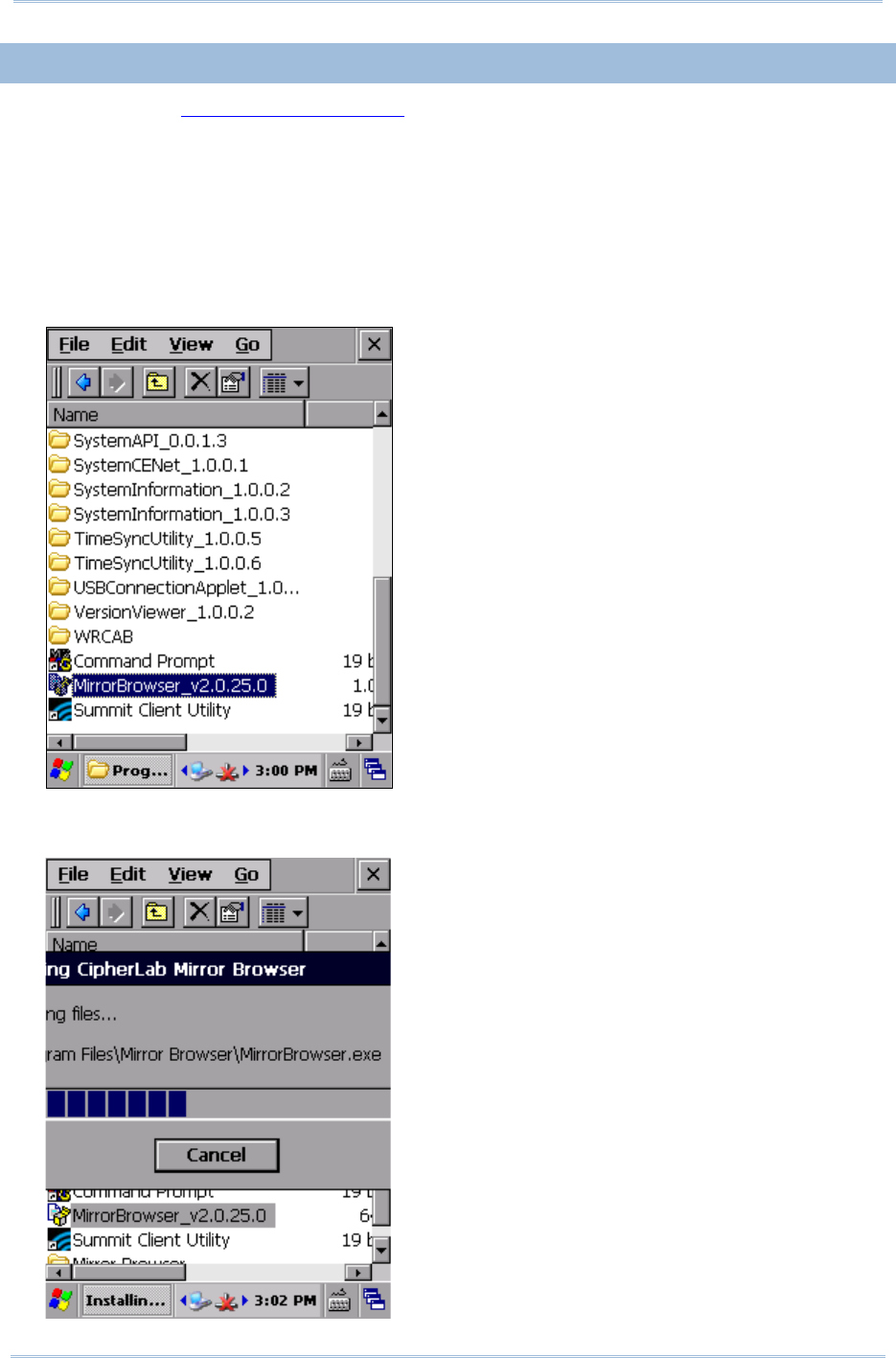
63
Chapte
r
2 Operating System
2.2.4. INSTALL APPLICATIONS
As mentioned in Add/Remove Programs, you can download and install an application on
your PC first and offload it to the mobile computer later using Microsoft ActiveSync.
Alternatively, the OS allows you to install an application right from the mobile computer.
Follow the steps below to complete installation:
1) Using your PC, copy the installation file (.CAB) to the mobile computer’s internal storage
via ActiveSync.
2) On the mobile computer, use My Device (File Explorer) to browse to the installation
file.
3) Tap the file to begin the installation process. Confirm the location to install the program
if necessary. The program proceeds to install to the specified location.
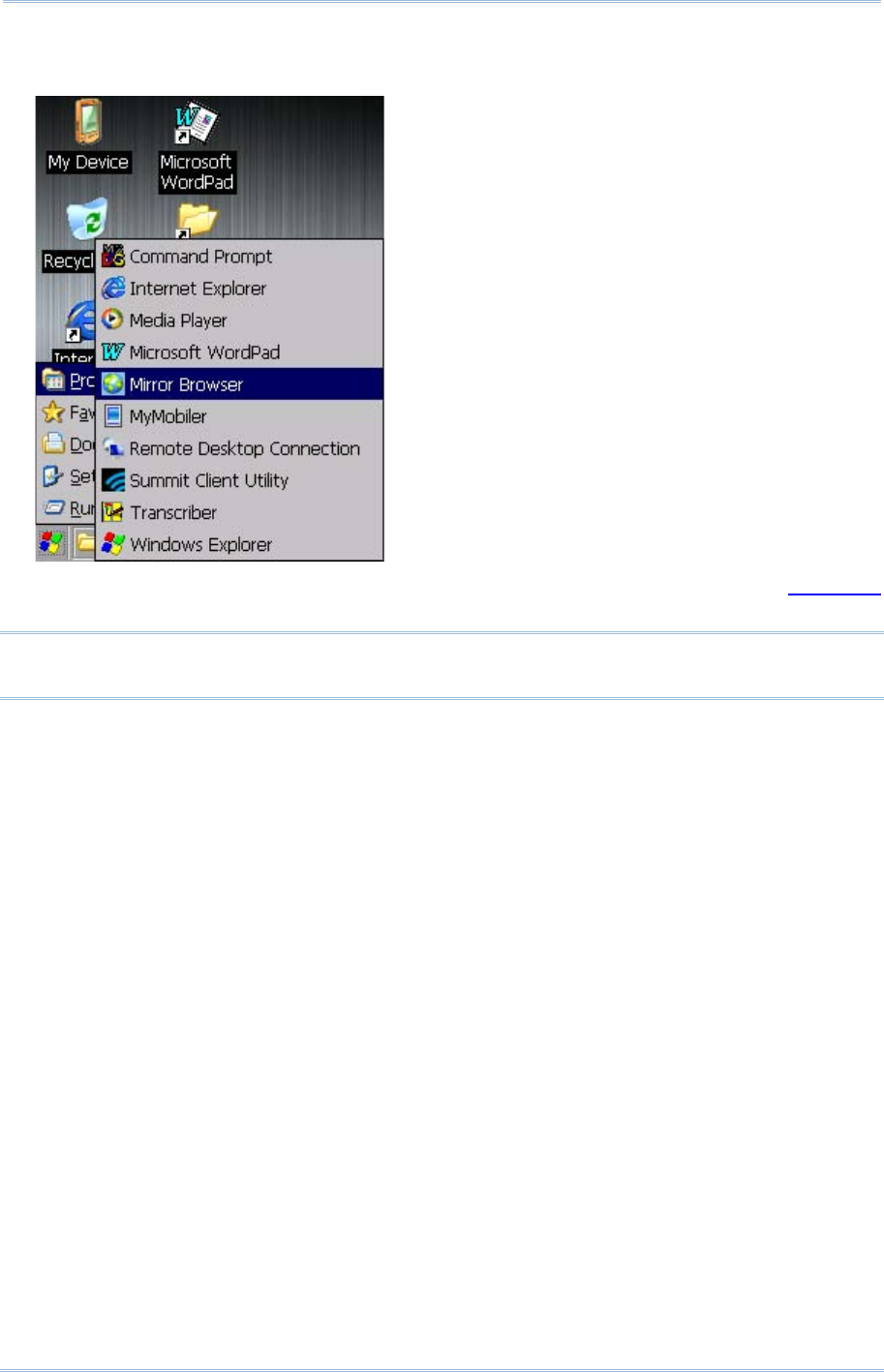
64
9700 Mobile Computer (CE) Reference Manual
4) When installation is finished, launch it by tapping Start |Programs and locating it in
the Programs menu.
Alternatively, you may download an application to install from the Internet. See Use Wi-Fi
for how to connect the mobile computer to the Internet.
Note: To ensure protection of your mobile computer, download applications from trusted
sources only.
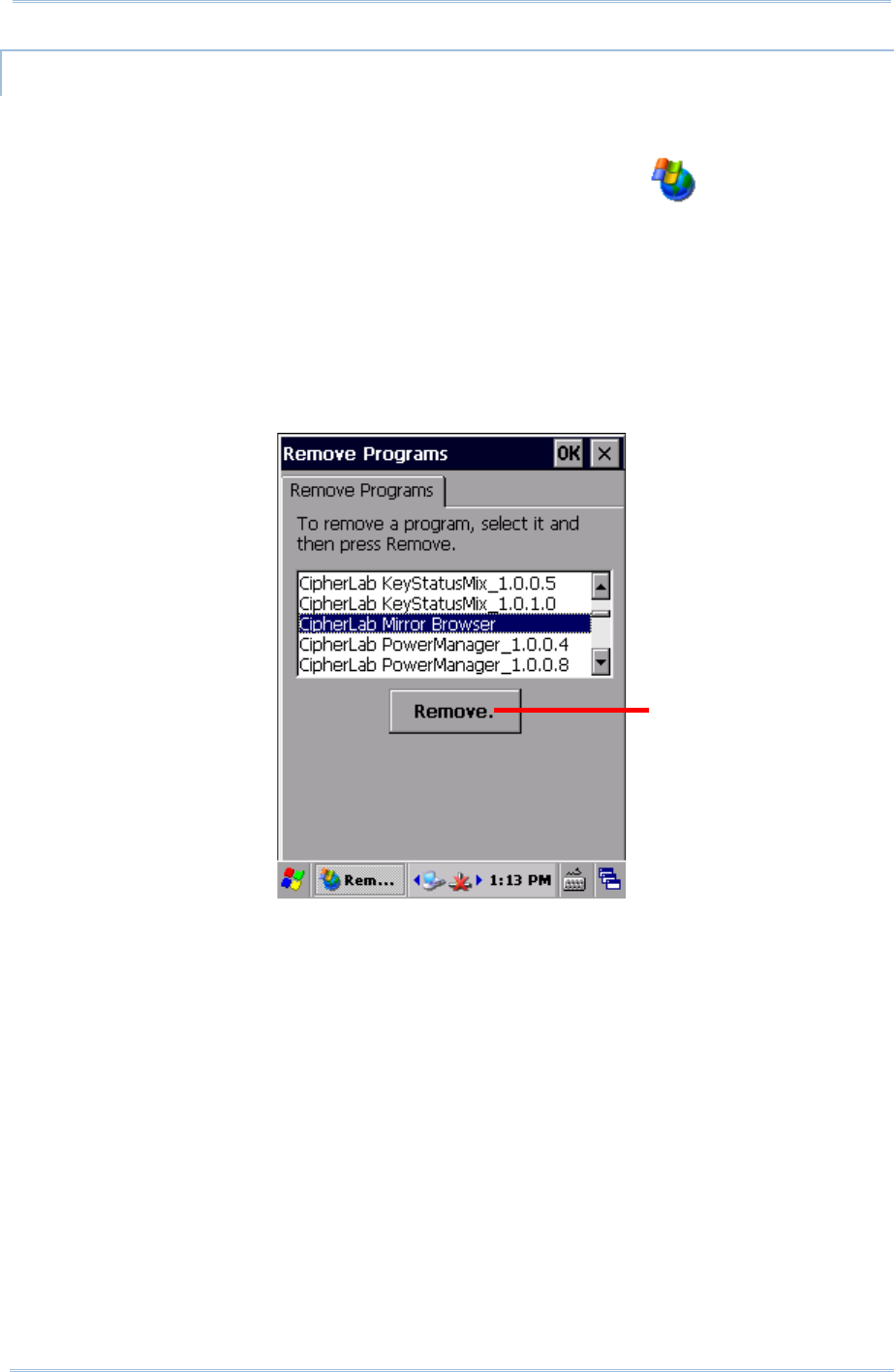
65
Chapte
r
2 Operating System
UNINSTALL APPLICATIONS
On the mobile computer, the acquired (non-inherent) applications can be depleted from the
OS through manual removal (uninstallation). To uninstall an application:
1) Tap Start | Settings | Control Panel | Remove Programs .
Remove Programs opens showing the applications downloaded and installed from
external sources.
2) Tap the application to remove.
The Remove button becomes available.
3) Tap Remove to uninstall the application.
4) Follow on-screen instructions to complete through the uninstallation process.
Tap to remove the selected
application
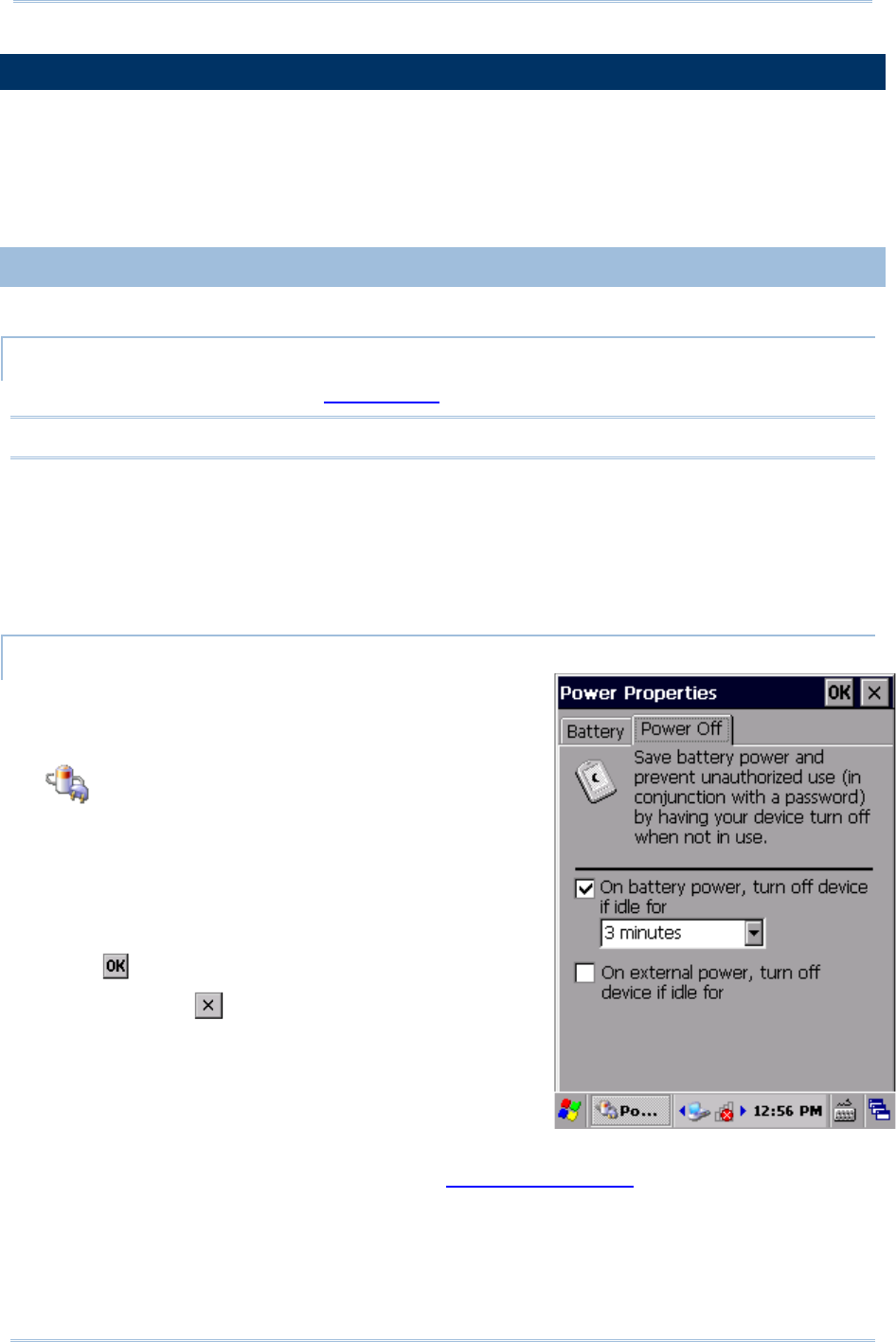
66
9700 Mobile Computer (CE) Reference Manual
2.3. SUSPEND & RESET MOBILE COMPUTER
To save from repeatedly charging and replacing batteries, suspend the mobile computer
when you are not actively using it. Suspending (or “turning off”) the mobile computer holds
the device from running without cutting off power. It is a “soft-off” state which enables less
power consumption, and also a state which the device can quickly awake from since there
is no need to restart the OS and applications.
2.3.1. SUSPEND MOBILE COMPUTER
The mobile computer is suspendable both manually and automatically.
MANUAL SUSPENSION
1) Press the power button. The Power Menu opens.
Note: There is no need to press and hold the power button.
2) Select Suspend in the power menu.
The mobile computer enters suspension mode.
OR
Do not select any item, and the mobile computer will automatically enter suspension in
five seconds.
AUTO-SUSPENSION
Set up a power plan to suspend the mobile computer in
apt timing. This helps preserve battery life.
1) Tap Start | Settings | Control Panel |Power
|Schemes tabbed page.
2) Under Switch state to Suspend, set a time limit to
suspend the mobile computer as long as it has been
in idle state for the indicated period of time. Power
plans are available for both battery power and
external power.
3) Tap to save the settings and close the
application, or to exit the application directly.
Note the following cases will also cause the mobile
computer to enter suspension:
Battery fails
When the touchscreen of the mobile computer is facing down
To get the most from the battery power, see Power Management.
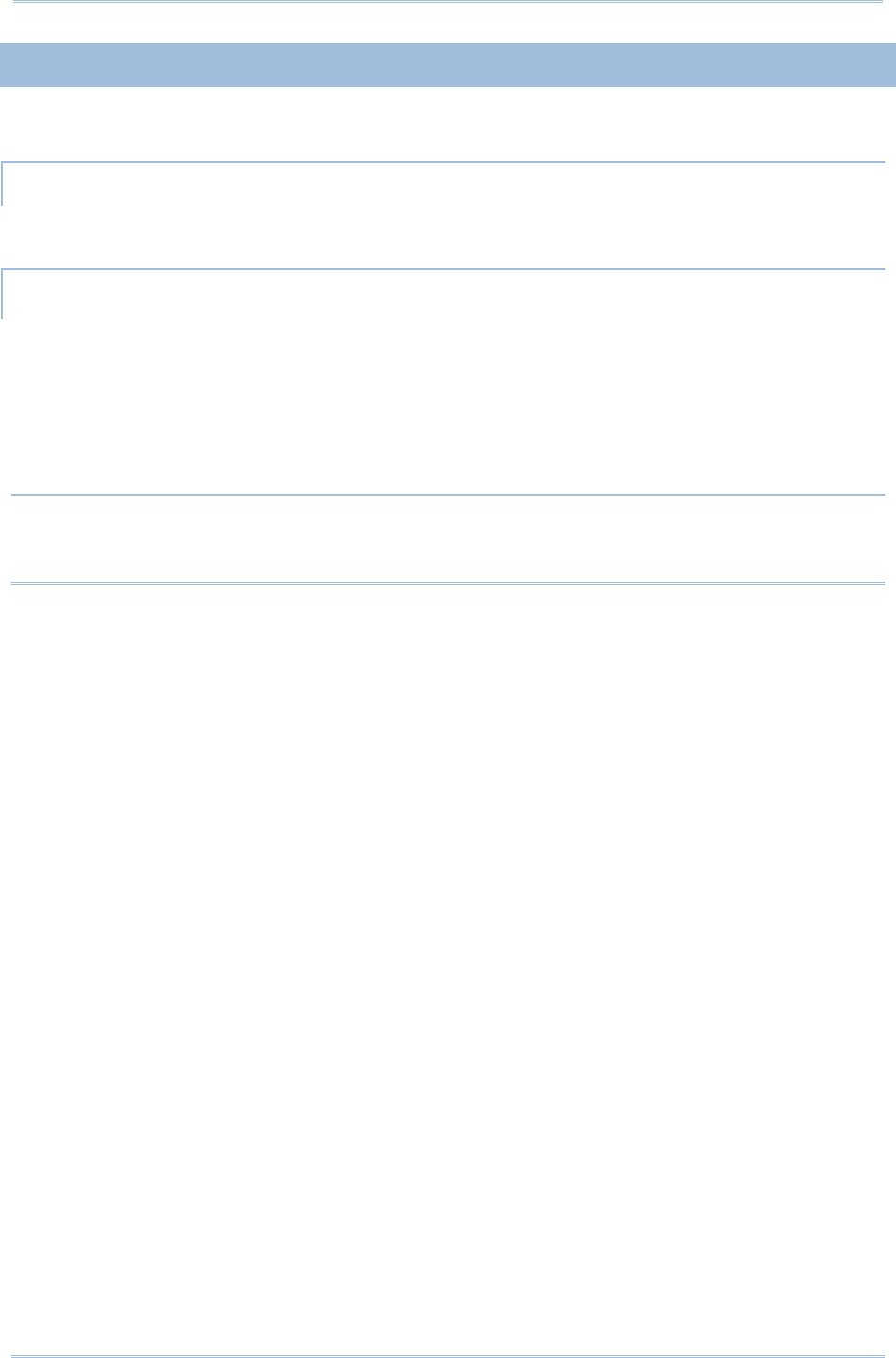
67
Chapte
r
2 Operating System
2.3.2. WAKE UP MOBILE COMPUTER
“Waking up” refers to restoring the suspended device to its previous working state. The
mobile computer can be awoken both manually and automatically.
MANUAL AWAKENING
Press (without holding) the power button or central scan key to wake up the mobile
computer.
AUTO-AWAKENING
The mobile computer wakes up by itself when either of the following happens:
USB or serial cable is plugged in
AC power cord is plugged in
WWAN ringing signal occurs
RTC alarm occurs
Note: There are certain cases when the mobile computer cannot be awoken:
(1) When battery door isn’t installed in place.
(2) Imperfect contact exists between main battery and battery chamber contact pins.
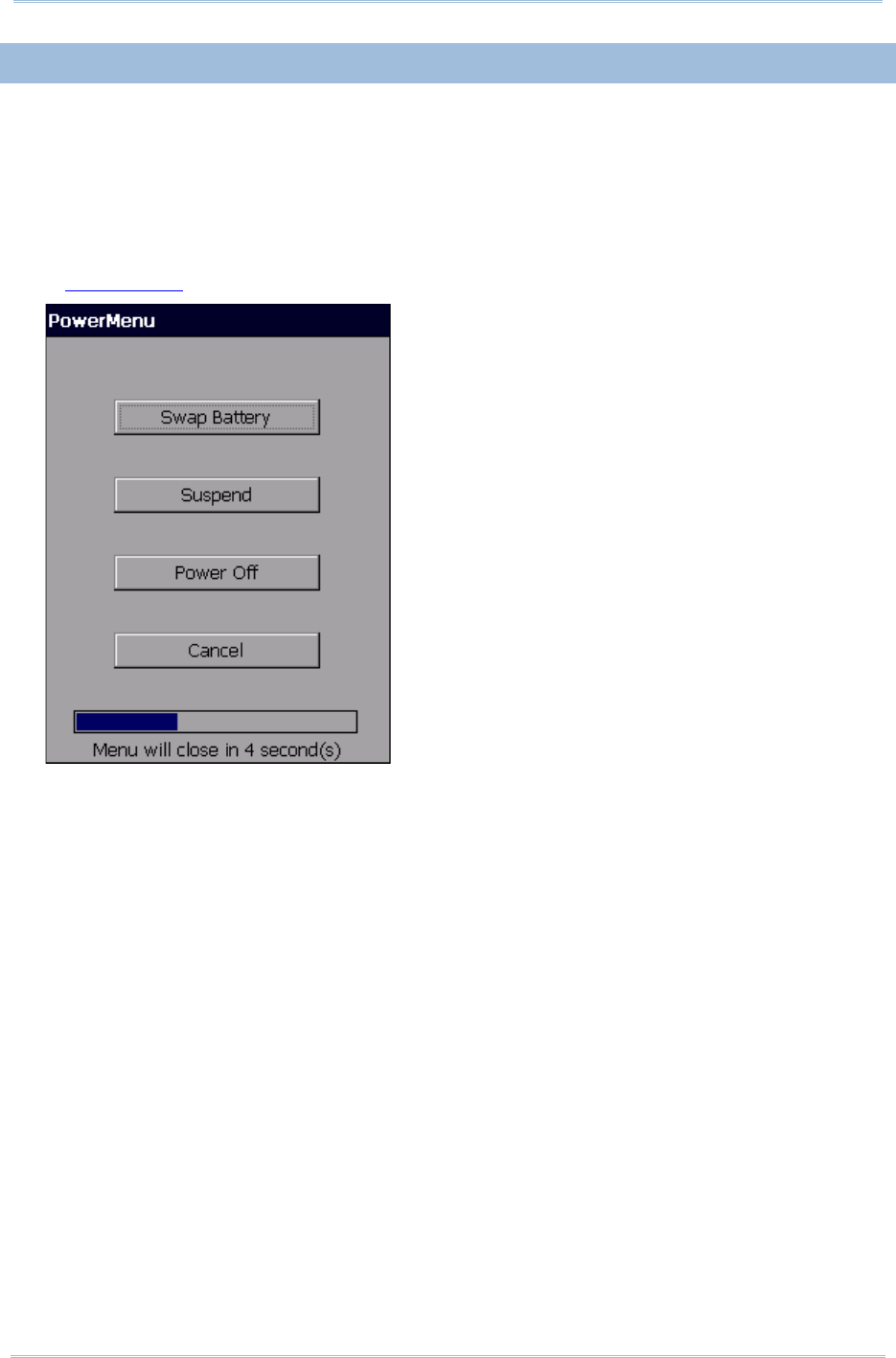
68
9700 Mobile Computer (CE) Reference Manual
2.3.3. RESTART MOBILE COMPTUER
When the system becomes erroneous and applications fail to respond properly, proceed to
restart the mobile computer. After the mobile computer is restarted, DRAM will be initialized,
and all data cached in DRAM and any unsaved tasks will be erased. However all user data,
system settings and clock/calendar time will be preserved.
To restart the mobile computer:
1) Press and hold the power button for around three seconds.
APower Menu shows onscreen.
2) Tap Power off in the menu. The mobile computer shuts down.
3) Press the power button once more. The mobile computer powers on to show the
desktop.

69
The mobile computer is a versatile networker. It integrates Wi-Fi and Bluetooth for wireless
data. With the help of these radios, the mobile computer keeps users online all the time.
In this chapter, you will learn how these radios can work for you.
3. IN THIS CHAPTER
3.1 Use Wi-Fi.................................................................. 70
3.2 Use Bluetooth............................................................ 96
Chapter 3
RADIOS
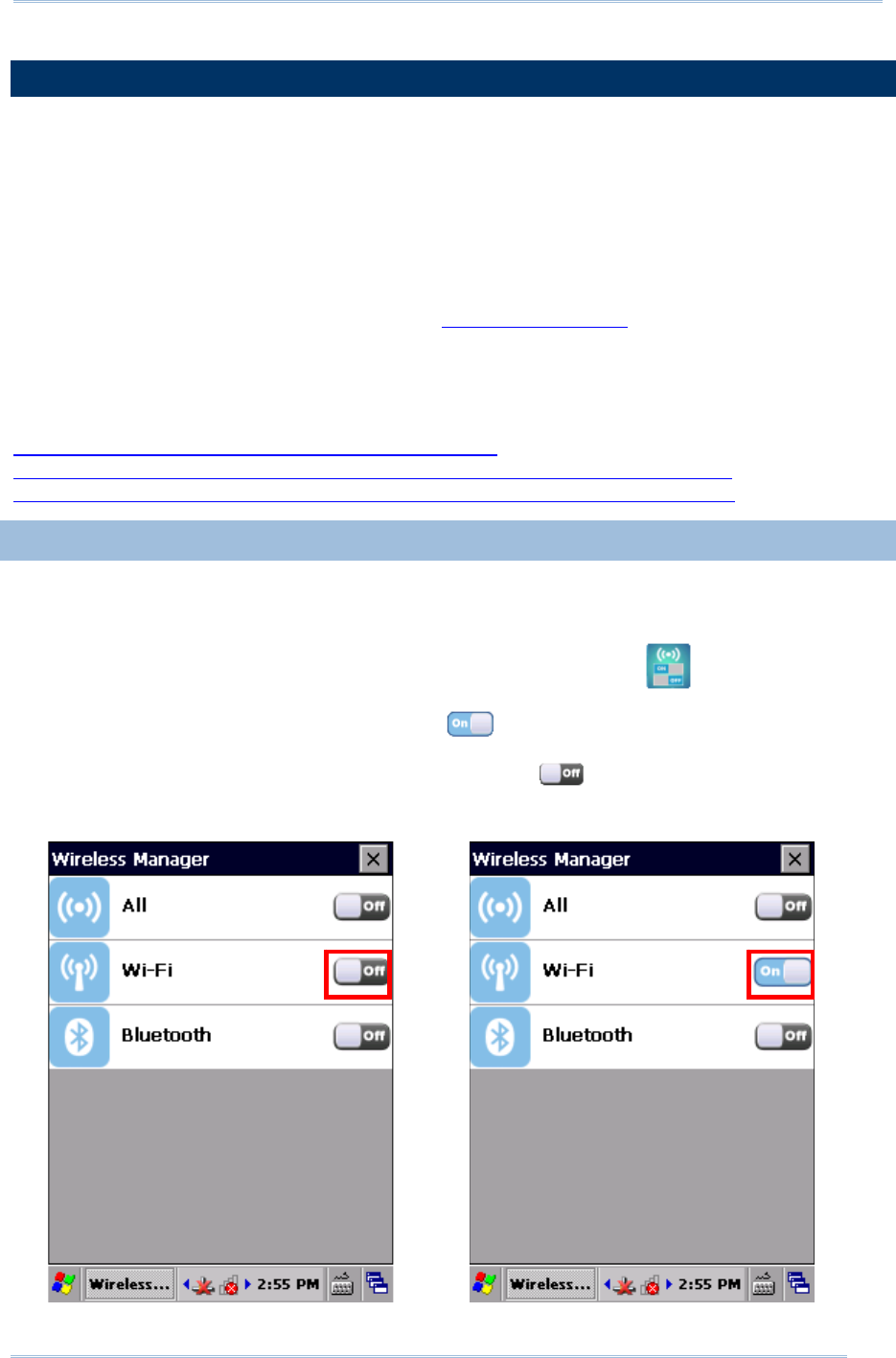
70
9700 Mobile Computer (CE) Reference Manual
3.1. USE WI-FI
The mobile computer is capable of Wi-Fi, a wireless networking technology making use of an
access point, also known as “hotspot”, to connect to a wireless local area network.
To use Wi-Fi, the mobile computer has to connect to a hotspot. Some hotspots are open for
connection while others request a key to authenticate access. If this is the case, the
authentication key must be included in the mobile computer’s Wi-Fi settings.
For authentications based on secure certificates, see Certificates.
Wi-Fi settings and power are controlled via Summit Client Utility (SCU). When Wi-Fi is not
in use, turn it off to extend battery life. See Power On/Off Wi-Fi.
Summit Client Utility functions by the use of Wi-Fi profiles. Profiles are a set of radio and
security settings that are stored in the registry. You may create, rename, edit and delete
profiles, as well as alter global settings that apply to every profile or to Summit Client Utility
(SCU) itself. For more details on profile settings, please visit the following websites:
http://www.summitdata.com/documentation.html
http://www.summitdata.com/Documents/summit_users_guide_3_03.html
http://www.summitdata.com/Documents/summit_quick_start_v3_03.html
3.1.1. POWER ON/OFF WI-FI
Before configuring any Wi-Fi connection settings, check if Wi-Fi power is turned on.
To turn on Wi-Fi:
4) Tap Start | Settings | Control Panel | Wireless Manager .
5) Make sure the Wi-Fi label is turned “on” .
If the Wi-Fi label is turned “off”, tap the “Off” icon . Wi-Fi power is switched on in
a few seconds.
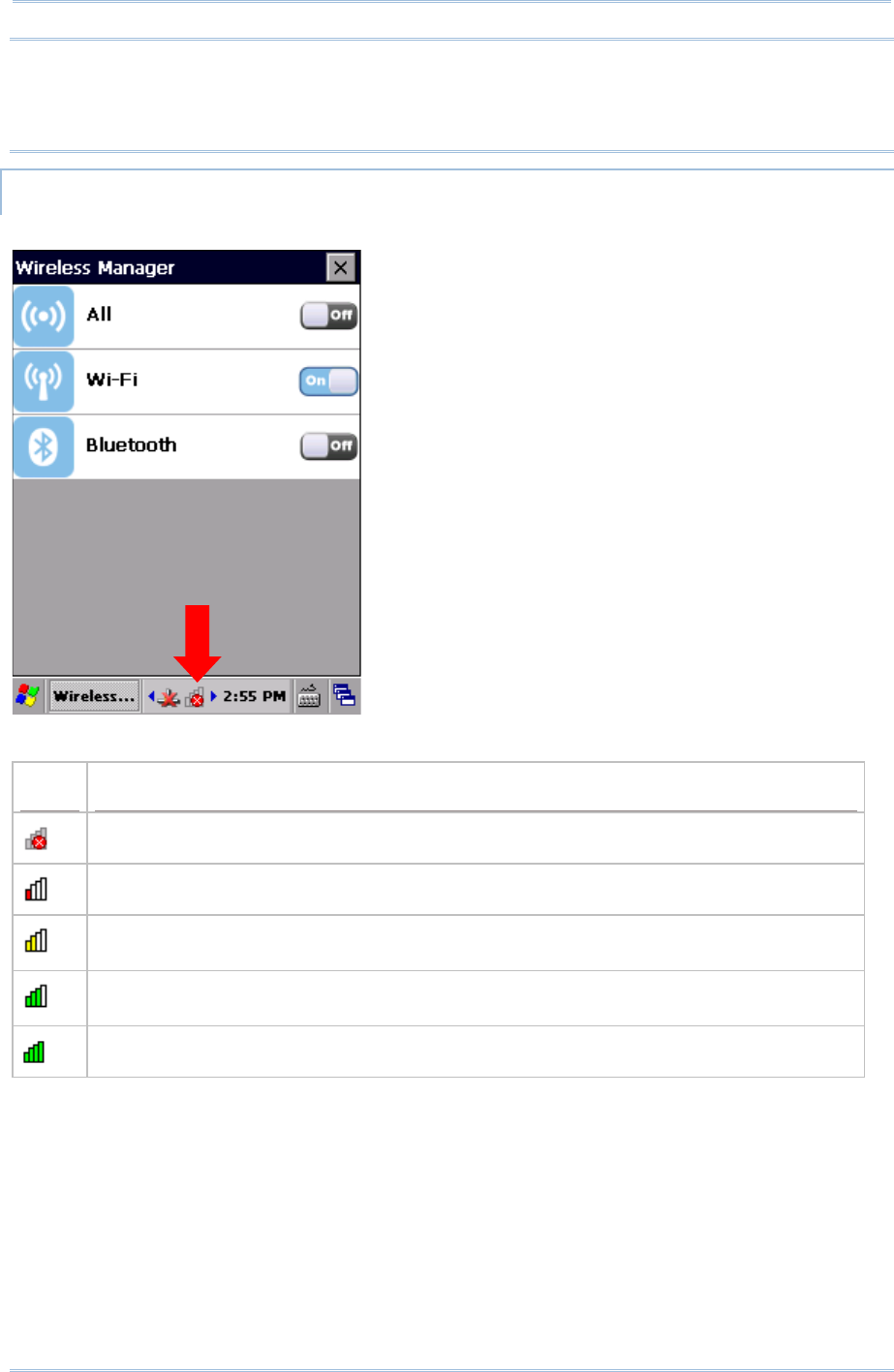
71
Chapte
r
3 Radios
Note: Wi-Fi power settings under Wireless Manager will be kept through suspension and
warm boot/cold boot. After the mobile computer resumes from suspension or
restarts, Wi-Fi power status will be maintained and the mobile computer will attempt
to reconnect the previous connection.
SYSTEM TRAY ICON
The taskbar features a system tray icon to show Wi-Fi status.
The icons available for Wi-Fi connection are as follows:
Icon Description
Indicates no Wi-Fi connection is established.
Indicates poor Wi-Fi signal (RSSI value is -90 dBm or weaker).
Indicates relatively low Wi-Fi signal (RSSI value is stronger than -90 dBm but does not
exceed -70 dBm).
Indicates good Wi-Fi signal (RSSI value is stronger than -70 dBm but does not exceed
-50 dBm).
Indicates high Wi-Fi signal (RSSI value is stronger than -50 dBm).
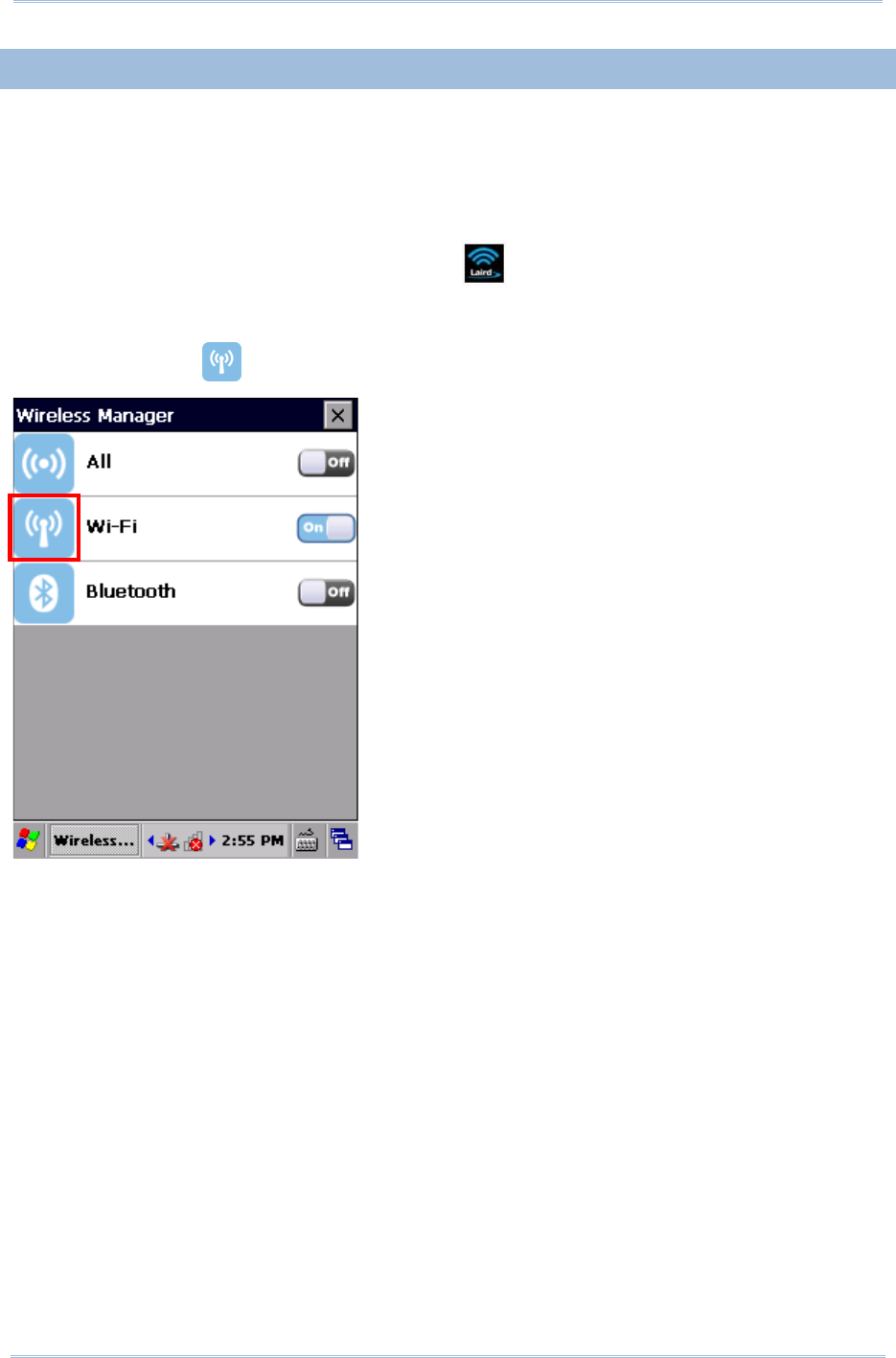
72
9700 Mobile Computer (CE) Reference Manual
3.1.2. LAUNCH SCU
Wi-Fi settings can be adjusted with Summit Client Utility. Within this application are three
tabbed pages which allow users to select the access point for connection, create profiles for
better management, perform diagnostics on connectivity, and fine-tune property settings
to meet their individual requirements.
To launch SCU:
Tap Start | Settings | Control Panel | SCU .
OR
Tap the Wi-Fi icon on the Wireless Manager settings page.
SCU opens showing three tabbed pages: Status,Configuration and Diagnostics.
The following sections explicate in detail the settings on each of these pages.
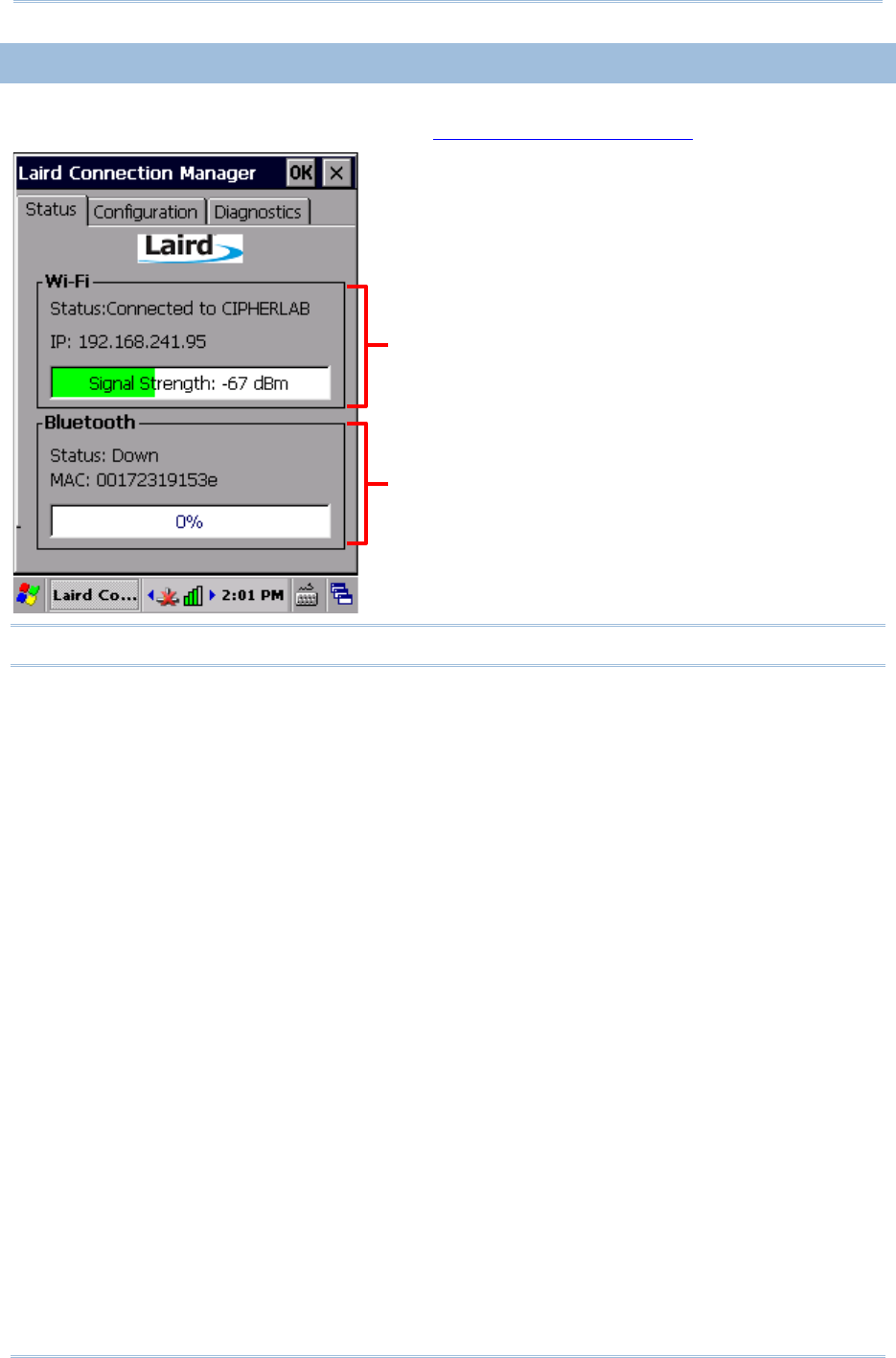
73
Chapte
r
3 Radios
3.1.3. STATUS TABBED PAGE
The Status tabbed page provides basic information on WLAN connection and Bluetooth
status. Wi-Fi settings can be configured on Configuration Tabbed Page.
Note: SCU does not currently support viewing or configuring Bluetooth settings.
Wi-Fi status
Bluetooth status
(service coming soon)
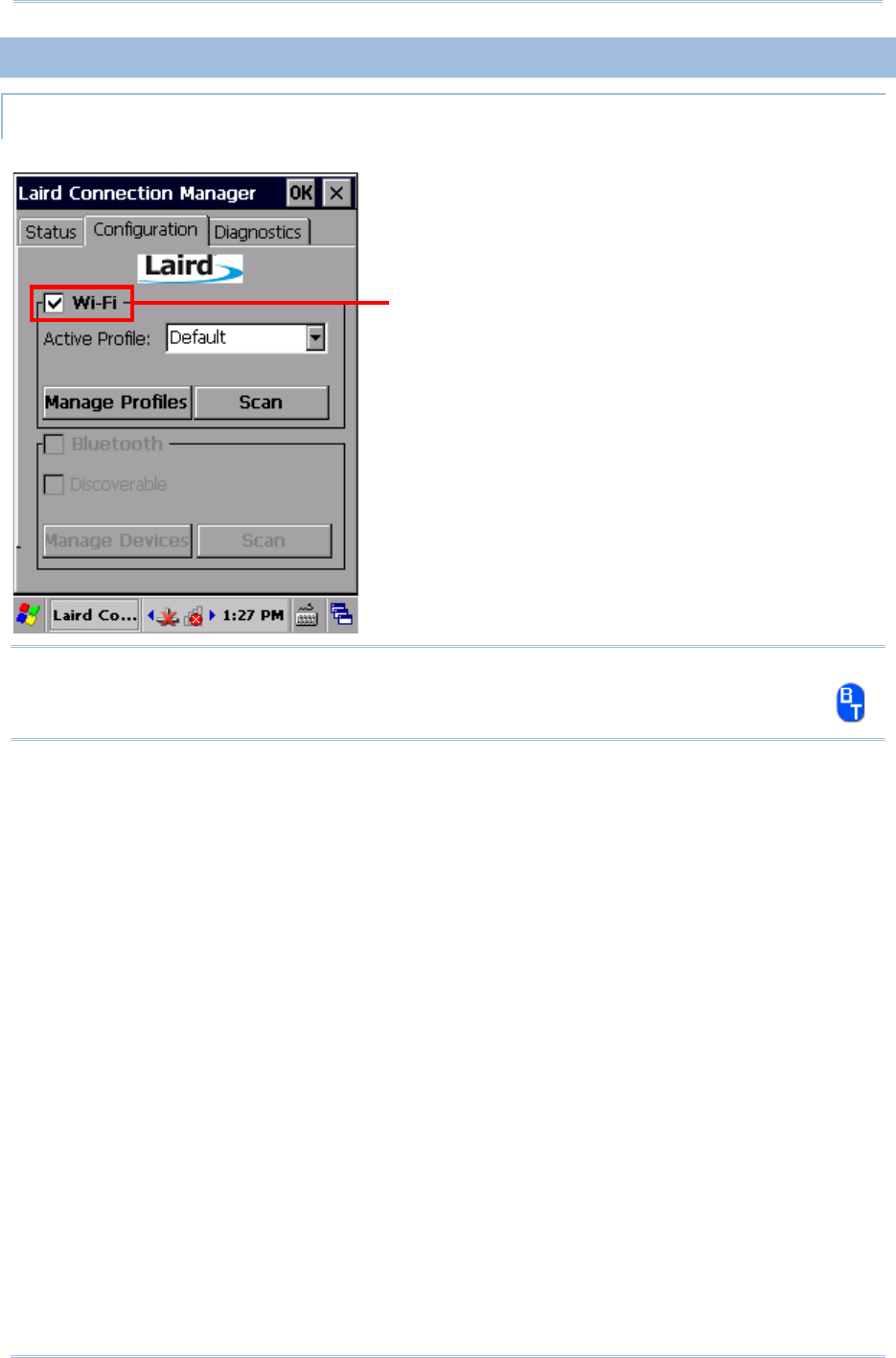
74
9700 Mobile Computer (CE) Reference Manual
3.1.4. CONFIGURATION TABBED PAGE
TURN ON/OFF WI-FI MODULE
Select the Wi-Fi checkbox to turn on Wi-Fi. Deselect it to shut down Wi-Fi.
Note: SCU does not allow configuration of Bluetooth settings. To establish and manage
Bluetooth connections, tap Start |Settings | Control Panel |BT Manager .
Turn on Wi-Fi module
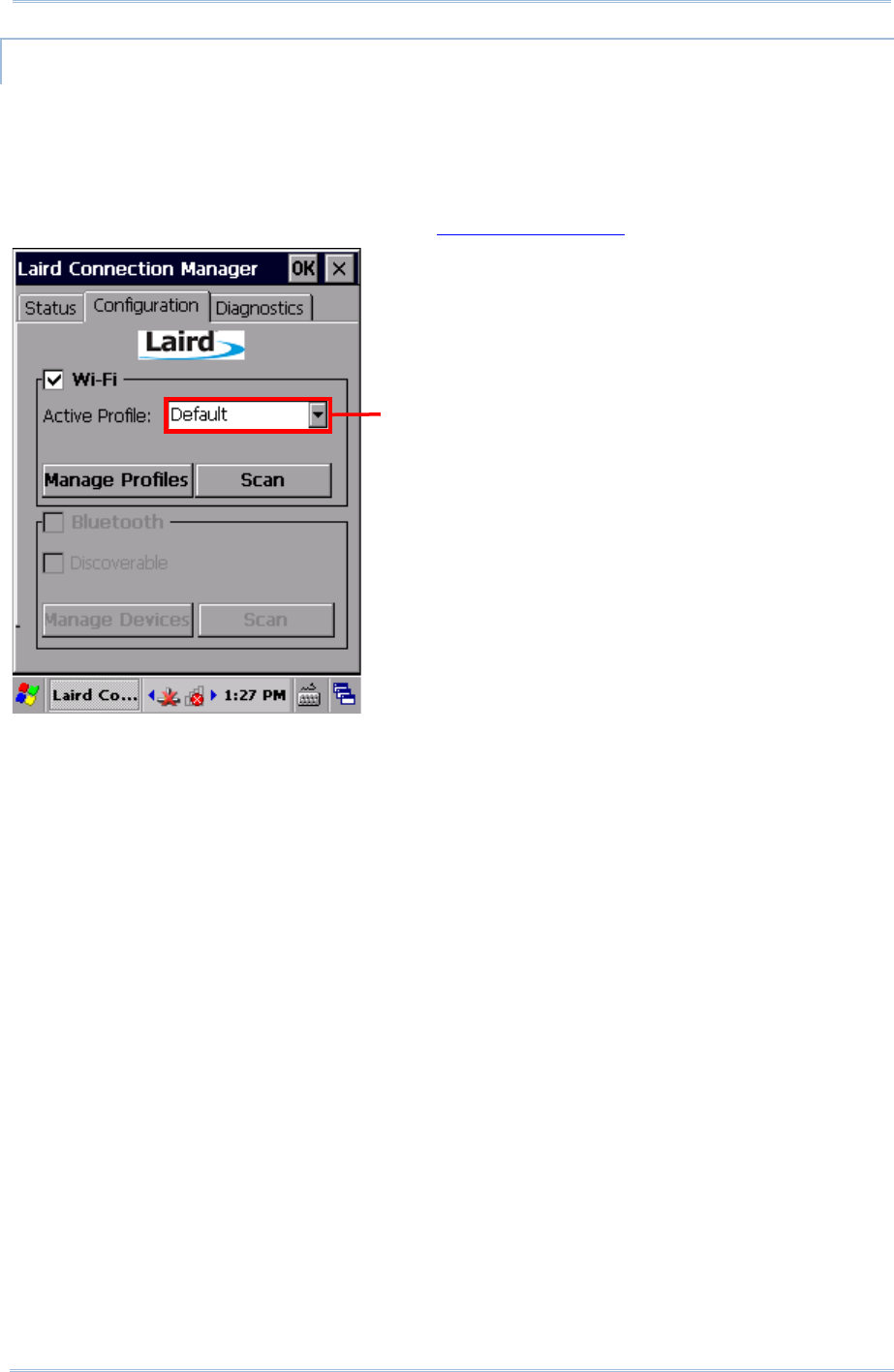
75
Chapte
r
3 Radios
ACTIVE PROFILE
A profile is a set of parameters that define the manner which a device associates to a
wireless LAN (WLAN) infrastructure. A profile contains information including the System Set
Identifier (SSID, the "name" of the WLAN infrastructure), means of data encryption,
authentication type, and security credentials.
Select an active profile in the drop-down box on the Configuration tabbed page. To add a
profile other than the “Default” profile, see Create Wi-Fi Profile.
Tap to select an active profile
in the drop-down bar
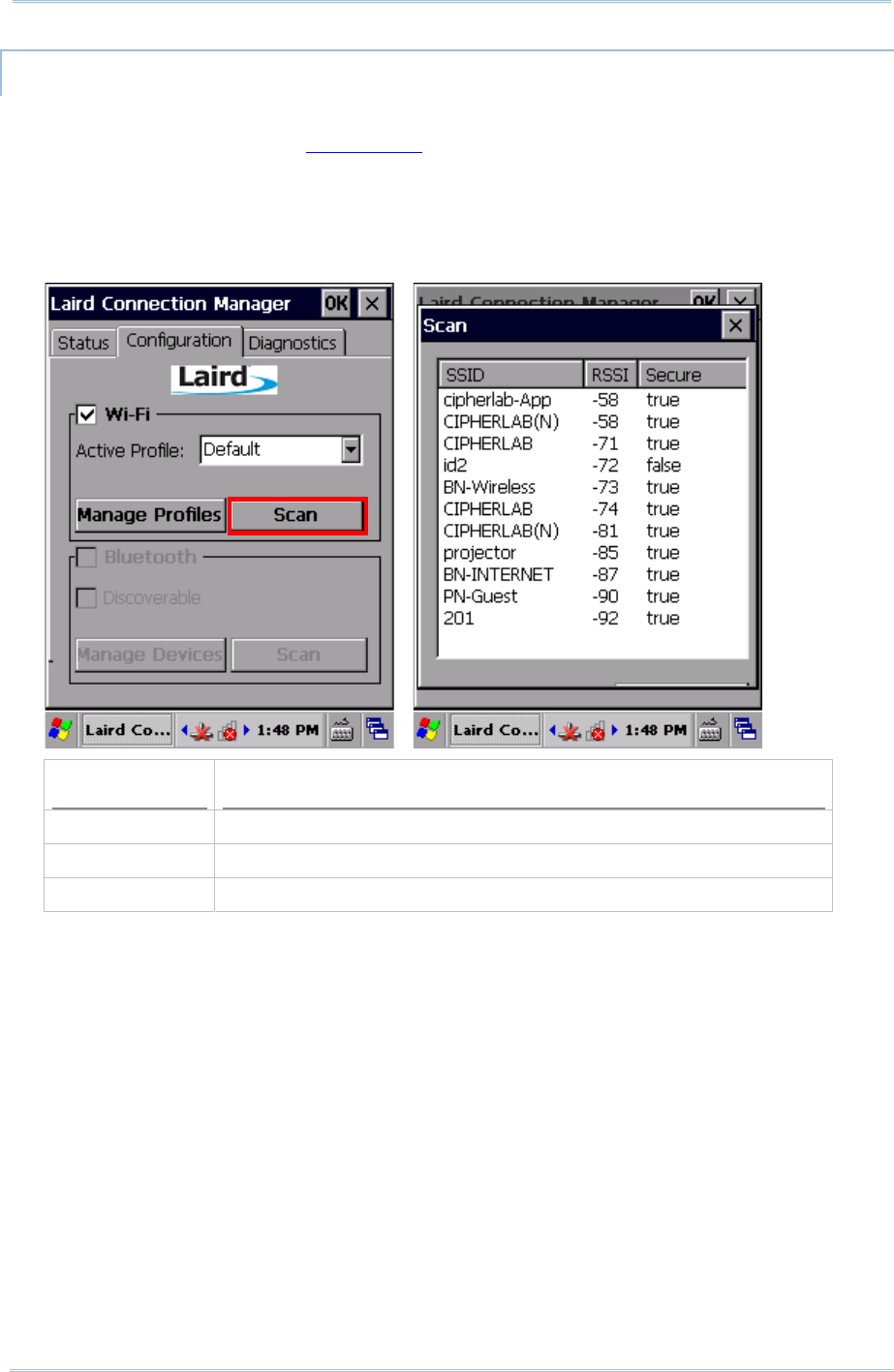
76
9700 Mobile Computer (CE) Reference Manual
CREATE WI-FI PROFILE
To create a Wi-Fi Profile:
1) Open SCU as described in Launch SCU.
2) Tap the Configuration tab to show the Configuration tabbed page.
3) Tap Scan to view a list of access points that are broadcasting their SSIDs. You may sort
the list by tapping the column headers.
Tap Refresh to update the list of available access points.
Item Description
SSID Service Set Identifier (SSID)
RSSI Received Signal Strength Indication (RSSI)
Secure Indicates whether data encryption is enabled: true or false
4) Tap twice on any of the access points to create a new profile for it. A prompt shows
confirming whether to create a profile with the identified SSID, encryption and EAP type.
Tap Yes to continue.
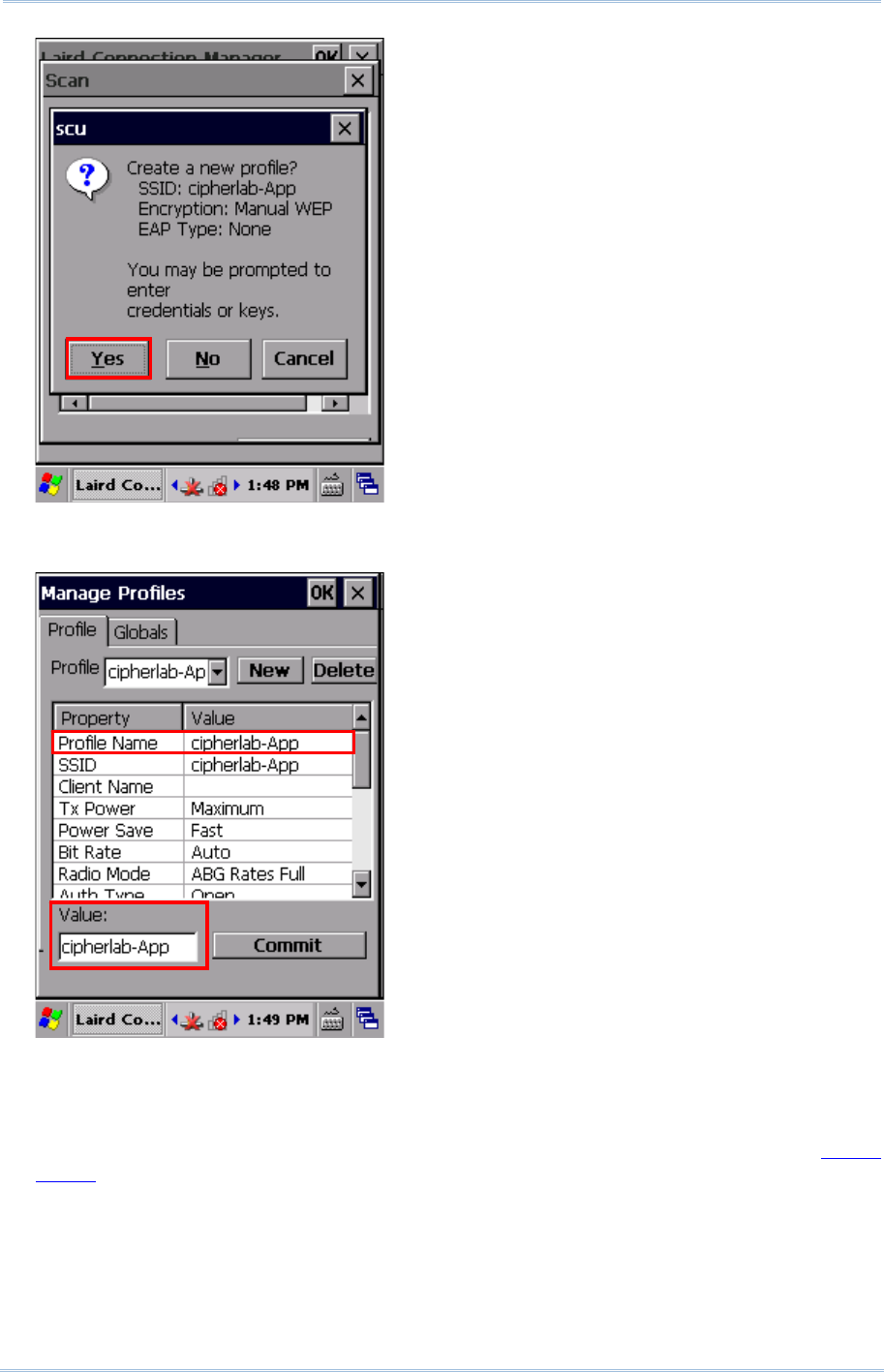
77
Chapte
r
3 Radios
5) A profile settings page opens showing detailed radio settings. Tap each item and adjust
its Value to suit your needs.
6) When finished fine-tuning all settings, tap Commit to save the profile.
7) Tap OK on the title bar to close the Profile Settings page and return to Configuration
settings.
If you would like to directly activate the newly created profile, select it as the Active
Profile on the Configuration settings page.
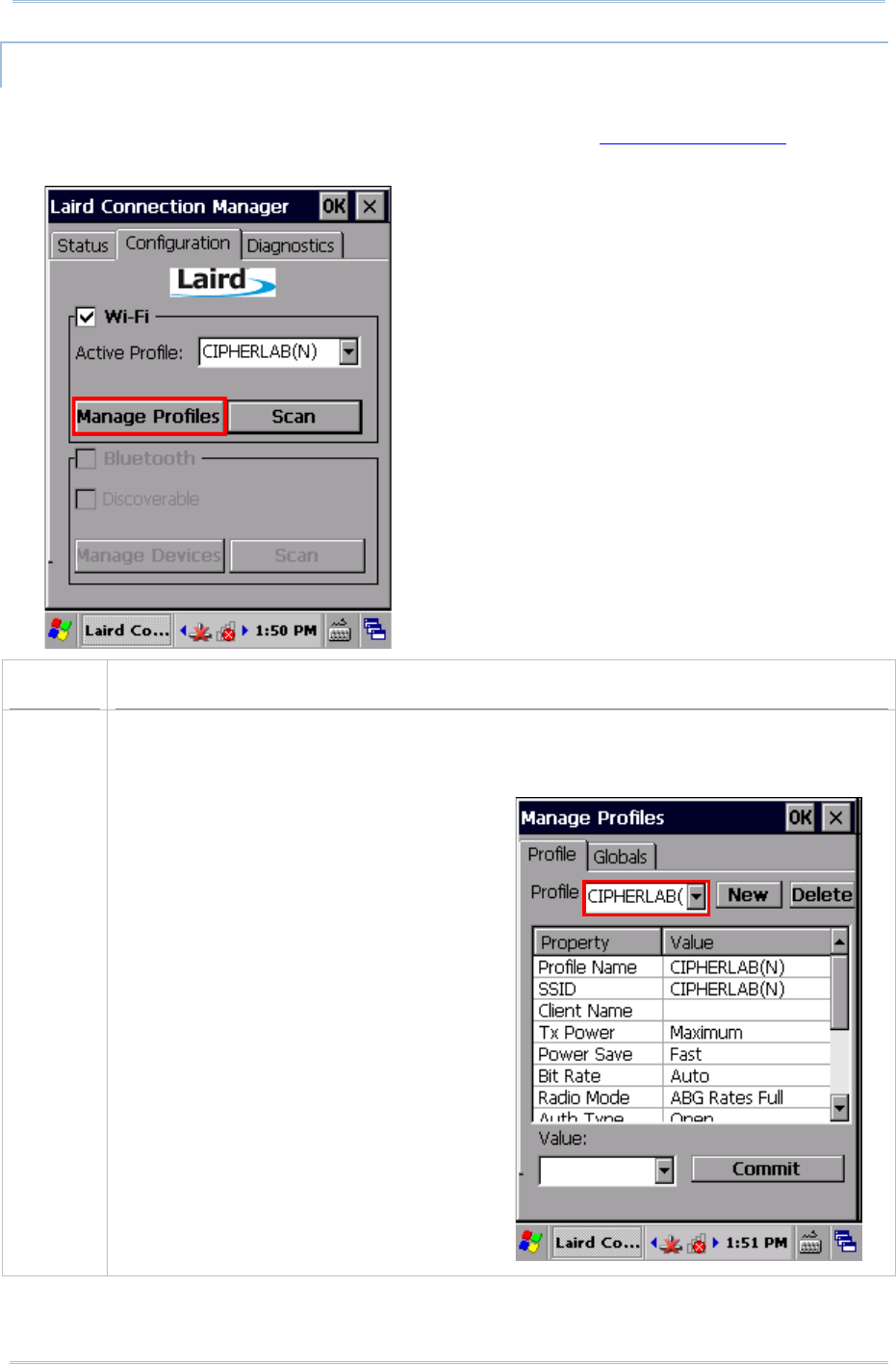
78
9700 Mobile Computer (CE) Reference Manual
MANAGE WI-FI PROFILE
To manage your profiles:
1) Open SCU’s Configuration tabbed page as described in Create Wi-Fi Profile.
2) Tap Manage Profiles to open the Profile settings page.
Item Description
Profile When SCU is first launched, “Default” is the active profile. Unless it is modified, this profile
does not specify an SSID, EAP type or encryption method. You can chose to do the
following:
Modify the default profile
Tap New to add a new profile
Select an existing profile from the
drop-down menu and configure
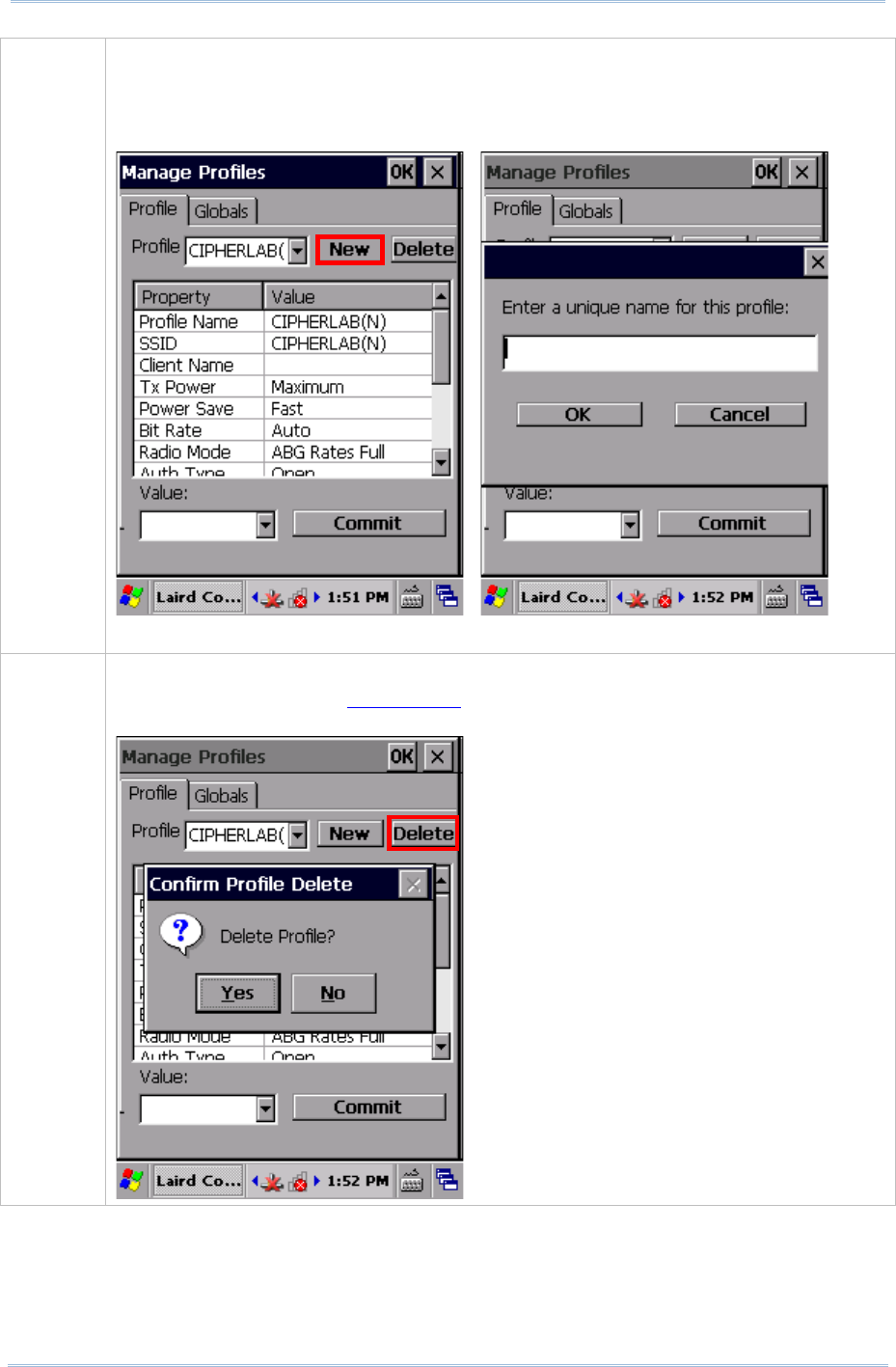
79
Chapte
r
3 Radios
New Tap New and enter a unique name for the profile. Configure the Radio settings,
Encryption, EAP Type, and other settings for this new profile.
The name for each profile must be unique
You can define up to 20 profiles
Delete Select a profile from the drop-down menu and tap Delete.
You cannot delete the Active Profile. Make sure the selected profile is not the active
profile under Configuration tabbed page.
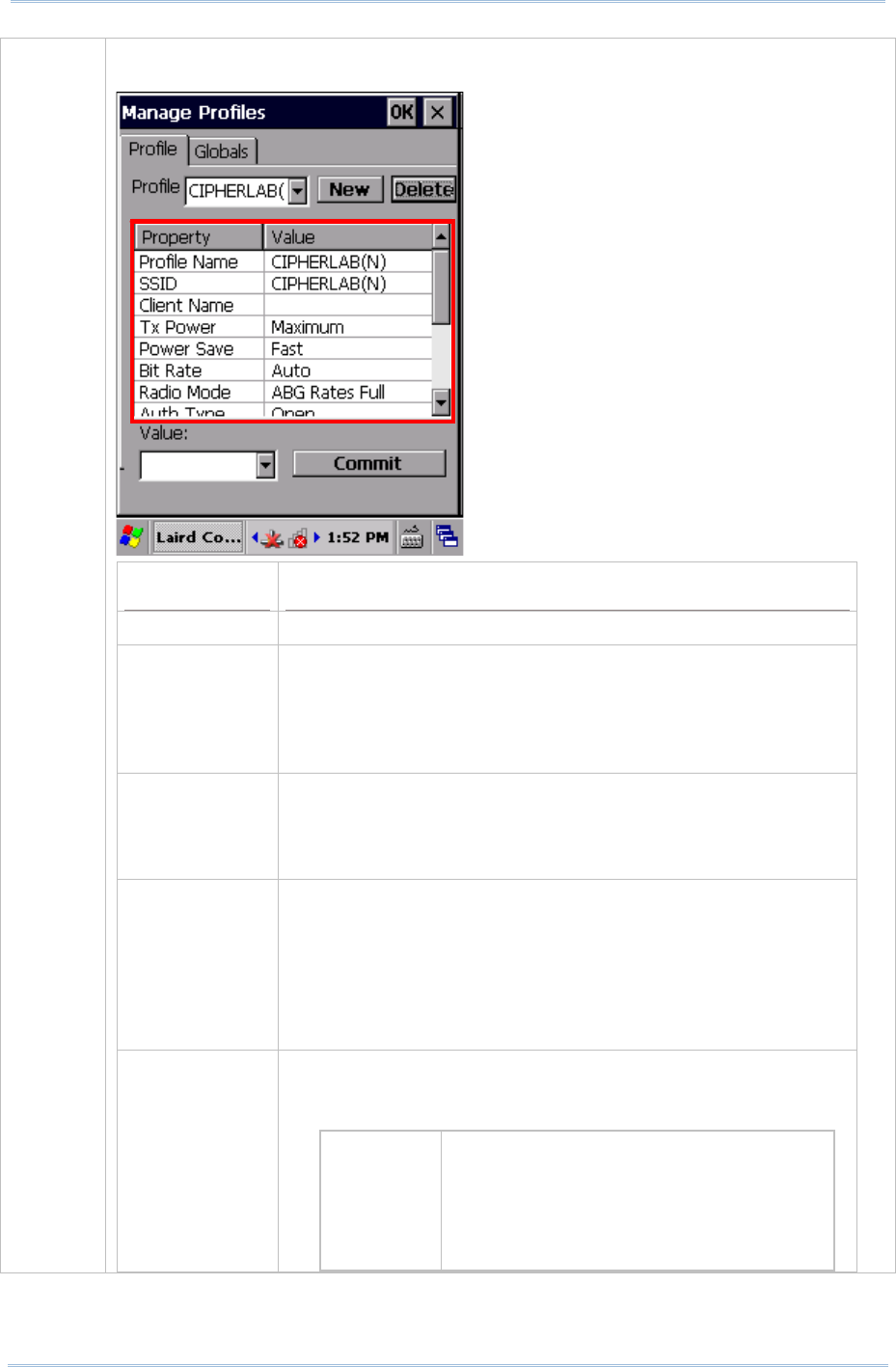
80
9700 Mobile Computer (CE) Reference Manual
Radio
Settings After selecting a profile in the Profile drop-down bar, configure radio settings in the
scrollable menu below.
Property Description
Profile Name Tap to rename the selected profile. Up to 32 characters allowed.
SSID Service Set Identifier (SSID) for the WLAN infrastructure to
which the radio will connect. If no SSID is specified, the radio will
only associate to an access point that broadcasts its SSID.
Value: A string of up to 32 characters
Default: None
Client Name Name assigned to the mobile computer with Summit radio
installed.
Value: A string of up to 16 characters
Default: None
Tx Power The power of the radio in milliwats (mW). In certain cases this
value will be overwritten by the access point, which will dictate to
the radio which power to use.
Value: Maximum (Maximum power defined for the current
regulatory domain) or a specified percentage 75%, 50%,
25%, 10%
Default: Maximum
Power Save Power save mode for the radio. Set the radio to its optimum
power-consumption setting.
Value:
CAM Constantly Awake Mode (CAM) keeps the
radio powered up continuously so there is
minimal lag in message response time.
This mode consumes the most power but
offers the highest throughput. It is
recommended when AC power is in use.

81
Chapte
r
3 Radios
Maximum In Max Power Savings (Max PSP) mode, the
access point buffers incoming messages for
the radio, which wakes up periodically and
connects to the access point to see if any
buffered messages are waiting. The radio
requests buffered messages and then goes
back to sleep. It conserves the most power
but offers the lowest throughput. It is
recommended when battery power is in
use.
Fast Power Save Mode (Fast PSP) switches
between the two modes described above,
depending on network traffic. This mode
switches to CAM when retrieving a large
number of packets and switches back to
PSP (= Power Save Polling) after the
packets have been retrieved. It is
recommended when power consumption is
a concern but you need greater throughput
than that allowed by Max PSP.
Default: Fast
Bit Rate The measurement of how much data is transmitted in a given
amount of time from one location to another.
Value: Auto (rate is negotiated automatically with the AP)
Default: Auto
Radio Mode Use of 802.11a/b/g/n frequencies and data rates when
interacting with an AP, or the use of ad hoc to associate to a
station radio.
Value: B rates only, BG rates full, G rates only, BG LRS, A
rates only, ABG rates full, BGA rates full, Ad Hoc
B rates
only 1, 2, 5.5, and 11 Mbps.
BG rates
full All B and G rates, plus N rates if supported.
G rates
only 6, 9, 12, 18, 24, 36, 48, and 54 Mbps.
BG LRS 1, 2, 5.5, 6, 11, 24, 36, and 54 Mbps. This
should only be used with Cisco APs running
IOS in autonomous mode (without
controllers).
A rates
only 6, 9, 12, 18, 24, 36, 48, and 54 Mbps, plus
N rates if supported.
ABG rates
full All A rates and all B and G rates, with A
rates (the 802.11a radio) preferred, plus N
if supported.
BGA rates
full All B and G rates and all A rates, with B and
G rates (the .11g radio) preferred, plus N
rates if supported.

82
9700 Mobile Computer (CE) Reference Manual
Ad Hoc When selected, the Summit radio
associates to another station radio that is
in ad hoc mode and has the same SSID
and, if configured, static WEP key.
Default: ABG rates full
Auth Type 802.11 authentication type used when associating to an AP.
Value: Open, Shared (shared-key), LEAP (Network-EAP)
Default: Open
It is recommended that the default setting Open is selected.
WPA WPA and WPA2 support the same authentication methods and
similar key management methods; the difference is mainly in
area of encryption. WPA defines TKIP as the primary encryption
method, while WPA2 defines AES-CCMP as the primary
encryption method.
Value: None, WPA, WPA2
Default: None
Encryption This specifies the type of key used to encrypt and decrypt
transmitted data, and how that key is specified or derived. Select
Encryption type in the Value drop-down box.
Item Description
None N/A
TKIP The encryption method defined with WPA.
TKIP uses RC4 encryption as does WEP.
AES-CCMP The encryption method defined with IEEE
802.11i and certified with WPA2. AES-CCMP is
stronger than RC4
WEP The encryption method defined with the
original IEEE 802.11 standards; encrypts
transmitted data using 64-bit or 128-bit
encryption.
CKIP CKIP is supported for use only with static WEP.
For CKIP, encryption keys need to be defined
in SCU; for CKIP-EAP, encryption keys are
derived dynamically from an EAP
authentication.
Authentication This is the protocol used to authenticate the device and its user if
the WLAN uses the Enterprise version of Wi-Fi Protected Access
(WPA) and WPA2. Select Authentication type in the Value
drop-down box, then enter the credentials necessary for each
type in the appeared fields.
Item Description
None N/A
LEAP Credentials values for LEAP:
User Name (up to 64 characters)
Password (up to 32 characters)
EAP-FAST Credentials values for EAP-FAST
User Name (up to 64 characters)
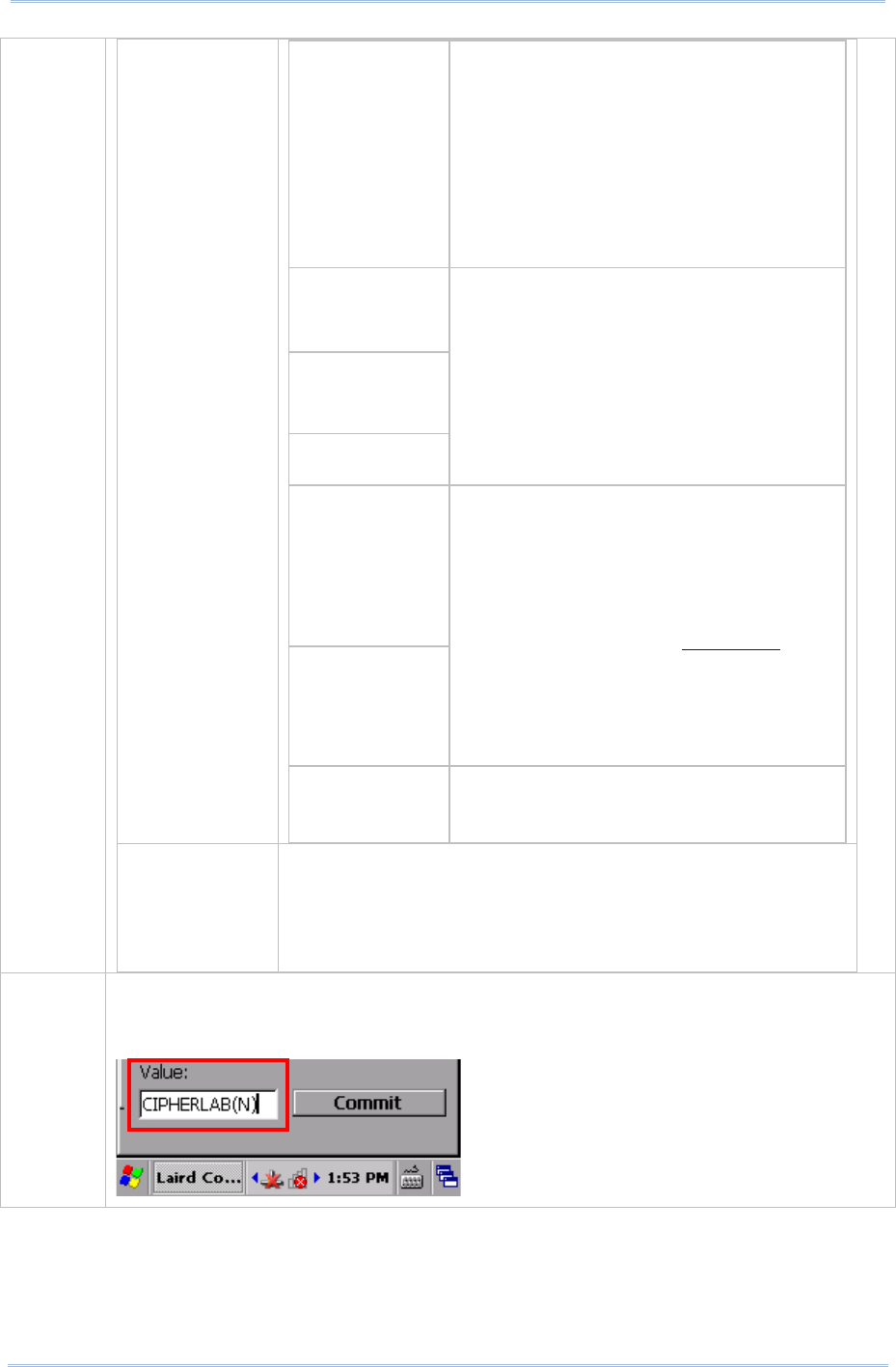
83
Chapte
r
3 Radios
Password (up to 32 characters)
PAC Filename (up to 32 characters):
You may create a protected access
credential (PAC) for each client device.
When creating a PAC manually, you
must store it in the directory identified
in Certs Path on the Globals settings
page. To use automatic provisioning,
leave this field blank.
PAC Password (up to 32 characters)
PEAP-MSCHAP
PEAP-GTC
EAP-TTLS
Credentials values for PEAP-MSCHAP,
PEAP-GTC, EAP-TTLS:
User Name (up to 64 characters)
Password (up to 32 characters)
CA Cert: Filename and extension of root
certificate authority (CA) digital
certificate (up to 32 characters).
Specify the Certs Path in Globals
settings page > Certs Path.
EAP-TLS
PEAP-TLS
Credentials values for EAP-TLS and
PEAP-TLS:
User: Username or Domain/Username
(up to 64 characters)
User Cert: Filename and extension of
user certificate residing in the Microsoft
certificate store. See Certificates.
CA Cert: Filename and extension of root
certificate authority (CA) digital
certificate (up to 32 characters).
Specify the Certs Path in Globals
settings page > Certs Path.
PSK Pre-shared keys (PSK) consist of up to 256
bits entered as a string of up to 64
hexadecimal digits.
Fast Reauth The expedited WPA key handshake used to reduce roaming time
to 125 msec or less. Available for WPA TKIP and WPA2
AES-CCMP.
Value: None, CCKM
Default: None
Value Use this box to change the value of a selected item. Depending on the item property, this
can be done by choosing a value from a drop-down list, or entering the desired value with
the on-screen or physical keypad.
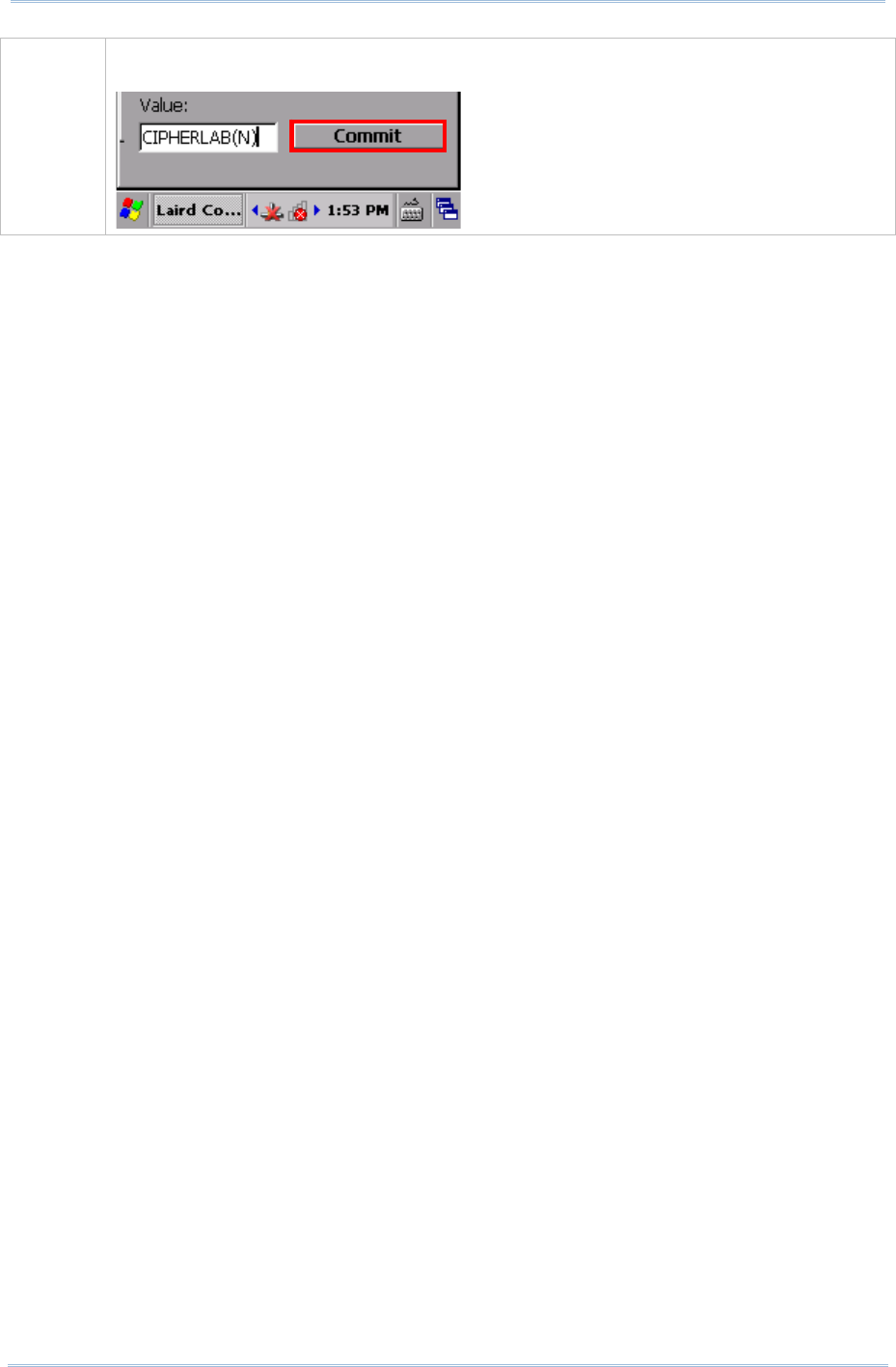
84
9700 Mobile Computer (CE) Reference Manual
Commit After making any changes on the Profile tabbed page, the Commit button must be
tapped in order for the settings to take effect.
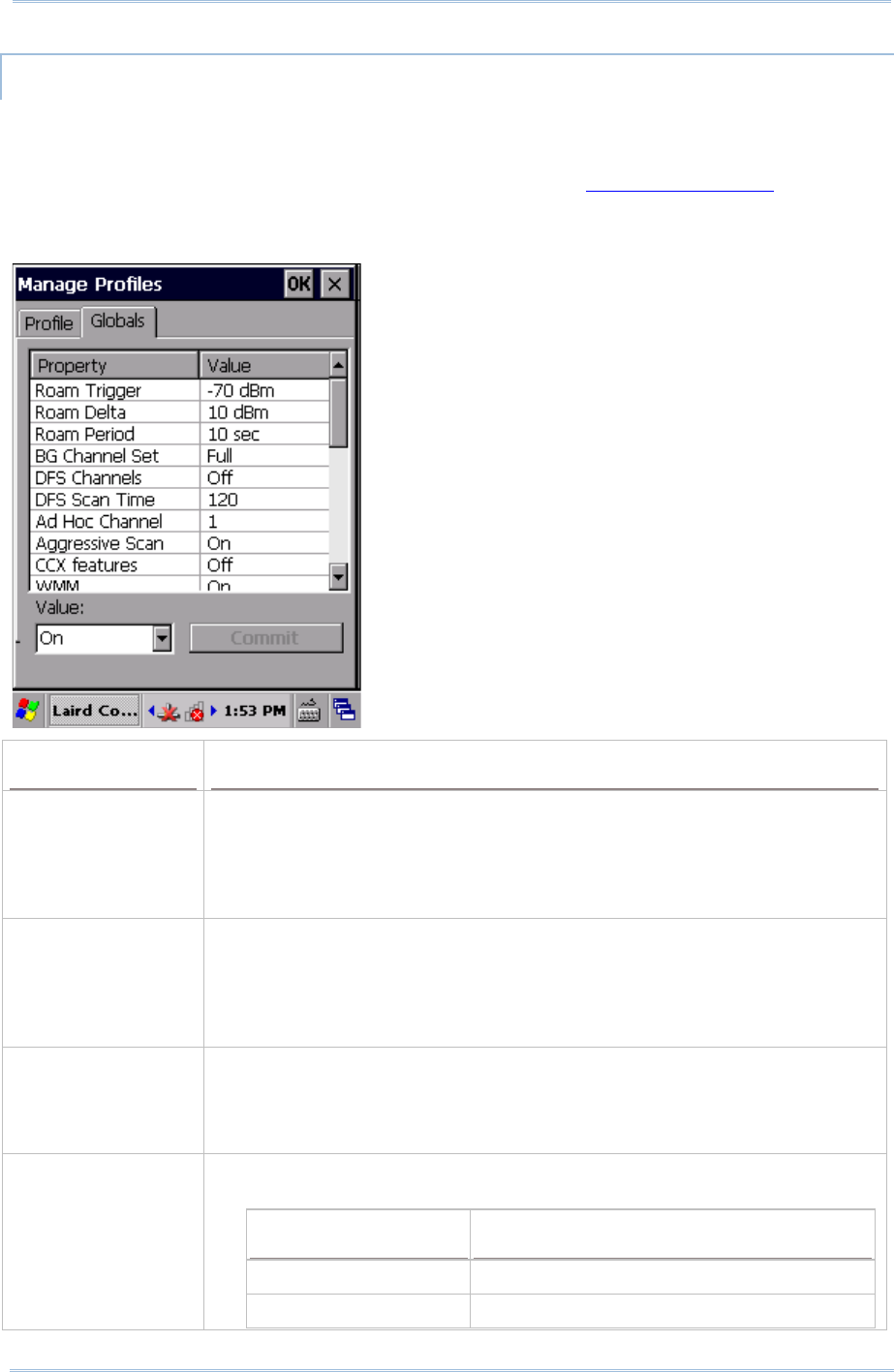
85
Chapte
r
3 Radios
MANAGE GLOBAL SETTINGS
Global settings include radio and security settings that apply to all profiles in SCU.
To open the Global settings page:
1) Open SCU’s Configuration tabbed page as described in Create Wi-Fi Profile.
2) Tap Manage Profiles to open the Profile settings page.
3) Tap the Globals tab to open the Global settings page.
Property Value
Roam Trigger When the moving average RSSI from the current AP is weaker than Roam
Trigger, radio does a roam scan where it probes for an AP with a signal that
is at least Roam Delta dBm stronger.
Value (dBm): -50, -55, -60, -65, -70, -75, -80, -85, -90, Custom
Default: -70 dBm
Roam Delta When Roam Trigger is met, a second AP’s signal strength (RSSI) must be
Roam Delta dBm stronger than the moving average RSSI for the current AP
before radio will attempt to roam to the second AP.
Value (dBm): 5, 10, 15, 20, 25, 30, 35
Default: 10 dBm
Roam Period After association or roam scan (with no roam), radio will collect RSSI scan
data from Roam Period seconds before considering roaming.
Value (sec): 5, 10, 15, 20, 25, 30, 35, 40, 45, 50, 55, 60, Custom
Default: 10 (seconds)
BG Channel Set Defines the 2.4 GHz channels to be scanned when the radio is contemplating
a roam and needs to determine what APs are available.
Item Description
Full All channels
1, 6, 11 The most commonly used 2.4 GHz channels

86
9700 Mobile Computer (CE) Reference Manual
1, 7, 13 For ETSI and TELEC radios only
Custom Indicates the system registry has been edited
to include a value other than those available
in the drop-down value
Default: Full
DFS Channels Indicates whether to support 5 GHz (802.11a) channels where dynamic
frequency selection (DFS) is required.
Value: On, Off
Default: Off
DFS Scan Time Enables determining the dwell (listen) time when passively scanning on a
DFS channel.
Valid range of 20-500 ms configurable
Default: 120
When the DFS Scan Time is changed to a value lower than default, it is
recommended that the beacon period in the WLAN infrastructure is
changed as well. Ideally, the dwell time should be 1.5 times than that of
the beacon period.
Ad Hoc Channel The channel to be used for an ad hoc connection if the active profile has a
Radio Mode value of “Ad Hoc”.
Value:
1~14 One of the 2.4 GHz channels
36, 40, 44, 48 UNII-1 channels
Default: 1
If a channel that is not supported is selected, then SCU will automatically
apply the default channel setting (1).
Aggressive Scan Aggressive scanning complements and works in conjunction with the
standard scanning that is configured through the Roam Trigger, Roam Delta,
and Roam Period settings. It is recommended that aggressive scanning is
enabled unless there is significant co-channel interference because of
overlapping coverage from APs that are on the same channel.
Value: On, Off
Default: On
CCX features Whether to allow the use of Cisco information element (IE) and CCX version
number to authorize support for CCX features.
Value: Full, Off
Full mode uses Cisco IE and CCX version number and enables support for all
CCX features. Off mode disables all support for Cisco IE and CCX version
number.
Default: N/A
If the radio fails to connect to an 802.11n wireless network, set CCX
features as “Off” and try again.
WMM Whether to allow the use of Wi-Fi Multimedia (WMM) Extensions or not.
Value: On, Off
Default: Off
Changing this setting requires suspend/resume of the mobile computer
to take effect.
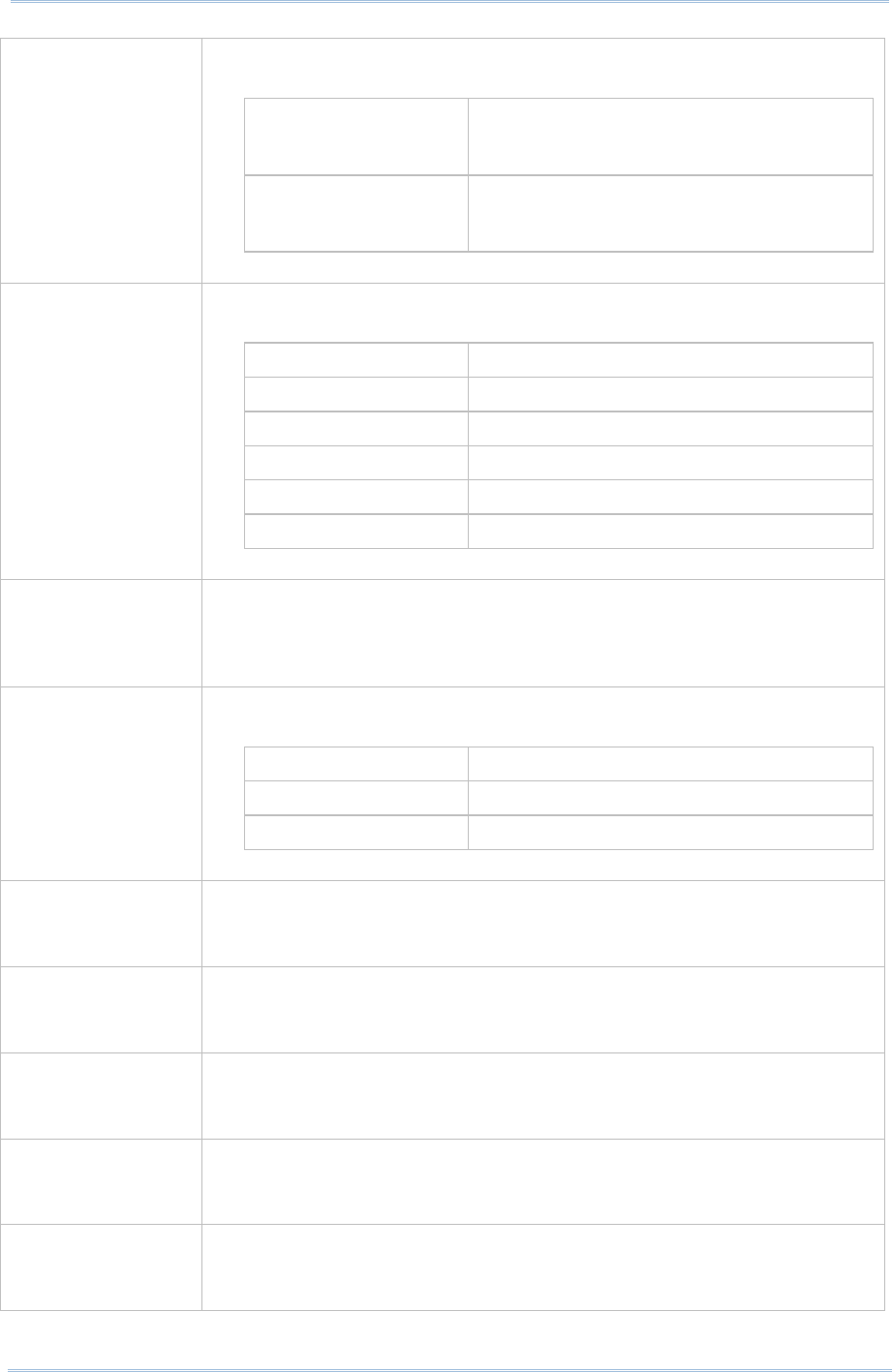
87
Chapte
r
3 Radios
Auth Server Type of authentication server being used for EAP authentication.
Value:
Type 1 Cisco Secure ACS or another server that uses
PEAPv1 for PEAP with EAP-MSCHAPV2
(PEAP-MSCHAP)
Type 2 A different authentication server, such as
Juniper Networks Steel Belted RADIUS, that
uses PEAPv0 for PEAP-MSCHAP
Default: Type 1
TTLS Inner Method Authentication method used within secure tunnel created by EAP-TTLS.
Value:
Auto-EAP Any available EAP method
MSCHAPV2
MSCHAP
PAP
CHAP
EAP-MSCHAPV2
Default: Auto-EAP
PMK Caching The type of Pairwise Master Key (PMK) caching to use with a WPA2
encryption type (alternative to WPA2 CCKM).
Value: Standard or OPMK (opportunistic PMK)
Default: Standard
TX Diversity How to handle antenna diversity when transmitting data to AP.
Value:
Main Only Use main antenna only
Aux Only Use auxiliary antenna only
On Use diversity
Default: On
RX Diversity How to handle antenna diversity when receiving data from AP.
Default: On-start on Main
This is a fixed setting; on startup, the main antenna is always used
Frag Thresh When packet size exceeds the set threshold, it becomes fragmented.
Value: 256 ~ 2346
Default: 2346 (bytes)
RTS Thresh When packet size exceeds the set threshold, RTS/CTS is required on link.
Value: 0 ~ 2347
Default: 2347 (bytes)
LED Indicates whether or not an LED is used.
Value: On, Off
Default: Off
Tray Icon Whether to enable the system tray icon or not.
Value: On, Off
Default: On

88
9700 Mobile Computer (CE) Reference Manual
Admin Password N/A
Auth Timeout (s) Specifies how long it will wait for an EAP authentication request to succeed or
fail. If authentication credentials are specified in the active profile and the
authentication times out, then association will fail. If authentication
credentials are not specified in the active profile and the authentication times
out, then the user will be required to enter credentials again.
Value: 3 ~ 60
Default: 8 (seconds)
Certs path File path where the certificate for EAP authentication is stored.
Value: A valid directory path of up to 64 characters
Default: Depends on device
Supplicant The user (client) making a request to gain access to system resources
through the authentication server.
Value: Summit, Third Party
Default: Summit
Auto Profile Activate or deactivate automatic profile selection.
Value: On, Off
Default: Off
When On is selected, proceed to the Profile settings page and select from
the existing profiles those which you would like to add to the Auto Profile
list. The number of profiles in this list is limited to 19.
When Auto Profile is activated, the Summit radio will attempt to
associate to an access point after a device startup or resume, and it will
try out each listed profile in order until the radio associates to an access
point. The successful profile becomes the active profile and remains
active until one of the following occurs:
The device goes through suspension and resume, power-cycling, or
restart, which causes the radio to go through the automatic profile
selection process once more.
Auto Profile is turned off and an active profile is manually selected on the
SCU Configuration tab.
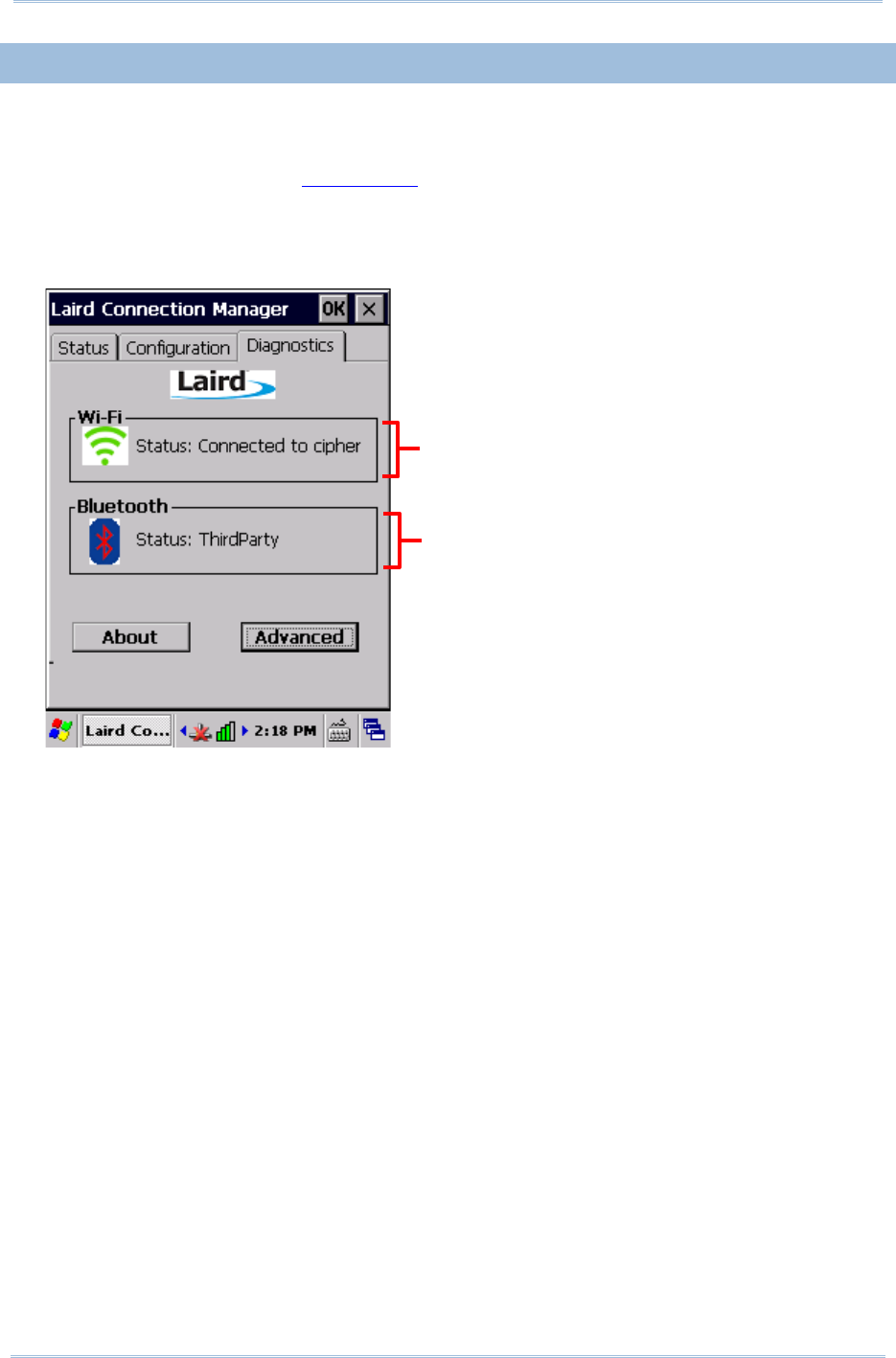
89
Chapte
r
3 Radios
3.1.5. DIAGNOSTICS TABBED PAGE
Perform diagnostic tests to troubleshoot connection issues when necessary.
To open the Diagnostics page:
1) Open SCU as described inʳLaunch SCU.
2) Tap the Diagnostics tab to show the Diagnostics page.
Diagnostics status for Wi-Fi and Bluetooth shows, along with on-screen buttons to open
Advanced settings and view software version information.
Wi-Fi diagnostics status
Bluetooth diagnostics status
(service not available now)
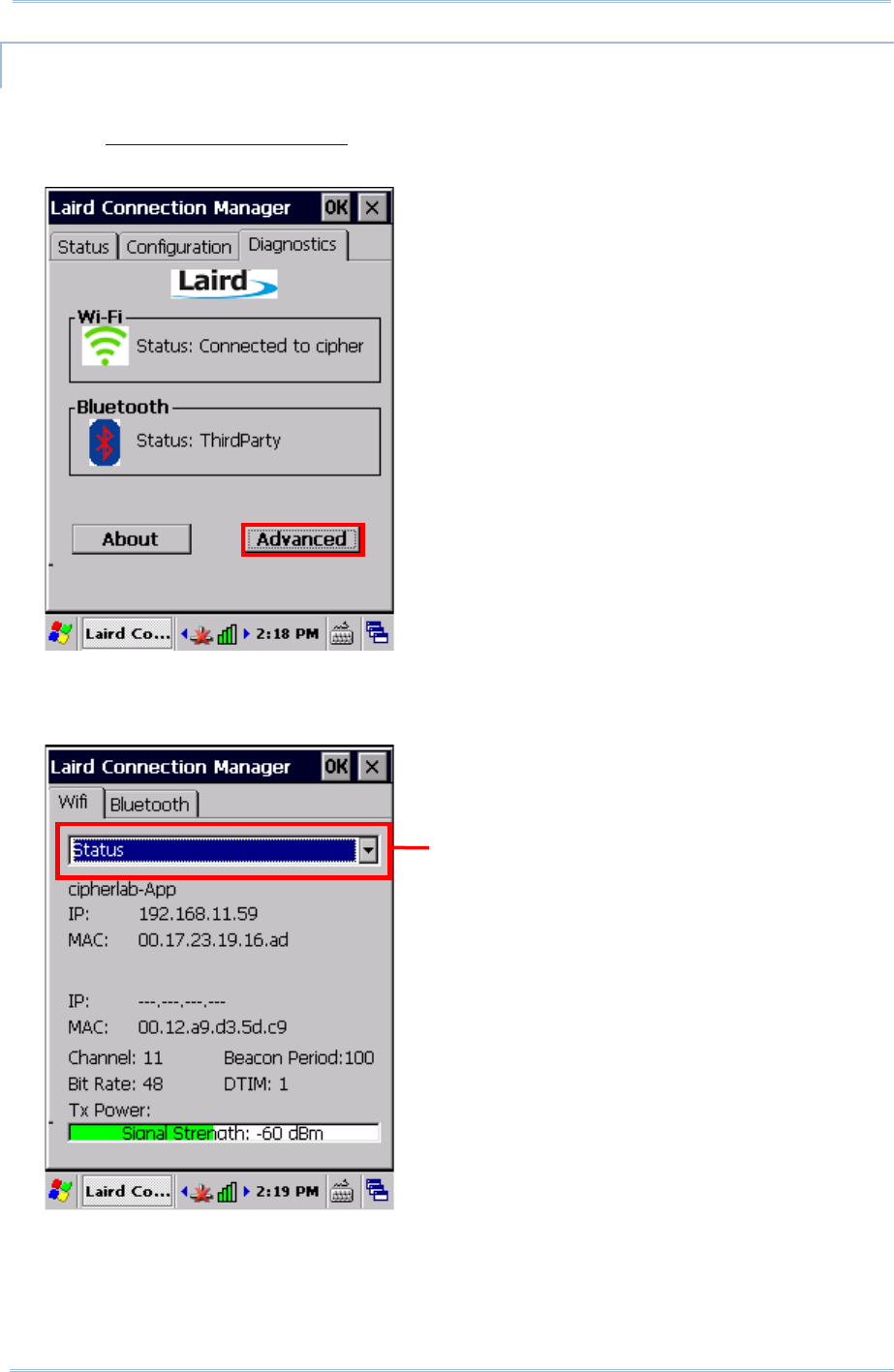
90
9700 Mobile Computer (CE) Reference Manual
ADVANCED DIAGNOSTICS
To access Advanced diagnostics settings:
1) Open Diagnostics Tabbed Page.
2) Tap the Advanced button to open advanced diagnostics settings.
CHECK STATUS
To check diagnostics status, select Status in the drop-down bar.
Select Status to check connection
details
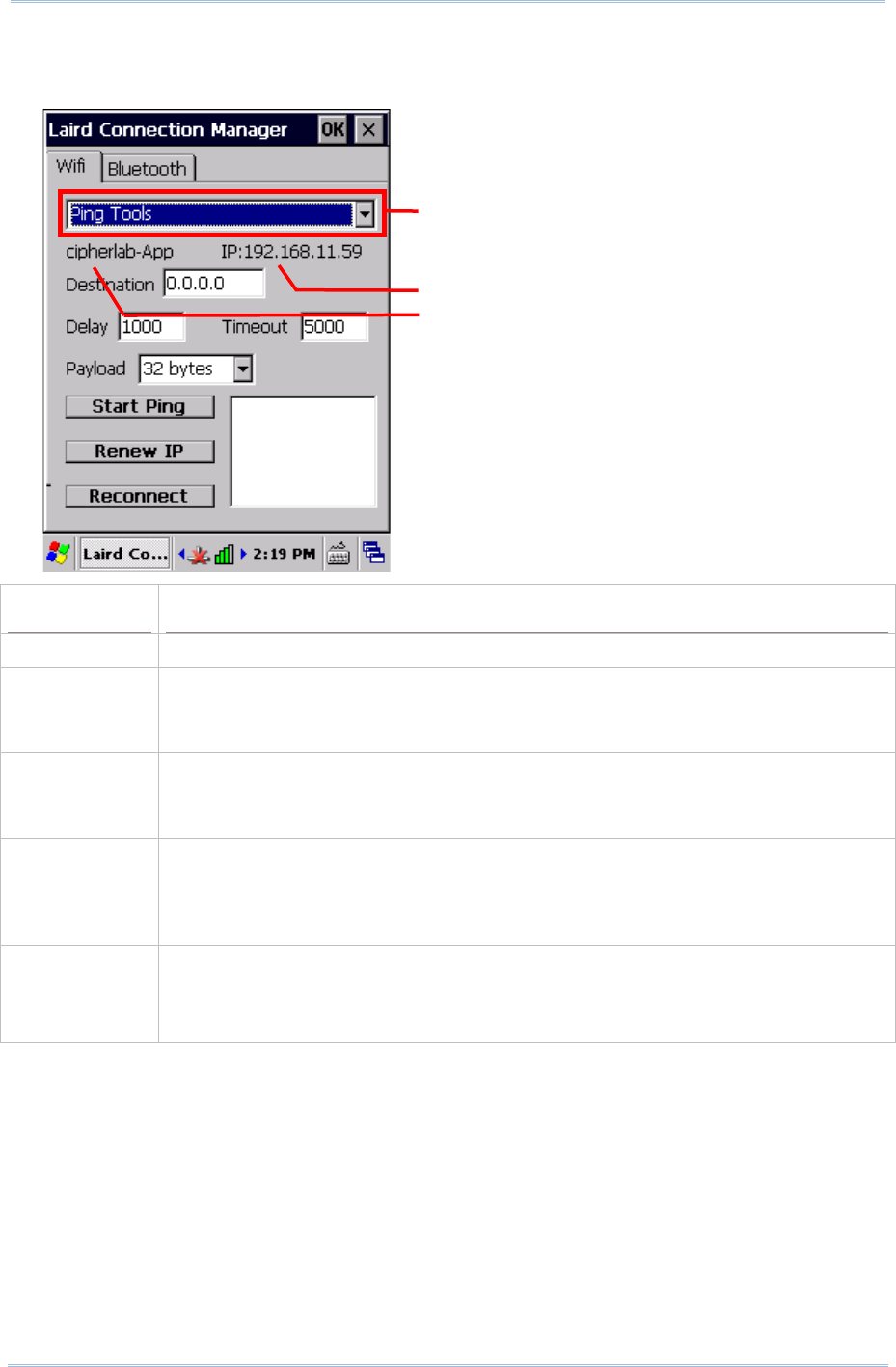
91
Chapte
r
3 Radios
USE PING TOOLS
To perform ping tests, select Ping Tools in the drop-down bar.
Item Description
Destination Enter the address to ping.
Ping Payload The amount of data to be transmitted on a ping.
Value: 32, 64, 128, 256, 512, 1024
Default: 32 (bytes)
Ping Delay The amount of time that elapses between successive ping requests.
Value: 0~7200000
Default: 1000 (milliseconds)
Timeout ms The amount of time that elapses without a response before ping request is
considered a failure.
Value: 0~30000
Default: 5000 (milliseconds)
Start Ping Enter the address to ping to in the Destination field and tap Start Ping. A
continuous ping will begin until the following happens: Stop Ping is tapped, the,
the application is exited, or the radio is removed. Activity status will be logged in
the output box below.
Select Ping Tools to diagnose the
connection
Device IP address
AP Name
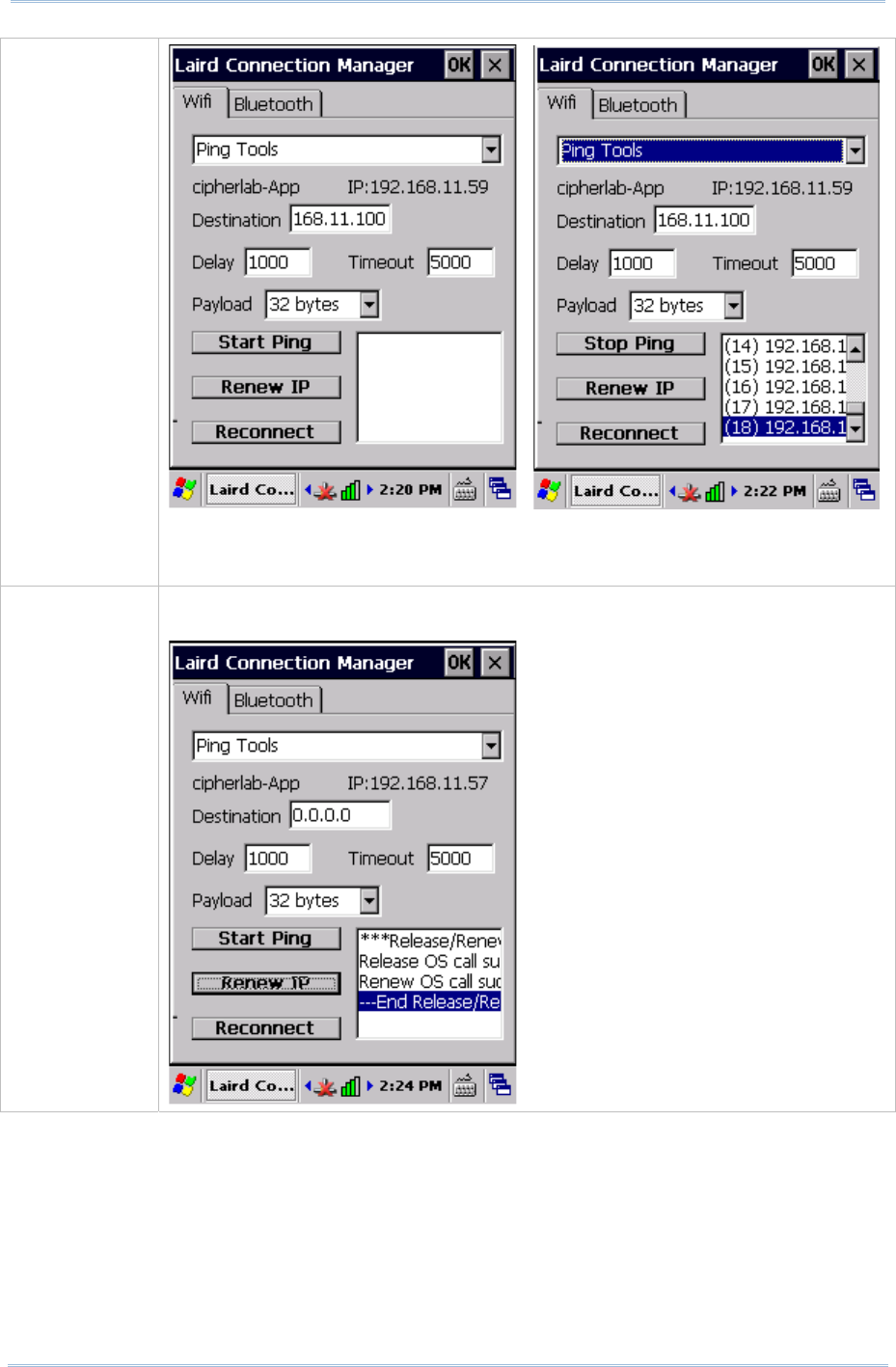
92
9700 Mobile Computer (CE) Reference Manual
When an active ping is initiated, the screen displays a ping indicator that blinks in
green (for a successful ping) or red (for an unsuccessful ping). The ping indicator is
hidden when the screen is switched to a tab other than Diags or Statusˁ
Release/Renew Obtain a new IP address through DHCP release/renew, and log all activity in the
output area at the bottom.
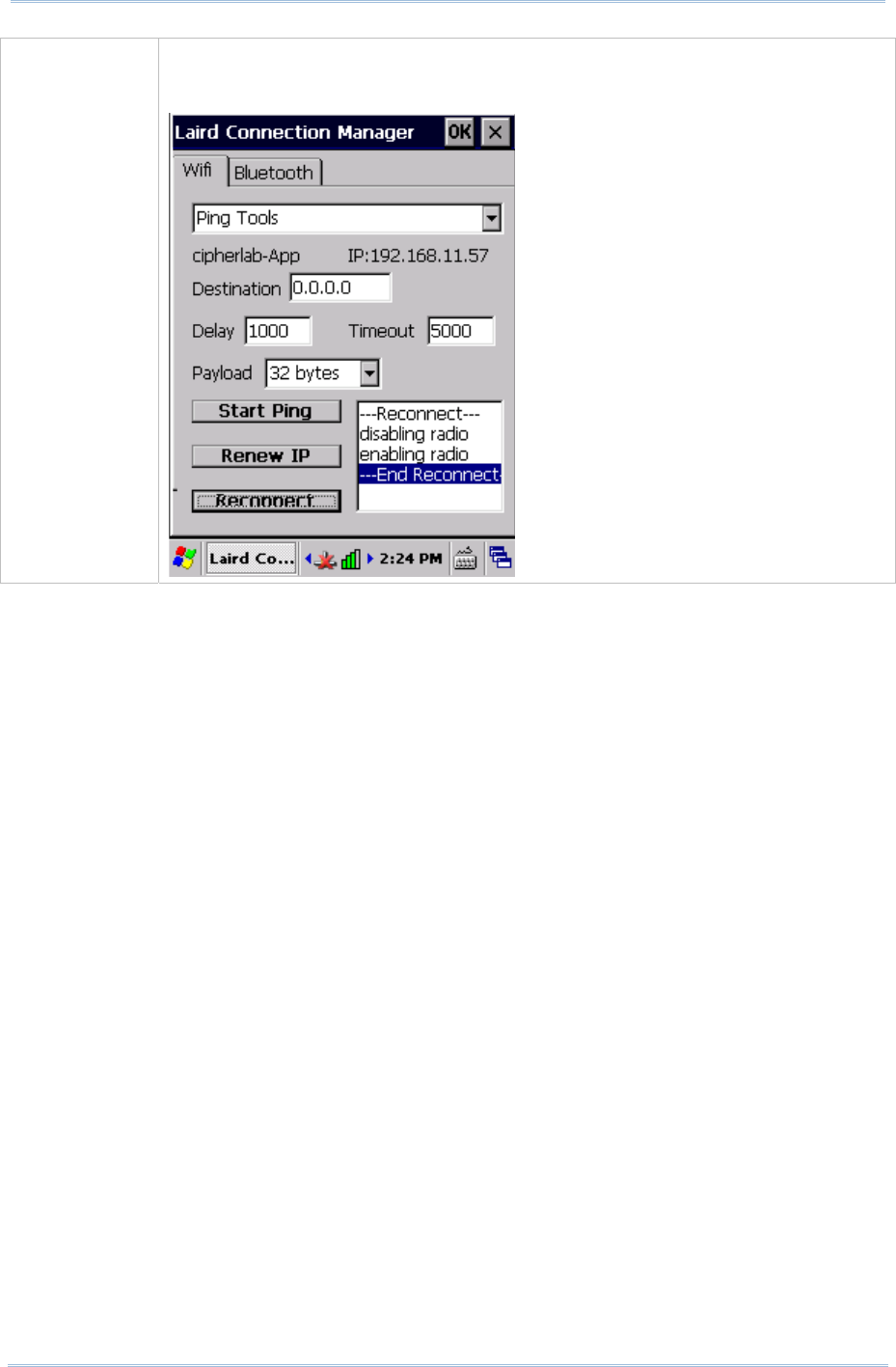
93
Chapte
r
3 Radios
Reconnect Disable and enable the radio, apply or re-apply the current profile, attempt to
associate and authenticate to the wireless network, and log all activity in the output
area at the bottom.
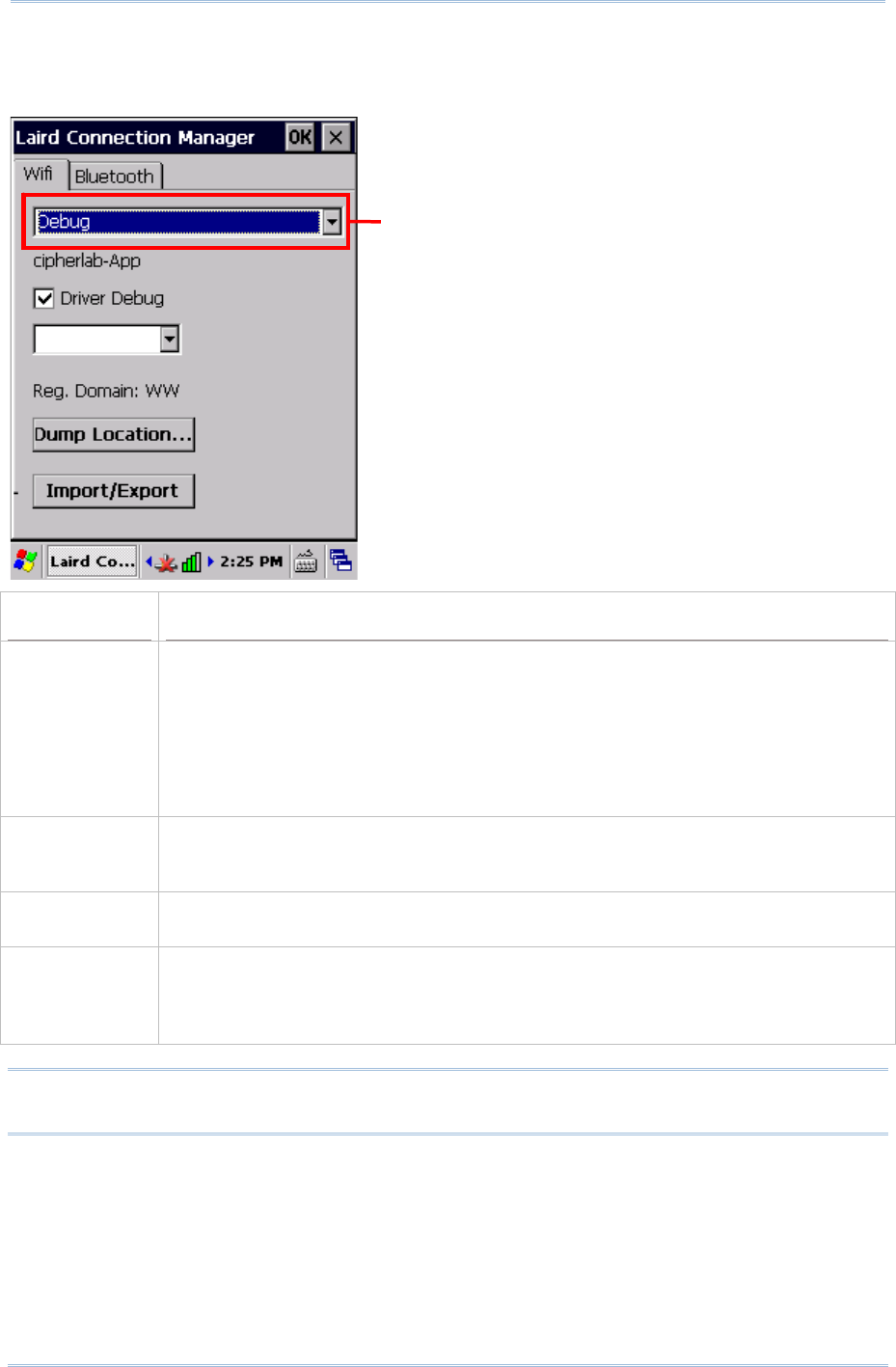
94
9700 Mobile Computer (CE) Reference Manual
USE DEBUG TOOLS
To check debug settings, select Debug in the drop-down bar.
Item Description
Driver Debug Select whether to debug the WLAN driver, and the output mode for driver debug.
Value: Not set, 1-Text(Low), 2-Text, 3-Text(High), 4-Serial(Low), 5-Serial,
6-Serial(High)
Default: Not set
When set as 1-Text(Low), 2-Text, or 3-Text(High), SCU will continue to export
debug logs to the mobile computer’s internal storage. Do not select any of
these options unless necessary.
Reg. Domain Indicates the regulatory domain or domains for which the radio is configured by
default. Default setting is “Worldwide”, which means that the radio can be used in
any domain.
Dump
Location… Dumps the diagnostics results to a desired location in the form of a .txt file.
Import/Export Imports/exports SCU settings as a profile (.sdc format). When exporting, you may
select to include Global Settings, Third Party Config settings or Profile Settings.
When importing, you may select to add to existing settings, or replace the set
values in Global Settings, Third Party Config and Profiles.
Note: It is recommended that Driver Debug output settings are kept as default and not
changed.
Select Debug to check debug
settings
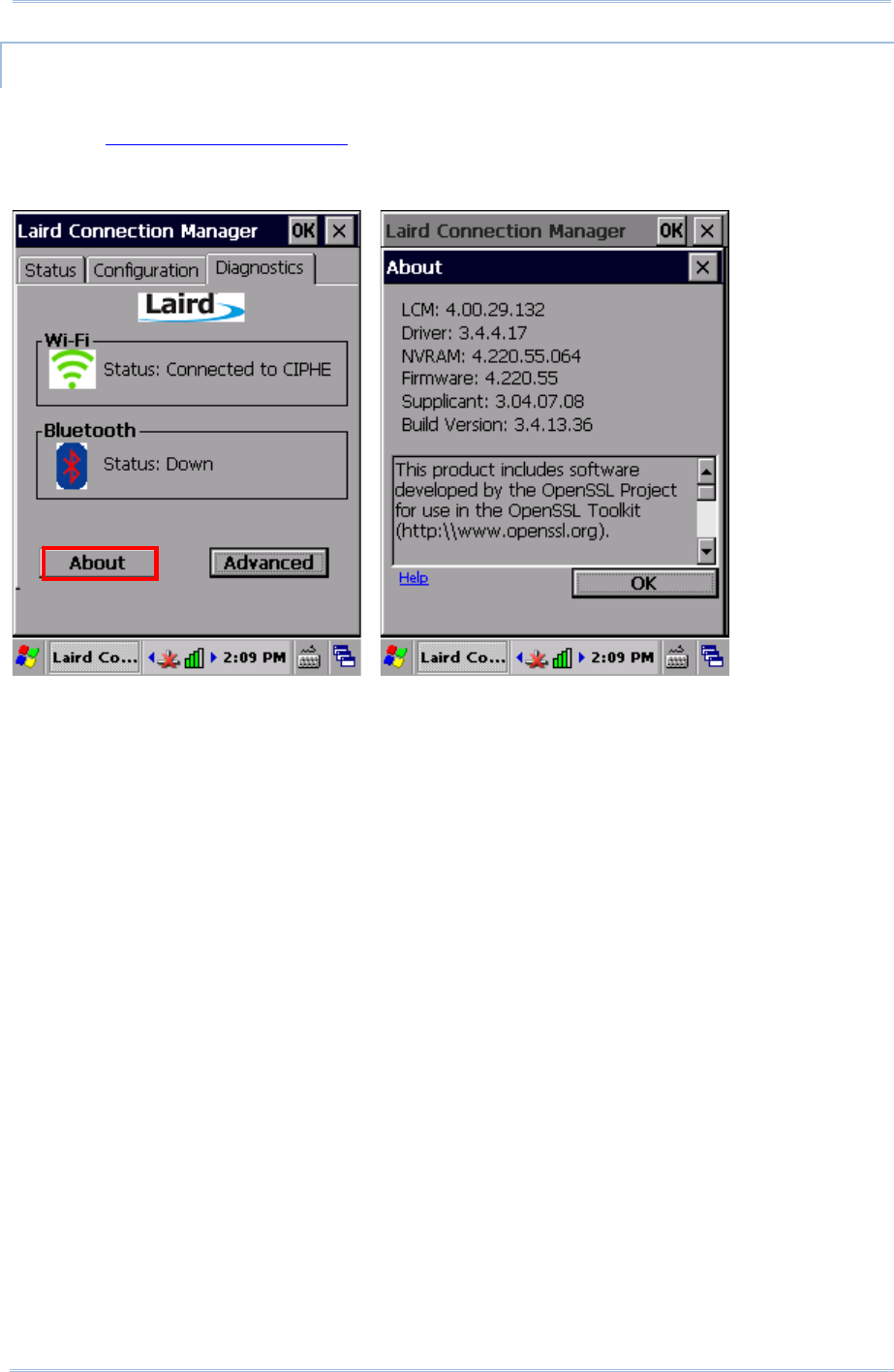
95
Chapte
r
3 Radios
SOFTWARE VERSION INFORMATION
To check software version information:
1) Open Diagnostics Tabbed Page.
2) Tap the About button to view information about SCU version, device driver, and
software developer.
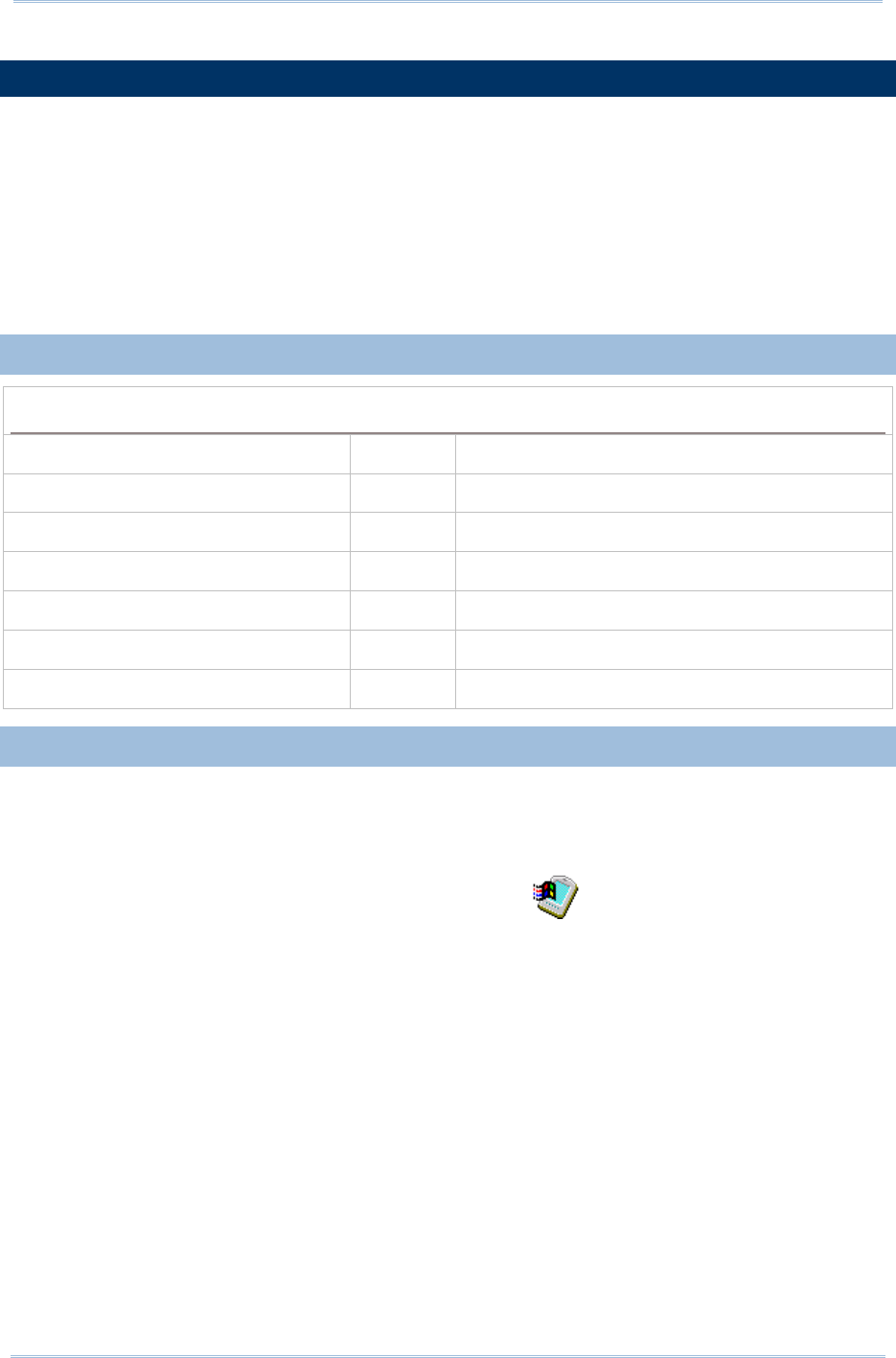
96
9700 Mobile Computer (CE) Reference Manual
3.2. USE BLUETOOTH
The mobile computer is Bluetooth-enabled to synchronize data with other devices such as
PCs, car hands-free kits, headsets, printers, PDAs, and cell phones.
Class II Bluetooth devices enable wireless connections over a short distance of around 10
meters. It is specified in IEEE 802.15.1 as a “wireless personal area network” (WPAN).
To connect a Bluetooth device for the first time, the mobile computer needs to “pair” with it.
Such “pairing” involves authentication between two devices to justify their accesses to each
other. After this initial pairing, the two devices can connect to each other without the need
of a second pairing procedure.
3.2.1. BLUETOOTH PROFILES SUPPORTED
Bluetooth Profiles Supported
Serial Port Profile (SPP) supports Server/Client
Object Push Profile (OPP) supports Server/Client
File Transfer Profile (FTP) supports Server/Client
Personal Area Networking Profile (PAN)
Human Interface Device Profile (HID) supports keyboard and mouse without cursor
Headset Profile (HSP)
Hands-Free Profile (HFP)
3.2.2. CHANGE BLUTOOTH NAME
By default, the mobile computer uses the device name for its Bluetooth name. Change the
device name to make it more recognizable.
To change the mobile computer’s device name:
1) Tap Start | Settings | Control Panel | System .
System Properties page opens showing General tabbed page.
2) Tap Device Name tab.
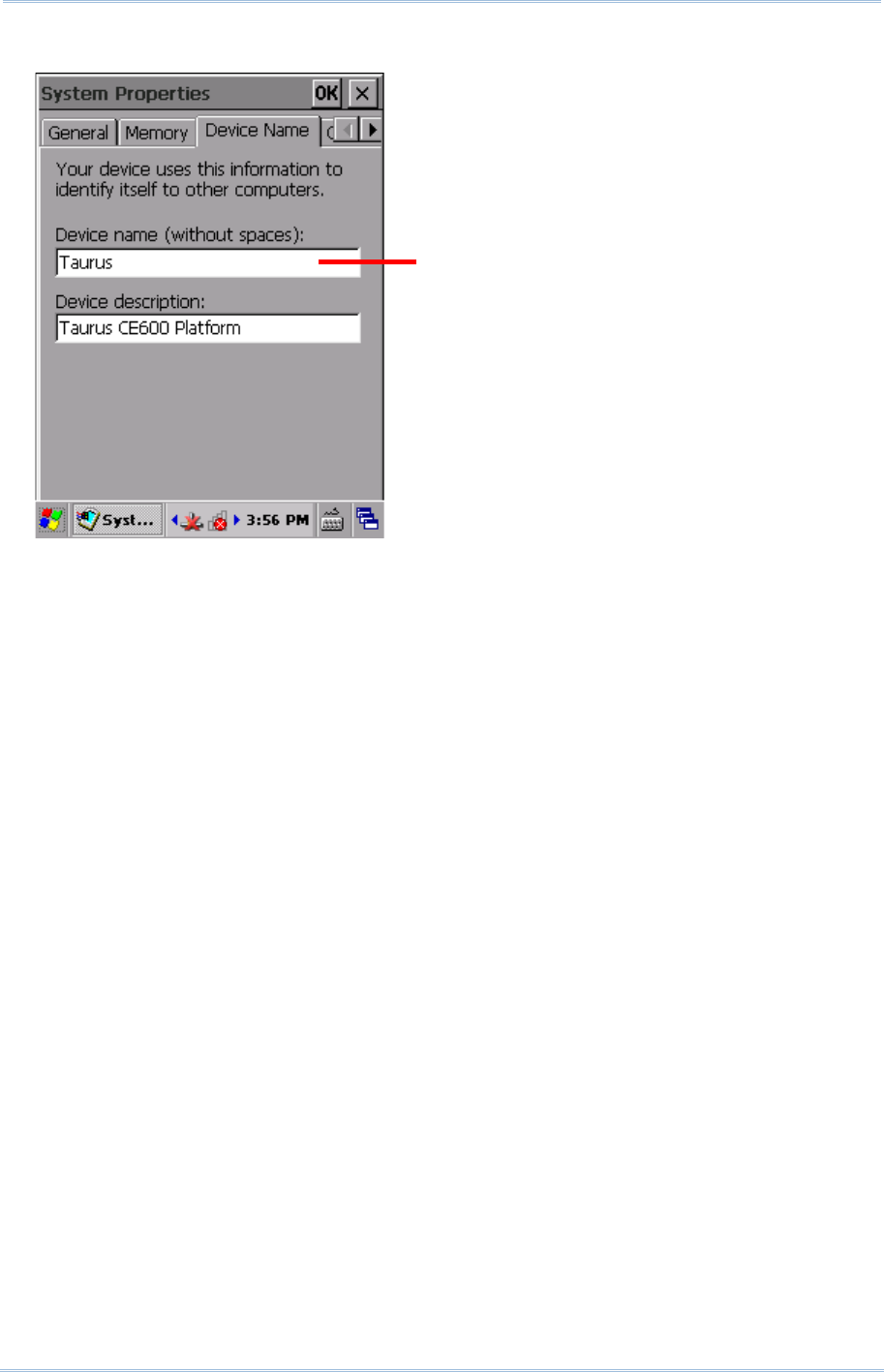
97
Chapte
r
3 Radios
Device ID tabbed page opens.
3) Enter a name of your choice.
4) Tap OK on the title bar to apply the change.
Change device name to make the mobile
computer more recognizable.
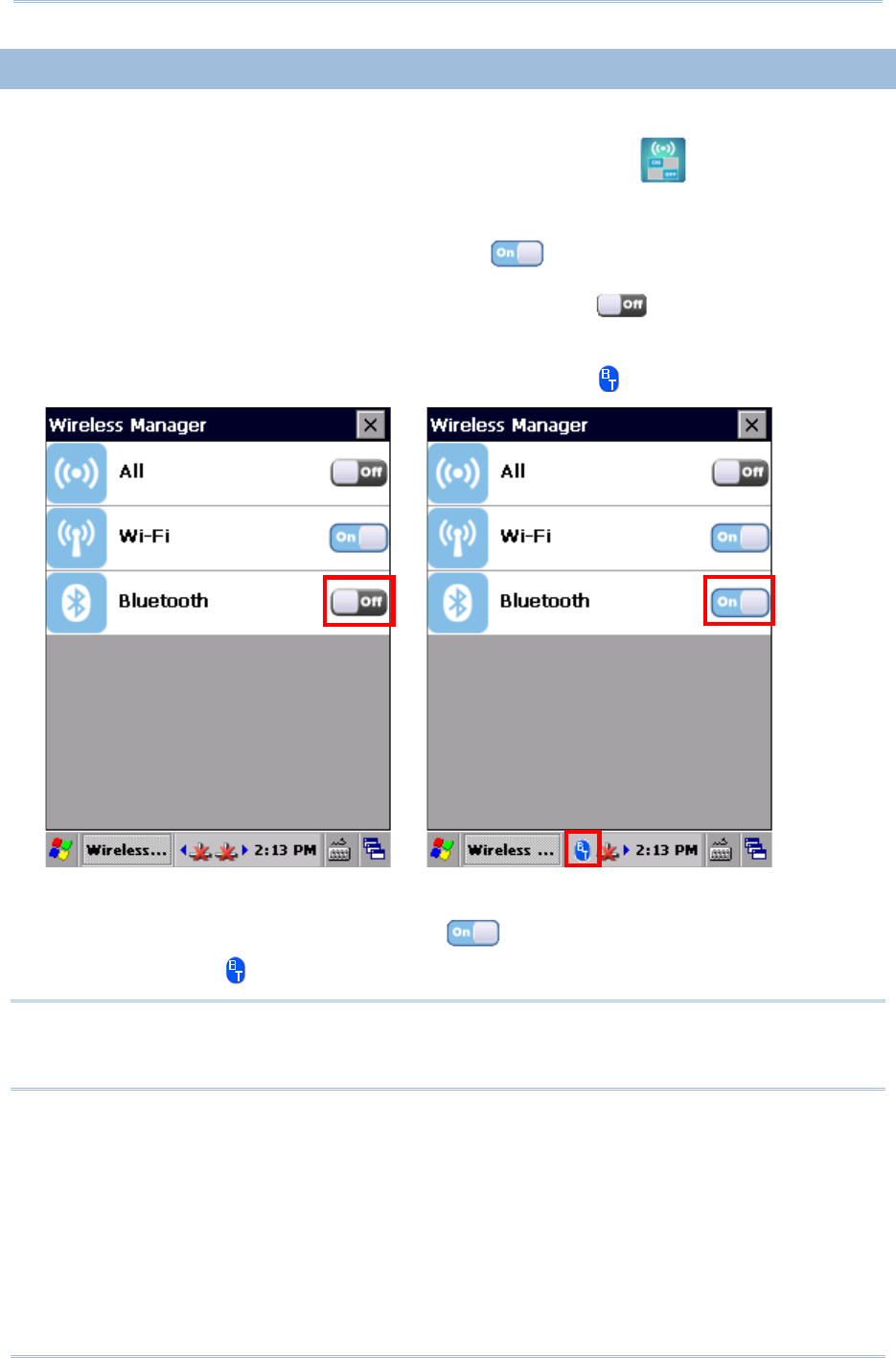
98
9700 Mobile Computer (CE) Reference Manual
3.2.3. TURN ON/OFF BLUETOOTH
To turn on/off Bluetooth power:
1) Tap Start | Settings | Control Panel |Wireless Manager .
Wireless Manager opens.
2) Make sure the Bluetooth label is turned “on” .
If the Bluetooth label is turned “off”, tap the “Off” icon to switch on Bluetooth
power. After a few seconds, Bluetooth power is switched on.
When Bluetooth power is switched on, an associated icon will appear on the taskbar.
3) To turn off Bluetooth, tap the “on” icon to have it disabled. Once Bluetooth is
disabled, the icon will disappear from the taskbar.
Note: Bluetooth power settings under Wireless Manager will be kept through suspension
and warm boot/cold boot. After the mobile computer resumes from suspension or
restarts, Bluetooth power status will be maintained.
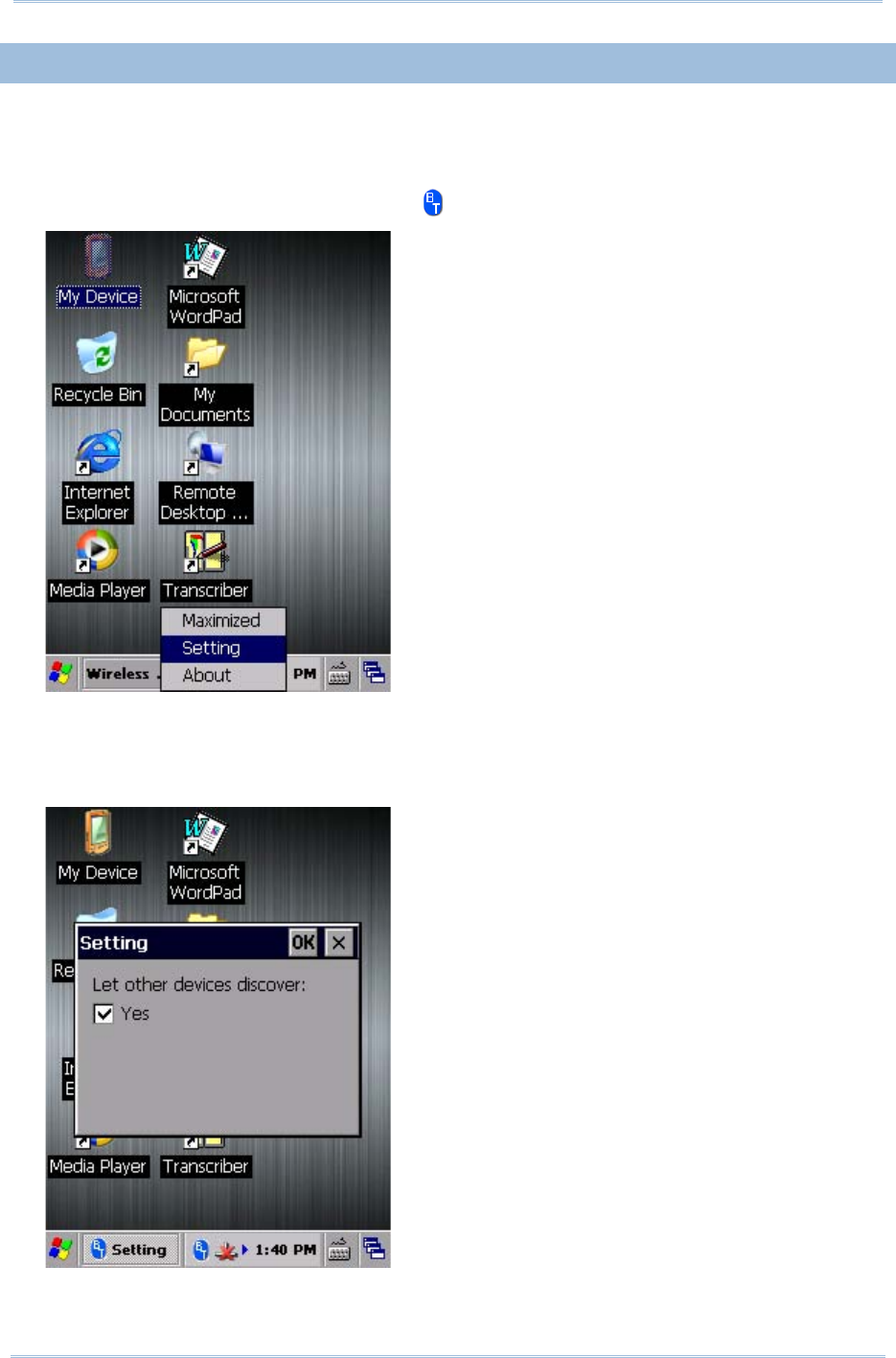
99
Chapte
r
3 Radios
3.2.4. SET BLUETOOTH VISIBILITY
By opening or closing Bluetooth visibility, you can control whether or not other Bluetooth
devices can discover the mobile computer.
To set Bluetooth visibility on the mobile computer:
1) Tap the Bluetooth icon on the taskbar and select Setting in the pop-up menu.
2) A Bluetooth Settings window opens on-screen.
To open Bluetooth visibility, select the Yes checkbox for “Let other devices discover.”
To hide the mobile computer from other Bluetooth devices, deselect the checkbox.
3) Tap OK on the title bar of the window.
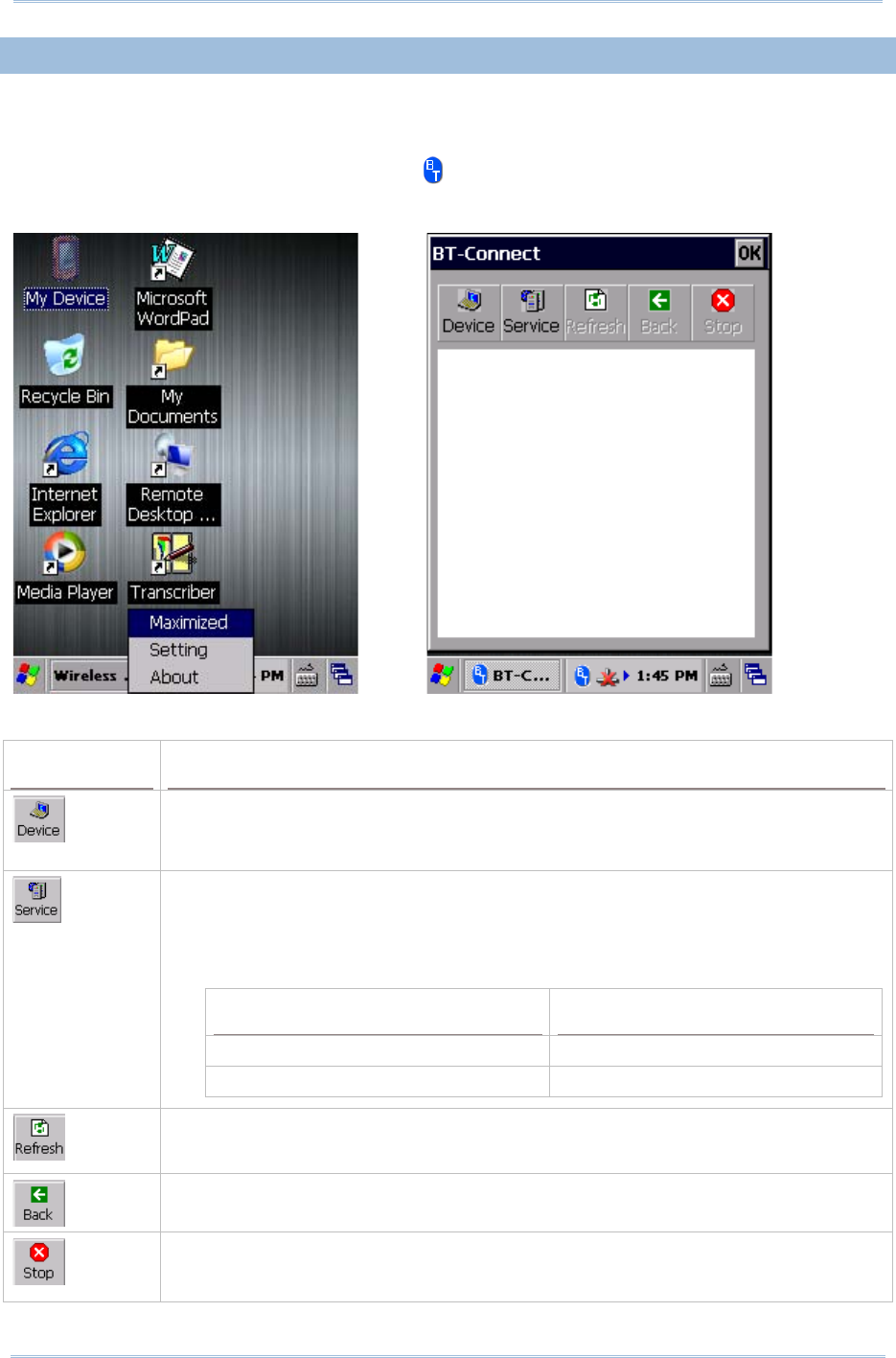
100
9700 Mobile Computer (CE) Reference Manual
3.2.5. LAUNCH BT CONNECT
BT Connect is a connection tool for establishing Bluetooth partnerships.
To launch BT Connect:
1) Tap the Bluetooth icon on the taskbar and select Maximized in the pop-up menu.
BT Connect launches with a menu bar on top and a blank field for searching devices.
See below for a description of menu bar items and their functions:
Button Description
Tap to list the Bluetooth devices discovered by the mobile computer.
If you tap the button for the first time, it will start the inquiry process of discovering
nearby Bluetooth devices.
Tap to view the Bluetooth services provided on the mobile computer.
File Transfer and Object Push services are available by default.
To change the properties for FTP or OPP services, tap and hold the item and
select Change local path from the pop-up menu.
Local path Description
\Temp\Ftp File Transfer (FTP)
\My Documents\DefaultInbox Object Push (OPP)
Tap to refresh the device list or Bluetooth services provided once a connection has
been established.
Tap to return to the previous screen.
Tap to stop discovering Bluetooth devices, disconnect existing connections or
unload services.
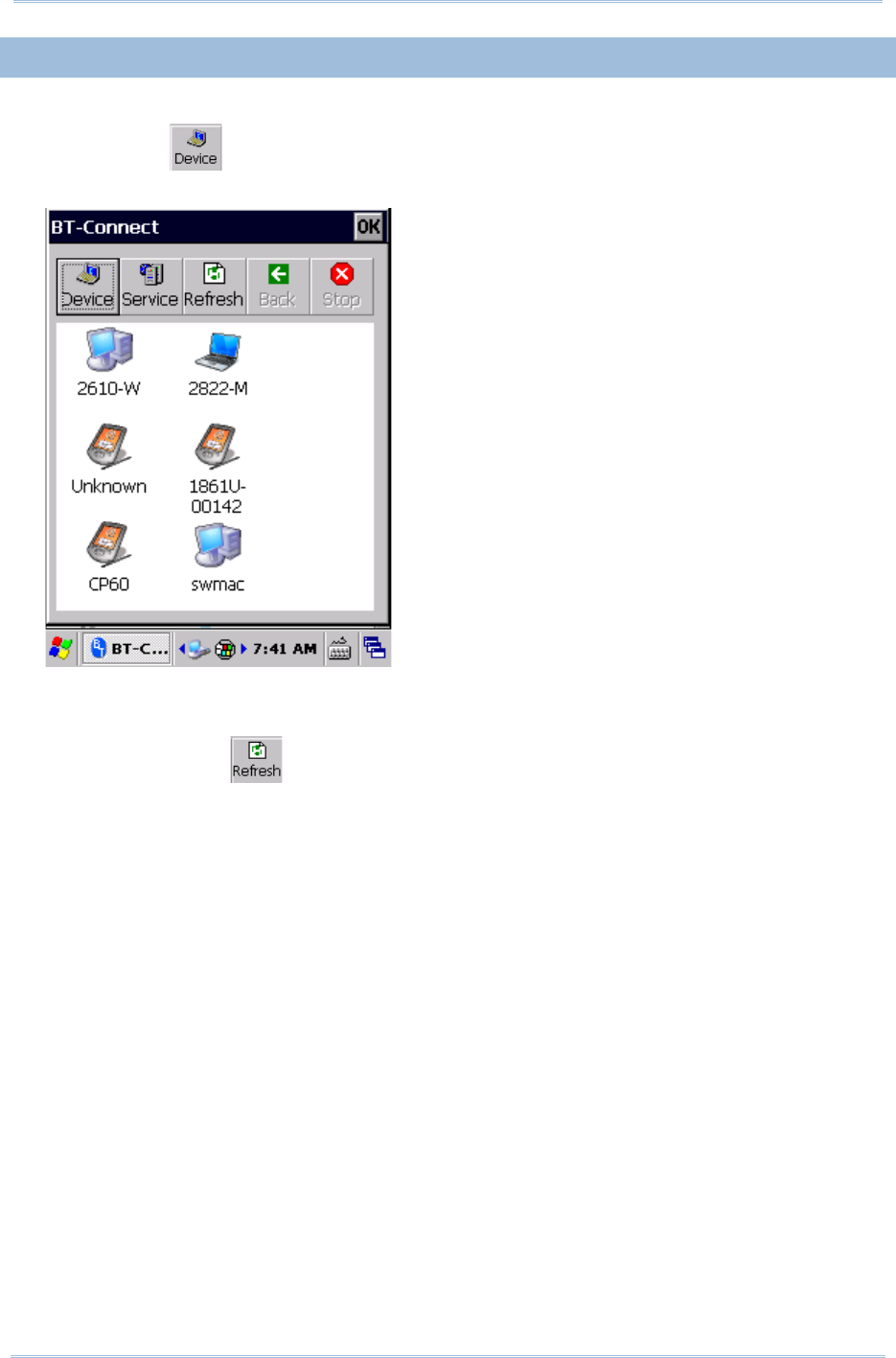
101
Chapte
r
3 Radios
3.2.6. SEARCH FOR BLUETOOTH DEVICES
To search for a Bluetooth device to connect to:
1) Tap Device to discover Bluetooth devices nearby. Wait for a few seconds for the
mobile computer to list all the discovered devices.
2) If the device that you wish to connect to is not listed, make sure its Bluetooth status is
set as discoverable.
Then tap Refresh to search for the device again.
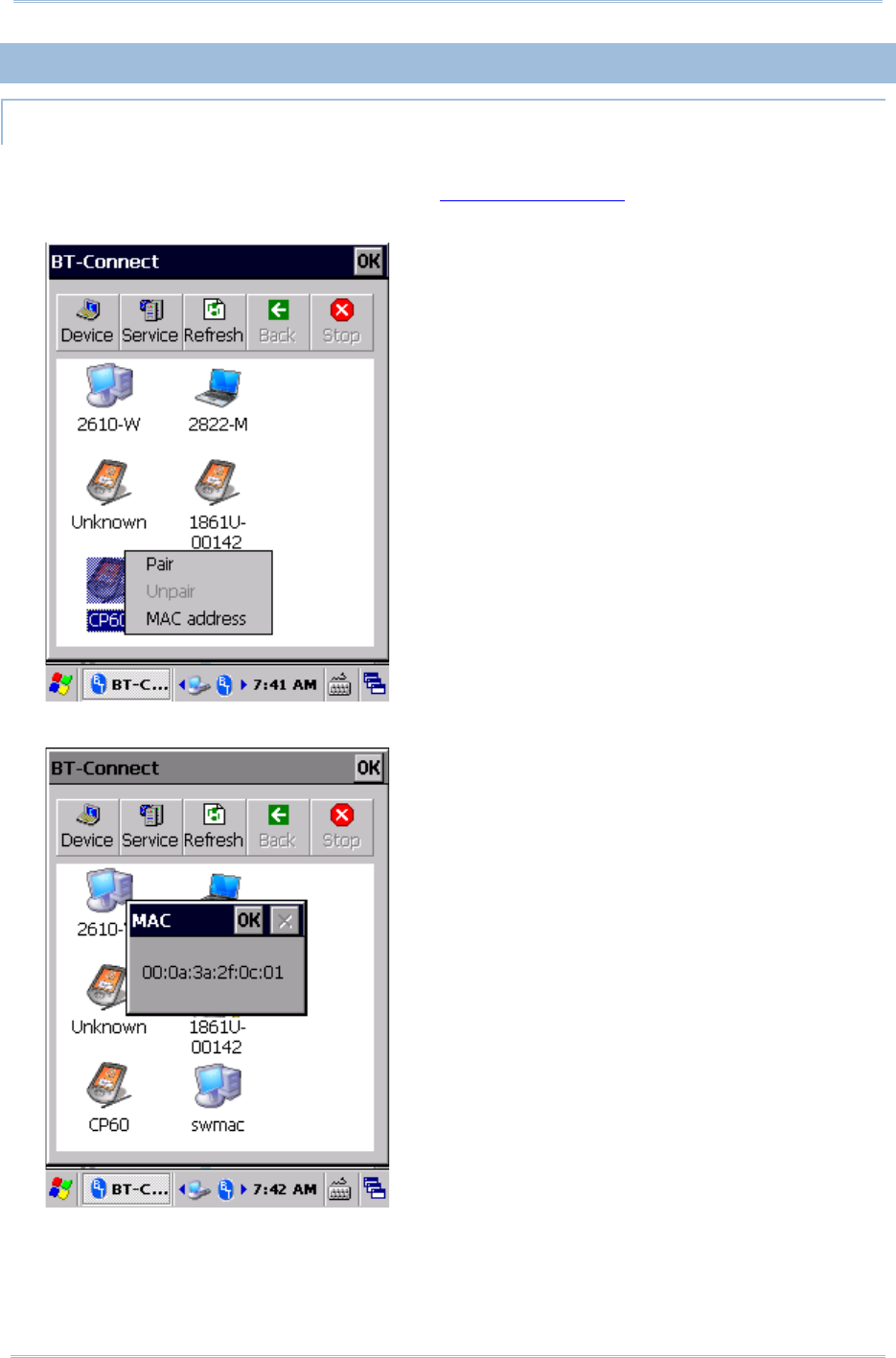
102
9700 Mobile Computer (CE) Reference Manual
3.2.7. PAIR BLUETOOTH DEVICES
IDENTIFY BLUETOOTH DEVICE
To check the identity of a Bluetooth device:
1) Open BT-Connect page as described in Launch BT Connect.
2) In the device list, tap and hold a device until a pop-up menu appears.
3) Tap MAC address in the menu to identify the selected device.
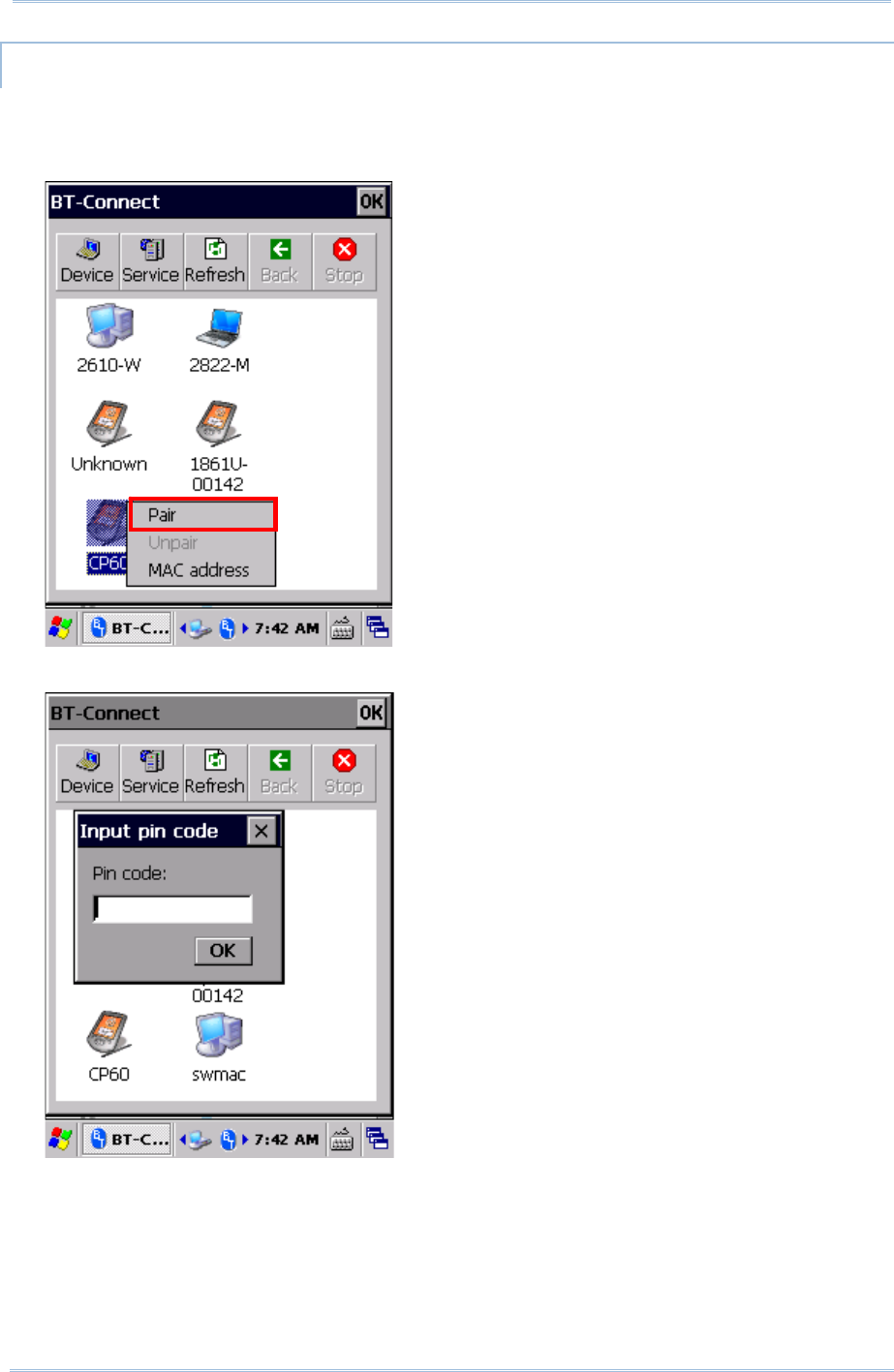
103
Chapte
r
3 Radios
PAIR
If authentication is enabled on the Bluetooth device, pairing will be required to connect to
that device. Pairing can be done by using a pin code to ensure secure Bluetooth connection.
1) In the device list, tap and hold the device to pair with. Select Pair in the pop-up menu.
2) Enter a pin code in the pop-up window that appears.
3) On the remote Bluetooth device, a prompt will show requesting you to enter the pin code.
Enter it in order to confirm the Bluetooth partnership.
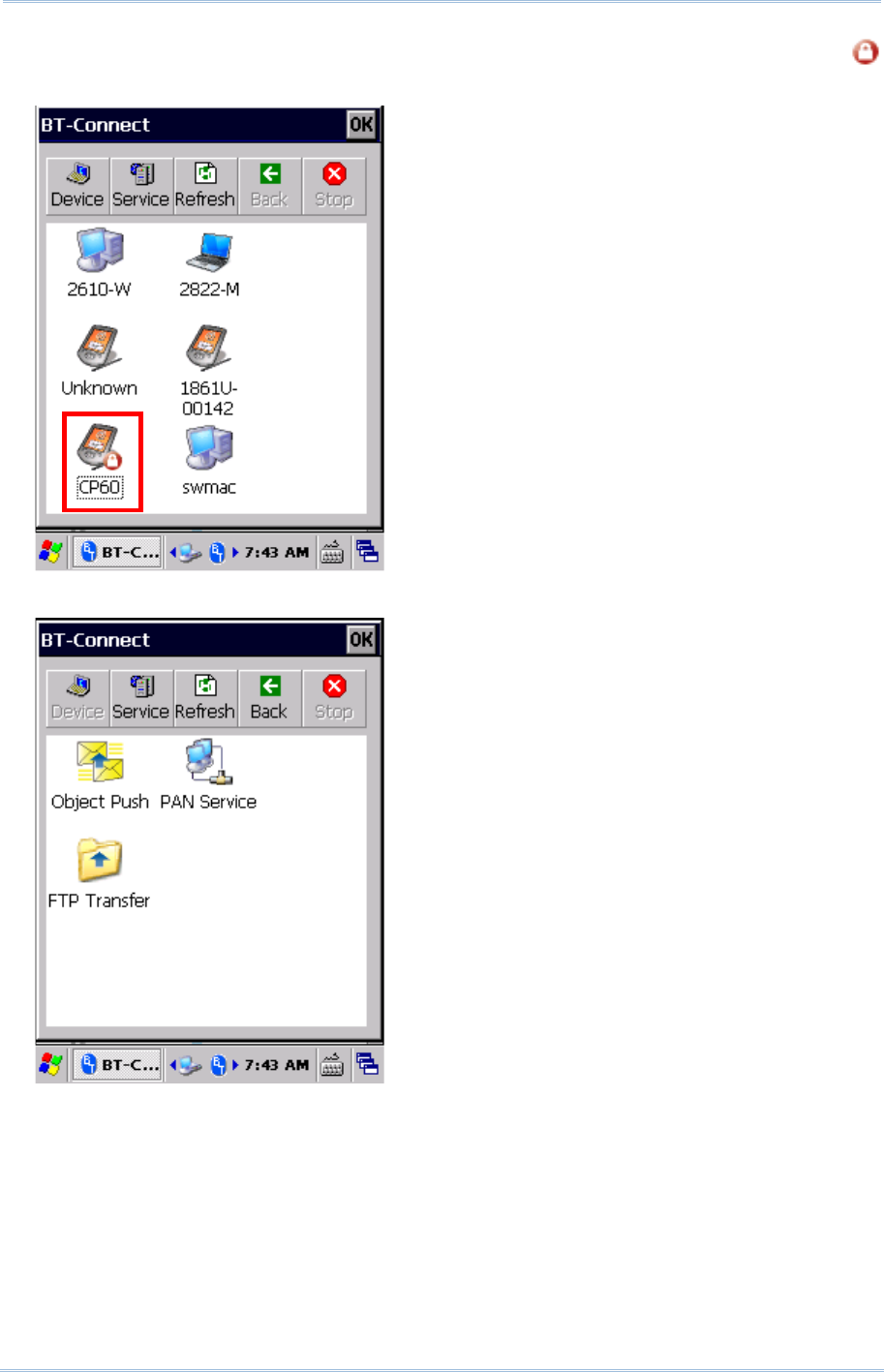
104
9700 Mobile Computer (CE) Reference Manual
Once the mobile computer and the remote Bluetooth device are paired, a lock icon
will be displayed next to the device.
4) Double-tap the device to find out which Bluetooth services are available.
5) Tap and hold a desired Bluetooth service to take further actions.
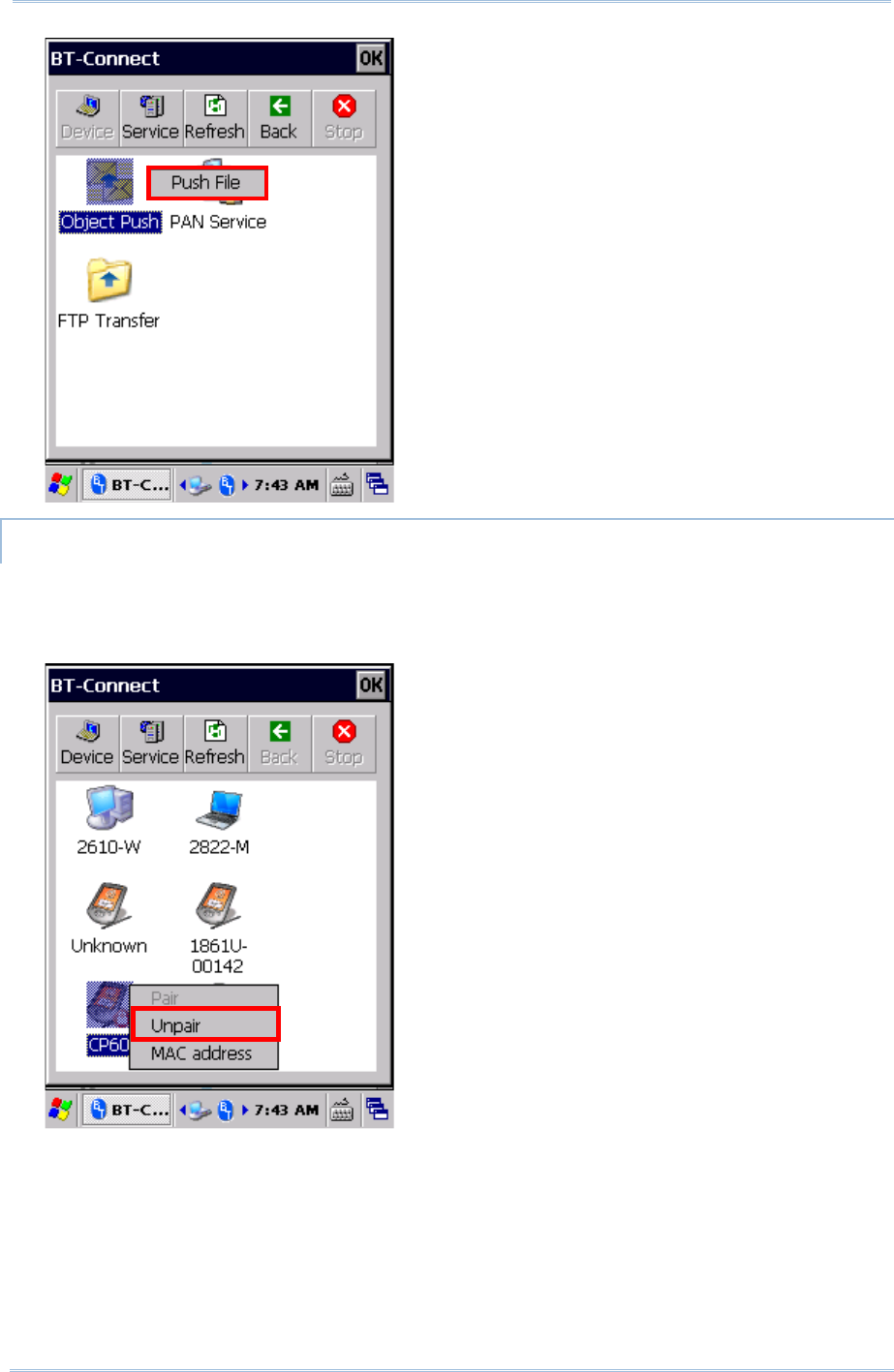
105
Chapte
r
3 Radios
UNPAIR
To unpair a Bluetooth device:
1) In the device list, tap and hold the device to unpair. A pop-up menu will appear.
2) Select Unpair in the pop-up menu.
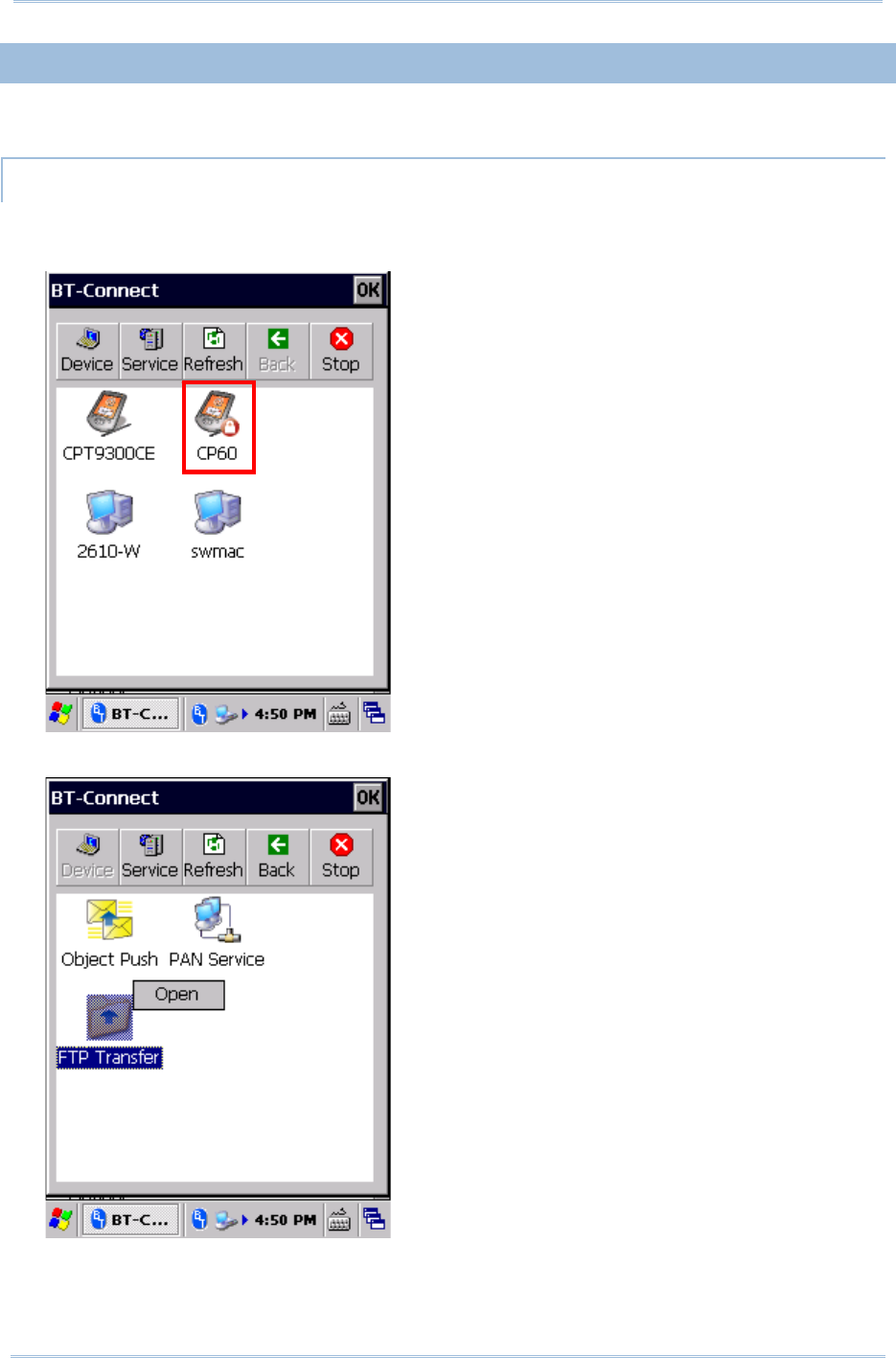
106
9700 Mobile Computer (CE) Reference Manual
3.2.8. BLUETOOTH DATA TRANSFER
After the mobile computer is paired to a remote Bluetooth Device, it is ready to begin
Bluetooth data communication.
FILE TRANSFER
To exchange files via file transfer (FTP) service:
1) On the Device page, double-tap the paired Bluetooth device.
2) Tap and hold FTP Transfer and select Open in the pop-up menu.
3) Tap and hold a blank spot on the page and select Put File in the pop-up menu.
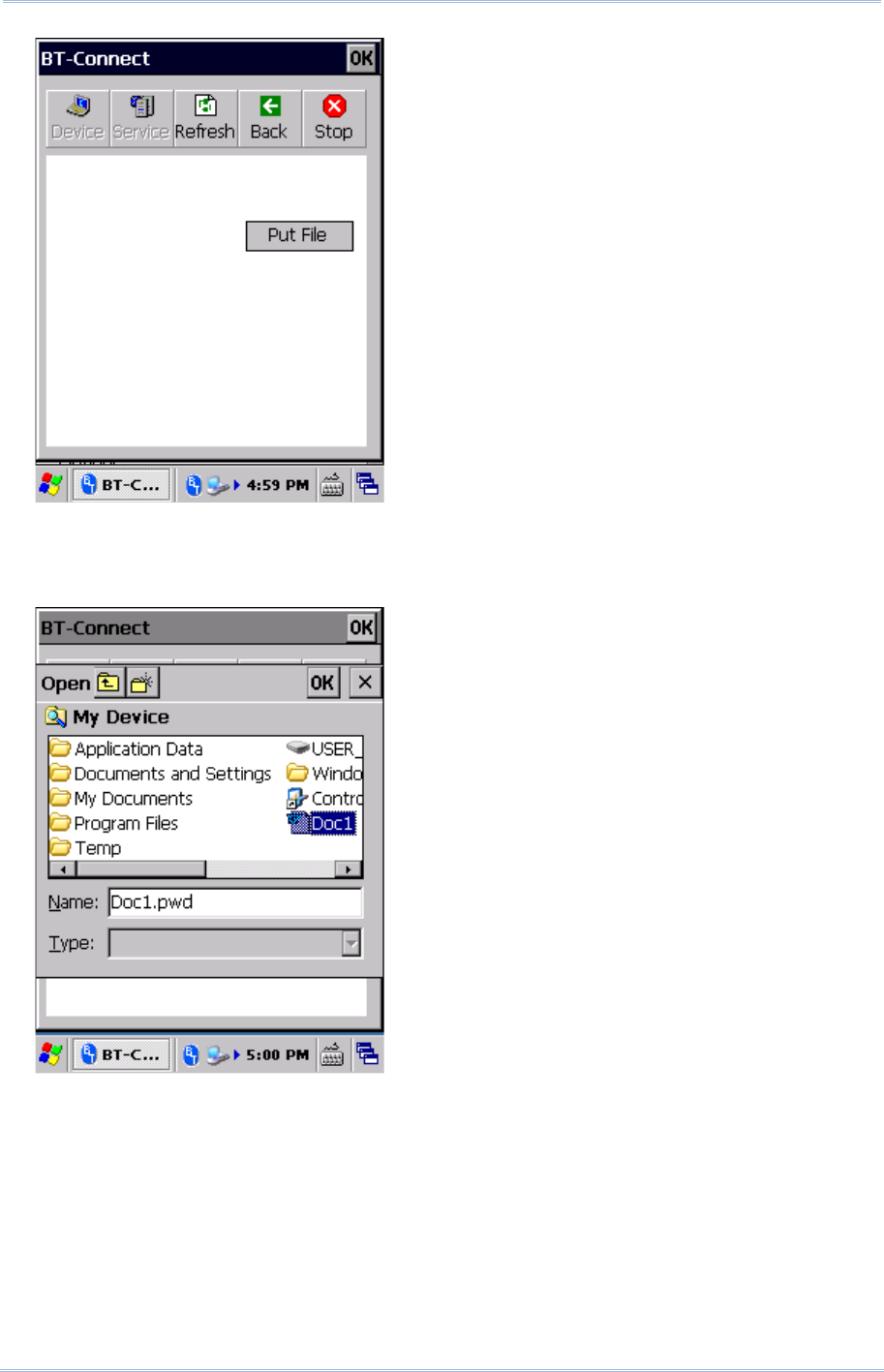
107
Chapte
r
3 Radios
4) Select an object to transfer to the paired Bluetooth device.
On the remote Bluetooth device, the object will be stored under the directory specified
on Service page | FTP Transfer |Change Local Path.
5) To store a transferred file to the specified local path on the mobile computer, tap and
hold a file and select Get File in the pop-up menu.
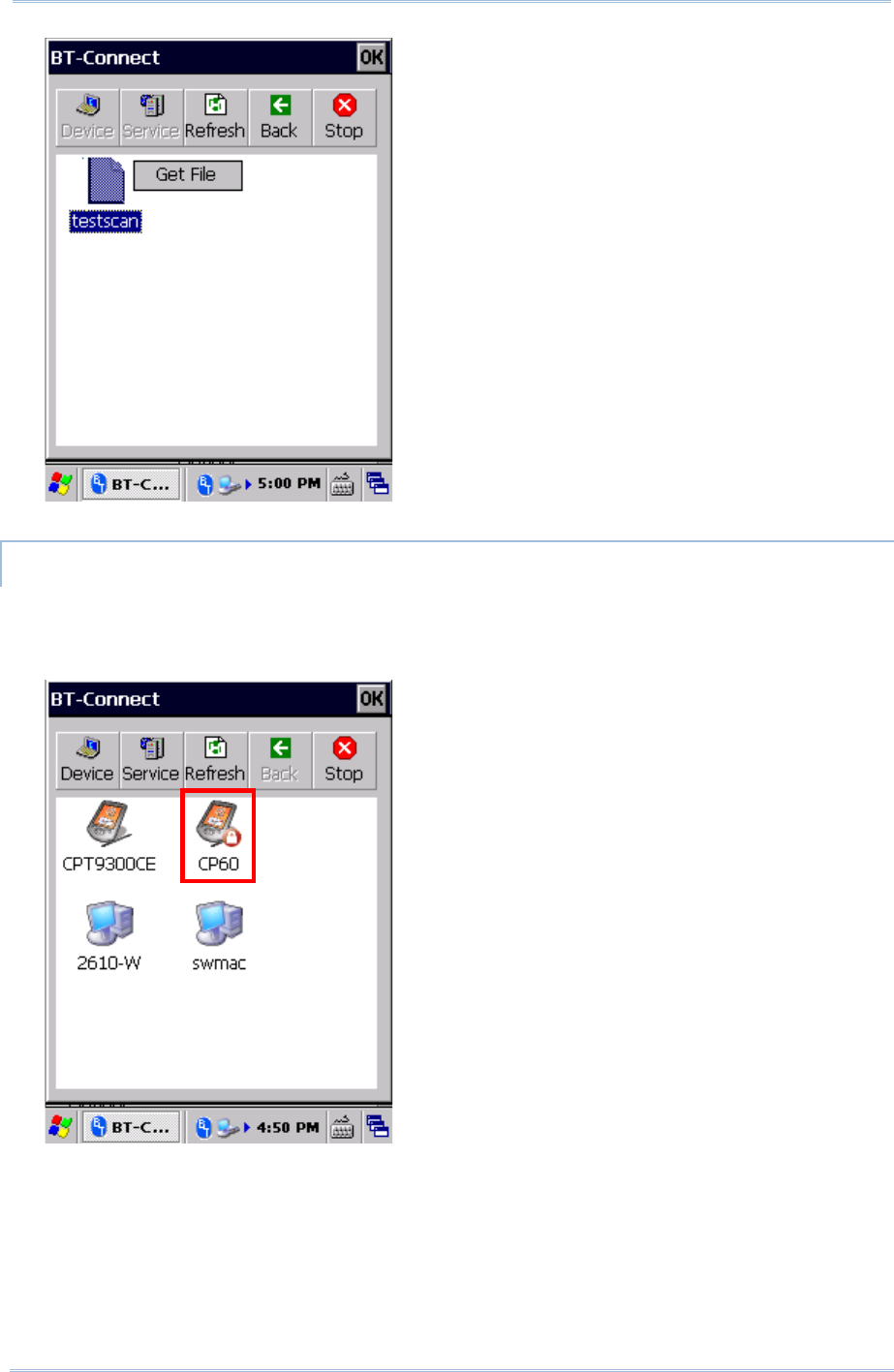
108
9700 Mobile Computer (CE) Reference Manual
OBJECT PUSH
To use object push (OPP) service to send an object to a remote Bluetooth device:
1) On the Device page, double-tap the paired Bluetooth device to open a page showing its
available services.
2) Tap and hold Object Push and select Push File in the pop-up menu.
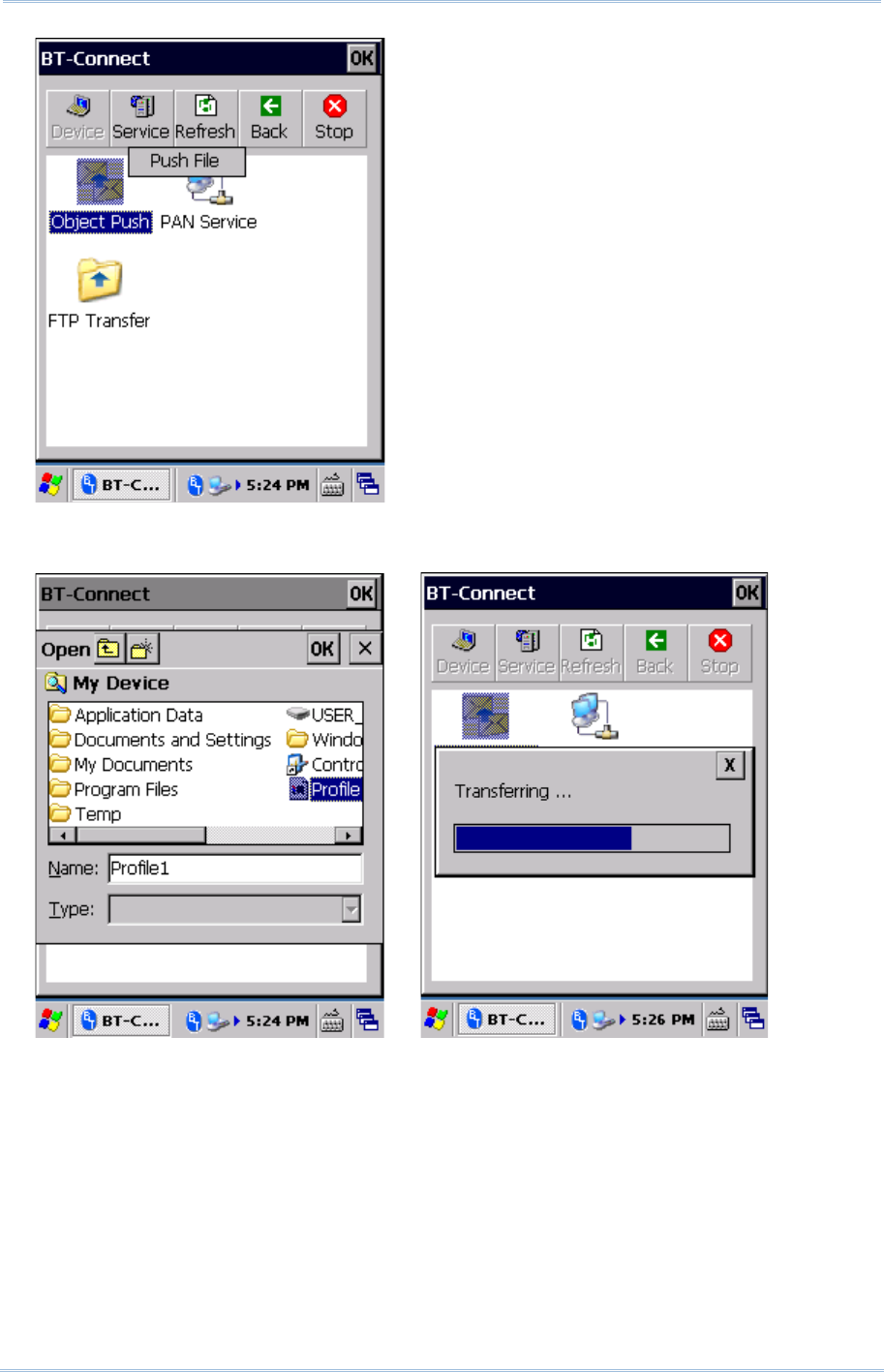
109
Chapte
r
3 Radios
3) Select an object to transfer to the paired Bluetooth device. Wait for a few moments while
the file transfers to the remote Bluetooth device.
4) On the remote Bluetooth device, the object will be stored under the directory specified
on Service page | Object Push |Change Local Path.
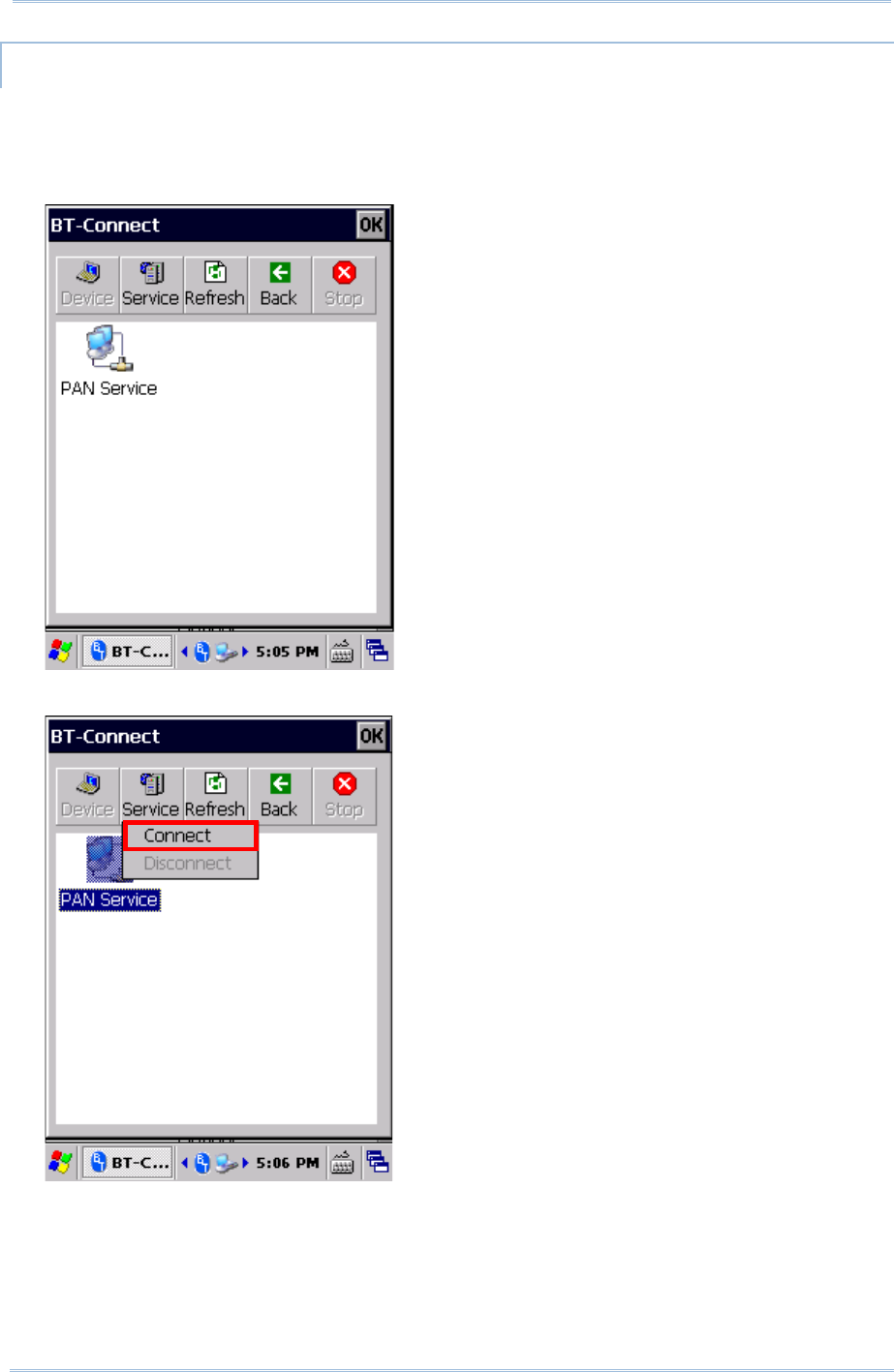
110
9700 Mobile Computer (CE) Reference Manual
PAN SERVICE
To use personal area network (PAN) service shared by the Bluetooth device to connect to
the Internet:
1) On the Device page, double-tap the paired Bluetooth device to open a page showing its
available services.
2) Tap and hold PAN Service and select Connect in the pop-up menu.
3) The paired Bluetooth device is then connected to mobile computer through PAN
network.
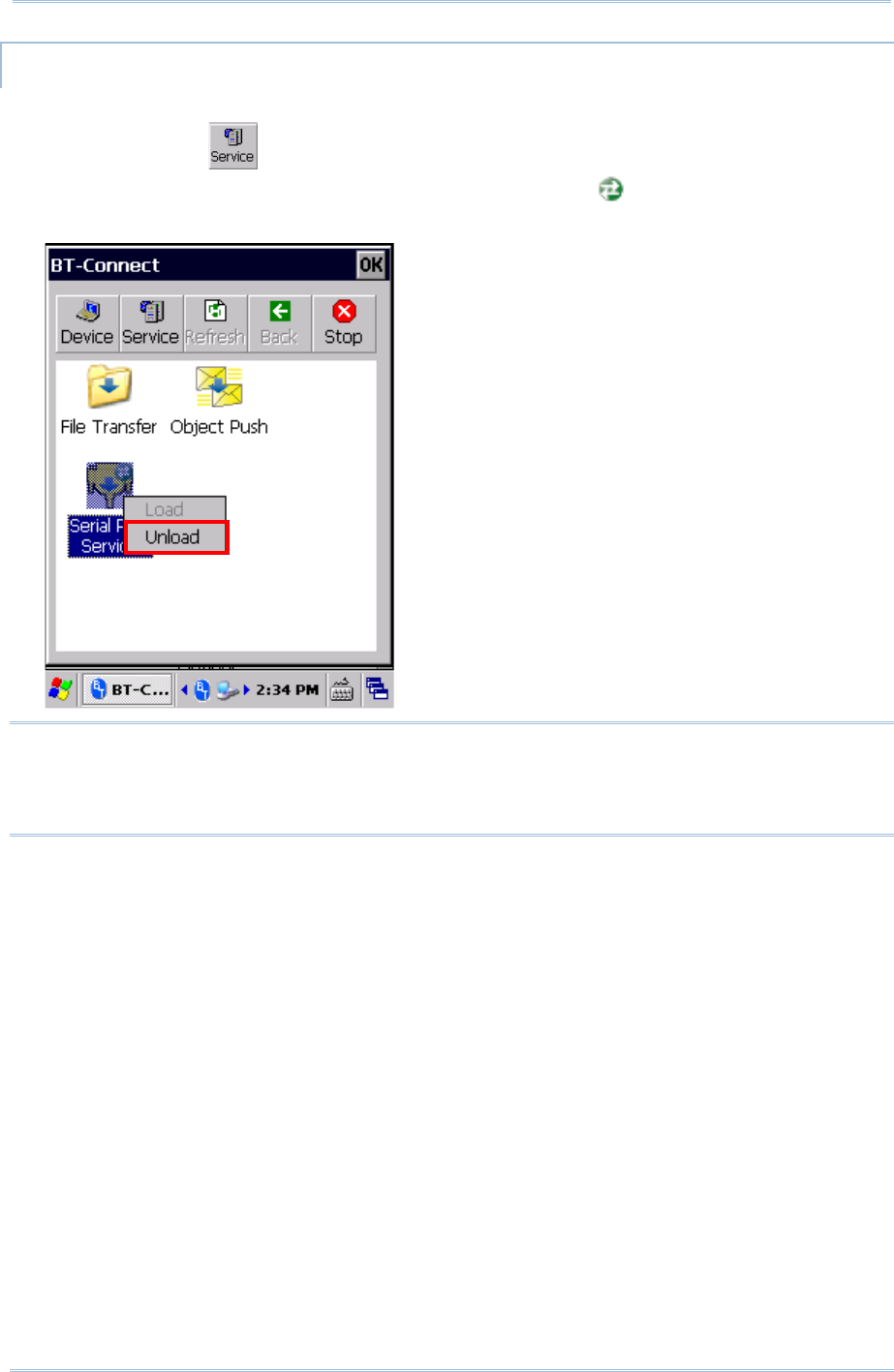
111
Chapte
r
3 Radios
SERIAL PORT SERVICE
To use Serial Port Service:
1) On the Service page, check if the Bluetooth virtual COM port is occupied by the
local SPP service (i.e. whether a green connection icon is present). If so, tap and
hold the service and select Unload in the pop-up menu.
Note: The mobile computer provides one virtual COM port as the output or input port for
Bluetooth. Before using the COM port for outgoing serial port (SPP) service, be sure
to unload the local SPP service so the COM port is available for outgoing
communication.
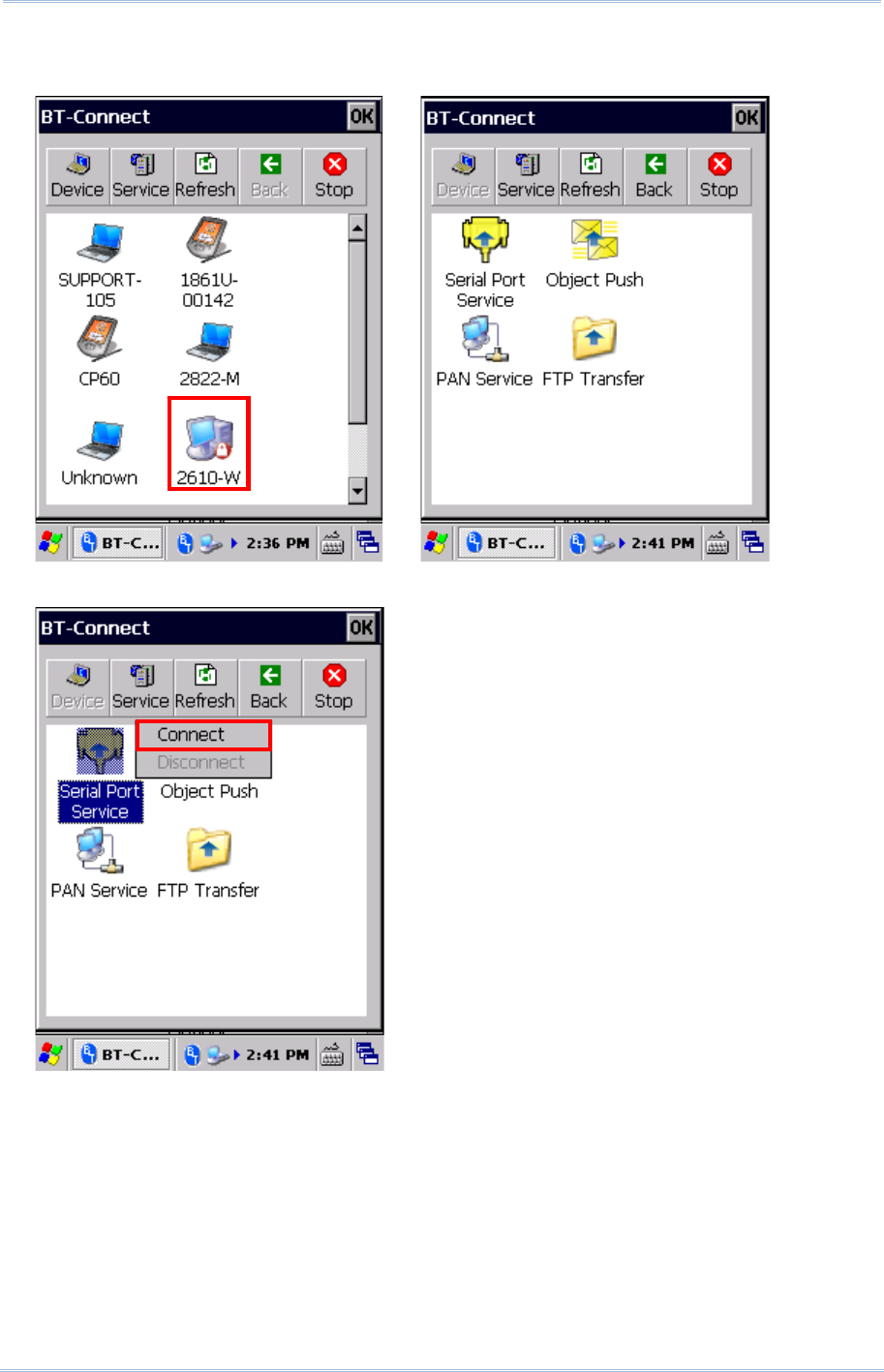
112
9700 Mobile Computer (CE) Reference Manual
2) On the Device tab, double-tap the paired device to open a page showing the available
services for that device.
3) Tap and hold Serial Port Service and select Connect in the pop-up menu.
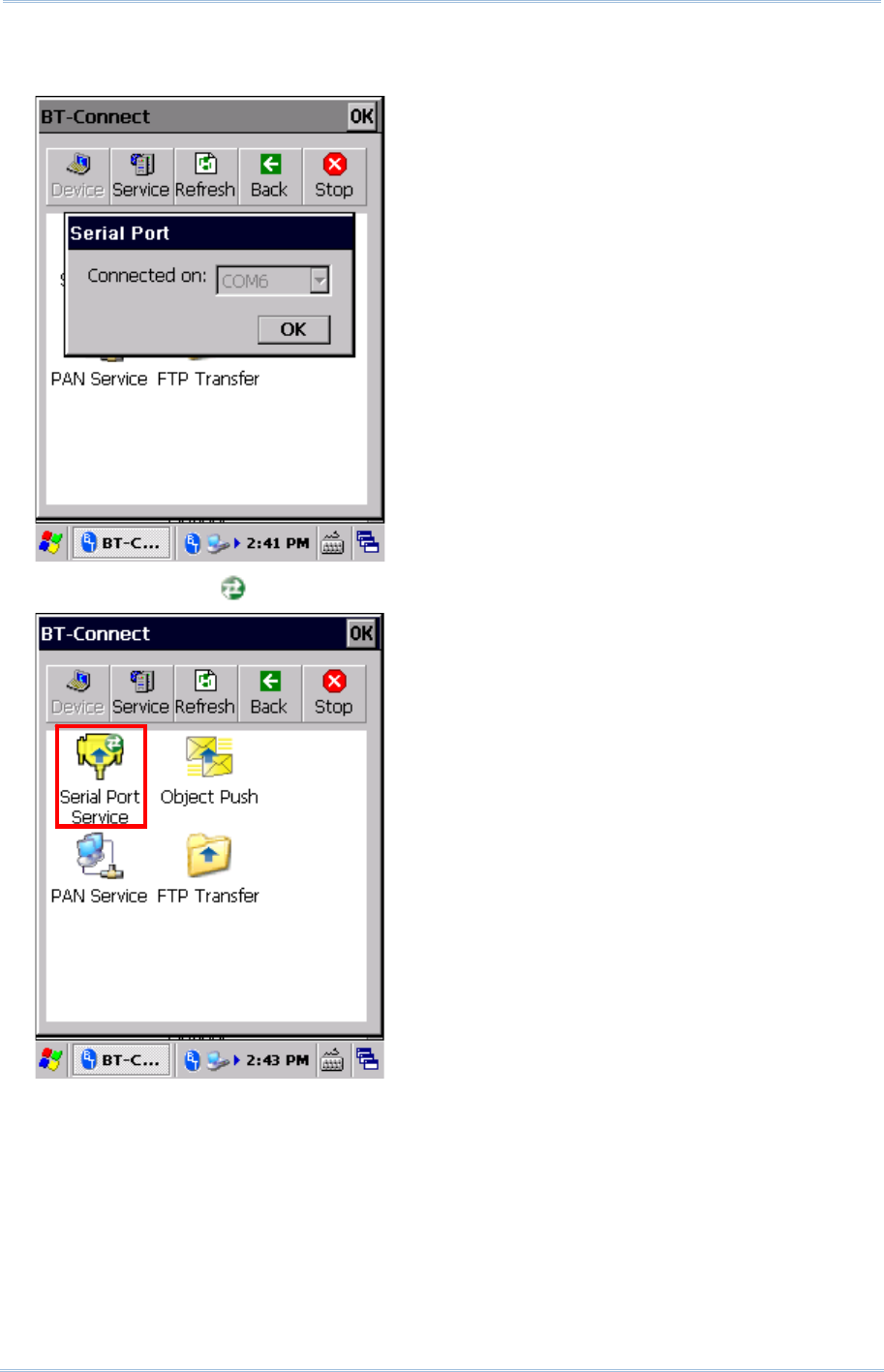
113
Chapte
r
3 Radios
4) By default, the mobile computer uses COM6 as the Bluetooth SPP COM port. Tap OK in
the pop-up window to confirm.
5) A connection icon appears to indicate that serial port service is now active.
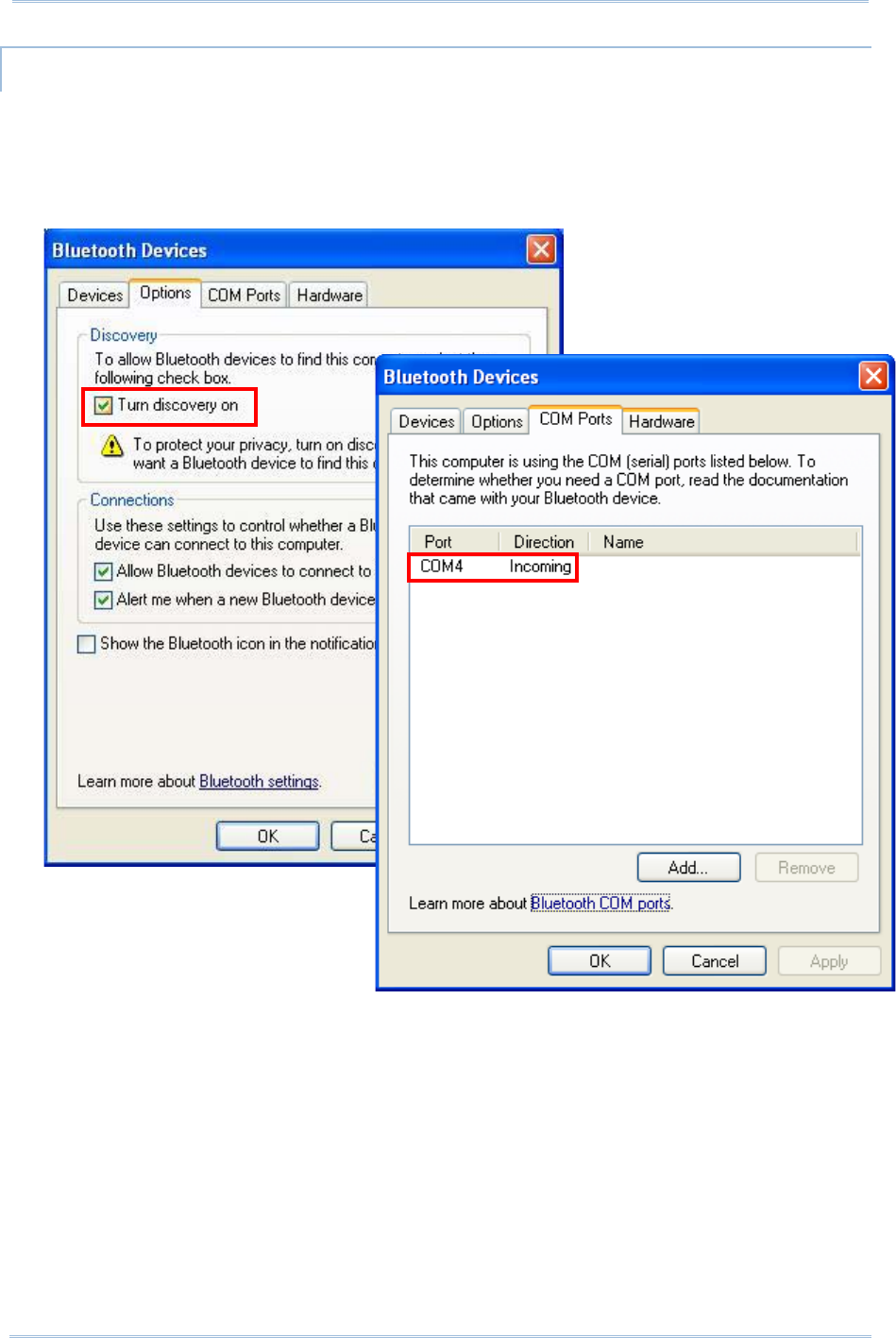
114
9700 Mobile Computer (CE) Reference Manual
BLUETOOTH ACTIVESYNC
To create ActiveSync connection between your PC and mobile computer via Bluetooth, first
you will need to configure Bluetooth settings on your PC.
1) On your PC, configure necessary Bluetooth settings, such as turn Bluetooth discovery on,
allow other Bluetooth devices to connect to the PC, and add a COM port for incoming
connection.
2) On the PC, open ActiveSync | File | Connection Settings and specify the COM port
for incoming connection.
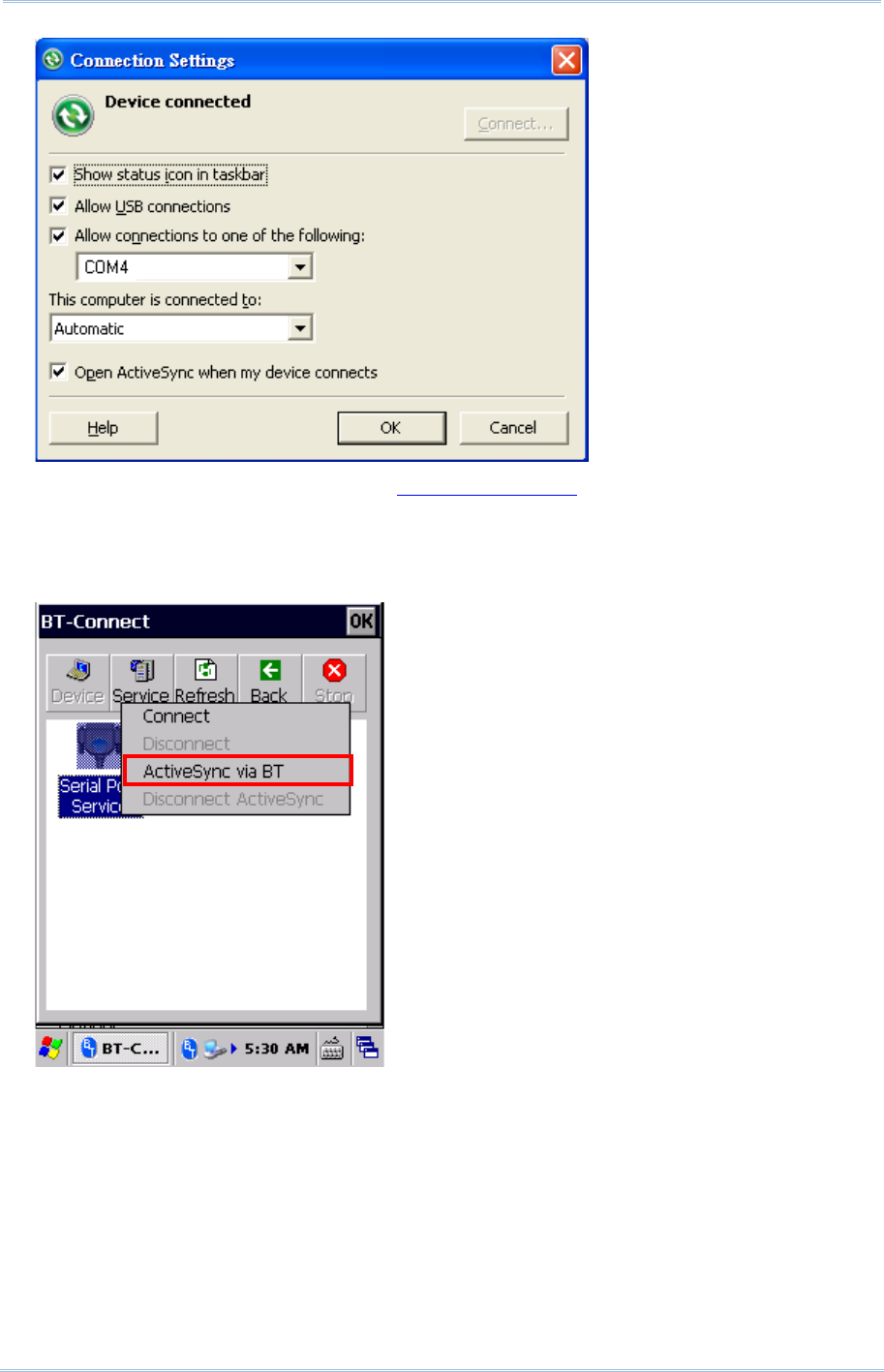
115
Chapte
r
3 Radios
3) On the mobile computer, make sure Serial Port Service is enabled in BT Manager.
4) On the Device page, double-tap your PC to view its available services.
5) Tap and hold Serial Port Services and select ActiveSync via BT in the pop-up menu.
The mobile computer then connects to your PC via ActiveSync.
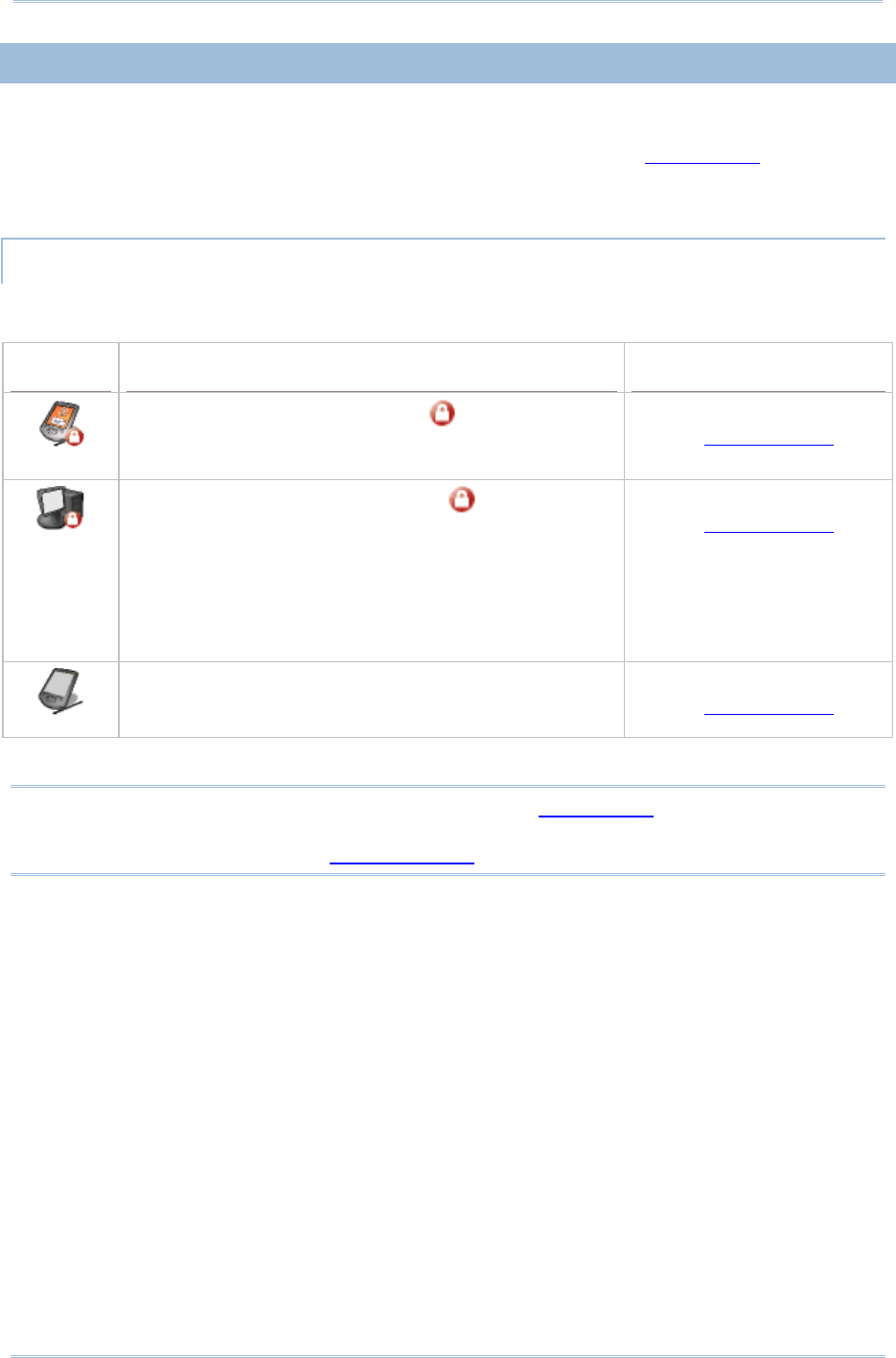
116
9700 Mobile Computer (CE) Reference Manual
3.2.9. RE-CONNECTION
By default, BT-Connect will automatically re-connect to the previous services the next time
the mobile computer goes through a Bluetooth power cycle. The preferred devices and
services will also be reflected on the Preference tabbed page of BT Manager.
This section explains the statuses of previously connected devices/services and their
re-connection settings.
PREFERRED DEVICE LIST
Tap the Device tabbed page in BT-Connect to check the statuses of previously connected
devices.
Example Device Status Settings in BT-Manager
The device has been paired with ( ) and at least one
service has been re-connected successfully, such as
Headset/Handsfree, HID, PAN, or SPP.
Last Connection = Y
(on the Preference Tab)
The device has been paired with ( ) but have the
following settings for remote services, such as
Headset/Handsfree, HID, PAN, or SPP:
(1) Last Connection is set as N, meaning none of the
services are required to be re-connected.
(2) Last Connection is set as Y, but the device fails to be
re-connected.
Last Connection = Nor Y
(on the Preference Tab)
The device is not paired, yet it has services which do not
require PIN code exchange and are set as not to be
re-connected (such as DUN, FTP, or OPP).
Last Connection = N
(on the Preference Tab)
Note: The re-connection settings are configurable via BT Manager. If you want to remove
a specific device from the device list, you have to manually delete records of all its
Bluetooth services on the Preference Tab.
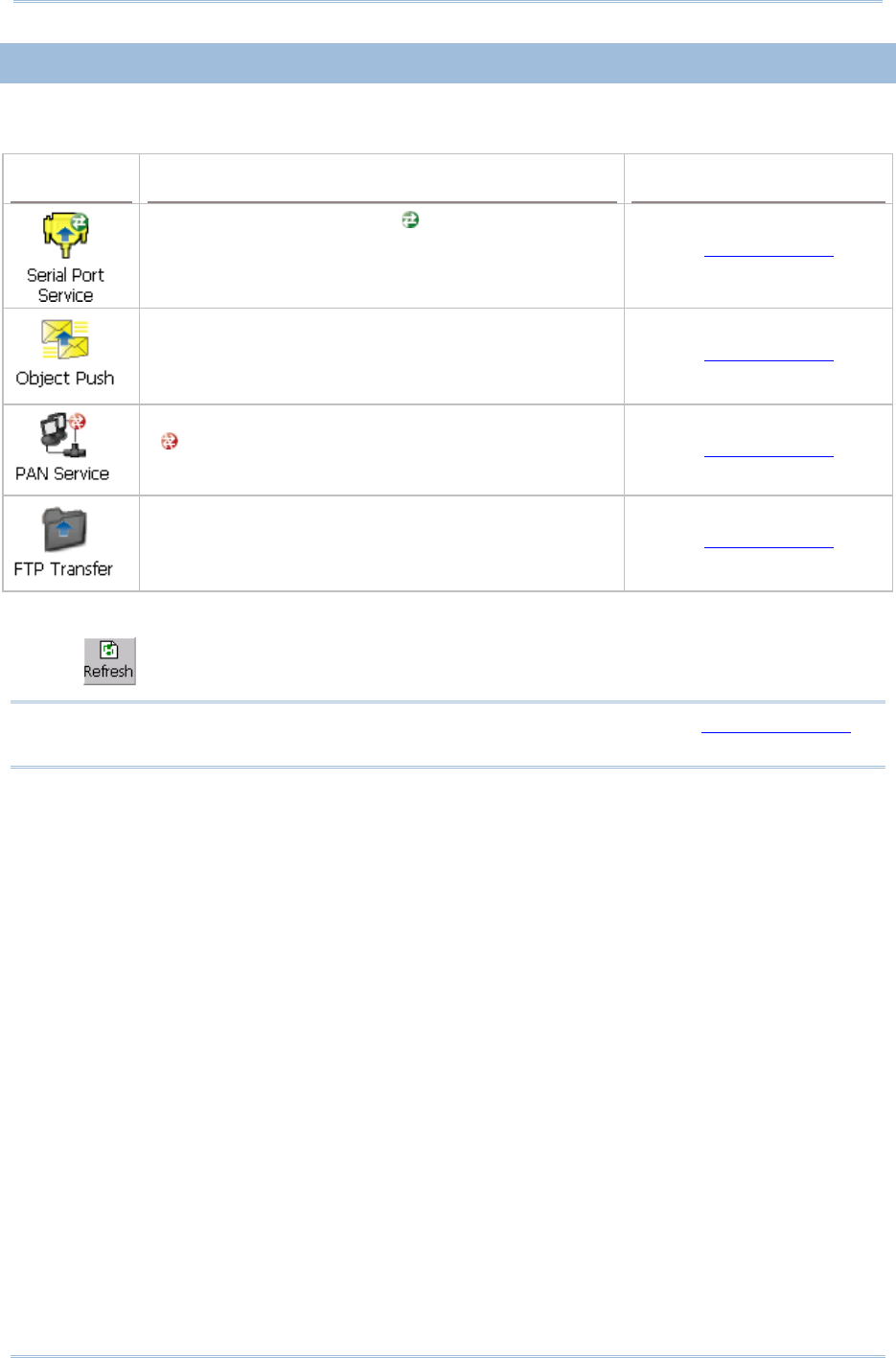
117
Chapte
r
3 Radios
3.2.10. PREFERRED SERVICES
On the Device tabbed page in BT-Connect, double-tap the preferred device to view its
available Bluetooth service(s).
Example Service Status Settings in BT-Manager
The service is re-connected ( ). Last Connection = Y
(on the Preference Tab)
The service is available for re-connection. Last Connection = N
(on the Preference Tab)
A previously connected service becomes disconnected
() since partnership with the remote Bluetooth
device has been interrupted.
Last Connection = Y
(on the Preference Tab)
The service is manually disconnected, and partnership
with the remote Bluetooth device has been
interrupted.
Last Connection = N
(on the Preference Tab)
To reconnect to a specific service, tap and hold it and select Connect in the pop-up menu.
Or tap to update service status for the remote Bluetooth device.
Note: You can select to re-connect to a specific service. Refer to Preference Tab to
configure connection settings for the service.
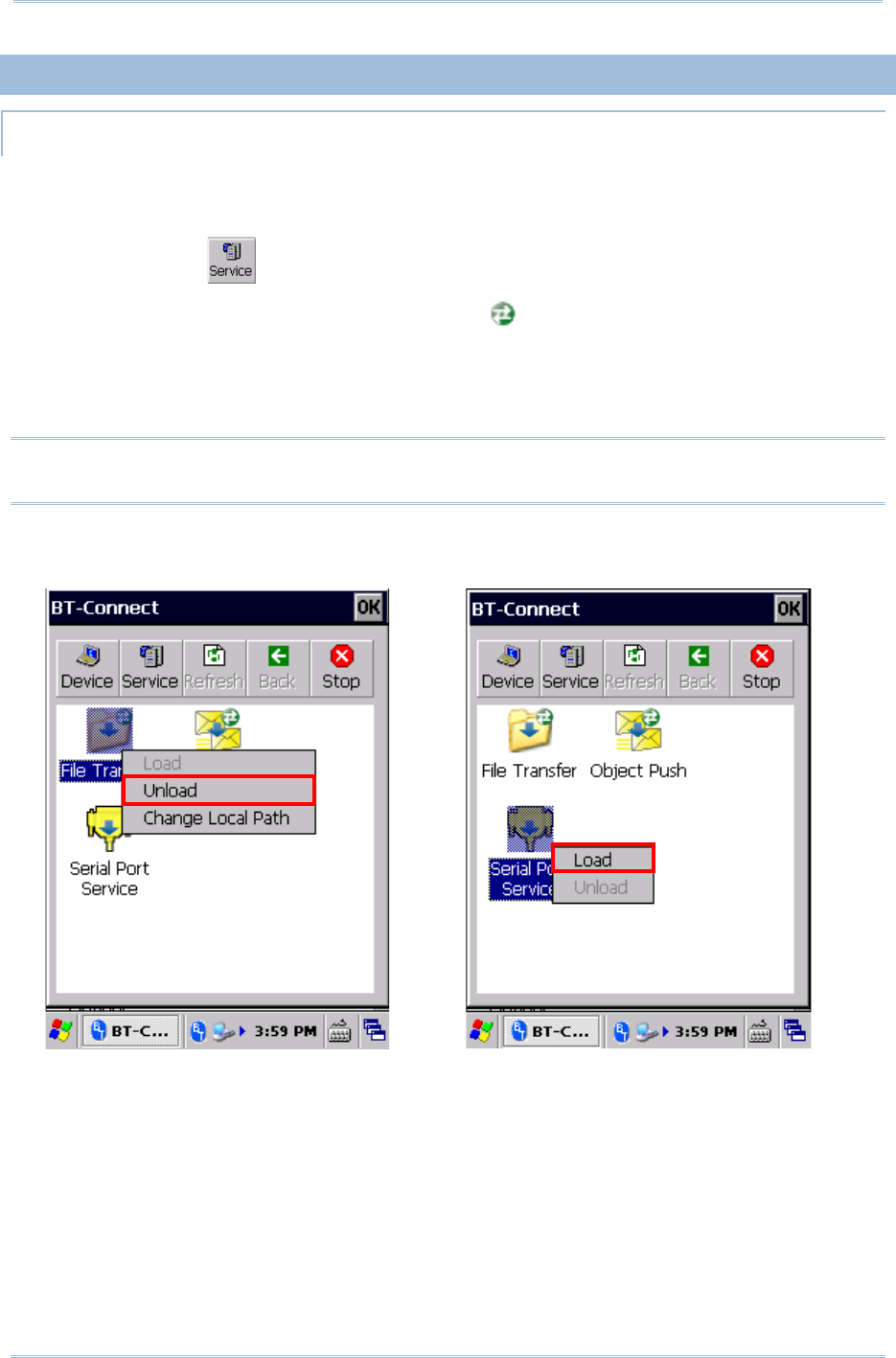
118
9700 Mobile Computer (CE) Reference Manual
3.2.11. MANAGE LOCAL SERVICES
LOAD/UNLOAD SERVICE
You may select to load or unload a certain service. When a service is unloaded, it will
become unavailable to paired Bluetooth devices. When it is re-loaded, it will become
available once more.
1) On the Service page, tap and hold an item to open a pop-up menu.
An active service will have a connection icon next to it. Select to Unload it in the
pop-up menu.
OR
Select an inactive service and Load it in the pop-up menu.
Note: File Transfer (FTP) and Object Push (OPP) services are loaded/unloaded
simultaneously.
Select an active service to unload it. Select an inactive service to load it.
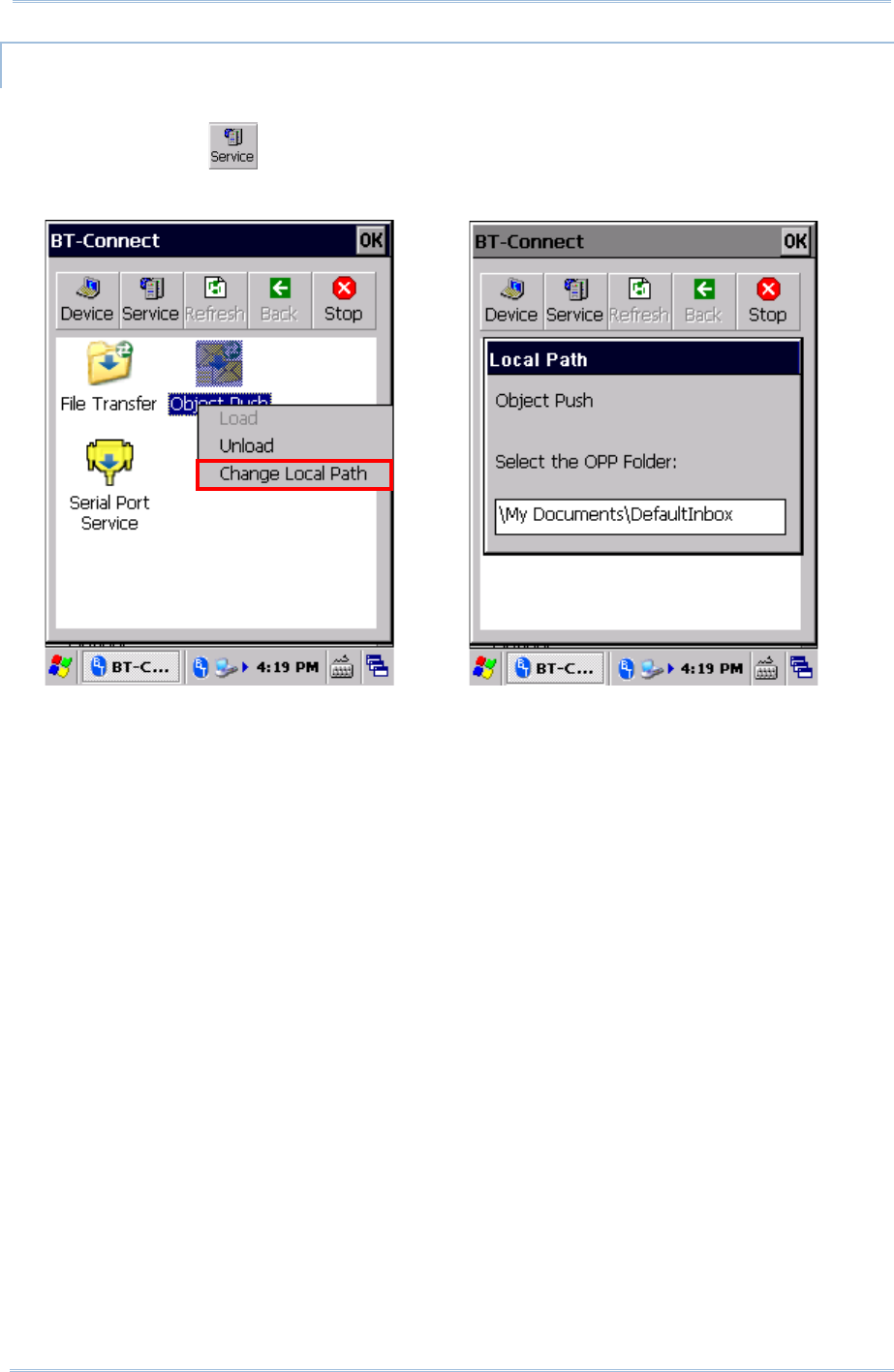
119
Chapte
r
3 Radios
CHANGE LOCAL PATH
For File Transfer and Object Push services, you may change the path for file exchange.
1) On the Service page, tap and hold an item to open a pop-up menu.
Select Change Local Path in the pop-up menu and enter an inbox storage path.
2) Tap OK to confirm the change.
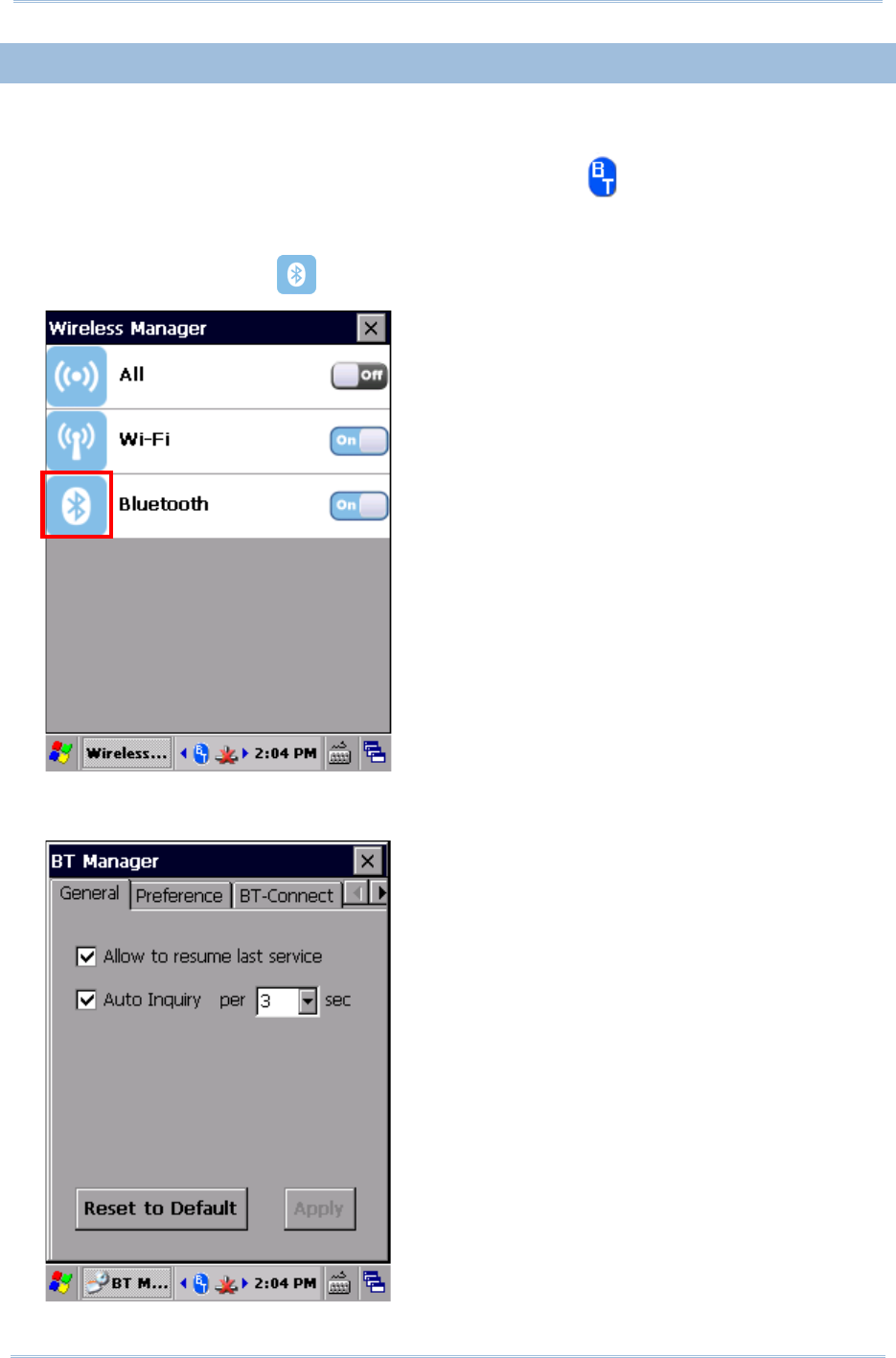
120
9700 Mobile Computer (CE) Reference Manual
3.2.12. BT MANAGER
Advanced Bluetooth settings regarding Bluetooth reconnection, Bluetooth inquiry time and
more can be adjusted using BT Manager.
1) Tap Start | Settings | Control Panel | BT Manager .
OR
Tap the Bluetooth icon on the Wireless Manager settings page.
BT Manager window will open showing four tabbed pages: General,Preference,
BT-Connect and About.
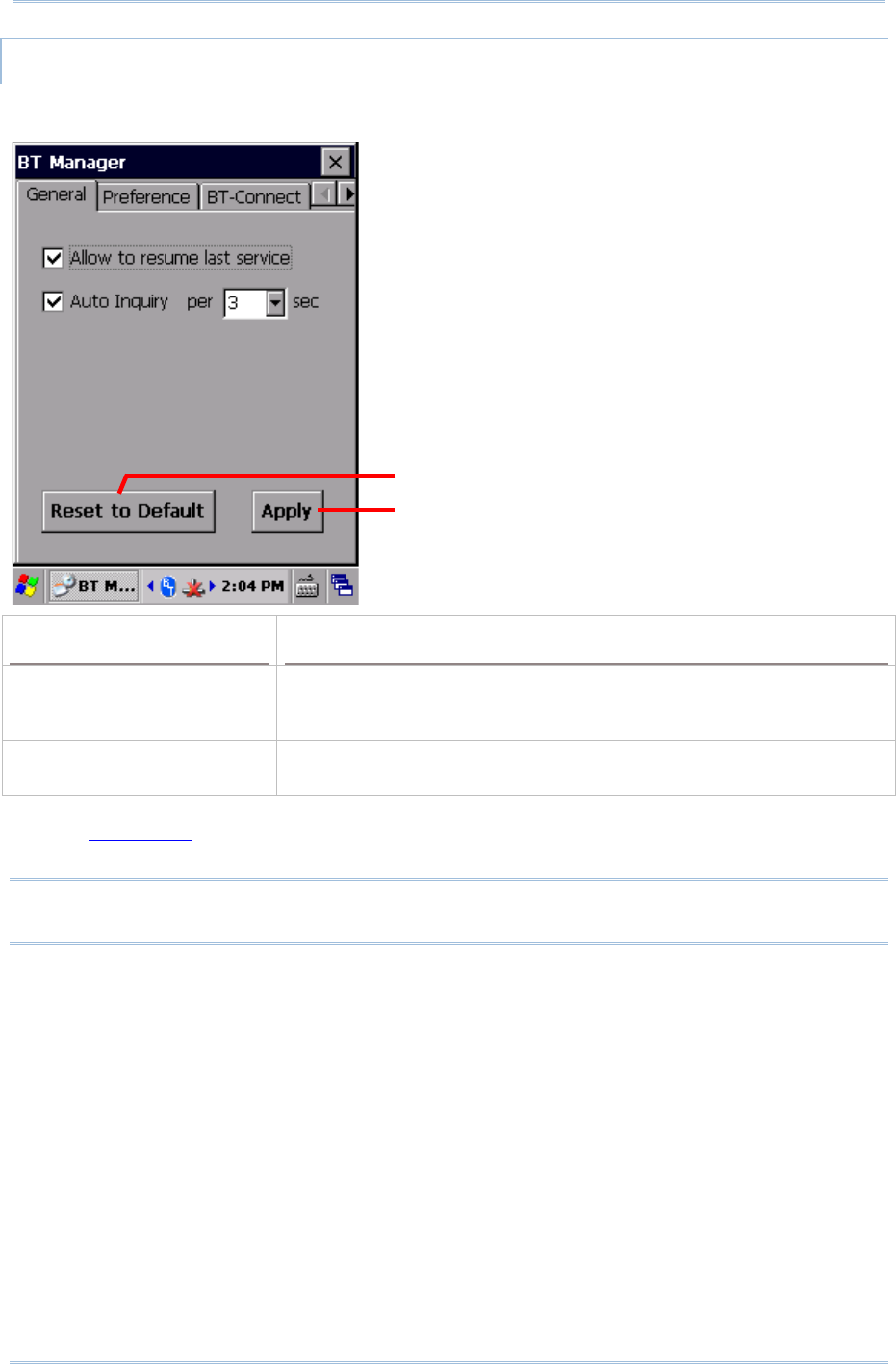
121
Chapte
r
3 Radios
GENERAL TAB
This page sets whether to allow reconnection of Bluetooth services and auto-inquiry of
Bluetooth devices.
Setting Description
Allow to resume last service Select to automatically re-connect to all previous Bluetooth services
after the mobile computer resumes from warm boot/cold boot, or
goes through a Bluetooth power cycle.
Auto Inquiry per [ ] sec Select to perform an inquiry on a remote device at a regular interval
after the mobile computer resumes from suspension.
Use Preference tabbed page to configure “Last Connection” and “Auto Inquiry” settings
for a specific service.
Note: Disabling “Auto Inquiry” helps save battery power. Enable this function only when
necessary.
Tap to save changes
Tap to restore default settings
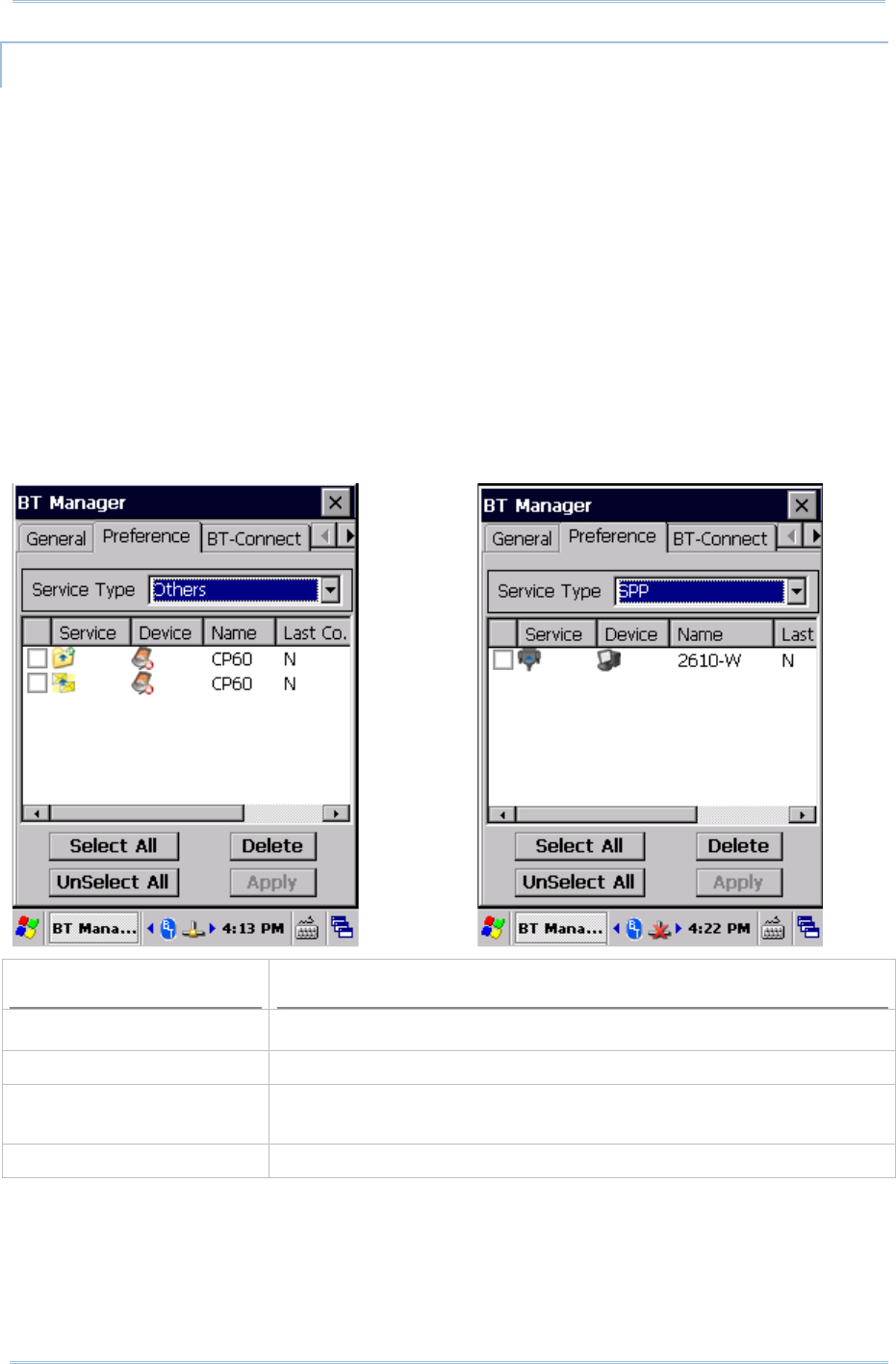
122
9700 Mobile Computer (CE) Reference Manual
PREFERENCE TAB
BT Manager helps sort out preference for all remote services which were previously
connected/disconnected. Select a desired service type from the drop-down menu:
Headset/Handsfree
HID
PAN
SPP
Others (FTP, OPP, and DUN)
MANAGING BLUETOOTH SERVICES
Bluetooth devices which deliver the selected service type will be shown in the content field,
including service/device icons, device names, and default connection settings (Last
Connection and Auto Inquiry).
A colored icon indicates the service is
available for use A grayed out icon indicates the service is
currently unavailable
Setting Description
Select All Tap to select all the listed service(s).
Unselect All Tap to deselect all the listed service(s).
Delete Tap to delete the selected service(s).
If a service is currently active, it cannot be deleted.
Apply Tap to save any made changes.
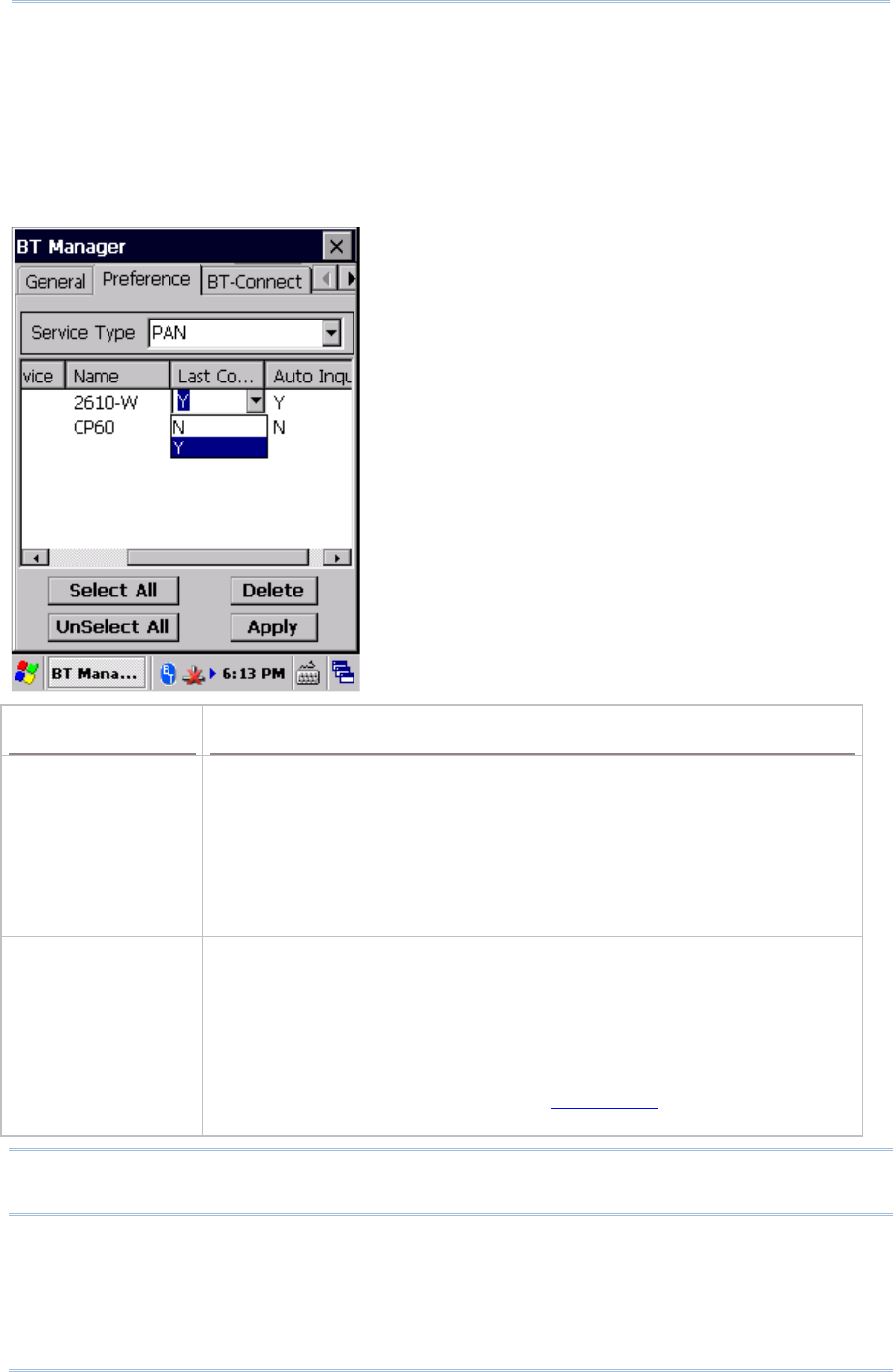
123
Chapte
r
3 Radios
CONFIGURING CONNECTION SETTINGS
Change the connection preference for a specific service by enabling (selecting Y) or
disabling (selecting N) the last two columns, Last Connection and Auto Inquiry.
If you select Yfor Last Connection or Auto Inquiry, “Allow to resume last service”
and “Auto Inquiry” must be enabled on the General tab. On the other hand, the
connection settings will be ignored if the two settings are disabled on the General tab.
Options Description
Last Connection Decide whether to re-connect to the previous services when the mobile
computer reboots or goes through a Bluetooth power cycle. Configurable
services include:
Headset/Handsfree
HID
PAN
SPP
Auto Inquiry Based on the settings for “Last Connection”, tap this field to decide
whether to detect a device after a specific time interval.
For Headset/Handsfree, HID, and PAN services, the value of “Auto
Inquiry” will automatically follow the settings for “Last Connection”.
For SPP service, when “Last Connection” is enabled (= “Y”), the value of
“Auto Inquiry” can be manually set to “Y” or “N”.
If Auto Inquiry is enabled, tap the General Tab to set the interval for
the mobile computer to perform an inquiry.
Note: To save the battery power of your mobile computer, we suggest you disable “Auto
Inquiry” unless necessary.
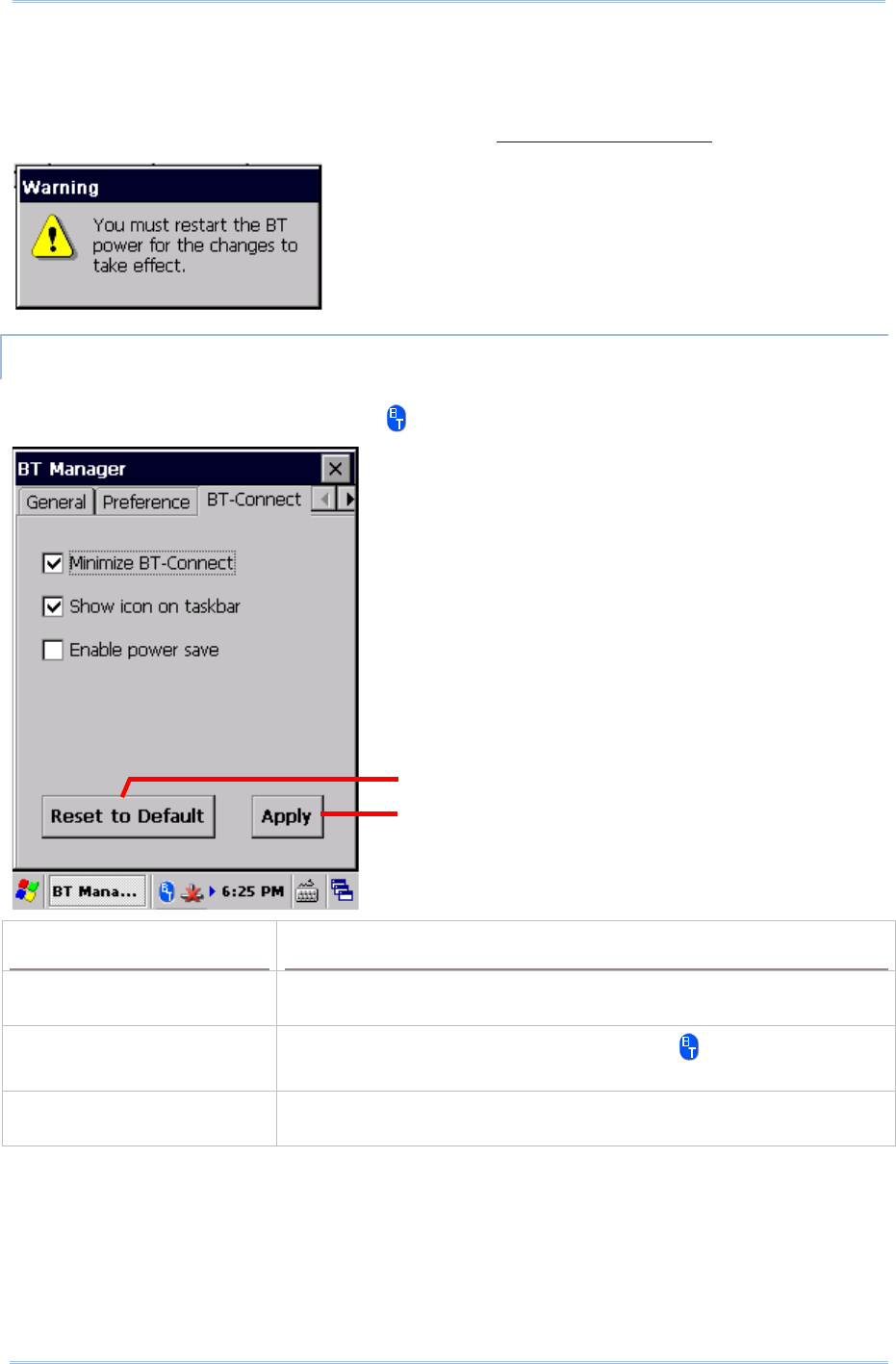
124
9700 Mobile Computer (CE) Reference Manual
SAVING PREFERENCE CHANGES
After making changes to preference settings, tap Apply. A warning dialog will show
reminding that for the settings to take effect, you will need to restart Bluetooth power.
Proceed to perform a Bluetooth power cycle as in Turn On/Off Bluetooth.
BT-CONNECT TAB
The BT-Connect tab allows configuration of the “BT-Connect window”, which can be
opened by tapping the Bluetooth icon on the taskbar.
Setting Description
Minimize BT-Connect Select to have the BT Connect window minimized on the taskbar
after it is launched to continue providing Bluetooth services.
Show icon on taskbar Select whether to display the Bluetooth icon on the taskbar when
BT Connect is running.
Enable power save Select whether to maintain Bluetooth connections in low power
consumption mode until a profile becomes active.
Tap to save changes
Tap to restore default settings
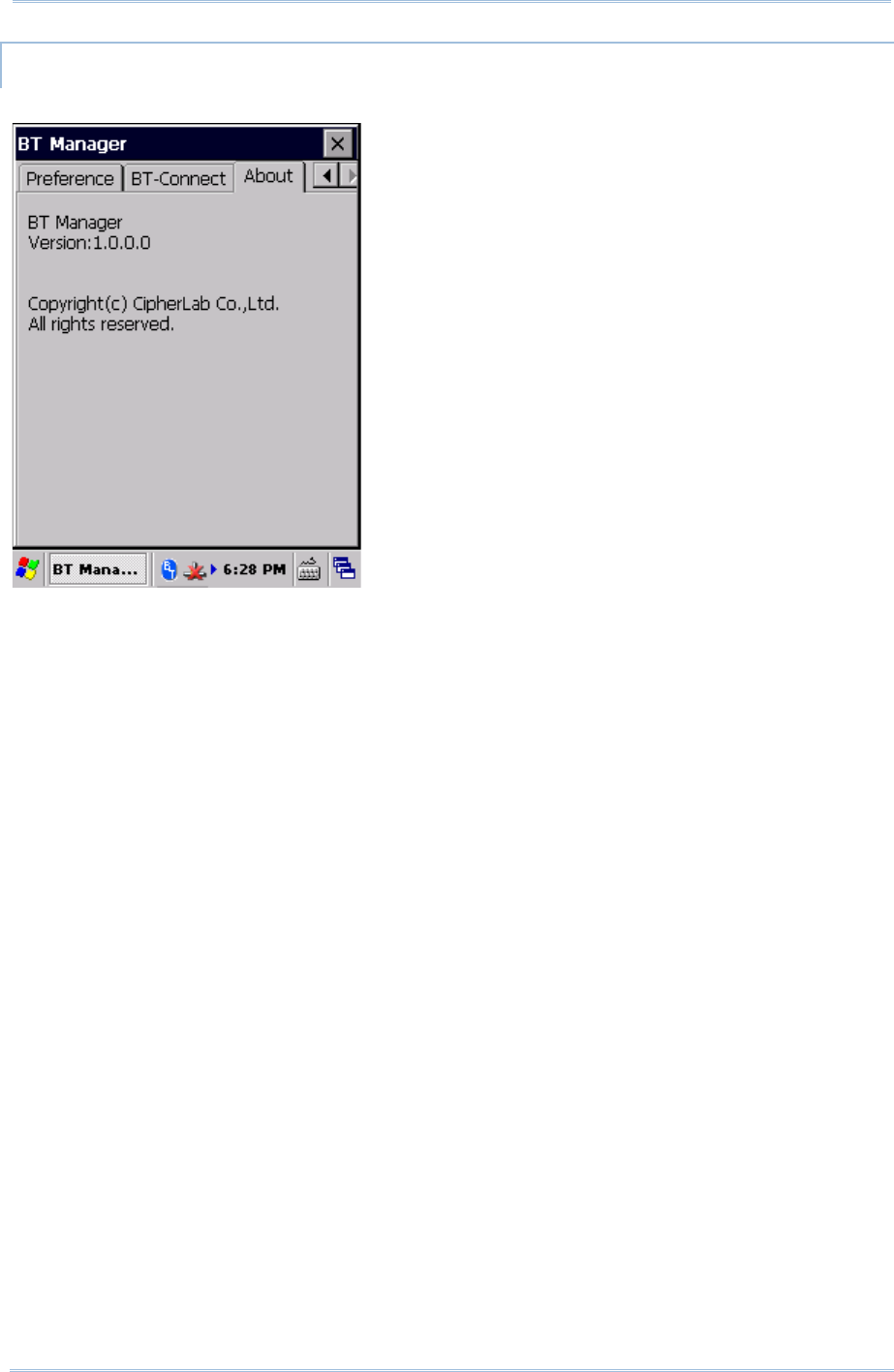
125
Chapte
r
3 Radios
ABOUT TAB
This page delivers version and copyright information about the software.

126
9700 Mobile Computer (CE) Reference Manual

127
This chapter guides you to the system settings featured by the OS. Access these settings to
define how the mobile computer looks, sounds, stores/secures your data, manages the
applications, or exchanges data with your networks or other devices.
This chapter also includes the process for updating the OS image.
4. IN THIS CHAPTER
4.1 Control Panel ...........................................................128
4.2 Connection Settings ..................................................135
4.3 Taskbar and Start Menu Settings ................................137
Chapter 4
MANAGE MOBILE COMPUTER
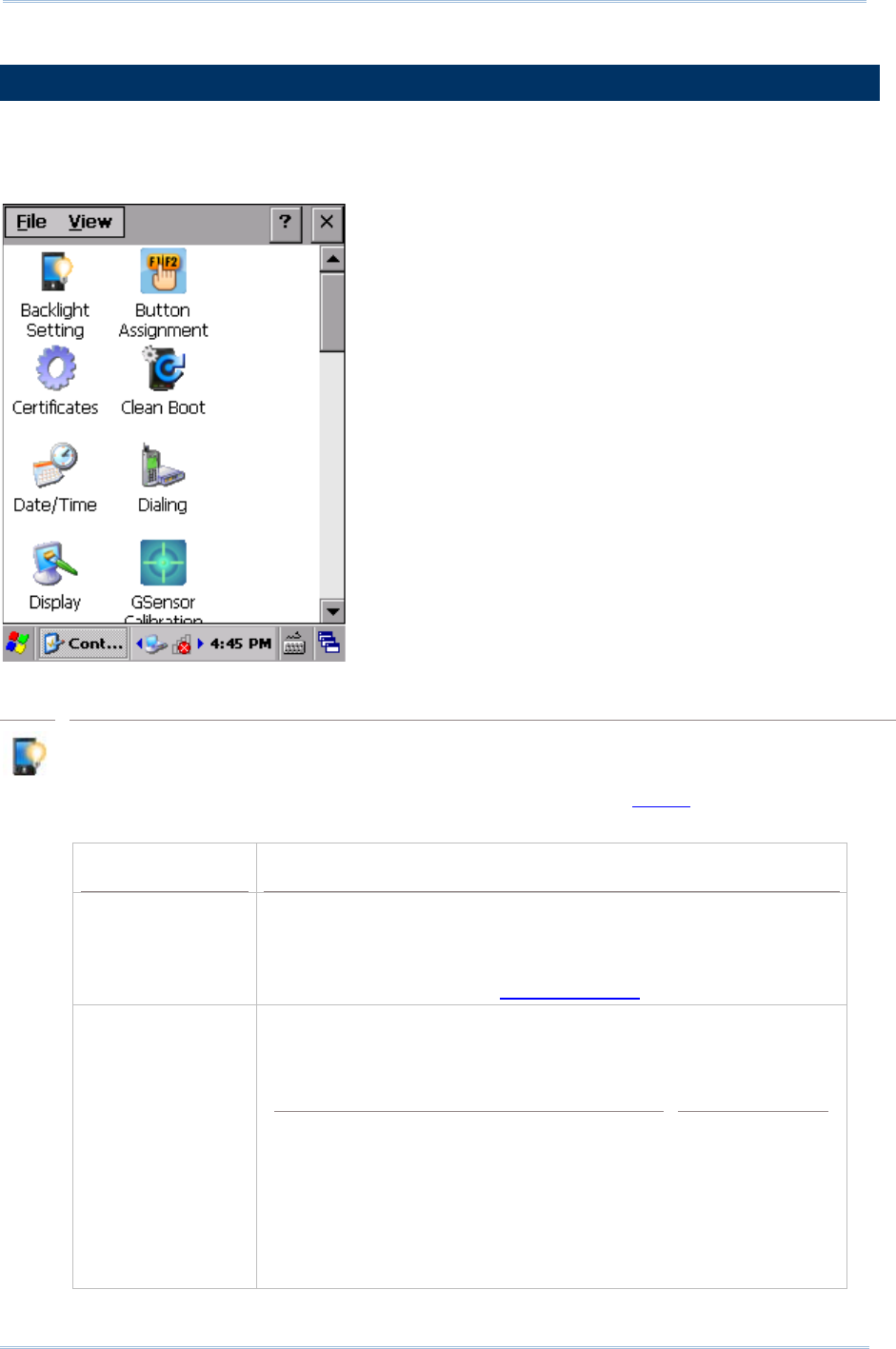
128
9700 Mobile Computer (CE) Reference Manual
4.1. CONTROL PANEL
To access control panel settings:
Tap Start |Settings |Control Panel to display a window listing all the programs
installed on the mobile computer.
Icon Description
BACKLIGHT SETTING
Sets screen and keypad timeout and brightness. Four tabs are featured – Brightness,
Battery Power,External Power, and Profile. See also Power for setting up power
plans to save battery consumption.
Tabbed Page Description
Brightness Selects whether to allow manual adjustment of the screen and
keypad backlights.
Adjust the screen to the dimmest comfortable brightness to
save power. See also Adjust Backlight.
Battery Power Sets the screen backlight timeout on battery power and whether to
trigger screen/keypad light-up upon pressing a key.
Option Default Settings
Turn off LCD backlight if device is not used
for: Checked;
1 min
Turn off keypad backlight if device is not
used for: Checked;
5 sec
Turn on LCD backlight when a button is
pressed or the screen is tapped Checked
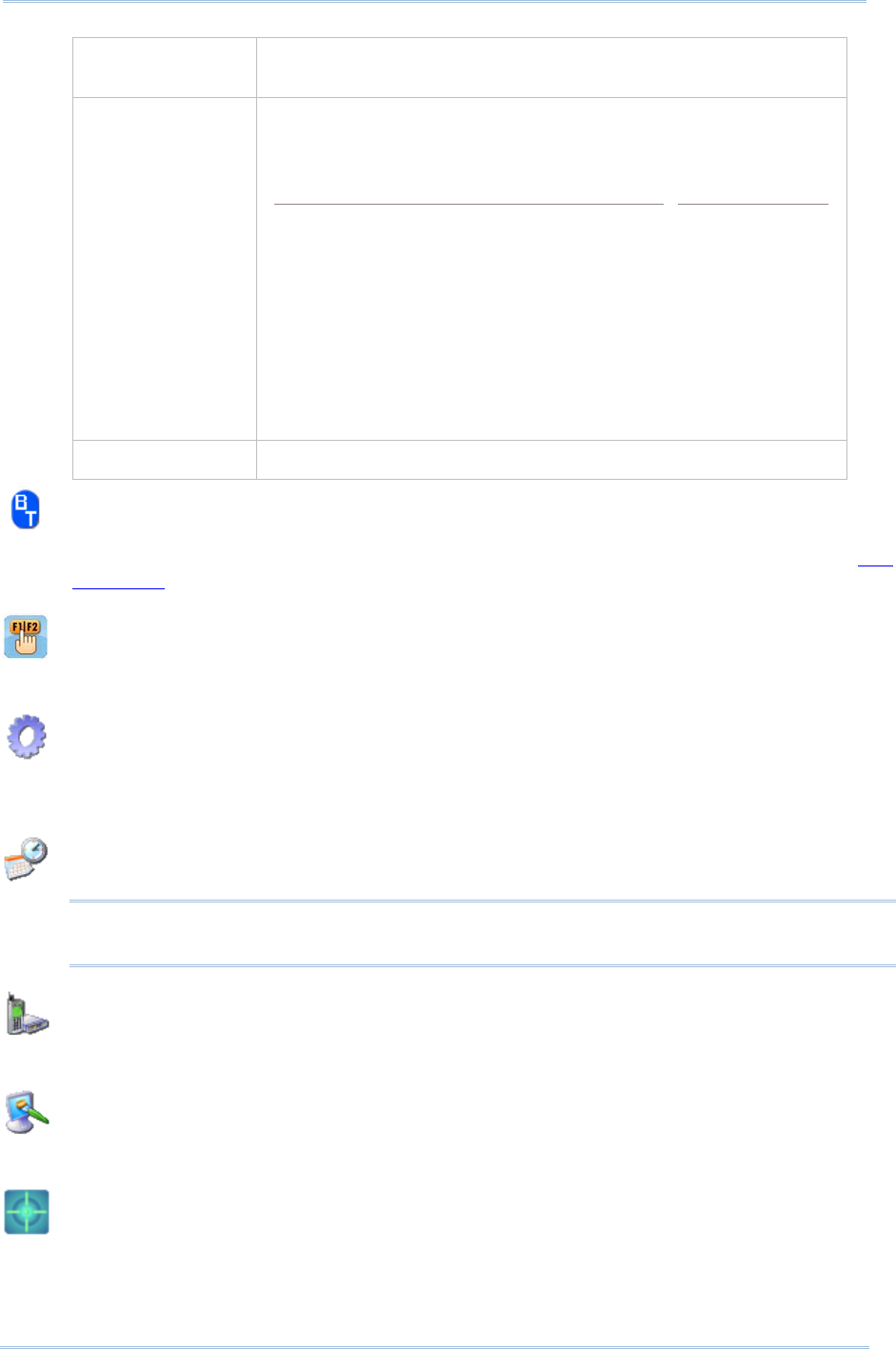
129
Chapte
r
4 Manage Mobile Computer
Turn on keypad backlight when a button is
pressed Checked
External Power Sets the screen backlight timeout on external power and whether
to trigger screen/keypad light up upon pressing a key.
Option Default Settings
Turn off LCD backlight if device is not used
for: Checked;
10 min
Turn off keypad backlight if device is not
used for: Checked;
10 sec
Turn on LCD backlight when a button is
pressed or the screen is tapped Checked
Turn on keypad backlight when a button is
pressed Checked
Profile Sets backlight profiles or restores them back to default.
BT MANAGER
Bluetooth settings tool that allows you to select whether to enable device re-connection
and auto-inquiry, as well as set preference for re-connection of each service. See Use
Bluetooth.
BUTTON ASSIGNMENT
Redefines key functions under keypad’s normal and function mode. See Button
Assignment for more details.
CERTIFICATES
Imports either your personal digital certificates, certificates from trusted authorities, or
intermediate certificates in order to access certain secured networks. Once imported,
you may view or remove the installed certificates.
DATE/TIME
Sets RTC time, calendar and time zone.
Note: RTC time can be reserved for approximately 60 days on the mobile computer
after the main battery pack has been removed.
DIALING
Dials up the connection and configure settings for modem communication. (Not
available for now).
DISPLAY
Changes the desktop background image and system appearance (color of desktop,
windows, title bars, dialogs, menus, selected items, etc.).
GSENSOR CALIBRATION
Shows a round ball which fixes at the center of a set of circles when the mobile
computer is on a level surface, and dislocates when the mobile computer is tilted. Place
the mobile computer on a flat surface before calibration, and tap GSensor
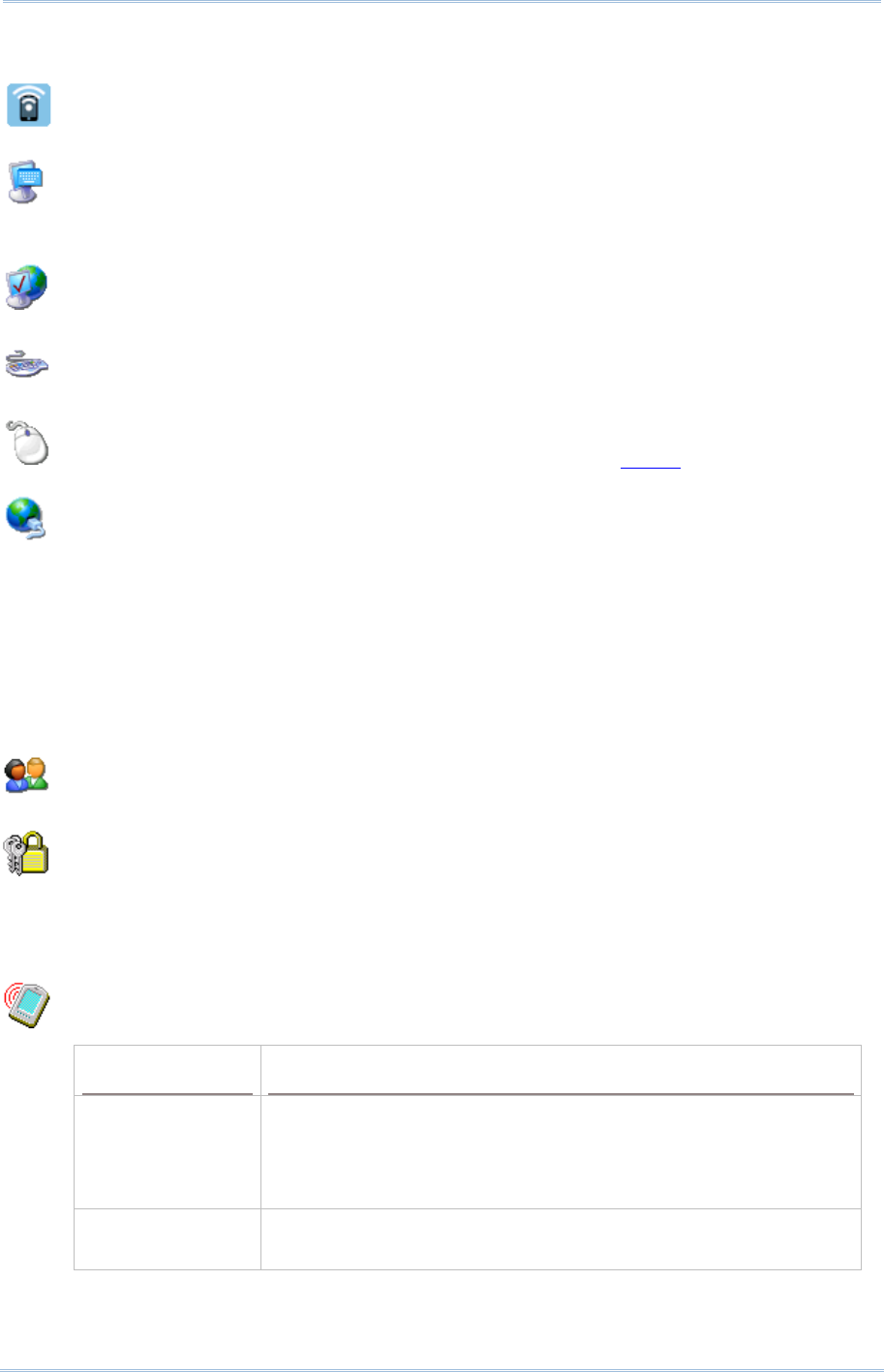
130
9700 Mobile Computer (CE) Reference Manual
Calibration.
HF RFID CONFIGURATION
Configures the RFID reader and displays test scan results.
See Use HF RFID Configuration.
INPUT PANEL
Select an input method and tap Options to make further adjustments.
Set whether to allow applications change input panel state.
INTERNET OPTIONS
Configures how the mobile computer connects to the Internet.
KEYBOARD
Enables and sets character repeat delay and rate.
MOUSE
Tests the double-click sensitivity of the stylus. See also Stylus.
NETWORK AND DIAL-UP CONNECTIONS
Configures whether the mobile computer connects to a network directly or through a
modem. Same as tapping Start |Settings |Control Panel |Network and Dial-up
Connections.
Available connection types include:
115200 (for dial-up internet access)
TIWLNAPI1 (via 802.11 a/b/g/n)
BTPAN1 (via Bluetooth)
OWNER
Records information about the mobile computer’s owner, owner notes, and network ID.
PASSWORD
Sets a password to secure the mobile computer upon power on or awake from
suspension.
When password protection is enabled, access to Control Panel settings and
Password settings is also protected.
PC CONNECTION
Select between USB serial connection and COM port connection.
Tabbed Page Description
PC Connection Select to connect the mobile computer with your PC through USB
serial connection or.
Changing connections settings may affect communications
with your PC.
COM Port Select whether to allow the physical UART to act as a COM port, and
specify the COM port to map to.
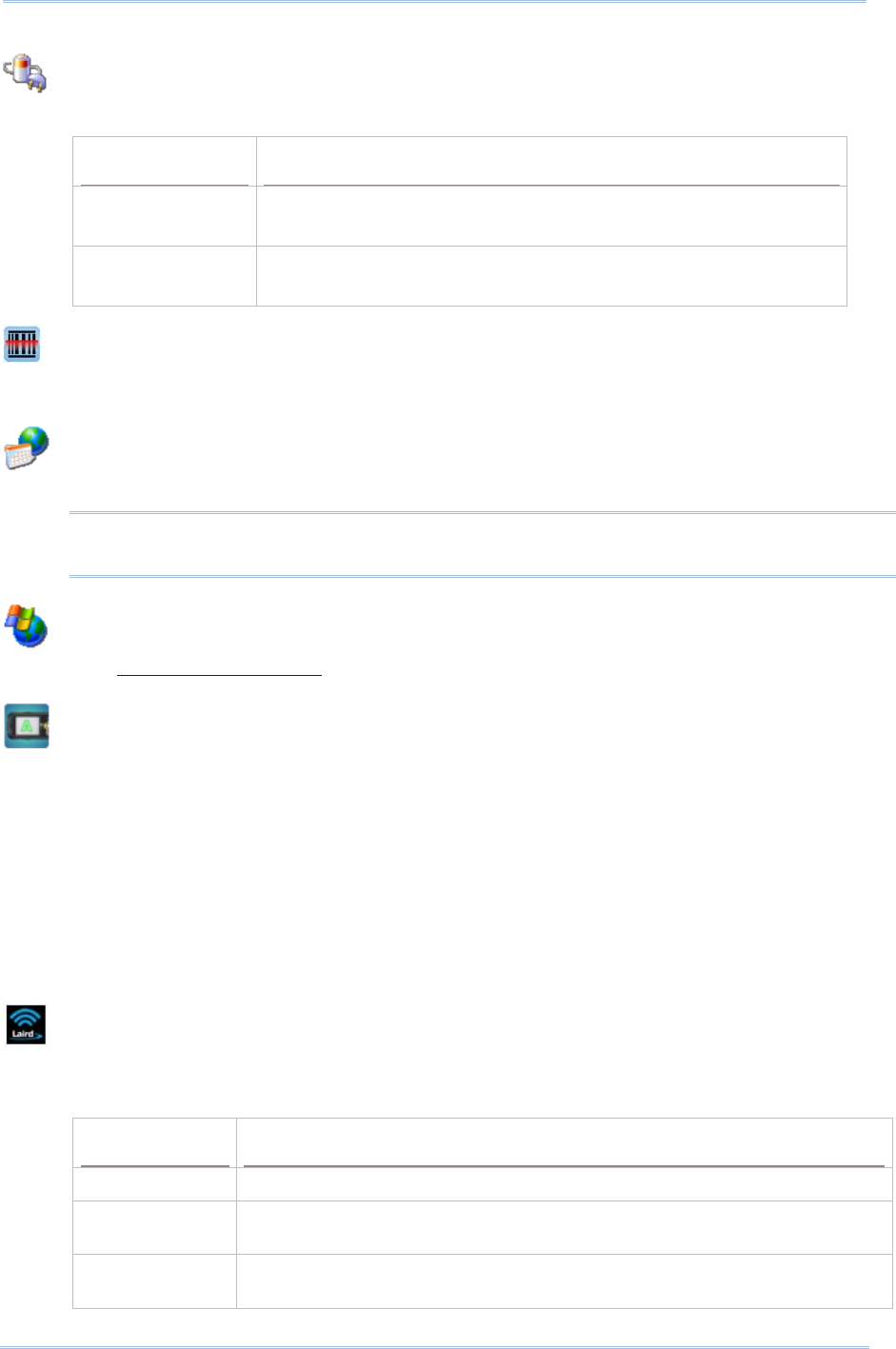
131
Chapte
r
4 Manage Mobile Computer
POWER
Displays battery level and sets up power plans. Two tabs are featured – Battery and
Power Off.
Tabbed Page Description
Battery Delivers a summary of battery level for main & backup batteries,
and also denotes the main battery level percentage.
Schemes Sets a power scheme to switch the mobile computer to suspend
after a specified amount of time.
READER CONFIG
Allows users to set scanner preferences, data output format and destination,
symbology settings, and perform test scanning of barcodes. See Use Reader Config.
REGIONAL SETTINGS
Controls how to display date, time and numbers, currency as well as interface and input
language on the mobile computer. Featured tabs are – Region,Language and Input.
Note: Default interface language and input language are bound to the OS and cannot
be changed.
REMOVE PROGRAMS
Views and removes non-inherent applications installed on the mobile computer. See
also Uninstall Applications.
SCREEN ROTATION
Selects the modes to enable for screen orientation, and whether to suspend the mobile
computer when it is facing down.
Tap each of the following labels to enable/disable the given screen rotation mode.
Portrait mode
Landscape mode
Signature mode
Tap the following label to enable/disable suspension of the mobile computer when it is
turned over and the screen is facing downwards.
Suspend when face down
SCU
Summit Client Utility (SCU) allows changing Wi-Fi settings on the mobile computer,
including radio type, access point, Wi-Fi security and more. Settings are displayed
among three tabs:
Tabbed Page Description
Status Displays AP information, device IP, connection status and signal strength.
Configuration Disables/Enables radio and switches the active profile. Also opens profile
settings and global settings.
Diagnostics Performs diagnostic tests to check connection, and shows information
about SCU version.
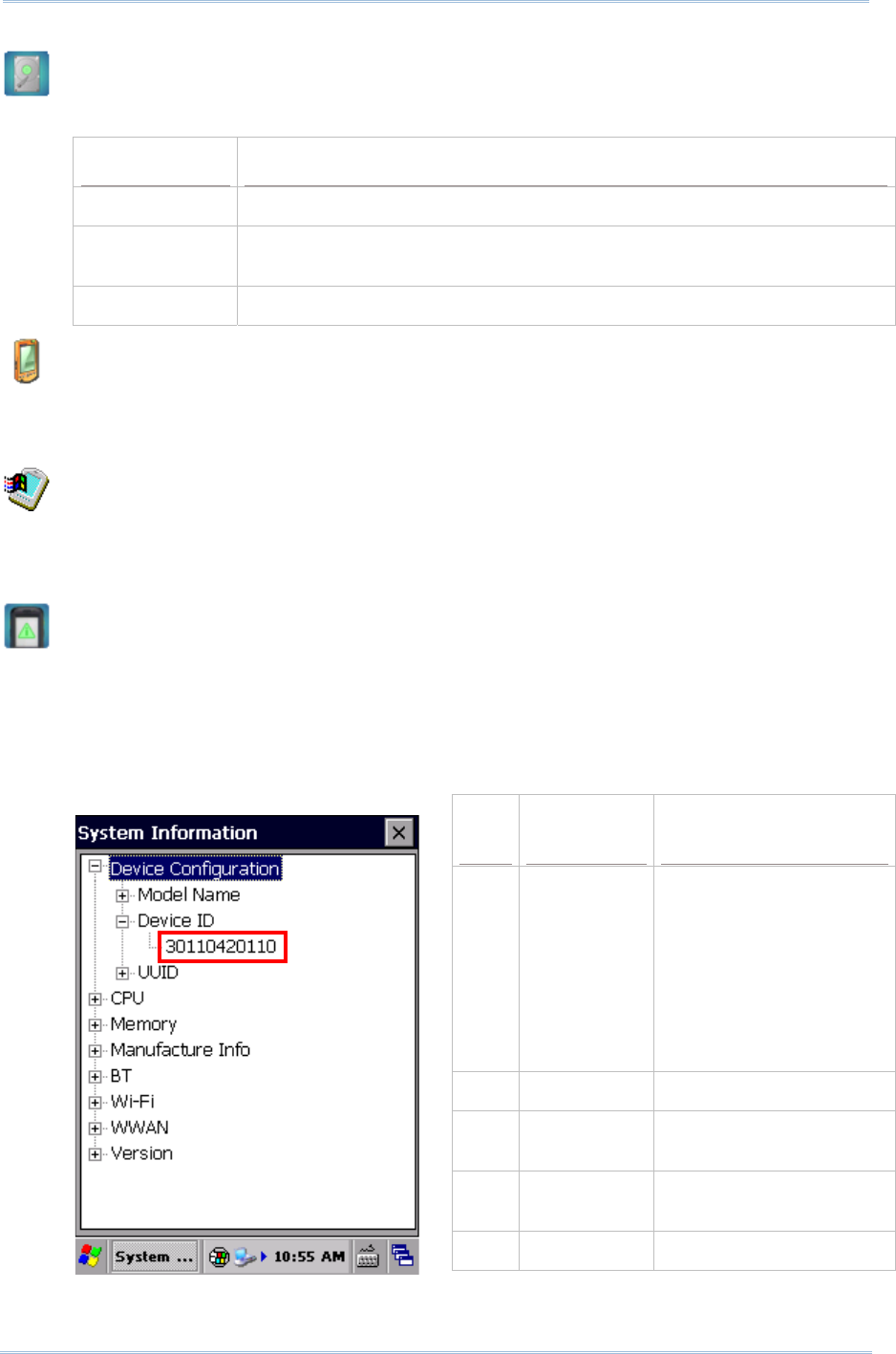
132
9700 Mobile Computer (CE) Reference Manual
STORAGE INFORMATION
Provides storage status of the internal storage (which is divided into System files and
User data) and external storage on the mobile computer.
Label Description
System Shows total size and available size of storage under the System directory.
USER_DATA Shows total size and available size of storage under the USER_DATA
directory.
Storage Card Shows total size and available size of storage on the storage card.
STYLUS
Double-tap tab: Configures and tests double-tap sensitivity.
Calibration tab: Recalibrates the touch screen when it is no longer responding
correctly to stylus movement.
SYSTEM
General tab: Displays OS and system hardware information.
Device Name tab: Tap a name and description for the mobile computer.
Copyrights tab: Views copyright statements.
SYSTEM INFORMATION
Displays some of the mobile computer’s info such as manufacturer, firmware version,
MAC address, memory capacity and so on. Tap each node to expand the tree structure
list and view data about the given items.
This page also displays the mobile computer’s Device ID, a sequence of digits that
deliver information about the hardware integrated on the mobile computer. The coding
rule is tabulated as below:
Digit
Pair Hardware Code
1st Barcode
Reader 0: None:
1: Laser
2: Laser
3: 2D imager
4: Long range laser
5: 2D imager
7: Extra long range 2D
imager
9: Extra long range laser
2nd -- N/A
3rd Bluetooth 0: None
1: Bluetooth
4th Wi-Fi 0: None
1: Wi-Fi
5th -- N/A
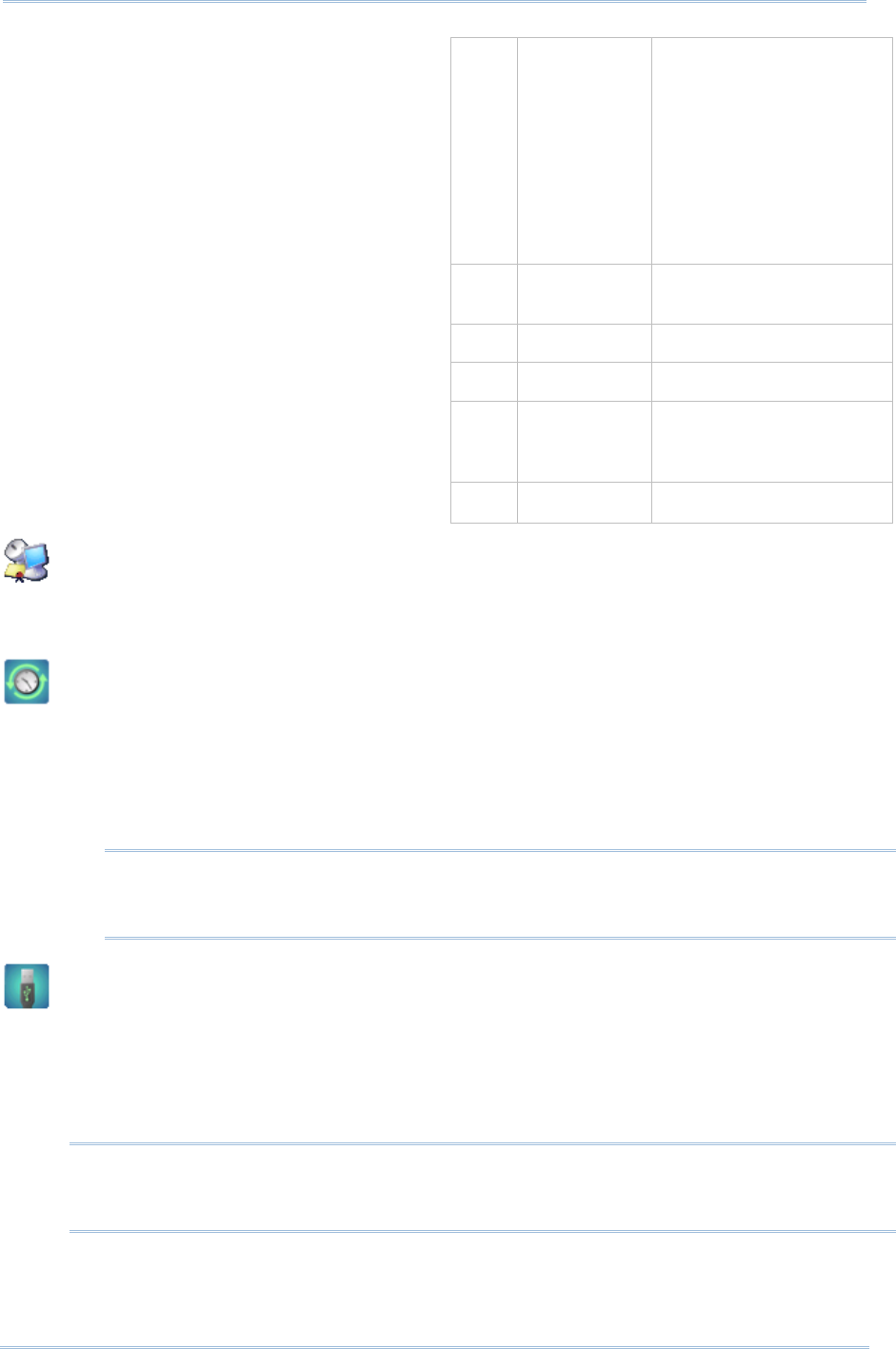
133
Chapte
r
4 Manage Mobile Computer
6th Keypad 0: None
3: Numeric (30-key)
4: Numeric & Function
(38-key)
5: Alphanumeric
(53-key)
6: Alphanumeric
(53-key)
7: Alphanumeric
(53-key)
7th LCD 0: None
3: QVGA
8th -- N/A
9th -- N/A
10th Touch panel 0: None
1: 3.5” QVGA
Transflective
11th -- N/A
TERMINAL SERVER CLIENT
Logs onto a Windows Terminal Server or a remote computer through remote desktop
connection. You may then access all programs, files and network resources on the
remote host or terminal server.
TIME SYNC
SNTP tabbed page: Synchronizes the mobile computer’s time with an NTP server
either automatically or manually. Users can also select the time period for
auto-sychronization. Synchronized time will be written to RTC and system time will
be updated.
Check Internet connection status if the following synchronization status shows:
“Cannot get time information through SNTP”.
Note: For auto-synchronization to function properly, Time Synchronization
application should be shut down. Close the application when you are finished
adjusting the settings.
USB CONNECTION
Sets the type of USB connection without re-plugging the USB cable.
ActiveSync Serial Mode: Sets up ActiveSync connection with PC through serial
protocol. This is the default setting.
Mass Storage – SD Card: Presents the mobile computer with an SD card installed
as a storage device. If no SD card is installed, the directory on the PC will be blank.
Note: Selection of ActiveSync Advanced Network Mode or ActiveSync Serial Mode will
be synchronized with settings under Start |Settings |Control Panel |USB to
PC.

134
9700 Mobile Computer (CE) Reference Manual
VOLUME & SOUNDS
Volume tab: Adjusts system sounds and volume for events, applications,
notifications and stylus movements.
Sounds tab: Changes event sounds to meet your preferences and save them as
schemes.
WIRELESS MANAGER
Enables/disables Bluetooth, Wi-Fi and cellular data power status.
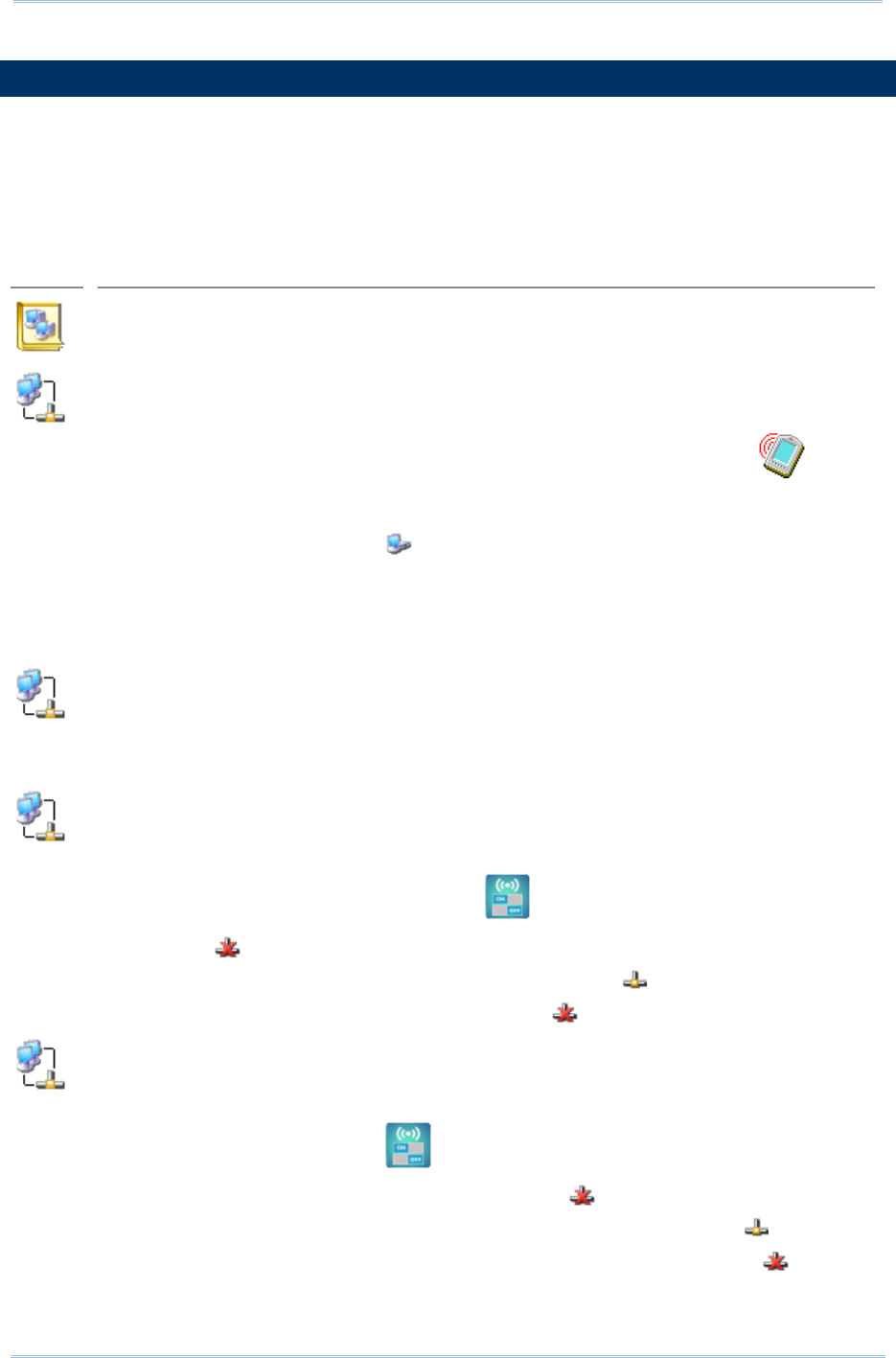
135
Chapte
r
4 Manage Mobile Computer
4.2. CONNECTION SETTINGS
To access connection settings:
Tap Start |Settings |Control Panel |Network and Dial-up Connections.
OR
Tap Start |Settings |Network and Dial-up Connections.
Icon Description
MAKE NEW CONNECTION
Tap to create a new connection which is not listed.
USB SERIAL
Sets serial profile for USB connection to a PC via ActiveSync. Settings will be
reflected under Start |Settings |Control Panel | PC Connection . When
the mobile computer is connected to a PC, the connection is enabled
automatically.
When connected, an icon will appear on the taskbar.
When disconnected, the icon will disappear.
Note: Any changes to the Properties of this item will affect ActiveSync
connection.
USB CABLE
Sets USB networking with the PC through RNDIS. This appears automatically
when the mobile computer is connected to a PC via the Snap-on Cable or Cradle,
and the icon disappears when the mobile computer is disconnected from the PC.
SDCSD40N1
Refers to the 802.11 a/b/g/n module for connection via wireless local area
network (WLAN). To enable this function, turn on Wi-Fi power in Start |Settings
|Control Panel |ʳWireless Manager .
An icon is located on the taskbar.
When connected to WLAN, the icon will change to .
When disconnected, the icon will return to .
BTPAN1
Refers to connection via wireless personal area network (WPAN). This function is
not available until Bluetooth power is turned on in Start |Settings |Control
Panel |Wireless Manager .
When Bluetooth power is turned on, an icon will appear on the taskbar.
When connected to a Bluetooth device, the icon will change to .
When disconnected to a Bluetooth device, the icon will return to .
When Bluetooth power is turned off, the icon will disappear.
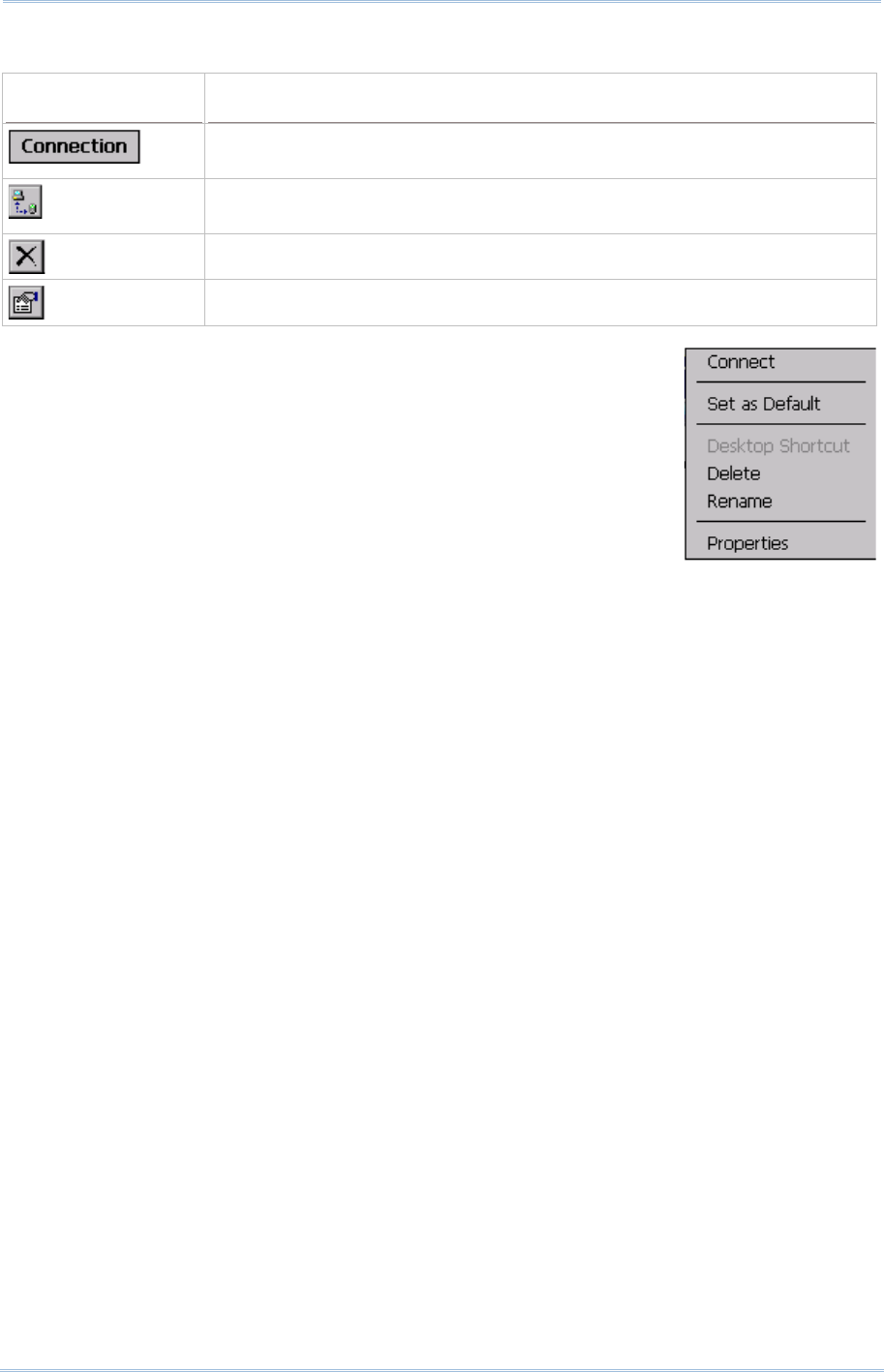
136
9700 Mobile Computer (CE) Reference Manual
The taskbar items deliver the following functions:
Button Description
Tap this button to open the Connection menu. The available options depend
on the connection you select.
Tap this button to toggle on/off the connection you select. This can be used
for Enable/Disable or Connect/Disconnect.
Tap this button to delete the connection you select.
Tap this button to view the properties of the connection you select.
You may also tap and hold a connection item to open an option menu.
The available functions differ for each type of connection.
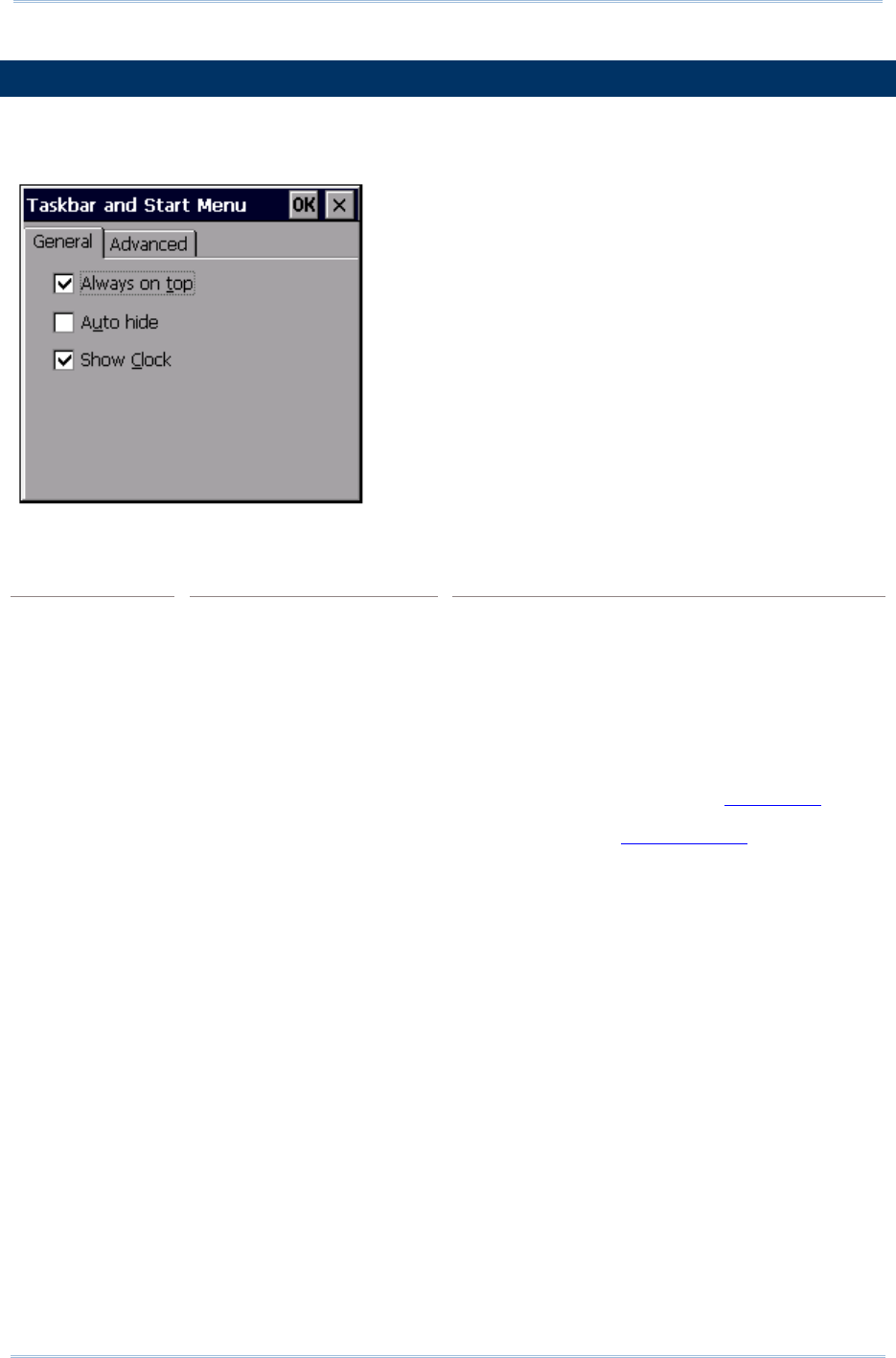
137
Chapte
r
4 Manage Mobile Computer
4.3. TASKBAR AND START MENU SETTINGS
To access taskbar and Start Menu settings:
Tap Start |Settings |Taskbar and Start Menu.
Tabbed page Setting Description
Always on top Select to keep the taskbar at the top of the
screen, even when an application is open.
Auto hide Select to auto hide the taskbar and reveal it by
tapping on the bottom of the screen.
General
Show Clock Select to show clock time at the right side of the
taskbar region.
Clear Tap to clear all contents in the Documents menu.Advanced
Expand Control Panel Select to show Control Panel items in an
expanded menu.

138
9700 Mobile Computer (CE) Reference Manual
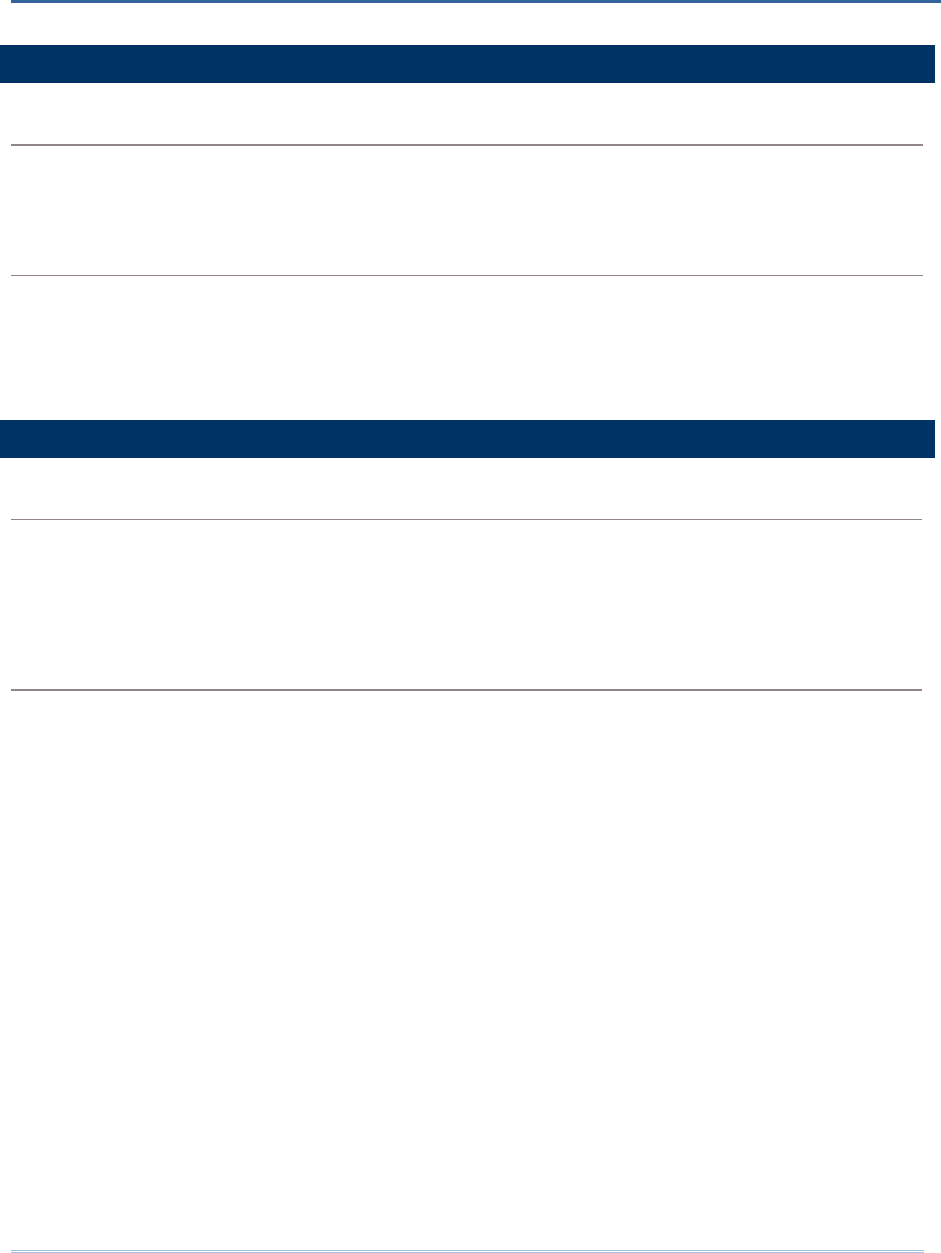
139
PLATFORM, PROCESSOR & MEMORY
Operating System & CPU
OS Version Microsoft Windows Embedded Compactʳ7.0
CPU TI OMAP4430 1GHz Processor
Memory
RAM 512MB DDR SDRAM
Flash 4GB Flash ROM
Expansion Slot One expansion slot, supports MicroSDHC up to 32GB
COMMUNICATIONS & DATA CAPTURE
Communications
USB Host/Client USB 2.0
WPAN Built-in module for Bluetooth version 2.1 + EDR Class II connectivity
WLAN Built-in module for 802.11 a/b/g/n networking
Data & Image Capture
Digital Camera 5 megapixel with auto focus and LED flash
Barcode Reader Ordering options include STANDARD READER UNIT
Laser (Symbol SE955)
2D imager (Symbol SE4500)
LARGE READER UNIT
2D imager with decoder board (Symbol
SE4500+PL4507)
Extra long range laser (Symbol SE1524)
Extra long range 2D imager (Intermec
EX25)
SPECIFICATIONS

140
9700 Mobile Computer (CE) Reference Manual
ELECTRICAL CHARACTERISTICS
Batteries
Main Battery Pack Standard capacity battery: 3.7V, 3300 mAh
Large capacity battery: 3.7V, 5400 mAh
Rechargeable Li-ion battery
Charging time: approximately 4 hours for standard battery
/
6
hours for large capacity battery
Backup Battery 3.6V, 15 mAh
Rechargeable NiMH battery (charged via main battery)
Data retention for 30 minutes
Charging time: approximately 5 hours
Power Adapter
Input AC 100~240V, 50/60 Hz Power Supply Cord for
Snap-on Cable Output DC 5V, 4A
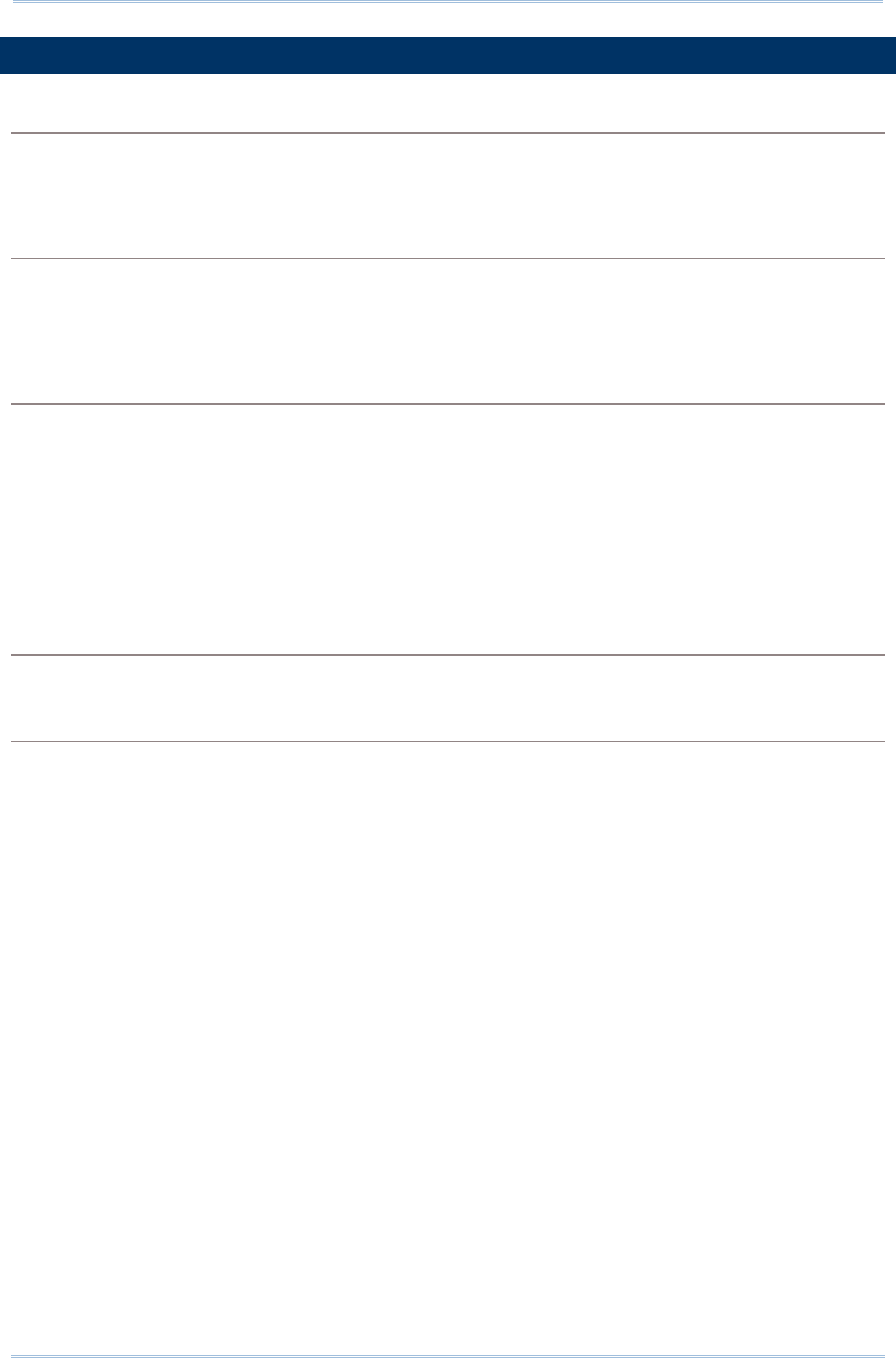
141
Specifications
PHYSICAL CHARACTERISTICS
Color Tap Screen Display
Display 3.5” Transflective TFT-LCD, 65K colors, sunlight readable
Resolution QVGA 240 (W) x 320 (H)
Keypad
Layout Numeric keypad (30-key), Numeric & Function keypad (38-key), or
Alphanumeric keypad (53-key)
Backlight White LED backlight for display and keypad
Notifications
Status LED Three LEDs for showing scanning good read, radio connection
status and battery charging status
Audio Integrated with speaker and microphone
2.5mm 4-ring headset jack
Bluetooth headset supported
Vibrator 0.45G force
Sensors
Built-in Sensors G-sensor, Light Sensor
Enclosures
Materials Plastic & metal
Dimensions 214 mm (L) x 89 mm (W) x 47 mm (H) with battery
Weight 445g with 3600mAh battery; 474g with 5400mAh battery
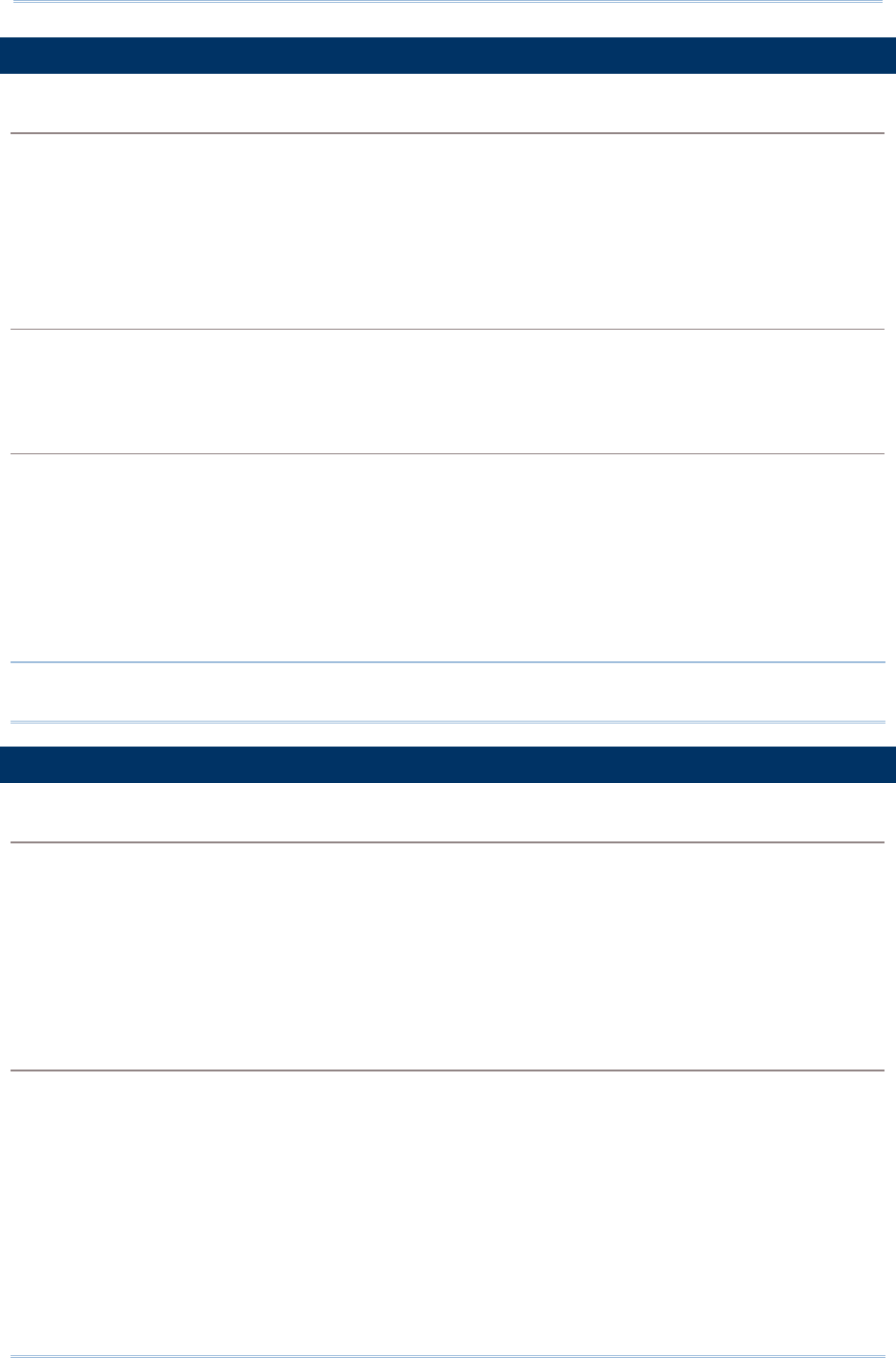
142
9700 Mobile Computer (CE) Reference Manual
ENVIRONMENTAL CHARACTERISTICS
Temperature
OperatingNote -20 °C to 50 °C / -4°F to 122°F
Storage -30 °C to 70 °C / -22°F to 158°F (without battery)
-30 °C to 60 °C / -22°F to 140°F (with battery)
Charging 0 °C to 35 °C / 32°F to 95°F (with battery)
Humidity
Operating 5% to 95%, non-condensing (Max 60°C / 140°F)
Storage 5% to 95%, non-condensing (Max 60°C / 140°F)
Resistance
Impact Resistance Multiple 1.8 m (5.9 ft.) drops to concrete, meets and exceeds applicable
MIL-STD 810G specifications
Tumble Test 500 tumbles (1,000 drops) at 1 m (1.6 ft) and 1,000 tumbles (2,000
drops) at 0.5 m (0.8 ft.) per applicable IEC tumble specifications
Splash/Dust Resistance IP65 per applicable IEC 60529 sealing specs
Electrostatic Discharge ± 15 kV air discharge, ± 8 kV contact discharge
Note: CipherLab will not be held responsible for the mobile computer’s malfunction incurred by the
operation outside operating temperature range.
PROGRAMMING SUPPORT
Development Environment & Tools
Integrated Development Environment Visual Studio 2008
Visual Studio 2005
Microsoft SDK Software Development Kit
System API (DLL) for system configuration
Reader API (DLL) for reader configuration
Software & Utilities
CipherLab software package Reader Config
Button Assignment
Signature Capture
Push to Talk
AppLock
MIRROR Browser for web application
Terminal Emulation

143
Specifications
Third-party software SOTI MobiControl for remote device control
Naurtech CETerm – Terminal emulator (3270, 5250, VT) and
industrial web browser
SYSDEV Kalipso
ACCESSORIES
Accessory Options
Snap-on Charging and Communication Cable (USB or RS-232)
Charging & Communication Cradle
Pistol Grip
Snap-on Car Charger
4-Slot Battery Charger
4-Slot Terminal Cradle